AFSA Memorial Plaque List
You are here
In This Section
Honoring Foreign Service Members and pre-1924 Diplomats and Consuls Who Died Under Circumstances Distinctive to Overseas Service While Serving the U.S. Government and the American People Abroad
Click on a name to read more about an honoree.
William Palfrey
Lost at Sea — 1780
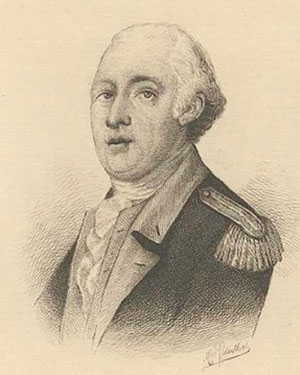
William Palfrey was born in Boston, Massachusetts in 1741. He was an active participant in the American Revolution, serving as chief clerk to John Hancock, as aide-de-camp to George Washington and, later, as a paymaster-general of the Continental Army with the rank of lieutenant colonel.
In 1780, the new United Stated Congress unanimously appointed Palfrey as U.S. consul general to France. He began his sea voyage on December 20 of that year on the ship Shillala but was never heard from again.
[Sources: https://en.wikipedia.org/wiki/William_Palfrey; American Consular Bulletin, December 1920, Page 9; Foreign Service Journal, October 1975, Page 13]
 §
§
Samuel Shaw
Tropical Disease – India 1794
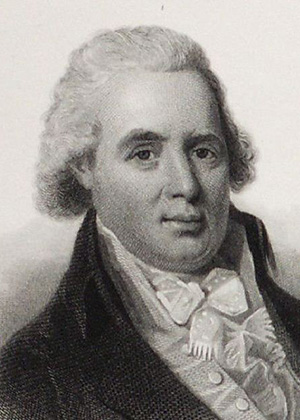
Samuel Shaw was born in 1754 in Boston, Massachusetts to Francis and Sarah (Burt) Shaw. He served as an army officer in the American Revolution, commanded at Fort Washington in Boston in 1776, and from 1779 to 1783 served as aide-de-camp to General Henry Knox. He served later in a staff role at the Battles of Trenton, Battle of Monmouth, and at the Battle of Yorktown.
In 1784, he sailed to China to inaugurate trade on behalf of the fledgling United States, serving as U.S. Consul at Canton from 1786 to 1789. He returned to the United States in 1792, when he was reappointed to China by George Washington. He was enroute to the United States from China when he died “of a disease of the liver incident to the climate” at the Cape of Good Hope, South Africa on May 30, 1794, at the age of 39.
His journals were published in 1847 and his letters and papers are located at the Massachusetts Historical Society. There is a monument to Samuel Shaw at Copp’s Hill Burial Ground in Boston.
[Sources: https://en.wikipedia.org/wiki/Samuel_Shaw_(consul) and The journals of Major Samuel Shaw: the first American consul at Canton: with a life of the author, Page 123]
 §
§
Joel Barlow
Exposure — Zarnowice 1812
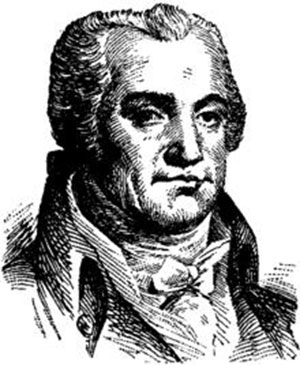
Joel Barlow was born in Redding, Connecticut in 1754. A graduate of Yale College, he served as a chaplain for the 4th Massachusetts Brigade in the American Revolution, was later admitted to the Connecticut bar and became a minor poet best known for his satirical publication The Hasty-Pudding.
Barlow served as the American consul in Algiers between 1795 and 1799. During this time, he engaged in a bargain to free more than 100 American merchants capture by Barbary pirates and negotiated treaties with the Barbary States to prevent future attempts to kidnap American citizens.
Appointed minister plenipotentiary to France in 1811, Barlow planned to meet with Napoleon Bonaparte in modern-day Lithuania to discuss a commercial agreement. He never encountered the famous emperor and, having accompanied the French army on its retreat from Russia, died of exposure in the village of Zarnowiec.
[Sources: https://en.wikipedia.org/wiki/Joel_Barlow; Foreign Service Journal, October 1996, Pages 46-49]
 §
§
Oliver Hazard Perry
Yellow Fever – Atlantic Ocean 1819
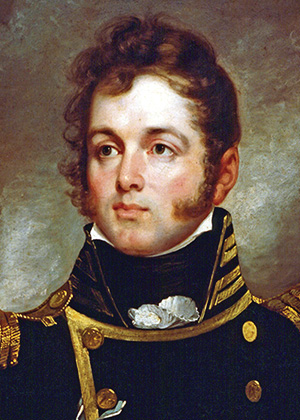
U.S. Navy officer Oliver Hazard Perry, member of a family with a long naval history, was born in 1785 in Rhode Island. He served in the West Indies, in the Mediterranean during the Barbary Wars, and during the War of 1812 at the Battle of Lake Erie, where he led U.S. forces to a victory and received a Congressional Gold Medal. He later participated in the defenses of Washington, D.C. and Baltimore during the British invasion of the Chesapeake Bay, and in 1815 returned to the Mediterranean for the Second Barbary War.
Following a controversy involving a duel in New Jersey, he was offered a diplomatic mission to South America, sailing for the Orinoco River in Venezuela in 1819 to negotiate a treaty with Simon Bolivar at Angostura. He successfully negotiated and signed a treaty with Vice President Francisco Antonio Zea in August 1819, but along with many of the crew, was ill with yellow fever by the time the ship sailed downriver. The crew tried to reach Trinidad for assistance, but Perry died at sea.
He was originally interred in Port-of-Spain, and his remains repatriated to Rhode Island in 1826. He has been featured on U.S. postage stamps and his former home still stands in Rhode Island.
 §
§
Robert Sterry
Shipwreck – Atlantic Ocean 1820
Robert Sterry was born in Providence, Rhode Island in 1781. Following in his father’s footsteps, he studied law at Brown University, lived for a while in the Louisiana Territory, and also had seven years of Army experience during which he fought in the War of 1812.
He was appointed to be U.S. consul to La Rochelle, France in 1815. On January 17, 1820, Sterry was aboard the merchant ship Helen bound to New York from France when it ran into a gale and was wrecked off of Southampton, New York.
Sterry was buried in the North End Cemetery in Southampton. He left behind a widow, Louisa Arden Sterry, and a daughter, Elizabeth.
[Sources: https://www.southamptonhistory.org/post/the-story-of-sterry-stone; Poughkeepsie Journal, Poughkeepsie, New York, February 9, 1820, Page 3, online at https://www.newspapers.com/article/poughkeepsie-journal-obit-robert-sterry/154126182/; Ancestry.com records; Department of State Office of the Historian records; https://afsa.org/americas-overlooked-diplomats-and-consuls-who-died-line-duty]
 §
§
Nathaniel G. Ingraham, Jr.
Fever — Tampico, Mexico 1824
Nathaniel Gibbs Ingraham Jr. was the son of a wealthy New York merchant and was born in New York in 1792. The elder Mr. Ingraham, who did business with George Washington and was a guest at least once at Mt. Vernon, also helped other commercial contacts to become merchant-consuls at other advantageous locations, including Cuba.
The younger Mr. Ingraham, after living for a time in England, was appointed as U.S. consul in Tampico, Mexico. He died of a fever in Tampico, Mexico on April 30, 1824, at about 32 years of age.
[Sources: https://repository.library.brown.edu/studio/item/bdr:320566/PDF/; https://founders.archives.gov/documents/Washington/04-06-02-0148]
 §
§
Harris E. Fudger
Murdered — Bogota, Colombia 1825
Harris Ellery Fudger of Massachusetts, born June 3, 1798, in Gloucester, Massachusetts was designated U.S. Consul at Santa Marta, Colombia on July 11, 1823. He was murdered in 1825 on July 13, 1825, in Bogotá while staying at an inn. He was 27 years old.
A dispatch from the legation in Bogotá dated July 17, 1826, said he was "stabbed in the heart with his own sword, his throat cut and his trunks pillaged of their contents." Two officers of the British Legion -- in Colombia since 1817 to aid in Bolivar’s fight for independence from Spain -- were staying at the same inn and were acquainted with Mr. Fudger. In fact, Consul Fudger earlier accused them of stealing several items. The two men were detained for two years on suspicion of involvement before being court martialed and convicted, with Captain Grant sentenced to ten years for murder and Sargeant Rey Luis found guilty of conspiracy to commit murder and was sentenced to two years. The attending physician at the scene of the crime noted that most of the violence to the body was likely done after Mr. Fudger was already deceased, and that the sword, a pistol, and other personal effects, while strewn about the room, were not taken from the scene.
[Sources: https://1997-2001.state.gov/www/publications/statemag/statemag_may98/feature3.html; https://www.elinformador.com.co/index.php/distrito/298961-santa-marta-celebra-el-bicentenario-de-consul-ee-uu-harris-fudger; https://www.banrepcultural.org/biblioteca-virtual/credencial-historia/numero-169/noche-sangrienta-en-san-victorino; Department of State Office of the Historian records]
 §
§
Robert Lowry
Tropical Fever – Venezuela 1826
Robert Kelly Lowry of Maryland was born in about 1772 in London, England and was resident in Baltimore, Maryland by 1810. In October of the same year, he was sent to Venezuela as a marine commercial agent, where he corresponded with the Department of State on the rapidly changing political climate from La Guayra. He became U.S. Consul at La Guayra by 1812.
Married to Henrietta Wager in Philadelphia in 1815; they went on to have four children. His younger son, Commodore Reigert Bolivar Lowry, was born in La Guayra, and later became a decorated Naval officer.
Lowry ran for a Congressional seat in Pennsylvania in 1820, but later returned to Venezuela, having been reappointed as consul. He died at Puerto Cabello, Venezuela of a tropical fever (likely yellow fever) on January 24, 1826.
[Sources: Ancestry.com records; Lancaster Intelligencer (Lancaster, Pennsylvania), February 28 1826, Page 3, online at https://www.newspapers.com/image/559899443; https://penelope.uchicago.edu/Thayer/E/Gazetteer/People/Francisco_de_Miranda/ROBMIR/21*.html]
 §
§
Richard C. Anderson
Yellow Fever — Cartagena, Colombia 1826
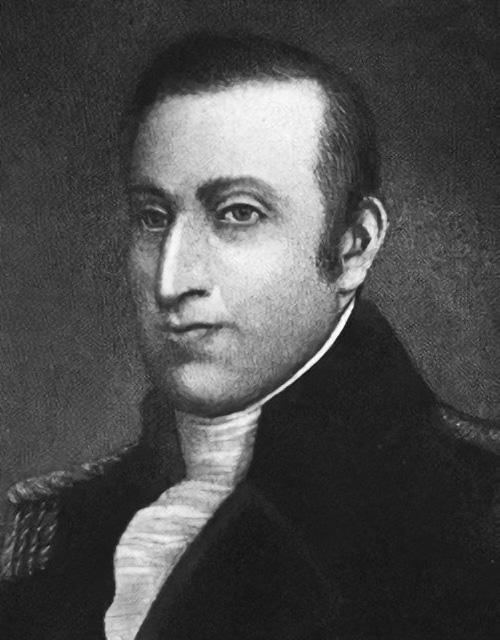
Richard Clough Anderson Jr. was born August 4, 1788, in Kentucky. He graduated from William and Mary in 1804, and later practiced law in Louisville. He served as a member of the House of Representatives from 1817 to 1821, and was the nephew of William Clark of the Lewis and Clark expedition and grandfather of U.S. Minister to Belgium and U.S. Ambassador to Japan Larz Anderson. His stepmother, Sarah Marshall, was a cousin of Chief Justice John Marshall.
Richard Anderson was appointed U.S. Minister Plenipotentiary to the Gran Colombia on January 27, 1823. He departed Colombia enroute to take on a new assignment as Envoy Extraordinary and Minister Plenipotentiary to the Panama Congress of Nations, but died enroute in or near Cartagena of yellow fever on July 24, 1826.
He was buried in Cartagena, although there is a marker for him in the family cemetery in Kentucky. Anderson County, Kentucky is named in his honor.
[Sources: https://en.wikipedia.org/wiki/Richard_C._Anderson_Jr.; https://history.ky.gov/markers/soldiers-retreat-2]
 §
§
James A. Holden
Lost at Sea – Atlantic Ocean 1827
James A. Holden of Massachusetts was a Commercial Agent at the seaport of Aux Cayes (Les Cayes), Haiti. He departed post on August 5, 1827, enroute to the U.S. on the schooner Diligent which was lost at sea.
Note: His name is inscribed on the original 1933 AFSA Memorial Plaque but was inadvertently reinscribed on a new plaque during the 2021 plaque expansion project.
[Source: American Foreign Service Journal, January 1929, Page 22.]
 §
§
William Tudor
Tropical Disease – Rio de Janeiro 1830
William Tudor was a businessman, journalist, and author born in Boston in 1779. He was U.S. Chargé d'Affaires in Rio de Janeiro, Brazil, from June 1827 to his death there on March 9, 1830, from a “fever.”
[Source: https://en.wikipedia.org/wiki/William_Tudor_(1779-1830)]
 §
§
James Shannon
Yellow Fever – Guatemala 1832
James Shannon of Kentucky served in the War of 1812, became an attorney and practiced law in Lexington, Kentucky after the war.
In 1832, he was appointed by President Andrew Jackson as Chargé d'Affaires to the Republic of Central America. Soon after his arrival in Guatemala with his wife, Susah Shelby Shannon (daughter of the first governor of Kentucky) and their niece, Susan Hart Shelby, both Shannon and his niece died of yellow fever.
The papers of James Shannon and those of Susan Shelby Shannon are held in the Special Collections of the University of Kentucky Library.
[Source: James Shannon papers, 1804-1833 (uky.edu)]
 §
§
John Miercken
Lost at Sea – Atlantic Ocean 1832
John Savage Miercken was born in Philadelphia on March 3, 1803, the son of Peter and Maria Miercken of Southwark, today a neighborhood in south Philadelphia. Appointed U.S. Consul in Martinique in 1829, he boarded the schooner Lafayette in September 1832 bound for Philadelphia via Turks Island, where the ship picked up cargo before setting sail again. The ship never reached Philadelphia and was presumed lost. He was 29 years old.
Note: His name is inscribed on the original 1933 AFSA Memorial Plaque but was inadvertently reinscribed on a new plaque during the 2021 plaque expansion project.
[Sources: The Philadelphia Inquirer, September 17, 1833, Page 2, online at https://www.newspapers.com/image/346285336; Ancestry.com records]
 §
§
William Shaler
Cholera — Havana, Cuba 1833
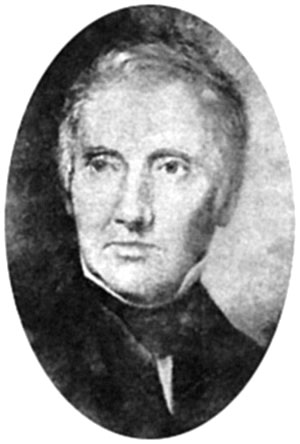
William Shaler was born in Bridgeport, Connecticut in 1773. He spent his younger years as a commercial agent for a mercantile firm based in New York and later worked as a sea captain for numerous trade vessels. Shaler published his travel narrative, “Journal of a Voyage between China and the Northwestern Coast of America,” in American Register in 1808.
Shaler served in Natchitoches, Louisiana, as an official agent to monitor and report the exploits of José Álvarez de Toledo y Dubois, who was briefly a leader in Texas’ revolt against Spain. While at this post, he encouraged and participated in the filibustering Gutiérrez-Magee expedition. Shaler later contributed to peace conferences in Europe and Algiers, serving as U.S. consul general in the latter location for 12 years and helping to end the Second Barbary War. His accounts were published in Transactions of the American Philosophical Society and Sketches of Algiers.
In 1825, the American Philosophical Society elected Shaler a member, and in 1828 the diplomat received an honorary master’s degree from the College of New Jersey (now Princeton). One year later, Shaler was appointed the U.S. consul general to Havana, Cuba. He died at post in a cholera epidemic on March 29, 1833.
[Sources: https://en.wikipedia.org/wiki/William_Shaler; American Foreign Service Journal, November 1936, Pages 601-605, 628-633]
 §
§
James James
Yellow Fever – Mexico 1834
James James of Pennsylvania became U.S. Consul in Vera Cruz, Mexico in 1832. While enroute to Mexico City, he died at Puebla, Mexico on or about April 20, 1834, likely of yellow fever.
[Sources: The Sunbury Gazette (Sunbury, Pennsylvania), July 12, 1834, Page 3, online at https://www.newspapers.com/image/511595190; Hancock County Advertiser, June 4, 1834, Page 3, online at https://www.newspapers.com/image/1013065457]
 §
§
Edmund Roberts
Dysentery — Macau, China 1836
Edmund Roberts was born June 29, 1784, in Portsmouth, New Hampshire. He went to sea as a merchant sailor in 1800, and lived in London until he was 24. After his return to New Hampshire in 1808, he married Catherine Whipple Langdon, niece of the governor. The couple had 11 children.
In 1823, Roberts, by then a merchant, secured the post of U.S. consul to Demerara in modern-day Guyana. In his private capacity as a merchant, he sailed for Zanzibar in 1827 after trading in the Indian ocean and contacted the Sultan of Muscat and Oman, who asked Roberts to escort ships to the United States to petition for trade to counterbalance British influence in the region. Roberts suggested to the U.S. government that negotiating commercial treaties might help reduce barriers to American shipping across the globe, which led to his diplomatic career.
In January 1832, Roberts was appointed Special Agent for the negotiation of commerce of the U.S. in the Pacific, which took him to Cochinchina, Thailand ("Siam") and Muscat and Oman during the years 1832–36. In 1836, Roberts returned to East Asia to ratify the two treaties and reach an agreement with Cochinchina. However, he died of dysentery in Portuguese Macau on June 12 before he could accomplish his mission.
[Source: https://en.wikipedia.org/wiki/Edmund_Roberts_(diplomat)]
 §
§
James Thornton
Dysentery – Callao, Peru 1838
James Bonaparte Thornton was born in Merrimack, New Hampshire and studied law at Yale. His maternal grandfather, Matthew Thornton, was one of the signers of the Declaration of Independence. He was elected a Representative in the New Hampshire State Legislature in 1827 and Speaker of the House in 1829, moving to Washington, DC in 1830 after being appointed to a position at the Department of Treasury.
Appointed U.S. Charge d’Affaires to Peru on June 15, 1836, he departed his post for a trip to Valparaiso on December 10, 1837. He arrived in Callao (the port city close to Lima) on the U.S. ship Falmouth from Valparaiso on January 22, 1838, and died on dysentery just three days later on January 25.
He was buried in the British Cemetery at Bellavista, Callao, and his remains were repatriated to New Hampshire in 1871. He left behind his wife Sophia and two children, James and Mary. After his death, guardianship of his two children passed to family friend Franklin Pierce, later President of the United States.
[Sources: Niles National Register, May 19, 1838, Page 2, online at https://www.newspapers.com/image/572069008; Ancestry.com, State Department Office of the Historian web records; https://www.findagrave.com/memorial/36030544/james_bonaparte_thornton]
 §
§
Daniel Brent
Typhoid Fever – Paris, France 1841
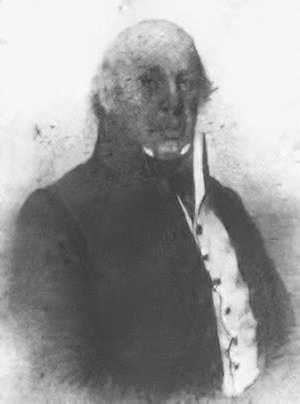
Daniel Brent was born in 1768 in Stafford County, Virginia. He moved to Philadelphia at an early age and then to Washington, D.C. to take up a position at the Department of State, working for 20 years as a chief clerk (Under Secretary of State). He was appointed U.S. Consul General in Paris in 1834 by President Jackson. He died at Paris of typhoid exhaustion after gout on January 31, 1841, after eight years of consular service. He was 68 years old. He was predeceased by his wife, Eliza Walsh, and their two children, Anne and Robert.
[Sources: The Age and Lancaster and Chester County Weekly Gazette, February 27, 1841, Page 2, online at https://www.newspapers.com/image/558782457; https://www.ancestry.com/family-tree/person/tree/75924183/person/172246438201/facts?_phsrc=tIU880&_phstart=successSource]
 §
§
Felix Suau
Killed in Earthquake – Guadeloupe 1843
Felix H. Suau was born in Charleston, South Carolina in 1815 to French parents who were naturalized Americans. His father Pierre “Peter” Suau served as U.S. Consul at Pointe-à-Pitre, Guadeloupe, until his death at age 73 in 1838. President Martin Van Buren appointed his son to replace him. After several delays, Felix Suau arrived in Pointe-à-Pitre in February 1840. On February 8, 1843, a powerful earthquake followed by a large fire devastated the city killing several thousand inhabitants including Suau who was 27 years old.
Note: In the 2021 re-inscription of names on the AFSA Memorial Plaques, the final “u” in his last name was inadvertently omitted. AFSA plans to correct the omission the next time that a new name needs to be inscribed.
[Sources: Sebastien Perrot-Minnot, “The Life and Tragic Fate of a Young U.S. Consul,” Foreign Service Journal, November-December 2025, Pages 68-71; Ancestry.com records.]
 §
§
Thomas W. Waldron
Cholera — Macau, China 1844
Thomas Westbrook Waldron was born in 1814 in Portsmouth, New Hampshire to Daniel and Olive Waldron. Along with his brother, Richard, Waldron joined the United States Exploring Expedition, also known as the Wilkes Expedition, from 1838 to 1842, exploring a portion of Antarctica’s coastline, the Pacific Islands, and the coast of what is now Washington State. Waldron Glacier in Antarctica is named after him and Waldron Island in Puget Sound is named after either him or his brother.
He became the first U.S. Consul to Hong Kong and Macau, with his appointment confirmed in May 1844. He died at Macau in September of the same year of cholera. He was 30 years old.
While he was buried in the Old Protestant Cemetery at Macau, there is also a cenotaph to his memory in his family’s plot in Portsmouth. The letter from John C. Calhoun to Thomas Waldron in May 1844 confirming that his nomination as Consul to Hong Kong has been approved by the Senate is located at the New Hampshire Historical Society.
[Sources: https://www.ancestry.com/discoveryui-content/view/29642283:60525; Colonial Times, July 10, 1844, Page 4, online at https://www.newspapers.com/image/1061538354; https://en.wikipedia.org/wiki/Thomas_Westbrook_Waldron_(consul)]
 §
§
William Murphy
Yellow Fever – Republic of Texas 1844
William Sumter Murphy was born in South Carolina in 1796. He studied law in Virginia and had his own practice in Chillicothe, Ohio, from 1818. He was heavily interested in politics and served in the Ohio state militia, where he attained the rank of brigadier general.
His first diplomatic appointment was as Special and Confidential Agent of the United States to Central America in 1841. Ill with malaria, he presented his credentials at Guatemala City and finally returned to the United States in 1842 when it was clear that the Federal Republic of Central America, which had dissolved just as he arrived, would not reconstitute itself.
On April 10, 1843, he was appointed as the Charge d’Affaires to the Republic of Texas at Galveston, arriving on June 16 of the same year. Just a week later, the Tyler administration made the annexation of Texas a priority, and Murphy took part in correspondence and secret preparations for the Texas-Tyler treaty. The treaty and associated correspondence were leaked to the public in April 1844, and the Senate rejected the treaty in June. Meanwhile, Murphy’s appointment was considered and rejected by the Senate, leading to his recall from Galveston. However, before he could be recalled, he fell ill and died on July 13, 1844, of yellow fever at the height of a local pandemic.
He was originally buried in Galveston, but his remains were later relocated to Chillicothe, Ohio. He left behind a wife, Lucinda, and a son, Robert, and was predeceased by three other children. He was the third U.S. Minister to die in Texas since 1840.
[Sources: The Times-Picayune (New Orleans), August 16, 1844, Page 2, online at https://www.newspapers.com/image/25539379; https://en.wikipedia.org/wiki/William_Sumter_Murphy; https://www.ancestry.com/discoveryui-content/view/105178698:60525; Ancestry.com records]
 §
§
A. M. Green
Yellow Fever – Republic of Texas 1844
Archibald Magill Green was born in Culpeper County, Virginia, on November 7, 1805. He first married Margaret Finley Farish in 1826 in Virginia; after her death, he then married Eleanor Frances Farish Tate in Baltimore on March 24, 1836. They had at least four children and resided at Liberty Hall Plantation in Brandy Station, Virginia.
Appointed as Consul to the Republic of Texas, he died at Galveston on July 28, 1844, of yellow fever at the height of a pandemic. He is buried in the Old City Cemetery in Galveston.
[Sources: The Times-Picayune (New Orleans), August 16, 1844, Page 2, online at https://www.newspapers.com/image/25539379; https://www.shapell.org/manuscript/john-tyler-vice-president/; The Brooklyn Weekly Eagle (Brooklyn, New York), 29 Aug 1844, Page 4, online at https://www.newspapers.com/image/541744211; https://www.findagrave.com/memorial/81144973/archibald-magill-green]
 §
§
Tilghman Howard
Yellow Fever – Republic of Texas 1844
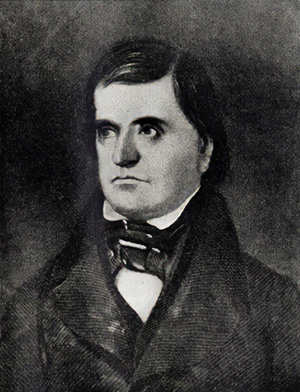
Tilghman Ashurst Howard was born November 14, 1797, in Pickensville, South Carolina. He moved to Tennessee in 1816, studied law, and was admitted to the bar, practicing in Knoxville from 1818. He moved to Rockville, Indiana in 1830 and served as U.S. attorney for Indiana from 1833-1837. In 1839, he was elected to the U.S. House of Representatives, where he served until his resignation in 1840.
He was appointed charge d’affaires to the Republic of Texas, where he served until his death from yellow fever in Washington-on-the-Brazos on August 16, 1844, after only two weeks at his post.
He and his wife, Martha Maxwell, had at least nine children. He is buried in Rockville, Indiana; Howard County, Indiana and Howard County, Iowa are named after him.
[Sources: https://www.findagrave.com/memorial/72554506/tilghman-ashurst-howard; https://en.wikipedia.org/wiki/Tilghman_Howard]
 §
§
Richard Belt
Epidemic Fever – Matamoros, Mexico 1844
U.S. Consul Richard H. Belt died during a typhus epidemic at Matamoros on November 11, 1844.
[Source: The Times-Picayune (New Orleans), December 4, 1844, Page 2, online at https://www.newspapers.com/image/25551184]
 §
§
Ferdinand Gardner
Tropical Fever – Cabo Verde 1847
Ferdinand Gardiner was born in about 1797. A merchant from New York, he was appointed U.S. Consul in the port of Praia from May 13,1837, until his death of a tropical fever on May 6, 1847. He was buried in the local Catholic cemetery.
[Sources: “From the Cape de Verd Islands,” New York Daily Herald, June 16, 1847, Page 2, online at Newspapers.com; Ancestry.com records; Office of the Historian records.]
 §
§
William A. Sparks
Cholera — Venice, Italy 1849
William Alexander Sparks of South Carolina was a medical doctor educated at Columbian College in Washington, DC (now the George Washington University) and entered Yale University in 1834. He completed his studies at the Medical College of South Carolina at Charleston and later in Paris. He was appointed by President Polk as U.S. Consul to Venice where he served from April 1846 to August 19, 1849, when he died of cholera at his post. Dr. Sparks’ remains were repatriated to the United States for burial at Society Hill, South Carolina. He left behind his wife, Alicia, and a daughter, Marie Alice. His papers can be found in the Thomas Cooper Library at the University of South Carolina. Note: His 1933 inscription on the AFSA memorial plaque includes middle initial “S” but documentation later found from the 1850s says “A.”
[Source: Dr. William Alexander Sparks, Welsh Neck Baptist Church Cemetery, Society Hill, South Carolina. Findagrave.com, Memorial ID 45553142; Ancestry.com records; Office of the Historian records.]
 §
§
Thomas T. Turner
Epidemic — Bahia, Brazil 1849
Thomas T. Turner III was born March 5, 1820, in New York, the son of Thomas and Mary Turner. He served as U.S. Consul in Bahia, Brazil, from August 1849 until his death during an epidemic less than four months later on December 2, 1849. Serving on a recess appointment, his position was not confirmed by the U.S. Senate until January 24, 1850, several weeks after his death. His remains were interred in Brazil and there is a cenotaph in his memory at Menands, New York.
[Sources: Thomas Turner III, Albany Rural Cemetery, Menands, New York. Findagrave.com, Memorial ID 160135505; Ancestry.com records; Office of the Historian records.]
 §
§
Thomas J. Morgan
Yellow Fever — Rio De Janeiro, Brazil 1850
Thomas Jefferson Morgan was born in Washington, Pennsylvania, on April 3, 1815, where his father, also Thomas Morgan, was a noted attorney. The younger Mr. Morgan married Martha Hamilton in 1839, became an attorney and was active in Ohio politics before he was appointed Secretary of Legation at the U.S. Embassy in Rio de Janeiro in June 1847. Well-liked in the expatriate community in Rio de Janeiro, he was actively engaged in assisting U.S. citizens and dealing with matters pertaining to shipping. Morgan died on March 30, 1850, at the age of 34 during a yellow fever outbreak in Rio de Janeiro, leaving behind his wife and four children under the age of ten. He was buried at the British Cemetery Gamboa in Rio, but his remains were repatriated to the United States in October of the same year along with those of the young son of U.S. Consul David Tod, who also died in the same yellow fever epidemic. Morgan was buried in Washington Cemetery in Washington County, Pennsylvania. Note: His 1933 inscription on the AFSA memorial plaque includes middle initial “I” but documentation later found from the 1850s says “J.”
[Sources: Thomas Morgan, British Cemetery Gamboa, Rio de Janeiro, Brazil. Findagrave.com, Memorial ID 125031168; Thomas Jefferson Morgan, Washington Cemetery, Washington, Pennsylvania. Findagrave.com, Memorial ID 167201671. “Eloquent Tribute,” The Pittsburgh Post, Pittsburgh, Pennsylvania, June 3, 1850, Page 2, online at Newspapers.com; “Very Late and Important From Brazil,” Semi-Weekly Spectator, Hamilton, Ontario, Canada, May 15, 1850, Page 3, online at Newspapers.com; “Our Brazil Correspondence,” New York Daily Herald, New York, New York, November 30, 1850, Page 2, online at Newspapers.com; Ancestry.com records; Office of the Historian records.]
 §
§
Hardy M. Burton
Yellow Fever — Isle of St . Thomas 1852
Hardy Murfree Burton was born June 7, 1818, in Murfreesboro, Tennessee. He attended the University of North Carolina and was a well-known attorney in Murfreesboro. He married Mary Hoggett in May 1849, but she died later the same year at age 21. Burton was the grandson of Col. Hardy Murfree, who served in North Carolina during the Revolutionary War, and Burton grew up in his house, Uxor Hill, which his mother inherited from her father. He served as U.S. Consul in St. Thomas from January 27, 1852, until his death of yellow fever on December 15, 1852, at the age of 34. Burton’s remains were repatriated via New Orleans and taken upriver to Nashville on a steamboat. He was buried in the Old City Cemetery in Murfreesboro, Tennessee in February 1853.
[Sources: Hardy M. Burton, Old City Cemetery, Murfreesboro, Tennessee. Findagrave.com, Memorial ID 24947567; “Died,” The Times-Picayune, New Orleans, Louisiana, February 5, 1853, Page 2, online at Newspapers.com; Ancestry.com records; Office of the Historian records.]
 §
§
Hector Ames
Fever – Mexico 1853
Hector Ames of New York City was born in 1825 to Barrett and Mary Craig Ames, a wealthy New York-based cotton merchant and the daughter of U.S. Congressman Hector Craig. Ames graduated from Columbia College (now Columbia University) and prior to his appointment to Acapulco, served as attaché at the U.S. Legation in Madrid. While in private practice as an attorney, he traveled to the Hawaiian Islands in 1851. He served as U.S. Consul in Acapulco, Mexico, from December 7, 1852, until his death from “fever of the country” on May 18, 1853, at the age of 28.
[Sources: Daily Alta California, Volume 4, Number 153, 3 June 1853; “Barrett Ames,” American Aristocracy website, https://americanaristocracy.com/people/barrett-ames; “Died,” New York Daily Herald, New York, NY, July 6, 1853, Page 8; online at Newspapers.com; Ancestry.com records; Office of the Historian records.]
 §
§
John Howden
Yellow Fever – Bermuda 1853
John W. Howden was born in Bristol, Vermont, on June 23, 1813. He had a farm in Ohio and served as the county Clerk of Court. He married Elizabeth Adams in 1844 in Mentor, Ohio. Howden was well-connected to influential members of the Democratic party in Ohio and took the position of U.S. Consul in Bermuda in part to spend time in a climate more suitable for his health -- he was ill with tuberculosis when he departed for his post in April 1852. He died of yellow fever in Saint George, Bermuda, on September 11, 1853, at the age of 40, leaving behind his wife and daughters Fannie and Mary. There is a cenotaph in Howden’s memory at Evergreen Cemetery in Painesville, Ohio, and his remains were interred at St. Peter’s Churchyard in Saint George, Bermuda.
[Sources: John W. Howden, Evergreen Cemetery, Painesville, Ohio. Findagrave.com, Memorial ID 66504986; “Death of John W. Howden,” Weekly Plain Dealer, Cleveland, Ohio, October 6, 1853, Page 4, online at Newspapers.com; Ancestry.com records; Office of the Historian records.]
 §
§
George R. Dwyer
Coast Fever — Maputo, Mozambique 1854
George R. Dwyer of Salem, Massachusetts, was born in 1832 to John Dwyer, a merchant, and his wife, Mary Dodge Dwyer. He had several siblings, including a brother, John F. Dwyer, who was a sea captain. He was appointed as U.S. Consul to Mozambique on June 4, 1853. He died on June 24, 1854, of “coast fever” (probably malaria) in Maputo, Mozambique at the age of 25.
[Sources: Dwyer, George R. (d. 1854). The Political Graveyard website. https://politicalgraveyard.com/bio/dwyer.html#422.06.20; “Death of a U.S. Consul,” The Baltimore Sun, Baltimore, Maryland, September 27, 1854, Page 2, online at Newspapers.com; The New Orleans Crescent, New Orleans, Louisiana, October 4, 1854, Page 3, online at Newspapers.com; “Death of a United States Consul,” The Autauga Citizen, Prattville, Alabama, October 12, 1854, Page 2, online at Newspapers.com; Ancestry.com records; Office of the Historian records.]
 §
§
Samuel Collings
Tropical Disease – Tangier, Morocco 1855
Samuel Phinney Collings was born in 1816 in Wilkes-Barre, Pennsylvania. He was the editor of The Republican Farmer newspaper in Wilkes-Barre from 1835 to 1852. He attended West Point as a cadet but resigned due to ill health. He arrived in Tangier, Morocco, on January 3, 1855, as U.S. Consul accompanied by his wife, Elizabeth Beaumont Collings, two of their five children, and his sister-in-law. He died on June 15, 1855, of a “congestive fever” or “African fever” (19th century terms usually referring to malaria) just six months after arrival at the age of 39.
[Sources: The Sunbury Gazette and Northumberland County Republican, Sunbury, Pennsylvania, July 21, 1855, Page 2, online at Newspapers.com; https://archive.org/details/historicalrecordv6john/page/n121/mode/2up, Page 56; Ancestry.com records; Office of the Historian records.]
 §
§
William McCracken
Tropical Disease – La Unión, El Salvador 1857
William D. McCracken was born in Pennsylvania in 1819. He practiced law in Farmington, Missouri, for 12 years and served as Clerk of the Missouri Senate for five years prior to his consular appointment. He was the U.S. Consul in La Union, El Salvador. Ill from a local fever acquired in La Union, he embarked on the steamer Panama in an attempt to improve his health but died on the voyage on July 7, 1857, of a “congestive fever” (19th century term usually referring to malaria) at the age of 39. He was buried on an island (possibly Isla San Lucas) in the Bay of Nicoya, opposite Punta Arenas, Costa Rica. His widow returned to her hometown in Illinois shortly after his death. They had been married a short time and did not have children.
[Source: William D McCracken, Findagrave.com, Memorial ID 139993106; Ancestry.com records; Office of the Historian records.]
 §
§
William Venable
Cholera – Guatemala 1857
William Edward Venable was born August 4, 1804, in Virginia and was a partner in the law firm Venable and Garner in Winchester, Tennessee. He married Jane Curle in 1841 and they had seven children, six of whom survived into adulthood. He served as a state legislator in Tennessee from 1847 to 1849 and was a delegate to the Nashville convention in 1850 at which nine states debated secession. On March 24, 1857, he was confirmed by the U.S. Senate as Secretary of Legation in Brazil, but he declined that appointment. He was appointed as Minister Resident (chief of mission) to Guatemala where he died of cholera on August 22, 1857, at age 53, just 21 days after his arrival and before he could present his credentials. He died in the home of the incumbent Minister, Henry Savage, and was buried in the local Protestant burial ground (now Cementerio General).
[Sources: William Edward Venable, Findagrave.com, Memorial ID 193704004; Ancestry.com records; Office of the Historian records.]
 §
§
Edward Ely
Dysentery – Bombay, India 1858
Edward Lawrence Ely was born in Pennsylvania in 1824. He was a Quaker and a medical doctor, and studied medicine under his uncle, Dr. Ralph Lee. In 1850, worried about his health, Ely abandoned his medical practice and set off to travel the world, visiting California during the Gold Rush, the South Pacific, and ended up in Bombay. His story was published in 1954 in The Wanderings of Edward Ely: A Mid-19th Century Seafarer’s Diary. He served as a consul in Bombay (now Mumbai) India from May 8, 1852, until his death on January 17, 1858, of dysentery at the age of 34, just two days after the baptism of his newborn son, Edward.
[Source: Ancestry.com records; Office of the Historian records.]
 §
§
James Torbert
Yellow Fever – St. Thomas 1858
James W. Torbert of Boonville, Missouri, married Eliza Muir in Missouri on May 18, 1854. He was appointed Commercial Agent in St. Thomas on February 24, 1858, and confirmed as U.S. Consul there on April 24 of the same year. He and arrived in St. Thomas on May 10, 1858, and died on December 26, 1858, of yellow fever after an illness of five days. He was buried in St. Thomas. Note: His inscription on the AFSA memorial plaque says “Torburt” but documentation later found from the 1850s says “Torbert.”
[Sources: “Died,” New York Tribune, New York, New York, January 22, 1859, Page 7, online at Newspapers.com; Ancestry.com records; Office of the Historian records.]
 §
§
Beverly L. Clarke
Tropical Fever — Guatemala 1860
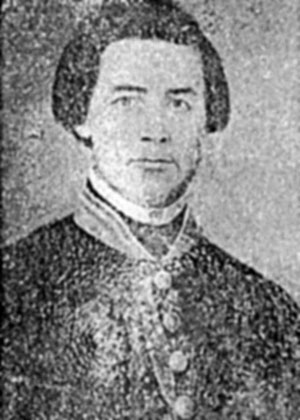
Beverly Leonidas Clarke was born in Winterfield, Virginia in 1809. A graduate of Lexington Law School, he was admitted to the bar in 1833 and served as a Democrat in the Kentucky and U.S. Houses of Representatives. He was a delegate to the State constitutional convention in 1849 and later ran unsuccessfully for the governorship of his home state.
President James Buchanan appointed Clarke as minister to Guatemala and Honduras in 1858. Clarke died in the former nation two years later.
 §
§
Isaac S. McMicken
Yellow Fever — Acapulco, Mexico 1860
Isaac Smith McMicken was born in Pottsville, Pennsylvania. He served in the U.S. Army in the Mexican-American War, and again in Mexico in 1851-1852, rising to the rank of Colonel. He served as Postmaster of the U.S. Army in Vera Cruz and was also an attorney. He served as U.S. Consul at Acapulco from May 28, 1858, to April 23, 1860, when he died of yellow fever at his post. McMicken was buried in the American Cemetery at Playa Larga in Acapulco.
[Sources: “Latest News Telegrams, The Daily Exchange, Baltimore, Maryland, June 18. 1860, Page 1, online at Ancestry.com; Col Isaac Smith McMicken, American Cemetery Playa Larga, Acapulco de Juarez Mexico, Findagrave.com, Memorial ID 249155449; Ancestry.com records; Office of the Historian records.]
 §
§
William Stapp
Yellow Fever – Pernambuco, Brazil 1860
Col. Walter William Stapp of Louisville, Kentucky, was editor of the Kentucky Yeoman. He was appointed as U.S. Consul in Pernambuco (Recife), Brazil, by President Buchanan and confirmed on June 14, 1858. He served as consul there, heavily involved in shipping matters and the repatriation of American seamen shipwrecked in the South Atlantic, until his death of yellow fever on April 8, 1860. He was buried in the British Cemetery in Recife. He was 34 years old.
[Sources: “Humanity of a British Captain,” Liverpool Mercury, Liverpool, England, January 19, 1860, Page 3, online at Newspapers.com; “News of the Day,” The New York Times, New York, New York, May 11, 1860, Page 4, online at Newspapers.com; Col Walter W. Staff, British Cemetery, Recife, Brazil, Findagrave.com, Memorial ID 248717730; Ancestry.com records; Office of the Historian records.]
 §
§
John Amory
Cholera – Calcutta, India 1860
John Ellery Amory was born in Boston, Massachusetts, on December 20, 1831, the son of Thomas Coffin Amory, Jr. and Ester Sargent. He attended Boston Public Latin School and became a lawyer, before procuring a passport and leaving the United States in March 1856. He was appointed Vice Consul in Calcutta in May 1857. He died of cholera in Calcutta on June 28, 1860.
[Sources: Boston Evening Transcript, Boston, Massachusetts, May 18, 1857, Page 2, online at Newspapers.com; Ancestry.com records; Office of the Historian records.]
 §
§
Henricus Heusken
Murdered – Edo, Japan 1861
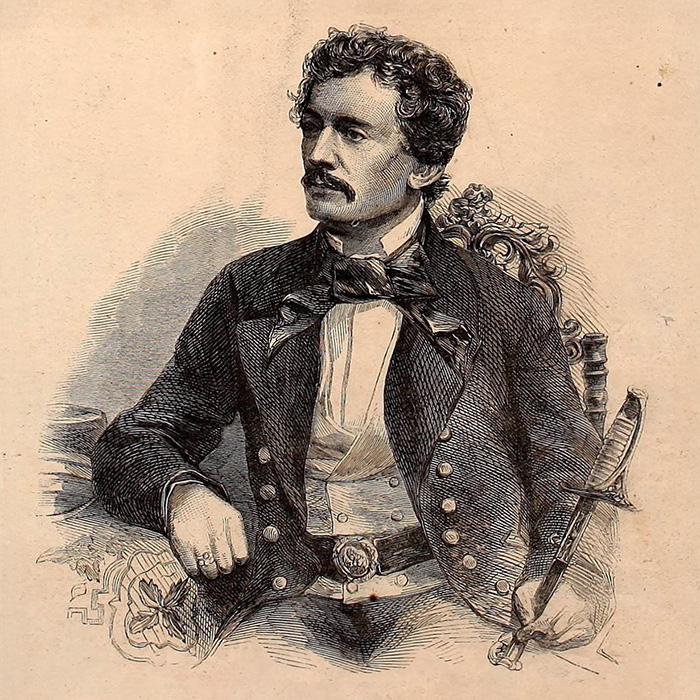
Henry Heusken was a Dutch-American interpreter for the first U.S. consulate in Japan. Born Henrick Conrad Johannes Heusken in Amsterdam in 1832, he spent much of his childhood at a boarding school in Brabant before emigrating to the United States in 1853 after the death of his father. He changed his name to Henry in New York City, where local contacts put him in touch with Townsend Harris, who had just been appointed the first U.S. Consul General to Japan and sought an interpreter who spoke Dutch, the only European language familiar in Japan at that time.
Harris and Heusken sailed from New York in October 1855, stopping in the Kingdom of Siam (Thailand) to negotiate a commercial treaty, and arrived in Japan in August 1856. They lived in extreme isolation in Japan. However, their work led to the conclusion of the Treaty of Amity and Commerce in 1858. Heusken also worked for the newly arrived Lord Elgin, British Minister to Japan, who sought a similar treaty between the United Kingdom and Japan during that period.
In January 1859, the U.S. Consulate became a Legation and was relocated to Edo (Tokyo). Heusken frequently rode around the city on horseback, which was a privilege traditionally reserved for the samurai caste, and offensive to anti-Western locals, which led to at least one stoning incident. In his personal diary, Consul Harris noted that Heusken was cavalier about is personal safety, often going out unarmed and at night. On the night of January 15, 1861, while returning home from a dinner with a Prussian diplomat, Heusken and the security detail accompanying him were attacked, possibly by anti-foreign samurai. Although Heusken was severely wounded, he mounted a horse and galloped 200 yards to the American Legation, where he was treated by surgeons from the British and Prussian Legations. He died shortly after midnight on January 16 at the age of 28. He was buried at the cemetery in Korin-ji in Tokyo on January 18. Following his funeral, most foreign diplomats in Edo relocated to Yokohama for safety. While the Japanese government made a $10,000 payment to Heusken’s mother, no one was ever convicted for his murder, and the unsolved case remained a hindrance to U.S.-Japanese relations for some time thereafter.
[Sources: “Interesting from Japan: Further Particulars of the Murder of the American Secretary of Legation,” The New York Times, April 11, 1861, Page 5, online at Newspapers.com; “Henry Heusken,” Wikipedia.org, https://en.wikipedia.org/wiki/Henry_Heusken; Ancestry.com records; Office of the Historian records.]
 §
§
Isaiah Thomas III
Lost at Sea – Atlantic Ocean 1862
Isaiah Thomas III was born in Worcester, Massachusetts, on November 29, 1805. He married Mary Ann Reeder in May 1831 in Cincinnati, Ohio, and they had six children. His wife died in 1851. He was appointed consul to Algiers by President Lincoln. He was confirmed as consul on January 22, 1862, and departed New York on the SS Milwaukee with his three of his four children on February 21; however, the ship was lost at sea. He was survived by his eldest son, Edward Thomas.
[Sources: Isaiah Thomas III, Buried or Lost at Sea, Findagrave.com, Memorial ID 134049994; Ancestry.com records; Office of the Historian records.]
 §
§
William R. Williams
Yellow Fever – Para, Brazil 1862
William Richard Williams was born on March 23, 1838, in Lockport, Ohio, to Welsh immigrant parents. Trained as a lawyer, he spent two years writing a manual for attorneys, which he was revising at the time of his death. Williams had married a daughter of wealthy Para (now Belem), Brazil, attorney William Potter on July 15, 1862. After being offered eleven different potential posts, he chose Brazil and was confirmed as U.S. Consul in Para, Brazil, on January 22, 1862. He took ill suddenly on September 19 and remained lucid enough to put his affairs in order before he died of yellow fever on September 25, 1862, at the age of 24. In addition to his wife, he left behind his parents, William and Catherine, and four siblings in Ironton, Ohio.
[Sources: Welsh language article “Y Diweddar William Richard Williams,” Herald, Caernarfon, Gwynedd, Wales, May 2, 1863, Page 2, online at Newspapers.com; Ancestry.com records; Office of the Historian records.]
 §
§
William Baker
Murdered – Mazatlán, Mexico 1862
William L. Baker of Maryland was confirmed as U.S. Consul in Mazatlán for Guaymas, Mexico, on August 5, 1861. On December 20, 1862, while traveling with a delegation of American businessmen to visit silver mines in Guaymas, one member of the party found the travel too dangerous and refused to proceed, while the rest of the group, including Baker, continued on the road. A few days later, the remains of the traveling party, including Baker, were discovered. They had been shot with arrows.
[Sources: “Murder of the U.S. Consul at Guaymas,” The Sacramento Bee, Sacramento, California, January 24, 1863, Page 2, online at Newspapers.com; Ancestry.com records; Office of the Historian records.]
 §
§
Edward W. Gardner
Lost at Sea — 1863
Edward Waterman Gardner was born in 1804 in Nantucket, Massachusetts, became a merchant, and was appointed U.S. Consul to Apia, Samoa, on January 15, 1862. On January 1, 1863, he departed with his wife, Phebe Hussey Gardner, from Fiji enroute to Apia aboard the schooner Anita. The vessel was swamped in a hurricane in the South Pacific and Gardner and his wife went down with the vessel. On February 3, a chair belonging to Gardner washed ashore on the island of Vavau (Tonga) among other items, many marked with the name of the captain of the Anita. In addition to Consul Garner and his wife, other passengers on the ship included the sister and two children of the British Consul in Fiji. Gardner left behind two adult sons from his first marriage in Massachusetts. He was 58 years old at the time of his death.
[Sources: “Wreck,” The Sydney Morning Herald, Sydney, Australia. May 21, 1863, Page 11, online at Newspapers.com; Trood, Thomas, Island Reminisces, McCarron, Stewart & Co., Sydney, Australia, 1912, http://public-library.uk/dailyebook/Island%20reminiscences%20(1912).pdf; Ancestry.com records; Office of the Historian records.]
 §
§
George True
Smallpox — Funchal, Madeira 1864
George True was born in 1833 in Maine and was confirmed as the U.S. Consul in Funchal, Madeira, Portugal, on July 26, 1861. He served in that capacity until he died at his post on February 22, 1864, of smallpox at the age of 30. True married Susan Laughrey in 1857 in Knox County, Ohio, and they had two children, Katherine and George. True had been vaccinated twice for smallpox prior to his illness, and that no other known cases of smallpox had occurred for some time in Funchal at the time of his death. He is buried in Mound View Cemetery in Knox County, Ohio.
[Sources: George True, Mound View Cemetery, Mount Vernon, Ohio, Findagrave.com, Memorial ID 83632376; Ancestry.com records; Office of the Historian records.]
 §
§
William Thayer
Malaria – Alexandria, Egypt 1864
William Sydney Thayer, a Harvard graduate, was a correspondent of the New York Evening Post, and later became the editor in chief. Having always been in ill health, he traveled to other climates seeking to improve it, which is how he ended up participating in an ill-fated expedition to Nicaragua in 1855 with American politician Henry Kinney. Having survived the expedition, but still in poor health, Thayer accepted Secretary of State Seward’s offer to appoint him as U.S. Consul General in Alexandria, Egypt, in March 1861.
He died in Alexandria of malaria on April 10, 1864. He was 37 at the time of his death and buried in the Old British Protestant Cemetery in Alexandria, Egypt. In 2022, after a two-year search by renowned Egyptian archaeologist Dr. Zawi Hawass and his team, and at the urging of Cairo’s Deputy Consul General Mark Marrano, Consul General Thayer’s grave, that of Consul General Daniel Smith McCauley (died in 1852), and the spouse of another U.S. Consul General, Eleanor Gliddon (died in 1837), were rediscovered in the overgrown and vandalized cemetery.
[Sources: Springfield Weekly Republican, Springfield, Massachusetts, May 7, 1864, Page 4, online at Newspapers.com; William Sydney Thayer, Findagrave.com, Memorial ID 1615050506; Ancestry.com records; Office of the Historian records.]
 §
§
Charles G. Hannah
Yellow Fever — Demerara, British Guinea 1864
Charles Gilbert Hannah was born in Salem, New Jersey, in 1833 and attended Burlington College. He was confirmed as U.S. Consul to Demerara, British Guinea (modern-day Guyana) on February 23, 1864, but died of yellow fever on December 8, 1864, at his post at the age of 31.
[Sources: Ancestry.com records; Office of the Historian records.]
 §
§
Alexander McKee
Dysentery – Panama City, Colombia 1865
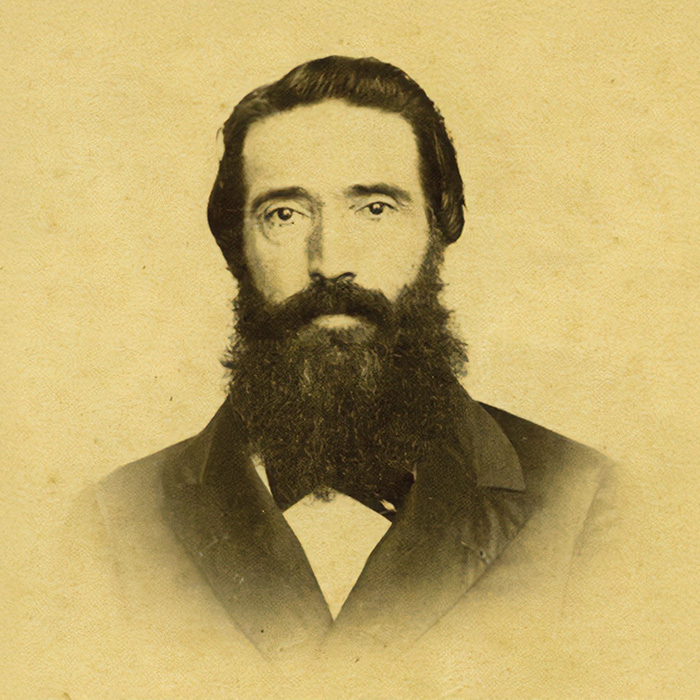
Alexander Robertson McKee was born in 1815 in Kentucky was confirmed as U.S. Consul in Panama City, Colombia (modern-day Panama) on July 26, 1861. He died there of chronic dysentery on September 3, 1865, and left behind his wife, Martinett Hardin McKee and six children. McKee was buried in Panama. Correspondence between McKee and Abraham Lincoln can be found in the Abraham Lincoln papers. His remains may have been repatriated, as there is a grave marker for him in the family plot at Frankfort Cemetery in Frankfort, Kentucky.
[Sources: Alexander Robertson McKee, Frankfort Cemetery, Frankfort, Kentucky, Findagrave.com, Memorial ID 58433853; Ancestry.com records; Office of the Historian records.]
 §
§
William Irvin
Cholera – Amoy, China 1865
William Irvin was born in 1805 in Linden Hall, Pennsylvania. He married Martha Curtin and had two sons. Irvin was a medical doctor, and his oldest brother, James Irvin, was a Member of Congress. Irvin was confirmed at U.S. Consul to Amoy (Xiamen), China, on April 7, 1864. He arrived at post on October 25, 1864, and died of cholera on September 9, 1865, while treating local residents as a volunteer physician during a cholera epidemic.
[Sources: “Death of the American Consul at Amoy, China,” Baltimore Daily Commercial, Baltimore, Maryland, November 29, 1865, Page 1, online at Newspapers.com; Ancestry.com records; Office of the Historian records.]
 §
§
Jose Casagemas
Cholera – Barcelona, Spain 1865
Jose Casagemas served as U.S. Vice Consul in Barcelona, Spain, from April 30, 1865, until his death on October 9, 1865, of cholera during an epidemic. He was succeeded at his post by his brother, Manuel Casagemas, who served as Vice Consul in Barcelona until 1893.
[Sources: “The Cholera at Barcelona,” Baltimore Daily Commercial, Baltimore, Maryland, November 6, 1865, Page 1, online at Newspapers.com; Ancestry.com records; Office of the Historian records.]
 §
§
Abraham Hanson
African Fever — Monrovia, Liberia 1866
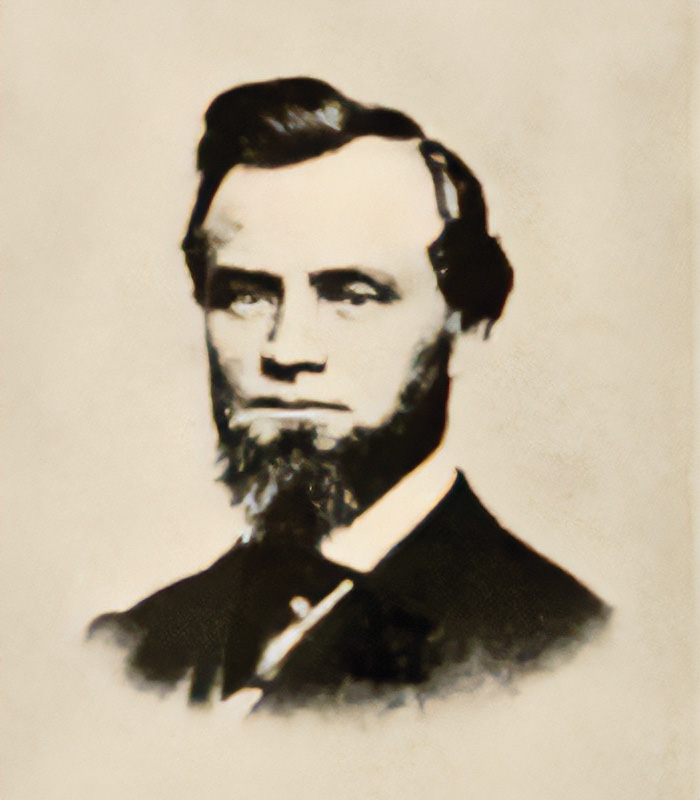
Abraham Hanson, a Methodist clergyman and teacher, was born in Otley, England in 1819, graduated from Bromley College, and emigrated to the United States with his wife, Lydia Handley Hanson and his parents, to serve as a pastor in the Methodist Episcopal Church. A staunch abolitionist, he preached throughout the Midwest before becoming a local political and city treasurer in Kenosha, Wisconsin. Hanson became a naturalized U.S. citizen in 1842.
Hanson was appointed Commercial Agent to Monrovia, Liberia, in May 1862, and later became the Commissioner and Consul General on June 18, 1863 -- the first American diplomat permanently posted in sub-Saharan Africa, where he was determined to support the growing population of freed slaves taking up resident in the new country. He was confirmed in the role on January 12, 1864. He died at his home in Monrovia on July 20, 1866, likely of malaria, of which he had had recurring bouts for some time. He was 47 years old. Hanson left his wife his house in Kenosha, Wisconsin, and the life insurance policy he took out prior to assignment to Monrovia.
[Sources: “Death of Abraham Hanson, The Daily Milwaukee News, Milwaukee, Wisconsin, September 25, 1866, Page 4, online at Newspapers.com; “Death of Hon. A Hanson,” The Telegraph-Courier, Kenosha, Wisconsin, September 27, 1866, Page 3, online at Newspapers.com; Ancestry.com records; Office of the Historian records.]
 §
§
Hiram R. Hawkins
Epidemic — Tumbez, Peru 1866
Hiram R. Hawkins was born in 1827 in Lansingburgh, New York. He emigrated to California in 1849, and after sailing around Cape Horn, arrived in San Francisco on July 11, 1849, at the height of the Gold Rush. He settled in Placer County and worked as a miner. Hawkins ran for public office several times after California joined the Union, serving as Deputy County Clerk and Justice of the Peace. He also worked as a newspaper editor from 1861. In California, he married Eliza B. Ecklea, and they had three children. His wife and two of their children died in 1855, while his oldest child, John, was sent to the home of his grandfather, Ezekiel Hawkins in Lansingburgh, New York, and raised there. In 1863, Hawkins moved to Gold Hill, Nevada, and became editor of the Gold Hill News.
While in Nevada, Hawkins was appointed Consul to Tumbes, Peru, on March 17, 1865, and confirmed on March 26, 1866. He died at post on November 28, 1866, at the age of 39 during a local epidemic.
[Sources: Hiram R. Hawkins, Lansingburgh Village Cemetery, Lansingburgh, New York, Findagrave.com, Memorial ID 115956030; “Death of Hiram R. Hawkins, Gold Hill Daily News, Gold Hill, Nevada, January 16, 1867, Page 2, online at Newspapers.com; Ancestry.com records; Office of the Historian records.]
 §
§
William Little
Yellow Fever – Panama City, Colombia 1867
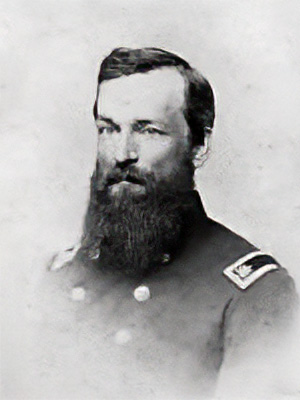
Born in Massachusetts on April 22, 1822, William Baldwin Little was a medical doctor who established and operated William B. Little and Company, Druggists and Manufacturing Chemists in Boston in 1848; he also traveled to San Francisco, California, where he established the Little & Company Drug Store. Married to Sarah E. Butts in 1846, they resided in both Boston and San Francisco. During the Civil War, he was commissioned as a surgeon in Staten Island, New York, and served with the American Medical Association in New York City during the war. Little was confirmed as Consul to Panama City, Colombia (now Panama) on February 16, 1866. He died on January 29, 1867, of yellow fever and was buried in the Cementerio de Extranjeros (Foreigners’ Cemetery) in Panama City. He left no children.
[Sources: Dr. William Baldwin Little, Cementerio de Extranjeros, Panama City, Panama, Findagrave.com, Memorial ID 99699422; Ancestry.com records; Office of the Historian records.]
 §
§
Louis Prevost
Yellow Fever – Guayaquil, Ecuador 1867
Louis Victor Prevost was born in Baltimore in about 1824. He was married to Charlotte LeBrun in 1849 and they had five children, three of whom survived to adulthood. He was appointed as U.S. Consul in Guayaquil, Ecuador, on May 8, 1863, with confirmation on March 18, 1864. Already resident in Guayaquil, Prevost had organized a company there in 1861. He died on May 23, 1867, at his post of yellow fever at the age of 43.
[Sources: “From the Isthmus--The March of Revolution,” The Portland Daily Press, Portland, Maine, June 12, 1867, Page 3, online at Newspapers.com; Ancestry.com records; Office of the Historian records.]
 §
§
Allen A. Hall
Epidemic — La Paz, Bolivia 1867
Allen Atkinson Hall was born in North Carolina in 1804 and moved to Nashville, Tennessee in his youth. He studied law and passed the bar, but rather than become an attorney, he turned to political writing, and in 1825 was made editor of two Nashville newspapers. Hall left journalism in 1841 to become the Charge d’ Affaires to Venezuela, returning to Nashville and journalism in 1845, and then to Washington to the Department of the Treasury in 1849 as Assistant Secretary of the Treasury. He also became editor of The Republic in Washington, D.C. in 1850 but returned to Nashville in 1857 to operate the Nashville Daily News.
In 1859, Hall, as editor of the Nashville News became involved in editorial warfare with the Nashville Union and its editor, George G. Poindexter, who accused Hall of being an abolitionist. On November 18, 1859, Poindexter approached Hall carrying an umbrella that concealed a pistol and walked toward Hall’s news office. Hall stepped outside with a shotgun and shouted for Poindexter to stop. When he did not comply, Hall shot him, killing him instantly. Hall was never tried for the killing, and this incident was inspiration for Mark Twain’s short story “Journalism in Tennessee.”
Hall became U.S. minister to Bolivia in 1863 and died during a local epidemic in Cochabamba, Bolivia, on May 28, 1867, at the age of 62. He was predeceased by two spouses and a son and survived by his daughters, Lucy, Isabelle, and Sophia.
[Sources: “Death of the United States Minister to Bolivia,” Boston Evening Transcript, Boston, Massachusetts, July 18, 1867, Page 2, online at Newspapers.com; Ancestry.com records; Office of the Historian records.]
 §
§
H. E. Peck
Yellow Fever — Haiti 1867
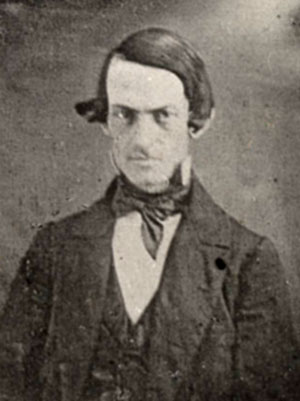
Henry Everard Peck was born in Rochester, New York in 1821. A graduate of Bowdoin College and the Oberlin Theological Seminary, he became a Professor of Sacred Rhetoric and an Adjunct Professor of Mental and Moral Philosophy at Oberlin College. Peck was also an avid abolitionist who traveled throughout Ohio giving speeches and campaigning for anti-slavery candidates.
In September 1858, Peck and a group of fellow abolitionists helped John Price, an escaped slave arrested by Oberlin authorities under the Fugitive Slave Act, flee to freedom in Canada. Peck spent 85 days in jail for his participation in what is now known as the Oberlin-Wellington Rescue.
After helping to recruit Union soldiers for the Civil War, Peck served as the first U.S. Minister Resident (Chief of Mission equivalent) and Consul General to Haiti. He died there of yellow fever on June 9, 1867.
 §
§
Edward Conner
Dysentery – Mexico 1867
Edward Conner was born in 1824 in New York, but lived for years in San Francisco, California, where he was active in journalism and business. He held consular positions in Talcuahana, Chile, and Mazatlán, Mexico. He was confirmed as U.S. Consul to Guaymas, Mexico, on March 13, 1863; he was also extensively involved in a mercantile business. He died in Bacochirampo, Mexico (near Guaymas) on July 16, 1867, of dysentery at age 42. He was buried in San Francisco, California, on September 10, 1867.
[Sources: “In Memoriam,” the San Francisco Examiner, San Francisco, California, October 14, 1867, Page 3, online at Newspapers.com; Daily Alta California, Volume 19, Number 6366, 20 August 1867 and Volume 19, Number 6418, 11 October 1867; Ancestry.com records; Office of the Historian records.]
 §
§
James Wilson
Yellow Fever — Caracas, Venezuela 1867
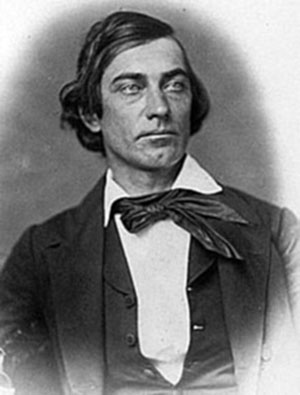
James Wilson was born in Crawfordsville, Indiana in 1825. He graduated from Wabash College and, later, earned a law degree from Indiana University. After serving in the Mexican-American war, he was admitted to the Indiana bar and elected as a Republican to the U.S. House of Representatives. Wilson later reached the rank of brevet lieutenant colonel while fighting for the Union in the Civil War.
In 1866, President Andrew Johnson named James Wilson the U.S. minister resident to Venezuela. He served for one year before succumbing to yellow fever on August 8, 1867.
[Source: https://en.wikipedia.org/wiki/James_Wilson_(Indiana_politician)]
 §
§
Edward Maynard
Yellow Fever – Turks Island 1868
Edward Maynard was born in Knoxville, Tennessee on February 3, 1843, the son of Horace Maynard, an abolitionist and southern Congressman, and later Tennessee’s attorney general, who served as U.S. Minister to the Ottoman Empire and U.S. Postmaster General following his son’s death. Edward Maynard attended Amherst College, and married Eliza Jane Harper in Ohio in September 1866.
Maynard was confirmed as U.S. Consul to Turks Island in the West Indies on May 14, 1866. He died at his post on Grand Turk Island on January 10, 1868, of yellow fever at age 24, shortly before the birth of his only child on Grand Turk Island just a few weeks later who was named Edward for his deceased father. Maynard’s remains were repatriated, and he is buried in Knoxville, Tennessee.
[Sources: Edward Maynard, Old Gray Cemetery, Knoxville, Tennessee, Findagrave.com, Memorial ID 43322264; Ancestry.com records; Office of the Historian records.]
 §
§
William Smyley
Cholera – Uruguay 1868
William Horton Smyley was born in 1792 in Providence, Rhode Island. It is believed that he first sailed to the south Atlantic on a whaling or sealing ship in the 1820s, and he spent much of the next 22 years of his life at sea. He first married Evelina Chafee in 1839; she died in Newport, Rhode Island in 1847. His second wife, Catherine Clapp, accompanied him when he settled in the Falkland Islands, where he was a merchant sea captain. They had two daughters, Evelina and Catherine, and a son, William.
Smyley was appointed to be a commercial agent at Port Stanley, Falkland Islands, on September 12, 1850, and then as U.S. Consul to Rio Negro, Argentina on September 28, 1850; however, it appears he never took up permanent residence in Rio Negro because of the Argentine government’s opposition at the time to foreign diplomats posted outside the capital. Smyley returned to Port Stanley, and in 1857 and again in 1859, he and his crew saved shipwrecked sailors near the Falkland Islands. Smyley sent his wife and children to the United States early during the Civil War and departed for Montevideo in 1854 in search of a better climate for his own health. He returned to the Falkland Islands to aid an American ship carrying arms to San Francisco and returned to the United States in June 1864.
He returned to the Falkland Islands in 1866 and discussed returning to Rio Negro, but there is no evidence that he ever went. He died on February 14, 1868, in Montevideo, Uruguay, during a cholera epidemic while visiting the U.S. consul there. He is buried in the British Cemetery in Montevideo. Smyley Island in Antarctica is named after him.
Note: His inscription on the AFSA memorial plaque says “Smiley” but documentation later found from the 1860s says “Smyley” except his tombstone which reads “Smyly.”
[Sources: Capt. William Horton Smyley, British Cemetery, Montevideo, Uruguay, Findagrave.com, Memorial ID 60555248; “Adventures of a Belgian Sailor,” Buffalo Weekly Express, Buffalo, New York, January 18, 1859, Page 2, online at Newspapers.com; Dictionary of Falklands Biography website: https://www.falklandsbiographies.org/biographies/smyley_william; Ancestry.com records; Office of the Historian records.]
 §
§
James H. McColley
Yellow Fever — Callao, Peru 1869
James Henry McColley was born in Pennsylvania. He was confirmed at U.S. Consul at Callao, Peru, on February 14, 1865. McColley and his family had temporarily moved from Callao to Lima following earthquakes in the region. His daughter was married to his vice consul and the family had lost his grandchild just a year earlier. McColley died at his residence in Lima of yellow fever on April 17, 1869. He was initially buried in Peru, while his remains were later repatriated to the United States.
[Sources: “Peru,” New York Herald, New York, NY, May 10, 1869, online at Newspapers.com; Ancestry.com records; Office of the Historian records.]
 §
§
William Stedman
Yellow Fever — Santiago, Cuba 1869
William Stedman was born November 24, 1816, in Granville, Ohio. He was a farmer in Randolph, Ohio, and was involved in local politics. He married Elizabeth Elmore and they had five children. He was elected as a Republican to the Ohio State Legislature in 1859. During the Civil War, Stedman enlisted in the Ohio cavalry in 1861 and served through March 1865, mustering out with the rank of Brigadier General. He and his three sons fought in that same regiment. After the war, he continued for a time to serve in the Ohio State Legislature and Senate.
He was confirmed as U.S. Consul in Santiago de Cuba on April 7, 1869, but died of yellow fever soon after arrival on July 6, 1869, at the age of 53. He was buried at his post, but there is a cenotaph in his honor in the family plot at Disciple Cemetery in Randolph, Ohio.
[Sources: Ancestry.com records; https://www.ohiocivilwarcentral.com/william-stedman/; Office of the Historian records.]
 §
§
Charles E. Perry
Epidemic — Aspinwall, Colombia 1872
Charles Erasmus Perry was born in New York City in 1834. A resident of Albany, New York, he served as superintendent of the U.S. Telegraph service in Albany in 1865. Perry was confirmed as U.S. Consul to Aspinwall, Colombia (now Colon, Panama) on April 16, 1869. He served at his post from June 1, 1869, until his death of a “sudden fever” on October 17, 1872, at the age of 38. He was survived by his wife, Harriet Day Shepard Perry, and three of their four sons, Charles Jr., John, and William. His remains were repatriated in 1875 and interred in Albany Rural Cemetery in Menands, New York.
[Sources: “News Items,” The Times Record, Brunswick, Maine, October 26, 1872, Page 2, online at Newspapers.com; “Spanish Insolence,” Washington Chronicle, Washington, D.C., May 30, 1872, Page 1, online at Newspapers.com; “Hon. Charles E. Perry, United States Consul at Aspinwall,” The New York Times, New York, NY, October 26 1872, Page 1, online at Newspapers.com; “Affairs at Aspinwall: The Galveston Daily News, Galveston, Texas, July 6, 1872, Page 2, online at Newspapers.com; Charles E. Perry Sr., Albany Rural Cemetery, Menands, New York, Findagrave.com, Memorial ID 177532957; Ancestry.com records; Office of the Historian records.]
 §
§
Charles Ballard
Dysentery – Zanzibar 1874
Charles Edwin Ballard was born November 3, 1851, in Salem, Massachusetts to James and Emeline Ballard. He first traveled to Zanzibar at the age of 16 to conduct business on behalf of a friend. Having contracted malaria during the subsequent four years he spent there; his health improved on his return to the United States. He was confirmed as U.S. Consul to Zanzibar on April 12, 1874, departing around the same time for his post. He never married and he died of dysentery in Zanzibar on October 12, 1874, at the age of just 22.
[Sources: “Ballard,” The Christian Leader, New York, NY, November 21, 1874, Page 11, online at Newspapers.com; Ancestry.com records; Office of the Historian Records]
 §
§
Thomas Biddle
Epidemic — Guayaquil, Ecuador 1875
Thomas Biddle, Jr. was born in Pennsylvania in 1827. He married Sarah White, and they had five children. He became a lawyer in 1848 and served as U.S. Consul in Calcutta, India, from 1854 to 1855 and as U.S. Consul in Singapore from 1856 to 1858. He later served as U.S. special diplomatic agent to Cuba in 1869 but was transferred to El Salvador to serve as the U.S. Minister Resident (Chief of Mission). He was then appointed to be U.S. Minister Resident to Ecuador before dying of yellow fever in Guayaquil on May 7, 1875, at the age of 48. His remains were interred in the family plot in Laurel Hill Cemetery in Philadelphia, PA, on May 9, 1879.
[Sources: “The Hon. Thomas Biddle,” New York Daily Tribune, New York, NY, May 18, 1875, Page 5, online at Newspapers.com; Thomas Biddle, Laurel Hill Cemetery, Philadelphia, PA, Findagrave.com; Ancestry.com records; Office of the Historian Records]
 §
§
John F. Flint
Drowned Saving Life — La Union, El Salvador 1875
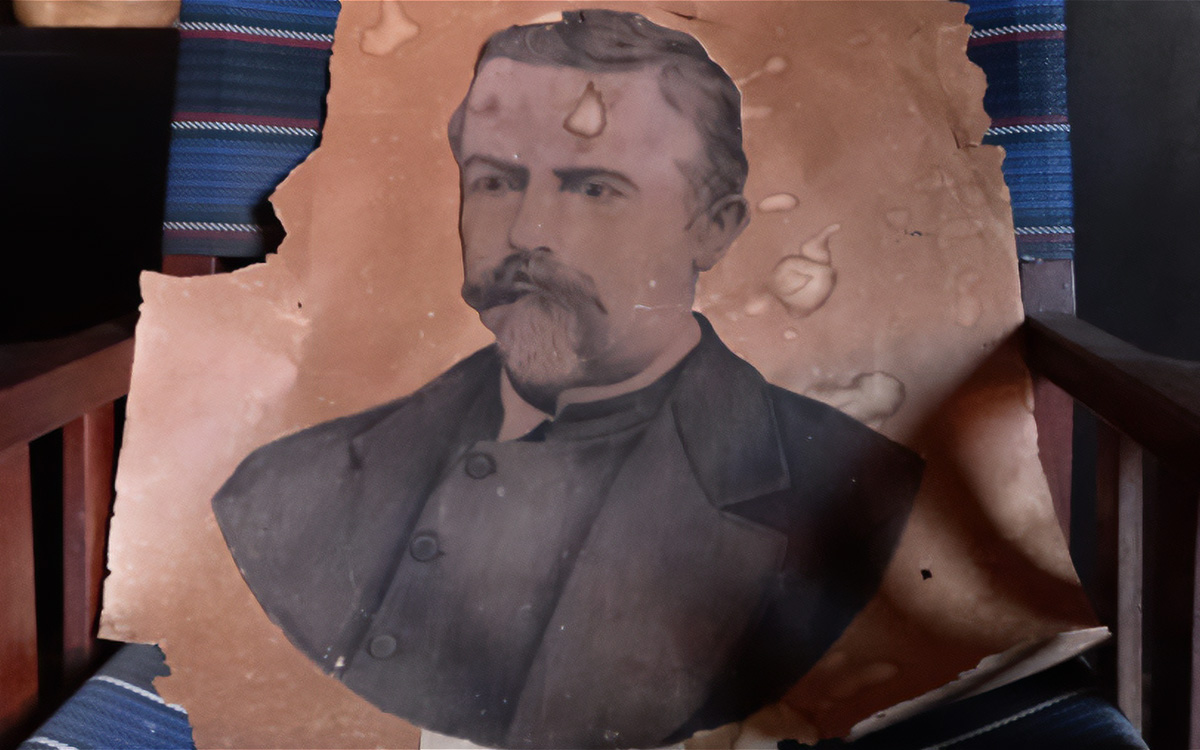
John Felix Flint was born in Montgomery Township, Pennsylvania. His father, Miles Standish Flint, was a farmer from Massachusetts who had been a merchant seaman in his youth, but his mother, Carmen Alcazar Flint, was born in Lima, Peru, likely arriving in the United States as a young adult. Flint studied medicine at Jefferson Medical College and became a doctor.
He was confirmed as U.S. Consul to La Union, El Salvador, on February 14, 1868. On September 17, 1875, Flint noticed the wife of John Harrison, the British Consul in La Union, struggling in the surf near Point Chiriqui at the entrance to the shark-infested harbor. Flint rushed to her rescue and held her above the waves for more than a half hour before he sank out of exhaustion. The tide suddenly turned and Mrs. Harrison was able to reach the shore. Flint’s remains were recovered and buried locally; he was 44 years old.
[Sources: “Death of Dr. J.F. Flint, United States Consul at La Union, San Salvador,” The Sun, New York, NY, September 29, 1875, online at Newspapers.com; Ancestry.com records; Office of the Historian Records]
 §
§
Philip Clayton
Yellow Fever — Callao, Peru 1877
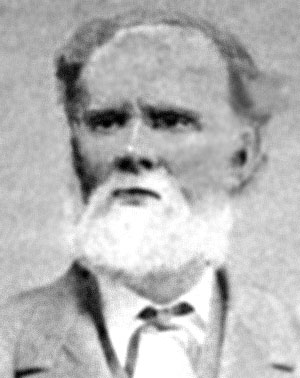
Phillip Clayton was born in Athens, Georgia in 1815. After graduating with honors from Franklin College (now the University of Georgia), he studied law and worked as the editor of the Athens Southern Whig. He later served for twelve years as second auditor of the Treasury and for four years as assistant secretary of the Treasury. Upon the secession of Georgia, Clayton left the Union and became assistant secretary of the Treasury of the Confederate States.
After the Civil War, Clayton worked at a Georgia savings bank before President Ulysses S. Grant named him U.S. Consul to Peru. Clayton served there for three years before his death of yellow fever on March 22, 1877.
[Source: Harrisburg (Pennsylvania) Telegraph, April 12, 1877, Page 1]
 §
§
Henry Sawyer
Murdered – Paramaribo, Suriname 1877
Henry Sawyer, originally from Massachusetts, served as U.S. consul in Paramaribo, Suriname, for 23 years. Contemporary accounts note that in 1861, the Confederate privateer CSS Sumter commanded by Admiral Raphael Semmes, who was famous for successfully running the Union blockade of New Orleans during the war, came into port in Suriname for coal and supplies. In response, Consul Sawyer bought up all the coal in the city to prevent the Confederate privateer from acquiring any, and he also hired all of the small boats in the harbor to prevent supplies from being delivered to the ship. As a result, the Sumter was delayed in port for more than a week, instead of the few hours they had planned. Meanwhile, Consul Sawyer sent word to a U.S. ship at Cayenne that the Sumter was in Suriname and could be seized, but unfortunately, no action was taken. The U.S. commander in Cayenne was later relieved of duty for his failure to respond to the Consul’s request.
In May 1877, Sawyer was called to the port to take custody of a sailor as part of his official duties. The sailor struck him in the head, then beat him so severely that he died a few days later. Sawyer left behind a widow, but no children. He was 51 years old.
[Sources: The Courier-Journal, Louisville, Kentucky, May 8, 1877; Der Deutsche Korrespondent, Baltimore, Maryland, May 11, 1877, Page 2; Ancestry.com records; Office of the Historian Records]
 §
§
Frank Frye
Fever – Roatán, Honduras 1879
Frank Eugene Frye was born in Lewiston, Maine, on December 30, 1846, to William and Millicent Mower Frye. As a young man, he moved to Nebraska, where he studied and practiced law. He later moved to Boston and served in the Union Army during the Civil War. He was married to Flora Campbell Frye and had one child.
At the time of Frye’s appointment as U.S. Consul to Omoa, Honduras, his cousin, William P. Frye, was the Maine Attorney General (and much later, President pro tempore of the U.S. Senate). Frank Frye was confirmed as U.S. Consul to Omoa, Honduras on April 24, 1874, and lived there for nearly five years, involved in a shipping business in addition to his role as Consul. He died in May 1879 in Roatán, Honduras, after being sent there by his doctor to help cure a severe cold he contracted while on a trip delivering fruit to New Orleans and died of high fever on February 10, 1879. He was 32 years old. There is a cenotaph in his memory in Riverside Cemetery in Lewiston, Maine.
Note: While a subsequently discovered contemporary newspaper obituary said he died of a cold, he was inscribed on the AFSA Memorial Plaque based on a Department of State report that he died of “fever” -- a term in those reports that typically referred to a tropical disease.
[Sources: Department of State News Letter, September 1966, Page 52 (photo caption); The Sun-Journal, Lewiston, Maine, March 7, 1879, Page 3, online at Newspapers.com; Ancestry.com records; Office of the Historian Records]
 §
§
Elephus Rogers
Yellow Fever – Veracruz, Mexico 1881
Elephus Hibbard Rogers was born in Litchfield, New York, on January 12, 1830. He married Lucy Groff in 1851 and purchased a farm, which he worked until he and his wife moved to Nebraska. In Nebraska, he opened a real estate business and a bank in partnership with his brother, Lucius, which became the First National Bank of Fremont. Rogers moved between Florida and New Mexico between 1877 and 1880 and resigned from the bank due to illness.
He was appointed U.S. Consul to Vera Cruz, Mexico, on May 20, 1881. He died of yellow fever at post on August 1, 1881, without having yet taken charge. He was 51 years old. Besides his wife, he was survived by two of their three children, Ida and Bertha. He was buried in Ridge Cemetery in Fremont, Nebraska.
Note: The first name “Elphus” in his inscription on the AFSA Memorial Plaque was based on information available at the time that is contradicted by subsequently discovered official documentation.
[Sources: Eliphus Hibbert Rogers, Ridge Cemetery, Fremont, Nebraska, Findagrave.com; Congressional report at https://www.govinfo.gov/content/pkg/SERIALSET-02028_00_00-025-0110-0000/pdf/SERIALSET-02028_00_00-025-0110-0000.pdf, Page 22; Ancestry.com records; Office of the Historian Records]
 §
§
Henry H. Garnet
African Fever — Monrovia, Liberia 1882
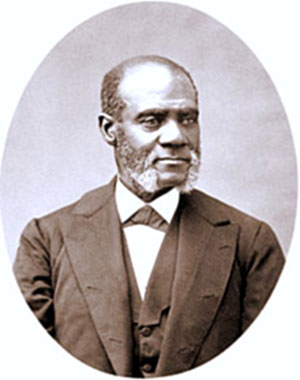
Henry Highland Garnet was born into slavery in New Market, Maryland in 1815. His family escaped via the Underground Railroad and settled in New York City. Garnet began his college education at Noyes Academy, but a segregationist mob forced him to relocate to the Oneida Theological Institute. He was nonetheless renowned for his rhetorical talents.
After graduating, Garnet married, became a pastor at Liberty Street Presbyterian Church and began advocating for the eradication of slavery. His delivered his most famous abolitionist speech, Address to the Slaves of the United States of America or Call to Rebellion, to the Negro National Convention in Buffalo, New York, in 1843. Later, in 1865, he became the first black minister to preach to House of Representatives. He also aided in the Union effort by recruiting free black men to serve in the army.
In accordance with the aging Garnet’s final wish, President Ulysses S. Grant appointed him as U.S. minister and consul general at Liberia. Garnet only lived in the country for two months before his death on February 13, 1882. He was one of four U.S. ministers to Liberia who died of tropical disease between 1882 and 1893.
[Source: https://en.wikipedia.org/wiki/Henry_Highland_Garnet]
 §
§
Alexis Kustel
Lost at Sea – Pacific Ocean 1883
Alexis (also known as Alexander) Odiolio Kustel was born in 1842 in what was then Hungary (now Rusca Montana, Romania). His parents moved the family through Panama to San Francisco in 1852 during the California Gold Rush. He became a sea captain and resided in San Francisco with his mother and younger brothers, Oscar, Casimir, and Arpad, who were also sea captains, and was a member of the firm Wightman & Kustel, which traded in the southern Pacific islands. Kustel married Lizzie Fritz in San Francisco in 1872, and they had one daughter, Florence, who was born in 1880 in the Caroline Islands, a western Pacific archipelago north of New Guinea.
Alexis Kustel was appointed U.S. Consul to Apia, Samoa, on January 10, 1883. On June 24, 1883, he sailed from Apia to another island in Samoa aboard a leaky vessel. A violent storm arose, and the ship was never seen again. Kustel was 40 years old.
[Sources: “A Sailor’s Estate: The Will of Captain Kustel Admitted to Probate,” San Francisco Chronicle, August 13, 1884, online at Newspapers.com; Ancestry.com records; Office of the Historian Records]
 §
§
Jesse H. Moore
Yellow Fever — Callao, Peru 1883
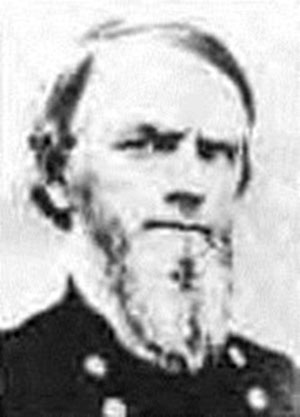
Jesse Hale Moore was born in Lebanon, Illinois in 1817. In his early years, he attended McKendree College, worked at as a schoolteacher and became a Methodist minister. He later served in the Union Army, serving in the Atlanta Campaign and the Battles of Chickamauga, Franklin and Nashville before retiring with the rank of brevet brigadier general.
A Republican, Moore was elected as a U.S. Representative from Illinois in 1869 and served as chair of the Committee on Invalid Pensions. He then became a U.S. pension agent before his 1881 appointment by President Chester A. Arthur as U.S. consul to Callao, Peru. Moore died at post of yellow fever two years later, on July 11, 1883.
[Sources: https://en.wikipedia.org/wiki/Jesse_H._Moore; The Buffalo (New York) Commercial, July 13, 1883, Page 3]
 §
§
Seth Phelps
Tropical Disease – Peru 1885
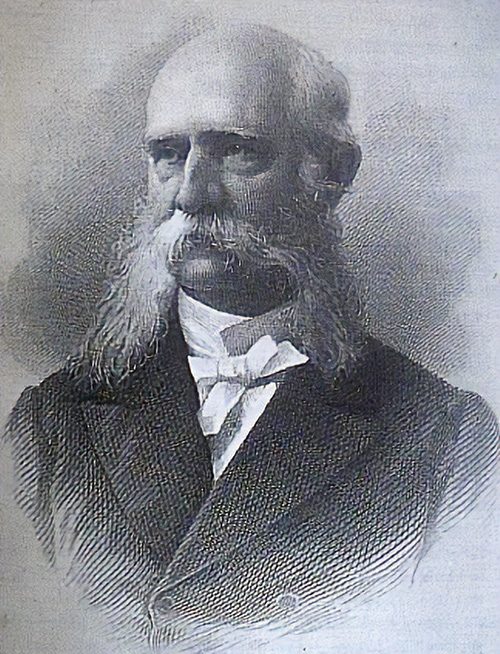
Seth Ledyard Phelps was born in Ohio in 1824. He was appointed a midshipman in the U.S. Navy in 1841 and served during the Mexican-American War and the Civil War. Phelps was promoted to Lieutenant Commander in the U.S. Navy and later became an agent of the Pacific Mail Steamship Company at Acapulco, Mexico, where he was appointed to be a commercial agent on November 24, 1864, through December of the same year. He went to China and Japan with the Pacific Mail Steamship Company and returned to Washington in 1873. In 1875, he was appointed to be the commissioner of the District of Columbia. Phelps married Eliza Maynadier, and they had one child, Sally.
In 1883, he became U.S. Minister (Chief of Mission) to Peru. He died of Oroya fever, a rare bacterial infection endemic in the Andes and also known as Carrion’s disease, which he contracted while on a hunting trip, and died on June 24, 1885. His remains were repatriated to Washington, and were interred in Oak Hill Cemetery in Washington, D.C.
[Sources: The Knoxville Daily Journal, Knoxville, Kentucky, June 25, 1885, Page 1, online at Newspapers.com; Capt. Seth Ledyard Phelps, Oak Hill Cemetery, Washington, D.C., Findagrave.com; Ancestry.com records; Office of the Historian records]
 §
§
Moses A. Hopkins
Tropical Fever – Liberia 1886
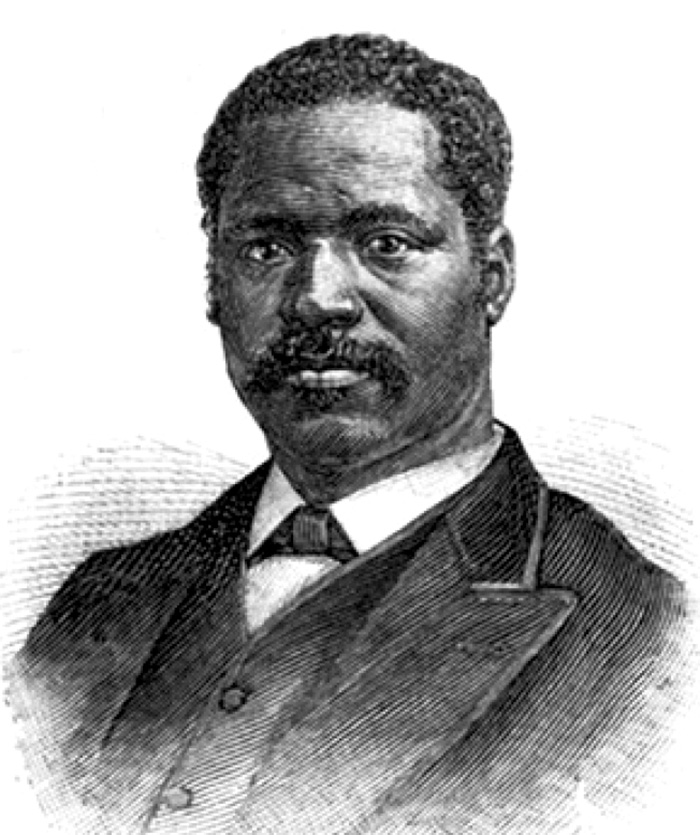
Moses Aaron Hopkins was born in slavery on December 25, 1846, in Montgomery County, Virginia. During the Civil War, he escaped and worked as a cook in Union camps, where he also learned to read and write. After working aboard steamships on the Ohio and Mississippi rivers for a time, Hopkins attended Avery College and graduated as valedictorian from Lincoln University near Oxford, Pennsylvania in 1874. In 1877, he was the first black graduate of Auburn Theological Seminary in New York City. He established a church and a school, Albion Academy, to educate formerly enslaved persons in Franklinton, North Carolina in 1877. With his wife, Carrie, he also founded the Freedman’s Friend newspaper.
Appointed by President Grover Cleveland, Hopkins was confirmed as U.S. Minister Resident (Chief of Mission) and Consul General to Monrovia, Liberia, on January 13, 1886, by the U.S. Senate. Hopkins arrived in Monrovia on December 9, 1885, and died at his post in Monrovia in August 1886 at the age of 39 of “African fever” (19th-century term usually referring to malaria). He was one of four U.S. ministers to Liberia who died of tropical disease between 1882 and 1893.
[Sources: Moses Aaron Hopkins, Findagrave.com; “Death of Rev. Moses A. Hopkins, Minister and Consul General from the United States to Liberia,” New Castle News, New Castle, Pennsylvania, August 12, 1886, Page 4, online at Newspapers.com; https://en.wikipedia.org/wiki/Moses_A._Hopkins; Ancestry.com records; Office of the Historian records]
 §
§
John Miller
Smallpox – Brazil 1887
John Thomas Miller was born May 1, 1861, in Chester County, South Carolina. He became a Vice Consul in Rio de Janeiro, Brazil, on June 1, 1887, but died of smallpox just weeks later on July 28. Miller had been resident in Brazil since 1867, and most of his family relocated to Sao Paolo in 1868. He was aged 22 at the time of his death and was buried in a “grove overlooking the beautiful bay of Rio.”
[Sources: The Inter Ocean, Chicago, Illinois, August 5, 1887, Page 1, online at Newspapers.com; Yorkville Enquirer, York, South Carolina, July 20, 1887, Page 2, online at Newspapers.com; Jones, Hazel Parker, Descendants of James Boyd Magill 1799–1880, Jacobs Brothers, Clinton, South Carolina, 1963, Pages 30–31, online at https://www.seekingmyroots.com/members/files/G004370.pdf; Ancestry.com records; Office of the Historian records]
 §
§
Allen Francis
Railway Accident – St. Thomas, Canada 1887
Allen Bunn Francis was born on April 12, 1815, in Wethersfield, Connecticut. A printer by trade, he first moved with his brother to Springfield, Illinois, where he published the Springfield Journal, serving as both editor and typesetter. A longtime friend of Abraham Lincoln, he served as paymaster of the U.S. Army and was later appointed by President Lincoln as U.S. Consul in Victoria, British Columbia, Canada, where, as a relatively early settler, he had a printing business and served twice as U.S. Consul; first from 1861 to 1869 and again from 1877 to June 1884, when he was transferred to represent the United States as Consul in Port Stanley and St. Thomas, Ontario, Canada.
In St. Thomas on July 15, 1887, he was present at the largest train disaster in the history of the southwest region of that province. He was apparently on his way to the crash site to aid or check for possible American citizen casualties when he was run over by a fire department hose-reel cart responding to the crash. He died in St. Thomas of his injuries on August 4, 1887. He was survived by his wife, Cecelia Duncan Francis, and four adult children. He is buried in Ross Bay Cemetery in Victoria, British Columbia.
[Sources: Hon. Allen Bunn Francis, Ross Bay Cemetery, Victoria, British Columbia, Canada, Findagrave.com, Memorial ID 227452957; The Morning Journal-Courier, New Haven, Connecticut, August 8, 1887, online at Newspapers.com; “United States Consul Dead,” Lincoln Nebraska State Journal, August 12, 1887, Page 2, online at Newspapers.com; Allen Francis, Columbia Magazine, Fall 2015, Pages 22-27, online at https://www.washingtonhistory.org/wp-content/uploads/2020/04/29-3-fall-1.pdf; Ancestry.com records; Office of the Historian records.]
 §
§
David T. Bunker
Yellow Fever — Demerara, British Guinea 1888
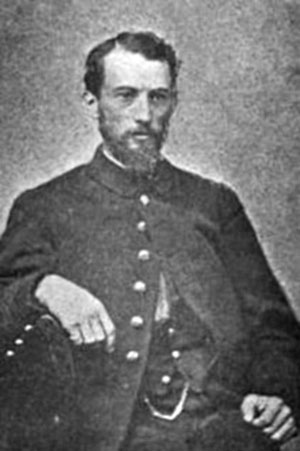
David Thayer Bunker was born in Charleston, Maine in 1836. He briefly attended Harvard Medical School, worked for several years in the Boston Custom House and finally joined the Union Army. He fought at Baton Rouge, Port Hudson and the Red River Campaign before retiring with the rank of major.
After the war, Bunker returned to the Custom House and later found work at a Boston Bank. In 1874, he became president of the Regimental Association.
Bunker was eventually appointed U.S. consul for Demerara, British Guinea. He died there on February 5, 1888.
 §
§
Victor F. W. Stanwood
Murdered — Andakabe, Madagascar 1888
Victor Francis Warren Stanwood was born in about 1839 on the Isle of Wight in England. He was appointed to be a U.S. consular agent in Andakabe, Madagascar on October 12, 1881. His post was on Madagascar's west coast, while his supervising U.S. consul was at the principal port of Tamatave, on the east coast.
Stanwood produced and forwarded reports on the slave trade to the consul in Tamatave urging U.S. intervention to eliminate the slave trade in the Andakabe region. He detailed information on the slave traders and their use of the U.S. flag and recounted repeated threats on his life from the traders. The newly arrived consul sat on Stanwood's reports, commenting in a report of his own to Washington in February 1888 only that he had to be "prudent" about transmitting the Stanwood reports because the author had "a reputation for exaggeration." Finally, in October, he sent the reports forward—but before they arrived in Washington, Stanwood was dead.
On November 5, 1888, Consular Agent Stanwood tried to prevent Captain Leon de Rathier Duverge from slave trading on the Coast. Duverge whipped out a pistol in anger and shot the consul, killing him. The exact circumstances of the incident are unclear. Stanwood had carried arms while working for months and was investigating "irregularities" relating to a schooner near Andakabe. The ship reportedly was partly loaded with firearms, and it was there that Stanwood was shot by Captain Duverge. The news that Mr. Stanwood had died did not reach the consul in Tamatave until December 9. Captain Duverge was never charged in the killing.
Interestingly, Stanwood himself was the subject of an arrest warrant in Melbourne, Australia, in 1879. The warrant stated that he was “formerly second mate of the ship Lucy Turner, trading on the African coast, and subsequently was captain of the schooner Madeline which vessel he sold at Adelaide about 1877. In September 1878 he was captain of a barque Courier, and unlawfully sold the same at Wellington, New Zealand.” Stanwood was described as about 5 feet 2 inches tall, with iron-grey hair, a dark beard and moustache, light grey eyes, and elaborately tattooed arms. Records from the United States indicate that at the time the Australian arrest warrant was issued, Stanwood was living in San Francisco, California.
[Source: David T. Jones, “Diplomacy's Fallen Heroes,” State Magazine, May 1998, online at https://1997-2001.state.gov/www/publications/statemag/statemag_may98/feature3.html; Ancestry.com records; Office of the Historian records]
 §
§
Alexander Clark
Fever – Monrovia, Liberia 1891
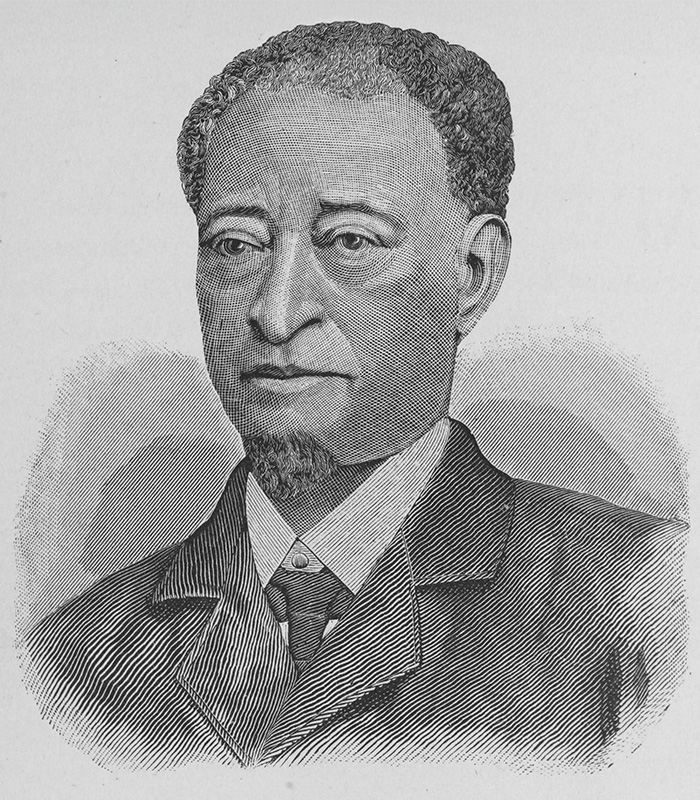
Alexander G. Clark, Sr., was born February 25, 1826, in Washington County, Pennsylvania to parents who had been freed from slavery. At age 13, he moved to Cincinnati, Ohio to live with an uncle and learn to become a barber, and two years later, he started working on the steamboat George Washington. An African-American Civil Rights leader and successful businessman, lawyer, editor, and speaker, he was known for his lawsuit to gain admission for his daughter at a public school in Muscatine, Iowa, and the case Clark v. Board of School Directors achieved a constitutional ruling for integration from the Iowa Supreme Court in 1868—86 years before the U.S. Supreme Court ruling in Brown v. Board of Education. Clark was also a leader in winning a state constitutional amendment that gained the right for African Americans in Iowa to vote.
In 1873, President Grant offered Clark an appointment as consul to Aux Cayes, Haiti, but he declined because the pay was too low. Clark moved to Chicago for a time, and in the late 1880s purchased the newspaper The Conservator, where he also served as an editor. Clark was married to Catherine Griffin Clark in Muscatine, Iowa, but she died in 1879. They had five children, three of whom lived to adulthood.
Clark was appointed by President Benjamin Harrison as Minister Resident (Chief of Mission) and Consul General to Monrovia on August 16, 1890. He died on May 31, 1891, at his post in Monrovia of a tropical fever. He was one of four U.S. ministers to Liberia who died of tropical disease between 1882 and 1893. His remains were repatriated, and he is buried in the family plot in Greenwood Cemetery in Muscatine, Iowa, where his house has been preserved and is on the National Register of Historic Places.
[Sources: Alexander G. Clark Sr., Greenwood Cemetery, Muscatine, Iowa, Findagrave.com; Wikipedia; Ancestry.com records; Office of the Historian records]
 §
§
Thomas Newson
Smallpox – Spain 1893
Thomas McLean Newson of St. Paul, Minnesota was born in New York on February 22, 1827. He was known as a pioneer journalist and politician. After he spent several years in a boarding school following the death of his parents when he was young, he became an apprentice to a printer in New Haven, Connecticut. He started a newspaper in Birmingham, Connecticut. In 1853, he moved to Minnesota. Newson was an abolitionist and a Republican and served as Minnesota’s only delegate to the Pittsburgh Presidential convention in 1884. He married Harriett Brown in Albany, New York in May 1857. In 1862, he was appointed commissary inspector of the U.S. Army and was awarded for meritorious conduct in 1865.
Newson was confirmed as U.S. Consul to Malaga, Spain on July 11, 1890. He died three years later, on April 1, 1893, of smallpox during an epidemic at his post. He left a wife and five children in St. Paul. He was buried in Malaga, but there is a cenotaph in his honor in Oakland Cemetery in St. Paul, Minnesota.
[Sources: Maj. Thomas McLean Newson, Oakland Cemetery, St. Paul, Minnesota, Findagrave.com, Memorial ID: 145618016; Compilation of Reports of Committee on Foreign Relations: 1789-1901, Volume 3, United States Congress, Senate, Committee on Foreign Relations, Page 805; Collections of the Minnesota Historical Society 1905, Pages 270-271; Ancestry.com records; Office of the Historian records.]
 §
§
William D. McCoy
Fever — Monrovia, Liberia 1893
William D. McCoy was born on November 17, 1853, in Cambridge City, Indiana and was educated in Boston, Massachusetts. He worked as county superintendent of schools in Helena, Arkansas, and then served as principal of several schools in Indianapolis, Indiana. McCoy ran unsuccessfully as Republican candidate for the Indiana State Legislature. He married Celeste Walker in 1879 in Indianapolis.
In 1892, President Benjamin Harrison nominated McCoy to be Minister Resident (Chief of Mission equivalent) and Consul General to Monrovia, Liberia. He was confirmed on January 11, 1892. He died in Monrovia on May 16, 1893, of a fever, just four months after his arrival and was buried at Crown Hill Cemetery in Indianapolis. He was one of four U.S. ministers to Liberia who died of tropical disease between 1882 and 1893. His widow, Celeste McCoy, established the McCoy fund for black pupils in Indianapolis with $1500 from her husband’s estate. The fund is still administered by public schools in Indianapolis today.
[Sources: William D. McCoy, Crown Hill Cemetery, Indianapolis, Indiana, Findagrave.com, Memorial ID: 45968151; Ancestry.com records; Office of the Historian records.]
 §
§
John R. Meade
Yellow Fever — Santo Domingo, Dominican Republic 1894
John R. Meade of New London, Connecticut, was a printer active in Democratic party politics. He was confirmed as U.S. Consul to Santo Domingo on November 1, 1893, and departed for post on November 21, 1893. He died at post just two months later on January 21, 1894, of yellow fever. While Meade’s wife and daughters stayed behind in Connecticut, Meade’s son Richard was with his father in Santo Domingo, where he was enrolled in college to learn Spanish and French. Richard returned to the United States on February 14, but local law did not permit the repatriation of his father’s remains due to the yellow fever diagnosis.
[Sources: “Consul Meade is Comfortable,” The Day, New London, Connecticut, January 3, 1894, Page 8, online at Newspapers.com; “Died of Yellow Fever: Therefore Consul Meade’s Body Cannot Be Brought Home,” The Day, New London, Connecticut, January 24, 1894, Page 8, online at Newspapers.com; Ancestry.com records; Office of the Historian records.]
 §
§
Alexander L. Pollock
Yellow Fever — San Salvador, El Salvador 1894
Alexander Lyon Pollock was born in Hungary on March 31, 1852. He graduated from a school in Prague and emigrated to the United States as a young adult. He was appointed clerk to General Hunt of the U.S. Army and moved to Nebraska as a signal officer. In Washington, D.C., he served as an editor for the International Meteorological Bulletin. He married Verona E. Larkin, and they had at least three children, one of whom, Catherine, lived to adulthood.
Appointed from Utah, Pollock was confirmed as U.S. Consul to San Salvador, El Salvador, on September 18, 1893. He served from December 26, 1893, and died there of yellow fever on September 17, 1894. He was reburied at Mt. Olivet Cemetery in Salt Lake City, Utah, in 1912.
[Sources: Alexander Lyon Pollock, Mount Olivet Cemetery, Salt Lake City, Utah, Findagrave.com, Memorial ID: 92166050; “Alexander Pollock Dead,” Omaha World-Herald, Omaha, Nebraska, September 18, 1894, Page 1, online at Newspapers.com; Ancestry.com records; Office of the Historian records.]
 §
§
Frederick Munchmeyer
Yellow Fever — San Salvador, El Salvador 1895
Frederick A.H. Munchmeyer was born in 1853 in West Virginia and was a merchant in Parkersburg. He was confirmed as U.S. Consul to San Salvador, El Salvador, on February 5, 1895, and served from April 4, 1895, and died on September 11, 1895, almost exactly one year after his predecessor’s death in San Salvador of the same illness and the day before his wife, Frances, also died of yellow fever. They had two surviving children, who were sent home to Parkersburg to live with relatives. Munchmeyer was succeeded by his cousin, Otto, as consul in San Salvador. Otto Munchmeyer sadly committed suicide at the same post in 1897, which his family attributed at the time to be linked to possible financial problems.
[Sources: The News and Advance, Lynchburg, Virginia, July 28, 1897, Page 4, online at Newspapers.com; “Fatalities,” The Cincinnati Enquirer, Cincinnati, Ohio, July 28, 1897, Page 1, online at Newspapers.com; Ancestry.com records; Office of the Historian records.]
 §
§
Hiram Lott
Dysentery – Managua, Nicaragua 1895
Hiram Richard Lott was born on April 2, 1825, in Covington County, Mississippi. He married Mary Elizabeth Willians in 1847 and they had six children before he moved his family to Floyd, Louisiana, in the mid-1850s. There, Lott became a planter and was involved in politics, serving in the Louisiana State Senate from 1859 to 1867 and 1879 to 1895 and eventually became the Lieutenant Governor of Louisiana from 1893 to 1995.
Lott was appointed to be U.S. Consul in Managua, Nicaragua, on January 9, 1895. He arrived at post on April 20, 1895, and died less than six weeks later on June 6 of dysentery at age 66. He was initially buried at the Foreigners’ Cemetery in Managua, but his remains were repatriated two years later and interred in the Lott Family Cemetery in Floyd, Louisiana.
[Sources: Col Hiram Richard Lott Sr, Lott Family Cemetery, Floyd, Louisiana, Findagrave.com, Memorial ID: 88921061; “The Details of Colonel Lott’s Death,” The Times-Picayune, New Orleans, Louisiana, July 12, 1895, Page 8, online at Newspapers.com; “Hiram R. Lott” on Wikipedia.org; Ancestry.com records; Office of the Historian records.]
 §
§
James Fox
Yellow Fever – Antigua 1895
James C. Fox was born in Rochester, New York. He was confirmed as U.S. Consul in Antigua on September 19, 1893, and served from October 30, 1893, to October 21, 1895, when he died at post of yellow fever after an illness of four days.
[Sources: Democrat and Chronicle, Rochester, New York, November 8, 1895, Page 1, online at Newspapers.com; Ancestry.com records; Office of the Historian records.]
 §
§
John B. Gorman
Malignant Malaria — Matamoros, Mexico 1896
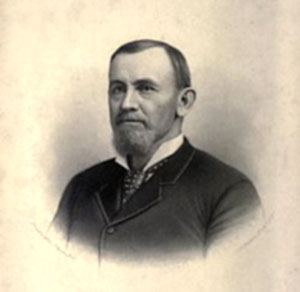
John Berry Gorman, Jr. was born in Tallbotton, Georgia in 1839 and became a planter and journalist. In 1884, he published A Tour around the World or Sketches of Travel in Eastern and Western Hemispheres, an account of his many international journeys. He served as U.S. consul to Matamoros, Mexico, from 1894 until his death from malaria on September 6, 1896.
[Source: John Berry Gorman Jr., Pantheon Municipal El Saucito, San Louis Potosi, Mexico, Findagrave.com, Memorial ID: 116081056.]
 §
§
Thomas Gibson
Smallpox – Beirut, Lebanon 1896
Thomas Reuben Gibson was born July 5, 1857, in Warrenton, Georgia. He was a graduate of the University of Georgia worked as the editor of the Augusta Evening News. He lived in Richmond, Georgia in the 1880s, where he resided with his uncle, an attorney, and with his mother and younger brother. Gibson was confirmed as U.S. Consul to Beirut on September 28, 1893. He served at his post from January 9, 1894, until his death from smallpox on September 20, 1896.
[Sources: The Streater Free Press, Streator, Illinois, September 25, 1896, Page 5, online at Newspapers.com; Ancestry.com records; Office of the Historian records.]
 §
§
Albert S. Willis
Malaria — Honolulu, Hawaii 1897
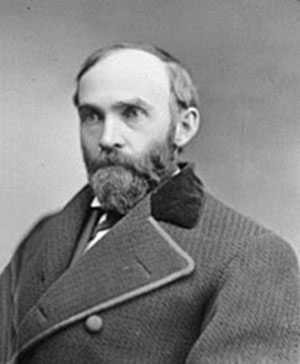
Albert Shelby Willis was born in Shelbyville, Kentucky in 1843. He graduated from University of Louisville School of Law in 1866, was admitted to the bar and served for three years as prosecuting attorney for Jefferson County, Kentucky. Between 1877 and 1887, he served in the U.S. House of Representatives as a Democrat and the chair of the Committee on Rivers and Harbors.
President Grover Cleveland appointed Willis U.S. minister to Hawaii in 1893. Willis was assigned to convince Queen Liliuokalani, Hawaii’s recently deposed queen, to provide amnesty to her enemies if the president restored her rule. President Cleveland reneged on his promise when the Hawaiian President Sanford B. Dole refused to step down, and the mission became a failure. Nevertheless, Willis remained the U.S. Minister to the then-independent country for the next four years before his death on January 6, 1897.
[Source: “Albert S. Willis” on Wikipedia.org]
 §
§
William Ashby
Boating Accident – Colón, Colombia 1898
William Ward Ashby was born in Washington, D.C., in 1849. He married Clara Morton in Virginia in 1877, and they lived in Spotsylvania County with their two children, Morton and Nance, where the family ran a retail grocery store. Ashby was involved in Republican politics in Virginia during the Civil War, in opposition to much of his family. He was a nephew of Gen. Turner Ashby and worked as a correspondent for the Norfolk Landmark and other newspapers.
Ashby was confirmed as U.S. Consul to Colon, Colombia (now Colon, Panama) and served there from November 16, 1897, to January 17, 1898, when he drowned in a boating accident. Ashby was on a boating trip with the German consul, Dr. Hafemann, and five others when their boat was swamped at sea during a storm and all aboard drowned. He was 49 years old. The presence of the German Consul suggests this was a representational activity in the line of duty.
[Sources: “Two Consuls Perish,” The Washington Post, January 18, 1898, Page 2, online at Newspapers.com; “A Party of Six Perish,” The Selma Times, Selma, Alabama, January 18, 1898, Page 3, online at Newspapers.com; “Consulate Vacated by Death,” Dixon Evening Telegraph, Dixon, Illinois, January 18, 1989, Page 2, online at Newspapers.com; Ancestry.com records; Office of the Historian records.]
 §
§
Robert Moseley, Jr.
Malaria – Japan 1900
Robert Alexander Moseley, Jr., of Montevallo, Alabama, was born on July 14, 1841, in Shelby County, Alabama and attended Howard College. He studied medicine with his father and also at Jefferson Medical College in Philadelphia. He fought with the Confederate Army, and was seriously wounded in the battle of Murfreesboro, after which he returned home and started a pharmacy business. He was elected mayor of his hometown in 1868 and established five different newspapers across Alabama in the next decade. He was a delegate to the Republican National Convention on several occasions. Moseley first married Josephine Ware in 1862; his second wife was Ella Lowery, whom he married in 1892. He had one daughter who died young with his first wife, but no other children.
Moseley was confirmed as U.S. Consul to Singapore on January 7, 1899. He died of malaria and pneumonia at Yokohama, Japan, on November 14, 1900, after being sent there on doctor’s orders to recuperate from a malaria infection. He was 59 years old. Moseley was so ill on arrival in Japan that he left the ship on a stretcher. Moseley is buried in Oak Hill Cemetery in Talladega, Alabama.
[Sources: “Robert Alexander Moseley Jr.,” Oak Hill Cemetery, Talladega, Alabama, Findagrave.com, Memorial ID 6855191; “Dr. R.A. Moseley, Consul at Singapore, is Dead,” The Atlanta Constitution, Atlanta, Georgia, November 16, 1900, Page 2, online at Newspapers.com; “Dr. Moseley’s Last Hours,” Our Mountain Home, Talladega, Alabama, December 5, 1900, Page 2, online at Newspapers.com; Ancestry.com records; Office of the Historian records.]
 §
§
Rounsevelle Wildman
Lost at Sea — 1901
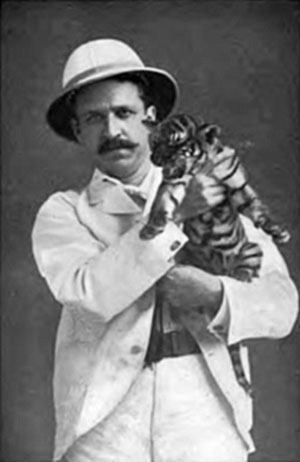
Rounsevelle Wildman, Sr. was born in Batavia, New York in 1864. He graduated from Syracuse University, moved west and served in the Idaho delegation to Congress. His efforts helped the then-territory of Idaho to become a state.
Wildman served as the U.S. consul to Singapore; Barmen, Germany; and Hong Kong. He wrote several accounts of his experiences, including China’s Open Door: A Sketch of Chinese Life and History and Tales of the Malayan Coast: From Penang to the Philippines.
While en route from Hong Kong to the inauguration of President William McKinley in Washington, D.C., Wildman’s ship, the S.S. City of Rio de Janiero, crashed on a submerged reef in San Francisco Bay. Wildman and his family were lost in the shipwreck.
[Source: “Rounsevelle Wildman” on Wikipedia.org]
 §
§
Thomas T. Prentis
Volcanic Eruption — Martinique 1902
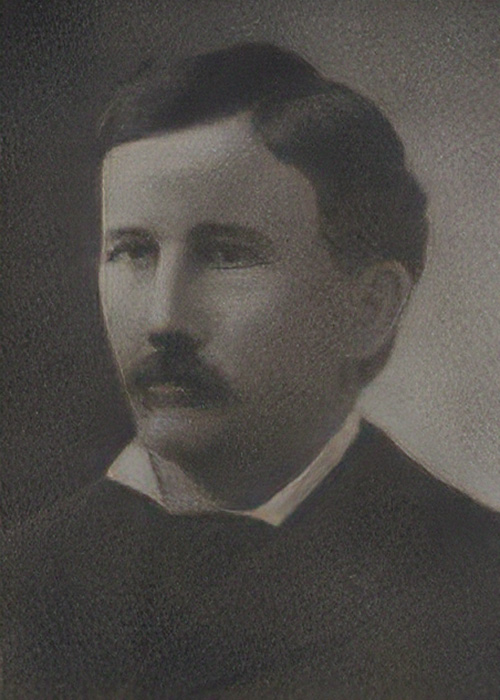
Thomas Theodore Prentis was born in Royal Oak, Michigan in 1844 and was raised in Vermont. He served as a sharpshooter in the Union Army during the Civil War, and married Clara Frye, the daughter of a wealthy sea captain, in the Seychelles while he served there as U.S. Consul for nine years. Clara was born in Port Louis, Mauritius in 1851.
Prentis was confirmed as U.S. Consul to Martinique on December 6, 1900, serving there from April 1, 1901, to May 8, 1902, when he was killed by the volcanic eruption of Mt. Pelée along with his wife, their two daughters, Louise Lydia and Christiana Hazel, Vice Consul Amédée Testart, and nearly 29,000 others. Prentis had previously served as U.S. Consul in Mahé, Seychelles; Port Louis, Mauritius; Rouen, France; and Batavia (Jakarta), Java, prior to his assignment to Martinique.
When Mt. Pelée erupted on May 8, 1902, the U.S. Consulate and the Prentis family were buried in the pyroclastic surge from the volcano. There was no time to escape, and the Prentis family is believed to have died instantly. Thomas and Clara Prentis were aged 56 and 51 and their daughters were 22 and 14 years old at the time of the eruption. Their remains were never identified. The Prentis family also had two surviving adult sons, James and Thomas, who worked for Standard Oil Company. Neither of them was present in Martinique at the time of the eruption.
[Sources: Bent, William, “The Unlucky Consul: Thomas Prentis and the 1902 Martinique Disaster,” Foreign Service Journal, May 2020, online at afsa.org; Perrot-Minnot, Sebastien, “Memorializing the U.S. Consular Presence in Martinique,” Foreign Service Journal, November 2022, Pages 64-66, online at afsa.org; Ancestry.com records, Office of the Historian records.]
 §
§
Amedee Testart
Volcanic Eruption — Martinique 1902
Vice Consul Joseph “Amédée” Testart Grosval was born to French immigrant parents in Louisiana on March 3, 1848. By 1876, he was working as a clerk in a loan office in New Orleans. He married Leonie B. Villeneuve on January 31, 1874, in New Orleans. They had three children, Marie “Louise,” Charles, and Joseph, who died in infancy.
Testart was appointed Vice Consul in Martinique on June 8, 1898. He died on May 8, 1902, following the eruption of Mt. Pelée, along with Consul Thomas Prentis and his family, and nearly 29,000 others. When Mt. Pelée erupted, Testart did not die immediately. He managed to make it on board the Roddam, one of the few ships in the harbor, only to fall back into the sea, dead with exhaustion shortly after he reached the ship. He was 54 years old. His daughter, Marie Louise also died in the eruption along with her young family at the age of 26. Testart’s wife and son Charles were in New Orleans at the time of the eruption and survived.
[Sources: Consolation Prize Podcast, Episode 8, “Eden to Ashes,” available online at r2studios.org; Perrot-Minnot, Sebastien, “Memorializing the U.S. Consular Presence in Martinique,” Foreign Service Journal, November 2022, Pages 64-66, online at afsa.org; “In the St. Pierre Consulate Before the Great Eruption,” Eagle River Review, Eagle River, Wisconsin, May 26, 1902, Page 3, online at Newspapers.com; Bent, William, “The Unlucky Consul: Thomas Prentis and the 1902 Martinique Disaster,” Foreign Service Journal, May 2020, online at afsa.org; Ancestry.com records, Office of the Historian records.]
 §
§
Thomas Nast
Yellow Fever — Guayaquil, Ecuador 1902
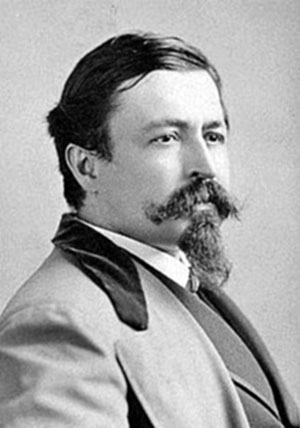
Thomas Nast was born in Landau, Germany in 1840. His family moved to New York City when he was still young, and his aptitude for drawing inspired him to attend the National Academy of Design and begin working for Frank Leslie’s Illustrated Newspaper and, later, Harper’s Weekly.
Nast quickly became a celebrated cartoonist – the “Father of the American Cartoon” – best known for his creation of modern version of Santa Claus, Uncle Sam and the symbols for both major political parties: the Republican Elephant and the Democratic Donkey. His cartoon campaign was responsible for the downfall of Boss Tweed, the powerful and corrupt leader of Tammany Hall Democratic party political machine, and aided in the election of Ulysses S. Grant as president.
In 1902, President Theodore Roosevelt appointed Nast as U.S. consul to Guayaquil, Ecuador. During a deadly yellow fever outbreak, Nast stayed in the city helping members of diplomatic missions and businesses flee the epidemic. He became infected and died on December of that year.
[Source: “Thomas Nast” on Wikipedia.org]
 §
§
Benjamin Johnston
Dysentery – Honduras 1903
Benjamin Johnston of Iowa was born March 9, 1845, in Van Buren County, Iowa. He served as lieutenant of a Union Army Colored Troops from 1861 to August 1865. After returning home from the war, Johnston became a salesman for a drug company, after which he studied law and was admitted to the bar in Iowa. He was elected County Attorney in Van Burean County Iowa in 1886. He married Ruth Anna Purviance, and they had four daughters and two sons. His wife and one of his daughters both died in 1901.
Johnston was appointed U.S. Consul in La Ceiba, Honduras, on July 1, 1902, serving there from October 17, 1902, until his death of dysentery on January 7, 1903, at age 61. He previously served as U.S. Consul in Utilla, Honduras, from February 4 to April 2, 1898. Following his death in 1903, local law, along with a period of unrest, prevented immediate repatriation; therefore his remains were not returned to the United States until October 1910. He is buried at Purdom Cemetery in Keosauqua, Iowa.
Note: His inscription on the AFSA memorial plaque lists his name as “Johnson” but official records found later say “Johnston.”
[Sources: “Benjamin Johnston,” Purdom Cemetery, Keosauqua, Iowa, online at Findagrave.com, Memorial ID 62237197; Ancestry.com records; Office of the Historian Records.]
 §
§
John Carter Ingersoll
Dysentery – Colón, Colombia 1903
John Carter Ingersoll was born March 20, 1856, in Peoria, Illinois. He married Lalla Knode Burrows in Washington, D.C., in 1884; they had two surviving children, Robert and Kathryn. Ingersoll was the son of U.S. Representative Ebon Clark Ingersoll of Illinois and nephew of the famous abolitionist and orator Robert G. Ingersoll. After his father was elected to Congress and the family moved to Washington, D.C., Ingersoll attended Cornell University, where he was the class president of 1882, and studied law in Washington, D.C., where he was admitted to the bar.
He was appointed U.S. Consul in Copenhagen on December 18, 1897, and served there until June 11, 1900, when he was appointed U.S. Consul to Cartagena, Colombia. He died in Colon, Colombia (now Panama) on June 6, 1903, of dysentery while in transit to the United States for a leave of absence. He is buried in Oak Hill Cemetery in Washington, D.C.
[Sources: “John Carter Ingersoll,” Oak Hill Cemetery, Washington, D.C., Findagrave.com, Memorial ID 37241370; “Death of Consul John C. Ingersoll,” Evening Star, Washington, D.C., June 8, 1903, Page 16, online on Newspapers.com; Ancestry.com records; Office of the Historian records.]
 §
§
William F. Havemeyer
Cholera — Bassorah, Turkey 1904
William Frederick Havemeyer II was born in New York City on May 25, 1874, the youngest son of Henry and Jennie Havemeyer, and part of a wealthy extended family. Havemeyer’s parents had a sugar manufacturing business. Havemeyer attended New York University (where he was later founder of the Havemeyer Laboratory) and, independently wealthy, lived abroad for several years, spending time in both London and Calcutta, India. He was in Calcutta in 1900 when his older brother, William Moller Havemeyer, who was divorced from actress Clara Stevens, died of a stroke at the age of 35 while working in Buenos Aires, Argentina. Havemeyer obtained a passport at the U.S. Embassy in 1901 for the purposes of living in Persia “for a few years.” Around the same time, he was recorded as staying as a guest with his sister’s family at Broomley House in Bonhill, Dumbartonshire, Scotland.
He served as U.S. Consular Agent in Bassorah, Turkey (now Basra, Iraq) from February 8, 1904, until his death on June 25, 1904, of cholera. After he died in Basra, the Department of State posted advertisements in New York newspapers seeking next of kin; his only living immediate family at that time were his sisters, Blanche and Edythe, both living in Scotland.
[Sources: “Official,” New York Tribune, August 8, 1904, Page 7, online at Newspapers.com; “Clara Bloodgood,” on Wikipedia.org; Ancestry.com records; Office of the Historian Records.]
 §
§
Philip Carroll
Fever — Manzanillo, Mexico 1906
Philip Carroll of New York was born in 1857. A graduate of the Georgetown University School of Medicine in 1879, Carroll served in the Civil War as a drummer boy, and fought in the bloody Battle of Olustee on February 20, 1864 -- the largest battle fought in Florida during the war.
He served a long career in the consular service of the United States, joining in 1879, and served in Palermo, Demerara (now Guyana), Grenville (Quebec), Monterrey (Mexico), Aguas Calientes (Mexico), and Manzanillo (Mexico) prior to his death of a fever in Manzanillo, Mexico, on December 14, 1906, at the age of 58. Dr. Carroll was buried with full military honors at Arlington National Cemetery.
[Sources: The Washington, Post, December 16, 1906, Page 11, online at Newspapers.com; “Former Consul Buried,” The Washington Post, January 27, 1907, Page 11, online at Newspapers.com; Ancestry.com records; Office of the Historian Records; Arlington National Cemetery records.]
 §
§
William Stuart
Murdered – Batum, Russia 1906
British merchant and diplomat William Horwood Stuart was born in Harrow, London, in 1857. In 1873, he served as private secretary to his uncle, the British Consul General for Russian ports on the Black Sea in Odessa, Ukraine. By the early 1890s, Stuart moved to Batum, Russia (now Batumi, Georgia). He was appointed as U.S. Vice Consul in 1904 and by 1906 was also the acting British Consul. He was also named Japanese Consul, but his appointment was deferred at the outbreak of the Russo-Japanese War. Representing the United States in Batum, he lobbied on behalf of U.S. interests in the region, particular copper mining, and represented several British companies, in addition to being one of the largest ship brokers and exporters in Batum.
He was ambushed by assailants and shot three times from behind a tree on his way home after an evening dining with a friend on May 20, 1906. He was taken to a nearby military barracks for medical attention but died within the hour. The attack was likely a murder carried out for personal reasons and possibly by paid assassins. By May 31, 1906, two men had been arrested for the crime, but it is unclear if they were ever convicted. Stuart was not married and was survived by his mother and two brothers in London. He was 49 years old.
[Sources: “William Horwood Stuart” on Wikipedia.org; “American Consul is Assassinated,” Poughkeepsie Eagle-News, Poughkeepsie, New York, May 22, 1906, Page 1, online at Newspapers.com; Ancestry.com records; Office of the Historian records.]
 §
§
Benjamin H. Ridgely
Exhaustion — Mexico City, Mexico 1908
Benjamin H. Ridgely was born in Caroline County, Maryland, in 1861. He attended law school, but ultimately pursued a career in journalism. He founded the Louisville Truth and wrote The Comedies of a Consulate, and married Sophronia “Fronia” Brannin in 1861; she died in 1889. He then married Kate Eaches in 1891. Ridgely served as U.S. Consul in Geneva from 1893 to 1900, in Malaga from 1900 to 1902; in Nantes, France from 1902 to 1904, and Barcelona from 1904 to 1908.
He took charge as U.S. Consul in Mexico City on June 19, 1908. On October 10, 1908, he, his wife Kate, and his mother were in a Pullman sleeper car in Monterrey on a layover while traveling between Laredo and Mexico City when he “died suddenly” around midnight. Contemporary press reporting did not specify the cause of death. A 1929 American Foreign Service Journal article states that he died of heart failure and that “the doctor had warned him that the altitude would be dangerous for him, and the Department had promised to consider him for another post.” In inscribing his name on the original AFSA plaque in 1933, the cause of death was listed as exhaustion. Mrs. Ridgely and their daughter, Louise, accompanied his remains to the United States where he was buried in Cave Hill Cemetery in Louisville, Kentucky.
[Sources: “Benjamin Ridgely Dies at Monterrey,” The Gazette, York, Pennsylvania, October 11, 1908, Page 2, online at Newspapers.com; “For Burial Here,” The Courier-Journal, Louisville, Kentucky, October 14, 1908, Page 10, online at Newspapers.com; American Foreign Service Journal, May 1929, Page 169; Ancestry.com records; Office of the Historian records.]
 §
§
Arthur S. Cheney
Earthquake — Messina, Italy 1908
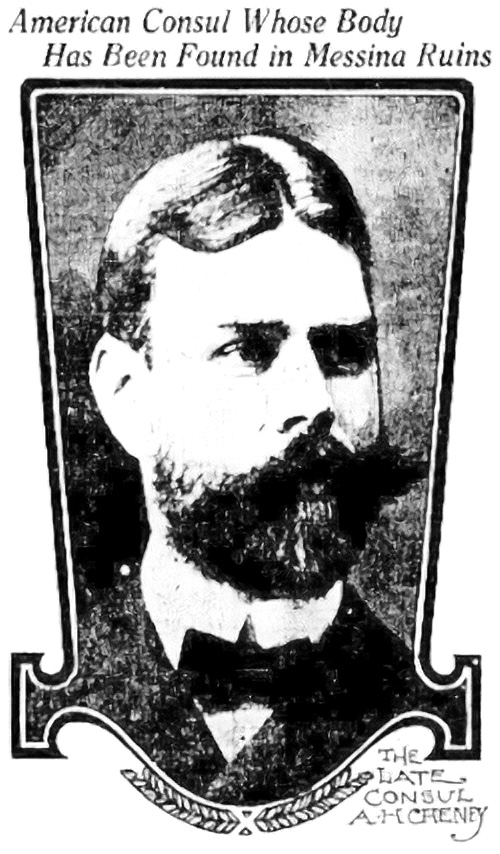
Arthur Sanford Cheney was born in Joliet, Illinois on October 4, 1869, and moved with his parents, Dr. Benjamin Hicks Cheney and Sarah Austin Cheney, to Chicago as a small child. Following the great fire of 1871, the family relocated to New Haven, Connecticut, where Cheney was raised. He graduated Yale Medical School, studied in Vienna, practices medicine in New Haven for 10 years before becoming U.S. Vice Consul to Reichenberg, Austria (now Liberec, Czechia) from November 1906 to August 1907. While there, he met and married Laura Anna Pfeiffer.
Cheney was appointed U.S. Consul to Messina, Italy, where he served from January 1, 1908, until his death in the earthquake on December 28, 1908, that destroyed the U.S. Consulate and much of Messina. The Messina earthquake of 1908 was estimated at a 7.1 on the Richter Scale and resulted in the deaths of between 75,000 and 82,000 people, including the Cheneys and former U.S. Vice Consul and correspondent for the Associated Press Joseph Pierce and his family, who were crushed to death in their damaged home that was brought down by the tsunami that followed the earthquake. The remains of Cheney and his wife were recovered in the ruins of the U.S. Consulate by the crew of the U.S. battleship Illinois, and were repatriated to the United States for burial at Evergreen Cemetery in New Haven, Connecticut. Cheney was 39 years old.
Note: His 1933 inscription on the AFSA memorial plaque includes middle initial “A” but official records discovered decades later say “S.”
[Sources: “1908 Messina Earthquake” on Wikipedia.org; “Dr. Arthur Sanford Cheney, Evergreen Cemetery, New Haven, Connecticut, Findagrave.com, Memorial ID 136987818; Ancestry.com records; Office of the Historian records.]
 §
§
John W. Gourley
Smallpox — Ciudad Juarez, Mexico 1910
John Webster Gourley was born in Boerne, Texas, on April 7, 1886, as one of eight children of Thomas and Sally Gourley, who owned a ranch. He moved to El Paso at the age of 20 and worked at the local post office before was appointed by President Howard Taft as U.S. vice consul to Ciudad Juarez, Mexico – the youngest vice consul at the time at the age of 21. He served there from April 11, 1907, until his death on May 16, 1910. Gourley apparently contracted smallpox while visiting his brother who was recovering from smallpox in nearby Ysleta (El Paso, Texas) where he was a customs inspector. A third brother, who was vaccinated against smallpox, took care of him during his illness, but Gourley did not recover. Gourley was buried at Evergreen Cemetery in El Paso without a funeral service due to the contagious nature of his illness.
Note: His 1933 inscription on the AFSA memorial plaque was presumably based on the assumption that he contracted smallpox in Mexico.
[Sources: “John W Gourley,” Evergreen Cemetery, El Paso, Texas, Findagrave.com, Memorial ID 126651458; Ancestry.com records, Office of the Historian records.]
 §
§
Theodore C. Hamm
Smallpox — Durango, Mexico 1914
Theodore Cushing Hamm was born in Coaticook, Quebec, in 1882 and raised in Newport, Vermont. He studied at the University of Colorado and at the George Washington University in Washington, D.C. He married Clara M. Parker on June 9, 1906, in Washington, D.C. and they had two surviving children, Vera and Betty.
Hamm was appointed U.S. Consul in Durango, Mexico, on August 19, 1911. He was there in 1913 during the Mexican Revolution when it was under siege by revolutionaries led by Pancho Villa, and he received accolades for his reporting to Washington during those events. Hamm died of smallpox at his post on November 6, 1914. He was survived by his wife and two daughters in California and his mother in Dixville, Quebec. He was 32 years old.
[Sources: “American Consul at Durango is Dead,” The Montreal Star, November 17, 1914, Page 19, online at Newspapers.com; Ancestry.com records; Office of the Historian records.]
 §
§
Robert N. McNeely
Lost at Sea — 1915
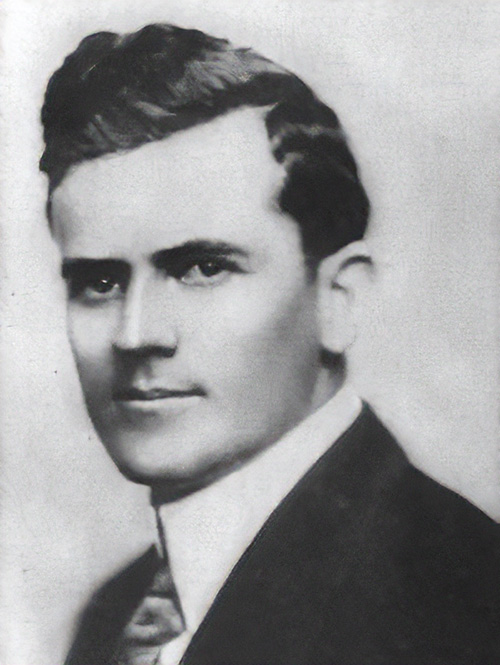
Robert Ney McNeely was born in Monroe, North Carolina on November 12, 1883, as one of eleven children of Robert and Henrietta McNeely. McNeely worked as a rural schoolteacher and mail carrier until he studied law and was admitted to the bar at Monroe, North Carolina, in 1907. In 1909, he was elected to represent Union County in the North Carolina House of Representatives while studying for a law degree at the University of North Carolina. In 1914, he was elected to the North Carolina Senate.
He took the exam for appointment to the U.S. Consular Service in 1915 and was selected to be U.S. consul at Aden. On December 30, 1915, a German U-boat torpedoed McNeely’s ship, the Persia, off the coast of Crete enroute to his post in Aden and sank in less than five minutes. McNeely was last seen in the water, where he and 384 others died. McNeely was 32 years old. He was engaged to be married at the time.
[Sources: “The Persia Torpedoed Without Warning, Says Consul Skinner,” The New York Times, January 2, 1915, Page 1, online at Newspapers.com; “Robert Ney McNeely, Findagrave.com, Memorial ID 67275414; “Robert Ney McNeely” on Wikipedia.org, Ancestry.com records, Office of the Historian records.]
 §
§
Charles P. McKiernan
Smallpox — Chungking, China 1916
Charles Patrick McKiernan was born in Naugatuck, Connecticut on February 13, 1887. After graduating from Yale in 1909, he moved first to New York, then began his career with the Department of State as a student interpreter in China in 1911, serving in multiple consular capacities in Mukden (Shenyang), Tientsin (Tianjin), Canton (Guangzhou), and Chungking (Chongqing), where he died of smallpox on May 28, 1916, at the age of 29. He never married, and his remains were repatriated for burial at St. James Cemetery in Naugatuck, Connecticut. He left his widowed mother and four siblings.
[Sources: “Donner, Fred, “Overland from China,” The Foreign Service Journal, April 1985, Page 38; “Charles Patrick McKiernan.” Saint James Cemetery, Naugatuck, Connecticut, Findagrave.com, Memorial ID: 83759788; “Charles P. McKiernan,” Norwich Bulletin, Norwich, Connecticut, June 3, 1916, Page 5, online at Newspapers.com; Ancestry.com records; Office of the Historian records.]
 §
§
Charles F. Brissel
Typhoid Fever — Baghdad 1916
Charles Frederick Brissel was born in Brooklyn, New York on September 29, 1880, and was raised in Ridgewood, New Jersey. He graduated from Oberlin College in Ohio and was an instructor at Hill’s Institute in Honolulu from 1906 to 1909 before entering the consular service. He traveled to Amoy, China, to teach but after three months was made Vice Consul. He served in that role from April 29, 1910, to April 24, 1914.
He then served in Baghdad from August 1, 1914, until his death on October 31, 1916, of typhoid fever at the age of 36. He was survived by his parents and three brothers. While Brissel was originally buried in Baghdad, there are grave markers in both Baghdad and in Valleau Cemetery in Ridgewood, New Jersey, and contemporary newspaper accounts indicate that the Department of State repatriated his remains.
Note: His 1933 inscription on the AFSA memorial plaque lists the cause of death as cholera, but contemporary press reporting discovered decades later says typhoid fever.
[Sources: “Charles F. Brissel,” New York Herald, New York, NY, November 9, 1916, Page 7, online at Newspapers.com; “U.S. Consul Dead in Bagdad,” The New York Times, November 8, 1916, Page 13, online at Newspapers.com; “Promising Career Ended,” The Ridgewood Herald, Ridgewood, New Jersey, November 9, 1916, Page 11, online at Newspapers.com; “Charles Frederick Brissel, Valleau Cemetery, Ridgewood, New Jersey, Findagrave.com, Memorial ID: 43609232; Ancestry.com records, Office of the Historian records.]
 §
§
Alfred L. M. Gottschalk
Lost at Sea — 1918
Alfred Louis Moreau Gottschalk was born in New York on February 8, 1873, to Gaston and Louise (Boucher) Gottschalk. He was a sugar grower and newspaper correspondent with the U.S. Army in Cuba during the Spanish-American War prior to joining the Department of State. Gottschalk served as U.S. Consul (and later, Consul General) in Callao, Peru, from 1903 to 1905, as Consul General in Mexico City from 1905 to 1908, as Consul General at Large from 1908 to 1914, and finally as Consul General at Rio de Janeiro, Brazil, from June 1915 to February 10, 1918. He decided to leave Rio de Janeiro to offer his services to the Army in World War One.
Gottschalk left Rio de Janeiro on February 15, 1918, aboard the USS Cyclops, which was carrying a load of manganese from Brazil enroute to Baltimore. The ship traveled from Salvador, Bahia, Brazil, and made an unscheduled stop in Barbados on March 3 and 4 to take on supplies and manage water on the ship that was above the Plimsoll line on the ship, indicating that the ship was overloaded. Although due to arrive in Baltimore on March 13, the USS Cyclops was never seen again and was declared lost and all hands deceased on June 1, 1918, by Assistant Secretary of the Navy Franklin D. Roosevelt. Consul General Gottschalk was 45 years old.
Speculation about the disappearance of the USS Cyclops was rampant in the United States during wartime, with some noting that the ship’s allegedly bad-tempered captain was originally from Germany, and even that Gottschalk himself had a German-sounding name. The German Navy denied any involvement in the ship’s disappearance. The wreckage of the USS Cyclops has never been found and its disappearance remains a mystery, although several sister ships built in the same style and around the same time were later found to have structural weaknesses and were themselves lost, indicating that the USS Cyclops may have had a catastrophic structural failure, particularly if it encountered a storm enroute. Its loss with 306 passengers and crew remains the largest single loss of life in U.S. Naval history not involving direct combat.
[Sources: “USS Cyclops” on Wikipedia.org; “Alfred Louis Moreau Gottschalk,” Findagrave.com, Memorial ID 39469436; “Aldred L. Moreau Gottschalk,” The World-News, Roanoke, Virginia, May 13, 1918, Page 2, online at Newspapers.com; Sun-Journal, Lewiston Maine, April 15, 1918, Page 3, online at Newspapers.com; Ancestry.com records; Office of the Historian records.]
 §
§
Maddin Summers
Exhaustion — Moscow, Russia 1918
Thomas Maddin Summers was born in Tennessee on February 1, 1877. He attended Vanderbilt and Columbia Universities. Summers married Russian citizen Natalia Goraynoff, whom he met in Spain while assigned there with the Department of State. Their son, Lionel, was born in Madrid in 1905. Summers had a long career with the Department of State, beginning in 1899 when he joined the Department as a consular clerk, eventually working his way up to Vice Consul. In addition to Washington, Summers served in Madrid, Barcelona, Santos (Brazil), Belgrade, and Sao Paolo (Brazil).
Summers was appointed as U.S. Consul General to Moscow, Russia, on August 18, 1916. Serving during the chaotic Bolshevik Revolution, he collapsed and died on May 4, 1918, at the age of 41. A State Department announcement and a detailed firsthand report in the American Consular Bulletin attributed the death to exhaustion from prolonged overwork. One press report attributed the death to a brain hemorrhage. Summers was buried in Moscow.
[Sources: “An Officer Who Did His Job: Some Personal Recollections of Consul-General Summers’ Work in Russia,” American Consular Bulletin, December 1920, Pages 4-5, 8; “Strain Kills a Consul: The Washington Post, May 5, 1918, Page 78, online at Newspapers.com; “Maddin Summers is Buried at Moscow,” Knoxville Sentinel, May 8, 1918, Page 1, online at Newspapers.com; “Consular Official Died of Hemorrhage,” The Oregon Daily Journal, Portland, Oregon, May 9, 1918, Page 15, online at Newspapers.com; “Maddin Summers Dies in Moscow,” The New York Times, May 6, 1918, Page 13, online at timesmachine.nytimes.com; Ancestry.com records; Office of the Historian records.]
 §
§
John D. O’Rear
Smallpox — La Paz, Bolivia 1918
John Davis O’Rear was born in Audrain County, Missouri on March 21, 1870. His great-grandfather was Josiah Bartlett, signer of the Declaration of Independence. During his early years, O’Rear practiced law and served as the city attorney of Mexico, Missouri; as the prosecuting attorney of Audrain County, Missouri and a member of the State Democratic Committee of Missouri. O’Rear married Eugenia Bragg in July 1905 and they had one son, John, who was born in Bolivia in 1914.
In 1913, O’Rear was appointed Envoy Extraordinary and Minister Plenipotentiary to Bolivia by President Woodrow Wilson. He championed U.S. commercial and trade interests in the country until his death of smallpox on July 14, 1918, at the age of 48. He was buried in Cementerio General de La Paz in La Paz, Bolivia.
[Sources: “John Davis O’Rear,” Cementerio General de La Paz, La Paz, Bolivia, Findagrave.com, Memorial ID 62096149; Ancestry.com records.]
 §
§
Luther K. Zabriskie
Smallpox — Aguas Calientes, Mexico 1921
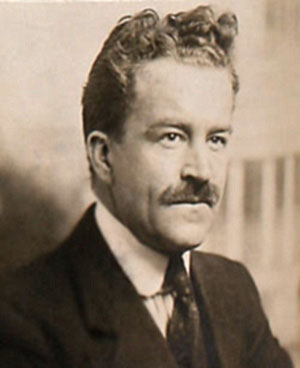
Luther Kimbell Zabriskie was born in Preston, Connecticut in 1879. He graduated from Yale College, studied at Edinburg University in Scotland and spent a year traveling across Europe and Russia. He was later elected as a Republican to the Connecticut General Assembly, served as secretary of the Preston School Committee and worked as a legislative reporter for the Norwich Bulletin.
Zabriskie entered the U.S. consular service in 1911. He served as a clerk, vice consul and later deputy consul at the U.S. Consulate General in Callao, Peru and a vice consul in Moscow and Mexico City. He wrote The Virgin Islands of the United States of America following a government mission to secure the purchase of St. Thomas from Denmark.
Zabriskie’s final post was as U.S. consul to Aguas Calientes, Mexico. He died there of smallpox on January 17, 1921.
 §
§
Carl R. Loop
Saving Life — Catania, Italy 1923
Carl Raymond Loop was born in New Ross, Indiana, on September 10, 1877. He was married to Ethel Roberts; they had one daughter, Mary. Loop attended Butler College, where he participated in athletics and studied law. He entered the consular service in 1807 in Winnipeg as the vice and deputy consul, followed by an assignment to London as deputy consul general, and further postings as consul in Malta, Hamilton, Catania, and Malaga, Spain.
He contracted an infection while saving two Italian swimmers on the beach in Catania, Italy, in the summer of 1922. While returning to shore, he was caught in an undertow and pulled into a sewage trap, which caused a serious infection. Following several unsuccessful surgeries, Loop died on July 29, 1923, shortly after relocating from his post in Catania to Malaga, Spain. In his will, completed just two months before his death, he requested that his burial take place at the Providence Cemetery in Montgomery County, Indiana. Loop was 45 years old.
[Sources: “Heroic Act Results in Death of Carl R. Loop: The Indianapolis Times, Indianapolis, Indiana, August 18, 1923, Page 8, online at Newspapers.com; “Loop’s Death Due to Act of Heroism,” The Indianapolis Star, Indianapolis, Indiana, August 18, 1923, Page 2; online at Ancestry.com; Ancestry.com records; Office of the Historian records.]
 §
§
Max D. Kirjassof
Earthquake — Yokohama, Japan 1923
Max David Kirjassof was born in St. Petersburg, Russia, on March 2, 1888. His family emigrated to the United States in 1892, moving first to Waterbury, Connecticut, and then to Brooklyn, New York. He graduated from Yale University in 1910. His friendship with President Taft’s son led to his appointment to the consulate in Yokohama after he passed the exam to join the consular service. A talented linguist, Kirjassof served as an interpreter at posts in Japan, Korea, and China prior to returning to Yokohama as acting U.S. Consul General.
He died on September 1, 1923, at the age of 35 when his hotel collapsed during the Great Kanto earthquake. His pregnant wife, Alice Ballantine Kirjassof, also died in the earthquake and tsunami that followed, which killed over 100,000 people. They had two children, William and David, who survived the earthquake and were adopted by their mother’s relatives, the Ballentines, after their parents were killed. Alice Ballantine Kirjassof’s brother, Joseph Ballantine, later served as consul general in Japan; another brother, Henry Ballantine, was offered a consular position in Alexandretta, Syria, that he declined.
[Sources: “Max David Kirjassoff, Negishi Foreign Cemetery, Yokohama, Japan, Findagrave.com, Memorial ID: 145598170; “U.S. Consul General at Yokohama Killed,” The Philadelphia Inquirer, Philadelphia, Pennsylvania, September 6, 1923, Page 14, online at Newspapers.com; Ancestry.com records; Office of the Historian records.]
 §
§
Paul E. Jenks
Earthquake — Yokohama, Japan 1923
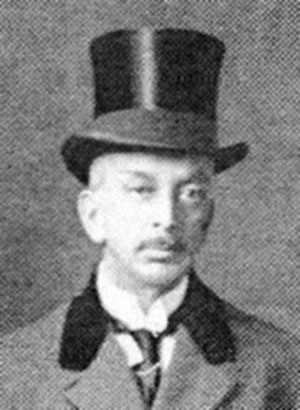
Paul Emott Jenks was born in Brooklyn, New York in 1861. He graduated from Brooklyn Polytechnic Institute and Yale College, where he played tennis, baseball and football. Jenks later worked for the Scovil Manufacturing Company and the Citizens Bank of Waterbury before taking a position in the city treasurer office in Brooklyn.
In 1896, Jenks moved to Japan to represent the J. B. Millet Company in Boston. He remained in the country as a commission merchant and as a secretary at the publishing office of the London Times.
Jenks eventually became a U.S. consular officer in Yokohama, Japan and was appointed U.S. vice consul to the nation in 1916. He died seven years later, on September 1, 1923, when the U.S. Consulate at Yokohama, Japan collapsed during the Great Kanto earthquake.
 §
§
Clarence C. Woolard
Epidemic — Cape Haitien, Haiti 1923
Clarence Cecil Woolard was born in Grafton, West Virginia, on February 12, 1873, to John and Matilda Woolard. Involved in railroad construction, Woolard moved to Pocatello, Idaho, where we worked as a railway conductor. He married Julia Loeper in Butte Montana in 1898; they later divorced. Woolard departed Idaho in 1905 and spent five years in Cerro de Pasco, Peru, and two years in Gonaives, Haiti before he became U.S. vice consul in Cape Haitien, Haiti in 1912. He also held the position of director general of the National Railroad in Haiti. Woolard died of malignant malaria at the general hospital in Port-au-Prince, Haiti on December 22, 1923, at the age of 50. He was buried in Mount Olivet Cemetery in Parkersburg, West Virginia.
[Sources: “American Consul Dies,” Clarion-Ledger, Jackson, Mississippi, December 23, 1923, Page 3, online at Newspapers.com; “Former Pocatello Man is Dead in Haiti,” Deseret News, Salt Lake City, Utah, December 20, 1923, Page 5, online at Newspapers.com; Ancestry.com records; Office of the Historian records.]
 §
§
Robert W. Imbrie
Murdered — Teheran, Persia 1924
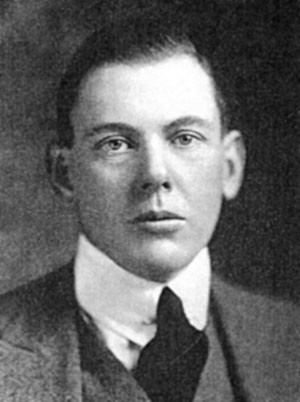
Robert Whitney Imbrie was born in Washington in 1883. He studied admiralty law and spent a brief period studying chimpanzees in the Congo before returning to the U.S. Imbrie served in the American Ambulance Corps during WWI, attained the rank of major and wrote Behind the Wheel of a War Ambulance regarding his experiences.
Imbrie pursued diplomatic missions in post-revolution Russia and modern-day Turkey before serving as U.S. vice consul in Tehran. He was beaten to death by a radical religious mob on July 18, 1924 and buried in Arlington National Cemetery.
 §
§
William T. Francis
Yellow Fever — Liberia 1929
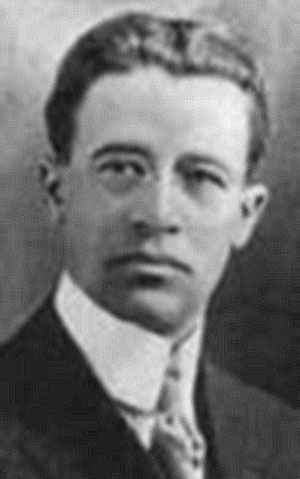
William Treyanne Francis was born in Indianapolis, Indiana in 1869. He earned a law degree from St. Paul College of Law (now William Mitchell College of Law), worked in the legal department of North Pacific Railroad and opened his own law firm in Minnesota. As president elector of the Republican State Convention, Francis aided in the passage of an anti-lynching law in the Minnesota State Legislature.
In 1927, President Calvin Coolidge appointed Francis U.S. minister resident and consul general to Liberia. He died two years later of yellow fever on July 15, 1929.
 §
§
William I. Jackson
Drowned Attempting to Save Life — Matanzas, Cuba 1930
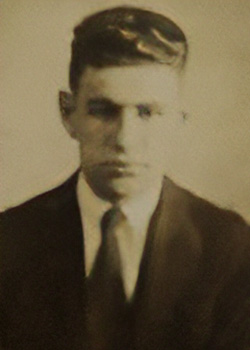
William “Bill” Isaac Jackson was born on July 6, 1894, in Waterloo, Illinois. He married Lillian Hinnant in 1923 and served with the American Expeditionary Force in France from 1917 to 1919. After the war, he served as a clerk at the Treasury Department until joining the Department of State. Jackson served in Bahia, Brazil (1921-1923), Montreal (1924-1927), Torreon, Mexico (1929), Agua Prieta, Mexico (1929), and Havana (1930).
Jackson, his wife Lillian, and two other vice consuls and their spouses posted in Havana -- John Wainwright and Sydney Gest -- traveled together to Matanzas, Cuba. On November 2, 1930, while standing on a cliff overlooking the water, Lillian Jackson was swept off the cliff by a gust of wind. Her husband, along with Wainwright and Gest, jumped into the water after her in an attempt to rescue her. All drowned but Gest, who was pulled out of the water by a long pole that was found nearby by his wife. William and Lillian Jackson are buried in Waterloo City Cemetery in Waterloo, Iowa. They were 36 and 28 years old.
[Sources: “Consuls in Cuba Unable to Save Jackson’s Wife,” The Dispatch, Moline, Illinois, November 3, 1930, Page 1, online at Newspapers.com; “Lieut. William Isaac Jackson,” Waterloo City Cemetery, Waterloo, Illinois, Findagrave.com, Memorial ID 54500337; Ancestry.com records; Office of the Historian records.]
 §
§
John T. Wainwright
Drowned Attempting to Save Life — Matanzas, Cuba 1930
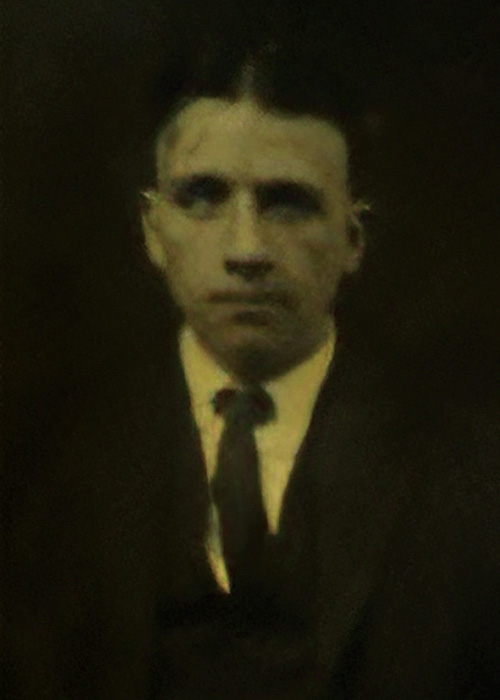
John “Jack” Tillotson Wainwright was born in Rye, New York on October 8, 1898. He was raised in Philadelphia, studied at Princeton (where he was roommates with future political leader Adlai Stevenson), and joined the consular service in 1928, serving in Sao Paolo, Guayaquil, Havana, and Matanzas, Cuba. Wainwright married Alice Cutts in in Washington, D.C. on June 2, 1930, just five months before his death.
Wainwright and two other vice consuls and their spouses posted in Havana—William Jackson and Sydney Gest -- traveled together to Matanzas, Cuba. On November 2, 1930, while standing on a cliff overlooking the water, Lillian Jackson was swept off the cliff by a gust of wind. Her husband jumped into the water in an attempt to rescue her, and Wainwright and Gest jumped in to help them. All drowned but Gest, who was pulled out of the water by a long pole that was found nearby by his wife.
John Wainwright’s body was recovered and buried at Rhinebeck Cemetery in Rhinebeck, New York. Alice Cutts Wainwright became a public servant, an attorney, and environmentalist, and their son, named for his father, was born the year after his father’s death and also joined the State Department. Alice never remarried.
[Sources: “Big Bird: A protector of our habitat,” The Miami Herald, April 14, 1985, Page 1141, online at Newspapers.com; “John Tillotson Wainwright,” Rhinebeck Cemetery, Rhinebeck, New York, Findagrave.com, Memorial ID: 121788320; Ancestry.com records; Office of the Historian records.]
 §
§
G. Russell Taggart
Hurricane — Belize, British Honduras 1931
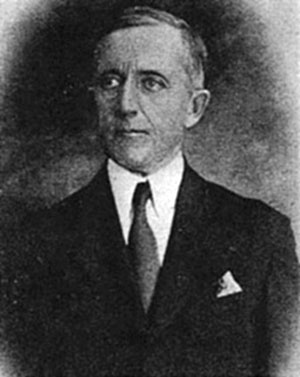
Giles Russell Taggart was born in Clarksboro, New Jersey in 1870. He earned a bachelor’s degree from Columbia University and a law degree at George Washington University before serving in the Departments of Justice and Commerce and Labor.
Taggart later served as U.S. consul to Cornwall, Fort William, Port Arthur and Belize, British Honduras. A devastating hurricane in the latter nation caused him to fall ill with pneumonia – in addition to suffering from several broken ribs – and die on September 15, 1931.
In 1934, the U.S. House of Representatives honored Taggart’s heroism in saving others’ lives during the storm.
 §
§
J. Theodore Marriner
Murdered — Beirut, Syria 1937
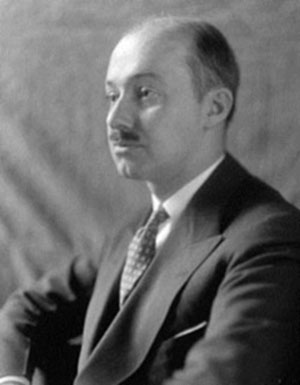
James Theodore Marriner was born in Portland, Maine in 1892. He graduated from Dartmouth College and Harvard University before taking the Foreign Service entrance exam in 1918.
Marriner was later assigned to Stockholm, Bucharest, Bern, Paris and the following conferences: the Preparatory Commission for Disarmament Conference in Geneva, the Special Commission for the Preparation of a Draft Convention on the Manufacture of Arms in Geneva, the Pact for Renunciation of War in Paris, the London Naval Conference, the Conference of Ministers for a Moratorium on International Debts in London, the General Disarmament Conference in Geneva and the Eighth General Conference on Weights and Measures in Paris.
Marriner’s final post was as U.S. consul General in Beirut, Syria (now Beirut, Lebanon). He was murdered on October 12, 1937, by an Armenian-born U.S. citizen over a perceived insult.
 §
§
John O’Keefe
Malaria – Buenaventura, Colombia 1938
John Jack O’Keefe was born on August 21, 1895, in Jerome, Arizona, to Irish immigrant parents. Following military service in World War One, he graduated from the University of Arizona and worked for the U.S. Customs Service in Arizona through the 1920s. He first married Ella Johnson in 1926; they had two children, Patsy and John, before Ella died in 1929. He remarried to Eleanor Claasen in 1937.
O’Keefe joined the Department of State in 1931. He served in Nogales, Mexico (1931-1937), Agua Prieta, Mexico (1935-1937), and as Vice Consul in charge of the U.S. Consulate in Buenaventura, Colombia, from 1937 until his death. O’Keefe became very ill in Buenaventura and was medically evacuated by seaplane to Panama City. He died a few hours after arrival of malignant malaria in a hospital in Panama City on July 10, 1938, at the age of 42. His remains were accompanied by his wife, Eleanor, by ship through New Orleans. He is buried at the City of Nogales Cemetery in Nogales, Arizona.
[Sources: “Final Tribute Paid to John O’Keefe,” Nogales International, Nogales, Arizona, July 20, 1938, Page 1, online at Newspapers.com; “John Jack O’Keefe,’ City of Nogales Cemetery, Nogales, Arizona, Findagrave.com, Memorial ID: 111700689; Ancestry.com records, Office of the Historian records.]
 §
§
Henry W. Antheil, Jr.
Plane Exploded in Mid-Air — Estonia 1940
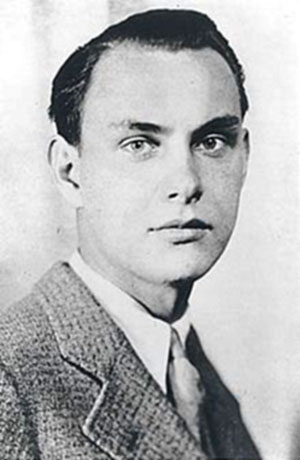
Henry William Antheil, Jr. was born in Trenton, New Jersey in 1912. He served as a skilled cipher clerk in the U.S. Legation in Helsinki, Finland and worked for Ambassador William Christian Bullitt in Germany and Moscow. He was killed on June 14, 1940 – the day the Soviet blockade of Estonia began.
Antheil was a passenger aboard the Finnish airplane Kaleva when Soviet bombers shot it down over the Gulf of Finland. He was carrying several diplomatic pouches and codes at the time of his death, some of which may have included vital information regarding the Soviet Union’s plans in the Baltic region.
 §
§
Louis Sussdorff, Jr.
Automobile Accident – Germany 1940
Louis Albert Sussdorff, Jr., was. Born in Elmhurst, New York, on January 7, 1888. He earned a law degree from Harvard University and entered the diplomatic service in 1914. In 1919, he married Flores Howard, a native of New Orleans, and they had two daughters, Laura and Mary Elizabeth.
After serving in posts including Paris, Rio de Janeiro, The Hague, Tokyo, Bucharest, and Brussels, he arrived as U.S. Consul General in Antwerp, Belgium, in 1937 and remained after Germany occupied Belgium in May 1940. Returning to Belgium from a consular conference in Cologne, he died in Bergheim, Germany on August 29, 1940, when the automobile he was driving was struck by a speeding train at a crossing where visibility was obstructed by parked German Army trucks. He was 52. Seriously injured in the same accident was the U.S. Consul in Brussels, Charles Clinton Broy, who died three years later of heart problems that may have been aggravated by the 1940 crash. Sussdorff is buried at Saint James Episcopal Church Cemetery in Elmhurst, New York.
[Sources: Public Opinion, Chambersburg, Pennsylvania, September 3, 1940, Page 9, online at Newspapers.com; “Louis Sussdorff, Jr.,” Saint James Episcopal Church Cemetery, Elmhurst, New York Findagrave.com, Memorial ID 80727679; Ancestry.com records; Office of the Historian Records.]
 §
§
John M. Slaughter
Earthquake — Guayaquil, Ecuador 1942
John Miller Slaughter was born in Goshen, Indiana, on April 10, 1904, and moved to South Bend, Indiana with his parents as a child. He graduated from Williams College in Williamstown, Massachusetts, and married Mary Jane Baker on February 22, 1942, in South Bend, Indiana, shortly before the couple departed for their first post in Guayaquil, Ecuador. In Guayaquil, Slaughter served as vice consul and both he and his wife were among the 115 victims of a devastating earthquake on May 13, 1942. Slaughter was 38 and his wife was 27 years old. They are buried in Riverview Cemetery in South Bend, Indiana.
[Sources: “Simple Home Wedding United Prominent Couple,” The South Bend Tribune, February 23, 1942, Page 6, online at Newspapers.com; “John M. Slaughter Made U.S. Vice Consul in Ecuador,” The South Bend Tribune, South Bend, Indiana, March 8, 1942, Page 27, online at Newspapers.com; “John Miller Slaughter,” Riverview Cemetery, South Bend, Indiana, Findagrave.com, Memorial ID 140535048; Ancestry.com records; Office of the Historian Records.]
 §
§
Felix Russell Engdahl
Accidental Fall in POW Camp — Hong Kong 1942
Felix Russell “Russ” Engdahl was born July 28, 1907, in Spokane, Washington, to Swedish immigrants Knut and Anna Engdahl. He joined the Foreign Service in 1930 and served as U.S. vice consul to Port-au-Prince, Calcutta, and Shanghai. In Shanghai in 1937, he met and married Elizabeth “Lee” Cary Lockhart, daughter of an American economic adviser to the Chinese government. A few months later, Lee Engdahl relocated first to Manila and then to the United States as Japanese forces invaded China.
Engdahl journeyed from Shanghai to Hong Kong on courier duty before its fall to the Japanese in December 1941. He was subsequently captured and taken to the Stanley Internment Camp, where he died on May 14, 1942, after falling down a flight of stairs and suffering a skull fracture at the age of 34. His death occurred only a few months before all the Americans in the camp were repatriated. He is buried at Stanley Military Cemetery in Hong Kong.
Following the war, his wife, Lee Engdahl, joined the Foreign Service as a consular officer and returned to Shanghai for her first assignment, where her sister’s family were interned under very difficult circumstances for the duration of the war. Lee served a long career with the Department, retiring from the Visa Office in 1969.
[Sources: “Spokane Man Wed in China,” The Spokesman-Review, Spokane, Washington, March 7, 1937, Page 31, online at Newspapers.com; Henderson, Lindsay, “A Labor of Love: Rediscovering State’s Lost History,” Foreign Service Journal, January-February 2022; “Felix Russell Engdahl,” Stanley Military Cemetery, Stanley, Hong Kong Island, China, Findagrave.com, Memorial ID 42839102; Ancestry.com records; Office of the Historian Records.]
 §
§
Frederick Eyssell
Typhoid Fever – Colombia 1942
Frederick Walter Eyssell was born November 28, 1917, in Kansas City, Missouri. He graduated from the University of Heidelberg in Heidelberg, Germany, and attended the Turner Diplomatic School in Washington, D.C. before he passed the Foreign Service exam and was assigned as a Vice Consul in Cartagena, Colombia. Eyssel arrived in Cartagena as a first-tour officer on February 19, 1942, and died there from typhoid fever just three months later, on May 18, 1942, at the age of 24. He is buried in Mount Washington Cemetery in Independence, Missouri.
[Sources: The Kansas City Times (Kansas City, Missouri), 1 Jun 1942, Page 13, online at Newspapers.com; Columbia Missourian (Columbia, Missouri) 25 May 1942, Page 1, online at Newspapers.com; “Frederick Walter Eyssell,” Mount Washington Cemetery, Independence, Missouri, Findagrave.com, Memorial ID: 92597358; Ancestry,com records; Office of the Historian records.]
 §
§
Homer White
Airplane Crash – Nigeria 1945
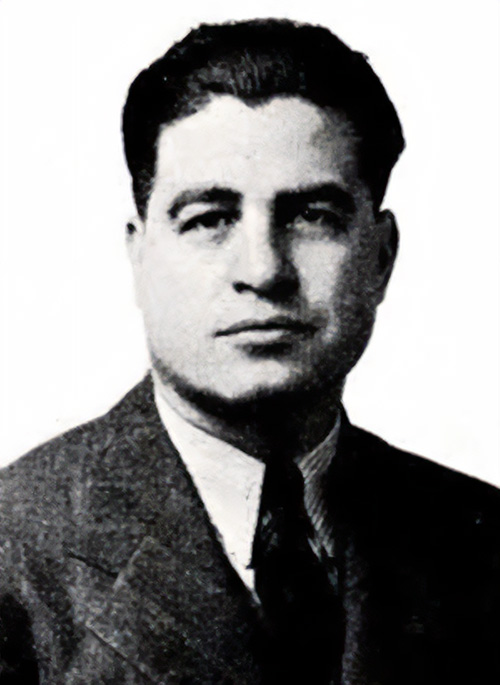
Homer Castle White was born in Pekin, Indiana on January 10, 1906, and later moved to New Albany, Indiana. He married Lena Mae Kahl, and they had four children. White was a postal clerk before the outbreak of World War II, when he became a captain in the U.S. Army Courier Service. Discharged from the Army in 1944, he joined the State Department’s Diplomatic Courier Service in January 1945.
White died on December 4, 1945, in an airplane crash while accompanying a State Department classified diplomatic pouch shipment. The U.S. Army aircraft he was traveling in went missing after take-off between Liberia en route to Ghana. The airplane was never found, but the Army accident report speculates that it crashed in Nigeria. All passengers were declared dead a year after the crash. He died at age 39.
[Sources: “Kin Ask Full Hunt for 17 Lost on Flight,” Buffalo Courier Express, Buffalo, New York, February 19, 1946, Page 4, online at Newspapers.com; https://www.state.gov/homer-white/; Ancestry.com records; Office of the Historian records.]
 §
§
Carlin Treat
Airplane Crash – Morocco 1946
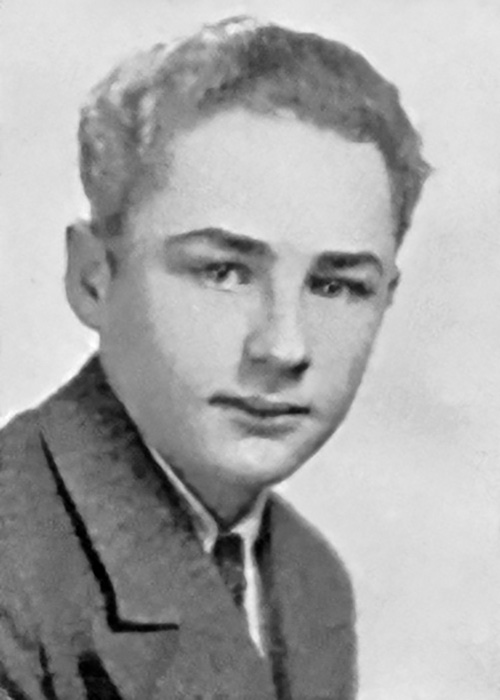
Carlin Alexander Treat was born February 11, 1920, and raised in San Andreas, California. Treat graduated from the University of Santa Clara and received a Master’s degree from Northwestern University in 1942. He was stationed in Alaska during World War II, where he served as a Lieutenant in the U.S. Naval Reserve; he also worked as a radio script writer for the Office of War information in Washington, D.C..
Treat joined the Foreign Service and was assigned to be a Vice Consul in Casablanca, Morocco, for his first assignment. He died in plane crash in Morocco on his way to post on October 10, 1946. His wife and the daughter of U.S. Consul Howard Elting were on the same flight. Treat was survived by his wife, Marjorie, and a 4 month old son, John. He is buried in Arlington National Cemetery.
[Sources: Chicago Tribune, Chicago, Illinois, October 12, 1946, Page 16, online at Newspapers.com; Stockton Evening and Sunday Records, Stockton, California, November 29, 1944, Page 5, online at Newspapers.com; “Carlin Alexander Treat,” Arlington National Cemetery, Arlington, Virginia, Findagrave.com, Memorial ID: 49328083; Ancestry.com records; Office of the Historian records.]
 §
§
George Atcheson, Jr.
Airplane Crash – Pacific Ocean 1947
George C. Atcheson, Jr. was born on October 20, 1896, in Denver, Colorado, and graduated from the University of California. He worked briefly in journalism before becoming an interpreter at the U.S. Legation in Peking (Beijing), China, also serving in Changsha, Tientsin (Tianjin), Foochow (Fuzhou), and Nanking (Nanjing) before he became the Charge d’Affaires in Chungking (Chongqing) in 1943. He met and married fellow University of California graduate Mariquita de Laguna at a legation ball in China in 1922; they had one son. Atcheson was aboard the U.S.S. Panay when it was sunk in the Yangtze River in December 1937, for which he was awarded the Navy Expeditionary Medal. He attended the United Nations Organization conference in San Francisco in 1945 and became the U.S. representative to the Far Eastern Subcommittee of the U.S. War Crimes Commission. He also served as chairman of the Allied Council for Japan in April 1945.
Having initially been tapped to be the next U.S. Minister to Siam (Thailand) after World War II, Atcheson was assigned as an advisor to General Douglas McArthur’s staff in occupied Japan. He was traveling from Japan to Washington, D.C. to review U.S.-Japan peace treaty drafts when the U.S. Army Air Corps B-17 he was flying in crashed after running out of fuel 110 miles west of Oahu, Hawaii on August 17, 1947. He was 50 years old.
[Sources: Santa Barbara News-Press, Santa Barbara, California, August 18, 1947, Page 2, online at Newspapers.com; Ancestry.com records; Office of the Historian records.]
 §
§
George Henderson
Airplane Crash – Shannon, Ireland 1948
George Dailey Henderson was born July 20, 1913, in Mexico City, Mexico, to American parents. He graduated from Stanford University in 1939. He first married Ruth Neupert; they had one daughter before divorcing in 1943. His second marriage was to Romanian-born Agnes “Agi” Lengyel in 1945 in Washington, D.C.; they had one son, Bruce, born in 1947. Henderson served in Ciudad Juarez, Asuncion, Tirana, Mexicali, and Rome before his 1947 assignment as the U.S. Consul in Dhahran, Saudi Arabia. He, his wife, and son all died in the airplane crash of their Pan Am flight at Shannon Airport in Ireland on April 15, 1948, while enroute to Washington, D.C. for consultations. The family is buried at Drumcliff Cemetery in Ennis, Ireland.
[Sources: “George Dailey Henderson,” Drumcliff Cemetery, Ennis, Ireland, Findagrave.com, Memorial ID 162506747; Ancestry.com records; Office of the Historian records.]
 §
§
Thomas C. Wasson
Shot by Sniper — Jerusalem 1948
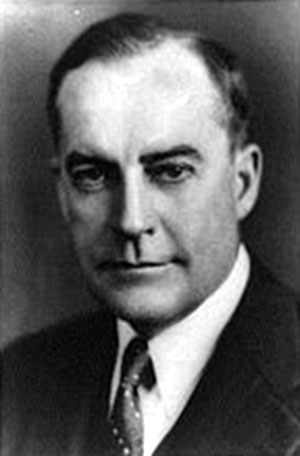
Thomas Campbell Wasson was born in Essex, New Jersey in 1896. He served as U.S. vice consul to Melbourne, Australia and Puerto Cortes, Honduras; U.S. consul to Lagos, Nigeria; and U.S. consul general to Jerusalem.
On May 22, 1948, Wasson was shot while returning to the U.S. Consulate in Jerusalem after a meeting of the UN Truce Commission at the French consulate. He died the following day, and the killer was never found.
 §
§
Douglas S. Mackiernan
Killed by Gunfire — Tibet 1950
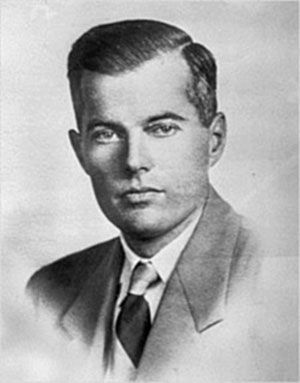
Douglas Seymour Mackiernan was born in Mexico City, Mexico, in 1913. His family moved to Stoughton, Massachusetts when he was still a child. Mackiernan became a research assistant at the Massachusetts Institute of Technology and during World War WII was a major in the U.S. Army Air Corps as a cryptographer and a meteorologist. He later served as a clandestine Central Intelligence Agency officer working under Department of State cover as a U.S. vice consul at Urumqi, China. In 1949, when Secretary of State Dean Acheson ordered that the consulate be closed, Mackiernan was required to stay behind and continue his covert activities. When the threat of Communist troops arriving at Urumqi became immediate, the CIA ordered Mackiernan to travel through Tibet to India to escape. Mackiernan and a CIA contract agent along with three Russian allies began a 1000-mile camel and horseback journey across the Taklimakan desert.
On April 29, 1950, Tibetan border guards shot and killed Mackiernan and two other members of his party while he was crossing the Chinese border into Tibet. The U.S. Government had not requested permission for the group to enter Tibetan lands in time, and the guards had been issued orders to kill all foreigners who attempted to cross the frontier. Mackiernan was the first CIA officer killed in the line of duty. As the recently-created CIA did not yet have pension regulations, the Department of State offered his wife a survivor pension.
Note: When a CIA employe working under Department of State cover dies in qualifying circumstances, AFSA inscribes their name on the plaque. If the CIA later acknowledges their employment, AFSA updates the biographic information on this webpage.
[Source: https://www.cia.gov/legacy/honoring-heroes/heroes/douglas-s-mackiernan/]
 §
§
Laurence A. Steinhardt
Plane Crash — Ottawa, Canada 1950
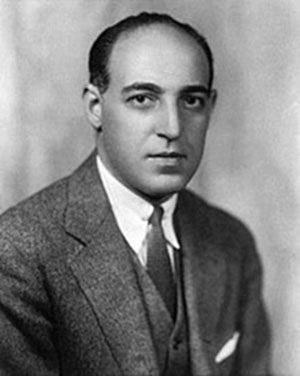
Laurence Adolph Steinhardt was born in New York City in 1892. He served as a sergeant in the U.S. Army during WWI, became a member of the Federation of American Zionists and the American Zion Commonwealth, practiced law and worked on the presidential campaign of Franklin D. Roosevelt.
President Roosevelt later appointed Steinhardt U.S. minister to Sweden and U.S. ambassador to Peru, USSR, Turkey, Czechoslovakia and, finally, Canada.
While in Turkey, Steinhardt assisted in the rescue of Hungarian Jews from the Bergen Belsen concentration camp and helped prominent intellectuals settle in Turkey after fleeing war-torn Europe.
Steinhardt died on March 28, 1950, while on an airplane which crashed en route to Washington, D.C. The first U.S. Ambassador killed in office, he was buried in Arlington National Cemetery.
 §
§
Richard Dunning
Airplane Crash – Liberia 1951
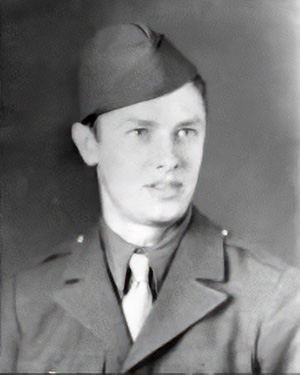
Richard True Dunning was born in Dallas, Texas, on June 13, 1921, and grew up in Glendale, California. He served in the U.S. Army in World War II. After discharge, he joined the State Department in October 1950 as a diplomatic courier. He had only been at his assignment based in Paris for a month when he died on June 22, 1951, in an airplane crash in Sanoyie, Liberia, while accompanying a State Department classified diplomatic pouch shipment between Paris and Capetown. He was on Pan American Airways flight 151, which crashed into a mountain in unknown circumstances 45 miles short of its next destination. He died at age 29. Due to the nature of the crash, all remains were buried near the crash site. Dunning was survived by his parents and one sister.
[Sources: “U.S. Diplomatic Courier was on Cape Town Trip,” Evening Star, Washington, D.C., June 23, 1951, Page 2, available at Newspapers.com; https://www.state.gov/richard-dunning/; Ancestry.com records; Office of the Historian records.]
 §
§
Robert Lee Mikels
Burned Attempting to Save Life — Pusan, Korea 1951

Robert Lee Mikels was born in Cerro Gordo, Illinois, on January 31, 1919. After serving in World War II, he joined the Foreign Service in July 1951 as an accounting clerk in Singapore before transferring in August 1951 to serve as an accounting clerk at the U.S. Embassy in Pusan, South Korea. On November 26, 1951, he died while trying to alert his colleagues of a fire caused by a heater. The fire destroyed the embassy building and Mikels twice refused opportunities to save himself in order to save colleagues in the building. He was posthumously awarded the Department of State’s Superior Service Award. He died at the age of 32 and is buried at Cerro Gordo Cemetery in Cerro Gordo, Illinois. He was survived by his parents and two brothers.
[Sources: “Robert Mikels Rites to be Tomorrow,” Herald and Review, Decatur, Illinois, December 19, 1951, Page 8, available at Newspapers.com; “Robert Lee Mikels,” Findagrave.com, Memorial ID 91805933; Ancestry.com records; Office of the Historian records.]
 §
§
Willard Fisher, Jr.
Airplane Crash – Tanganyika 1953
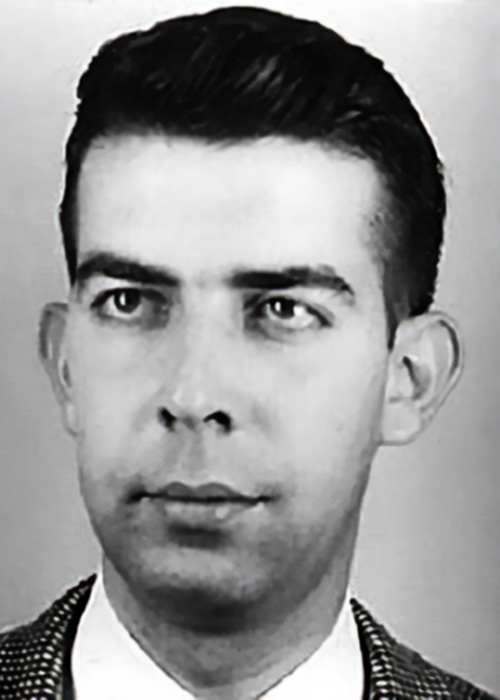
Willard Merrill Fisher, Jr., was born in Wilmington, Delaware, on March 23, 1926, and served in the U.S. Navy in World War II in the South Pacific. After the war, he attended the University of Delaware, graduating in 1951. He joined the Foreign Service in March 1952 as a diplomatic courier. He died on March 29, 1953, in an airplane crash in Mkwaja, Tanganyika (present-day Tanzania), while accompanying a State Department classified diplomatic pouch shipment. He was on a Central African Airways plane that broke apart in storms between Blantyre, in present-day Malawi, and Tanganyika, in present-day Tanzania. Fisher was 27 years old at the time of his death and is buried at the Anglican Cemetery in Tanga, Tanzania. He was survived by his parents.
[Sources: “Memorial Held for Plane Victim,” The Morning News, Wilmington, Delaware, April 27, 1953, Page 4, online at Newspapers.com; https://www.state.gov/willard-fisher-jr/; Ancestry.com records; Office of the Historian records.]
 §
§
David LeBreton, Jr.
Drowned Saving Lives — Tunis, Tunisia 1953
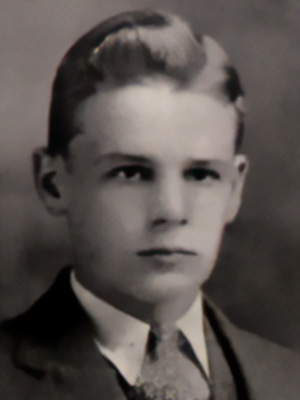
David MacDougall LeBreton, Jr., was born on January 25, 1913, in Washington, D.C. A graduate of Princeton University, LeBreton had also studied at the University of Virginia Law School and the French Ecole Libre des Sciences Politiques. LeBreton joined the State Department in 1941 as a clerk in Monterrey and served in Cairo and Alexandria in addition to Warsaw and posts in Europe. He married Adele Harmon Welles in Edgartown, Virginia in 1950.
While serving as U.S. Consul in Tunis, Tunisia, LeBreton drowned on August 28, 1953, at La Marsa, about six miles north of Tunis. He successfully saved the lives of the two children of Morris Nelson Hughes, who had arrived earlier in the day to take over as Consul General in Tunis, but suffered a heart attack after being swept out to sea during the rescue. LeBreton was 40 years old at the time of his death. He is buried at the U.S. Naval Academy Cemetery in Annapolis, Maryland, and was survived by his wife and his parents.
[Sources: “Tunis Consul, D.C. Native, Drowns Saving 2 Children,” Times Herald, Wahington, D.C., August 30, 1953, Page 1, online at Newspapers.com; “Mrs. Welles Will Be Wed This Month,” The Daily News Leader, Staunton, Virginia, August 8, 1950, Page 3; online at Newspapers.com; “David MacDougall LeBreton, Jr.,” Findagrave.com, Memorial ID: 74229327; Ancestry.com records; Office of the Historian records.]
 §
§
Everette D. Reese
Plane Shot Down — Vietnam 1955
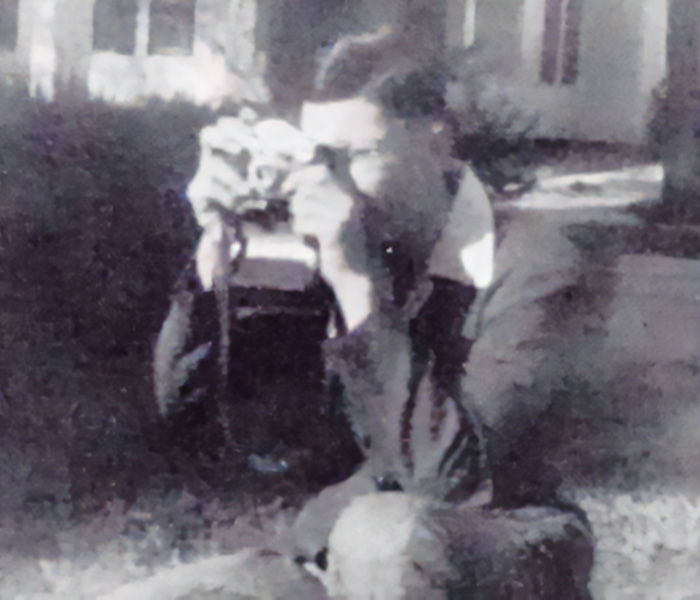
Everette Dixie Reese was born in Houston, Texas on October 25, 1923. He attended the University of Houston and worked for the Houston Post before completing his education in Paris at the Sorbonne. Reese had served in Vietnam for four years as director of the USAID photo service before his death on April 29, 1955, when his plane was shot down near Saigon. Reese was 31 years old and was buried at Forest Park Cemetery in Houston, Texas. He was survived by his wife, Dorothy E. Reese, who served as a United States Public Health Service nurse for three years in Vietnam and a one year old son, Alan, in addition to his mother, a sister, and a brother. Many of his photos are preserved in the collections of the Museum of Fine Arts Houston and the George Eastman Museum in Rochester, New York.
Note: His inscription on the AFSA memorial plaque lists his first name as “Everett” but official records found later say “Everette.”
[Sources: “Texan Who Took Photos of Persecuted Is Killed,” The Tablet, Brooklyn, New York, May 28, 1955, Page 21, online at Newspapers.com; https://en.wikipedia.org/wiki/Everette_Dixie_Reese; “Everette Dixie Reese,” Findagrave.com, Memorial ID: 20978797; Ancestry.com records; Office of the Historian records.]
 §
§
William P. Boteler
Killed by Grenade — Nicosia, Cyprus 1956
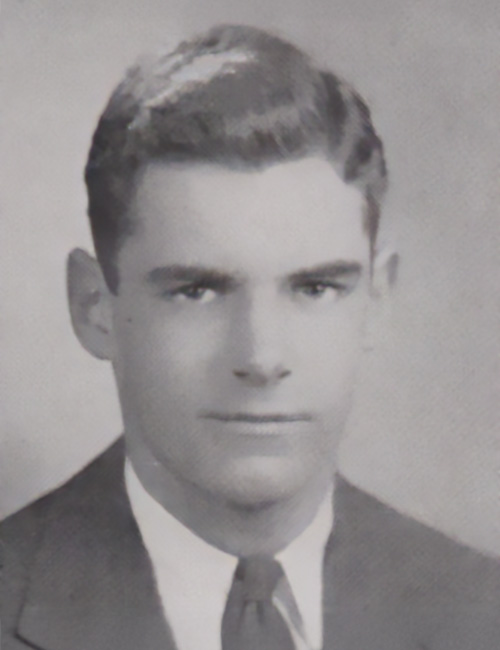
William Pierce Boteler was born May 20, 1930, in Washington, D.C. He joined the Central Intelligence Agency in 1951. Serving under diplomatic cover as a U.S. vice consul at Nicosia, Cyprus, he died on June 16, 1956, in the bombing of a restaurant by the National Organization of Cypriot Fighters (EOKA). Five other Americans were injured in the attack. Boteler was 26 years old and is buried at Arlington National Cemetery. He was survived by his father, stepmother, a brother, and a sister.
Note: When a CIA employee working under Department of State cover dies in qualifying circumstances, AFSA inscribes their name on the plaque. If the CIA later acknowledges their employment, AFSA updates the biographic information on this webpage.
[Sources: “Cyprus Café Bombs Hurt L.A. Man,” The Los Angeles Times, June 18, 1956, Page 1, online at Newspapers.com; https://www.cia.gov/legacy/honoring-heroes/heroes/william-pierce-boteler/; “William Pierce Boteler,” Findagrave.com, Memorial ID 36692486; Ancestry.com records.]
 §
§
Livingston Lord Satterthwaite
Helicopter Crash — Greenland 1959
Livingston Lord Satterthwaite was born March 12, 1909, in Montgomery, Pennsylvania and lived in Ambler, Pennsylvania. He attended Phillips Exeter Academy and graduated from Yale in 1931, joining the Foreign Service after graduation. He served a long career in Mexico City, San Jose, London, Damascus, Guadalajara, Istanbul, Frankfurt, Baghdad, Paris, and Berlin before becoming deputy chief of mission in Copenhagen, Denmark. Satterthwaite married twice, in 1933 to Adelaide Bristol with whom he had a son, and after a divorce, to Beatrice Bryant Charlton in 1955.
On August 29, 1959, while in Greenland on official business, Satterthwaite and six others died in a helicopter crash after returning an Inuit woman to her village following surgery at the Thule Air Base. The crash occurred minutes before the crew would have landed back at Thule, Greenland. Satterthwaite was 50 years old. He is buried at Hatboro Cemetery in Hatboro, Pennsylvania.
[Sources: “U.S. Diplomat Among 7 Killed in Copter Crash,” The Philadelphia Inquirer, Philadelphia, Pennsylvania, August 28, 1959, Page 1, online at Newspapers.com; “Livingston Lord Satterthwaite,” Findagrave.com, Memorial ID 22132753; Ancestry.com records, Office of the Historian records.]
 §
§
John Francis O’Grady
Plane Crash — Australia 1960
John Francis O’Grady was born in Lowell, Massachusetts, on April 5, 1920. He married Elsie Shaw; they had two children, Brian and Brenda. After serving in the U.S. Naval Reserve during World War II, O’Grady joined the State Department, serving in New Delhi, Damascus, Athens, and Washington. While serving as U.S. consul in Brisbane, Australia, he died in a plane crash on June 10, 1960, off the coast of Queensland. O’Grady was on an official tour of the consular district at the time. O’Grady is buried at Arlington National Cemetery.
[Sources: “Plane Hits Sea in Fog Off Coast,” Fort Worth Star Telegram, Fort Worth, Texas, June 11, 1960, Page 1, online at Newspapers.com; “John Francis O’Grady,” Findagrave.com, Memorial ID 49346301; Ancestry.com records; Office of the Historian records.]
 §
§
Dolph B. Owens
Gunshot Wounds — Vietnam 1960
Dolph Brabham Owens was born in Birmingham, Alabama, on September 29, 1927, and lived in Tuscaloosa. He married Margaret Stallworth; they had two daughters, Donna and Krista. Owens served in the U.S. Army Special Forces before becoming a USAID public safety advisor at the American Embassy in Saigon, Vietnam. On November 5, 1960, Owens and his Vietnamese driver were killed in an early morning Viet Cong machine-gun ambush. His family was enroute to Vietnam to join him when they were notified of his death at the age of 33. He is buried at Memory Hill Gardens in Tuscaloosa, Alabama.
[Sources: The Indianapolis Star, Indianapolis, Indiana, November 7, 1960, Page 4, online at Newspapers.com; “Dolph Brabham Owens,” Findagrave.com, Memorial ID 159080272; Ancestry.com records, Office of the Historian records.]
 §
§
Robert A. McKinnon
Tropical Disease — Ouagadougou, Burkina Faso 1961
Robert Allen McKinnon was born on June 16, 1924, in Winchester, Massachusetts. He lived in Montreal, Canada, for about 15 years and graduated from high school there before he graduated from Yale University and the Fletcher School of Law and Diplomacy. He joined the State Department in 1948, serving in Halifax, Dar Es Salaam, Brussels, and Ouagadougou. He married Lorraine Miller in 1945 and they had three daughters, Diane, Barbara, and Mary.
For eight months prior to his death, McKinnon served as consul and the first charge d’affaires ad interim at the U.S. Embassy in Ouagadougou, Burkina Faso. He fell ill with a kidney infection caused by a tropical disease and was medevacked to Frankfurt, Germany, where he died in the U.S. Army hospital (now the U.S. Consulate General building) on September 8, 1961. McKinnon was 37 years old. He is buried in Westminster West Cemetery in Westminster, Vermont.
[Sources: “R.A. McKinnon, Upper Volta Envoy, Dies,” Chicago Daily Tribune, Chicago, Illinois, September 9, 1961, Page 18, online at Newspapers.com; Foreign Service Journal, June 1963, Page 4; “Robert Allen McKinon,” Findagrave.com, Memorial ID: 238643126; Ancestry.com records; Office of the Historian records.]
 §
§
William Dale Fisher
Plane Crash — Ethiopia 1961
William Dale Fisher was born November 19, 1919, in Oak Park, Illinois. He married Sarah Guiou in 1942 and they had three children. Fisher served as a lieutenant in the U.S. Navy before joining the State Department and serving in France, the Netherlands, Austria, San Marino, and Czechoslovakia before becoming an economic officer in Ethiopia. On September 15, 1961, he died in a plane crash during a charter survey flight with staff of the American Coronado Petroleum Corporation. He is buried in Arlington National Cemetery.
[Sources: “Air Crash Victim Has Omaha Kin,” Evening World-Herald, Omaha, Nebraska, September 7, 1961, Page 36, online at Newspapers.com; “Lt. William Dale Fisher,” Findagrave.com, Memorial ID: 8771710; Ancestry.com records, Office of the Historian records.]
 §
§
Oscar C. Holder
Plane Crash — Nepal 1962
Oscar Curtis Holder was born August 7, 1911, in Mississippi. He obtained degrees from Harvard and Sanford. He married Jane Cooper and they had two children, William and Mary. He joined the Foreign Service in 1941, serving in Port Said, Suez, Vladivostok, Lisbon, Moscow, Salzburg, Cairo, and Frankfurt. He was serving as a program inspector with USAID in Washington, D.C., at the time of his death. Holder died along with his colleague, Sidney Jacques, in the crash of a Royal Nepal airlines plane in the Himalayas on August 1, 1962. Nepal’s ambassador to India was also killed in the crash. He was 50 years old. Holder is buried in Rock Creek Cemetery in Washington, D.C.
[Sources: “Nepal Reports Finding Plane,” Evening Star, Washington, D.C., August 13, 1962, Page 25, online at Newspapers.com; “Oscar Curtis Holder,” Findagrave.com, Memorial ID: 200537007; Ancestry.com records; Office of the Historian records.]
 §
§
Sidney B. Jacques
Plane Crash — Nepal 1962
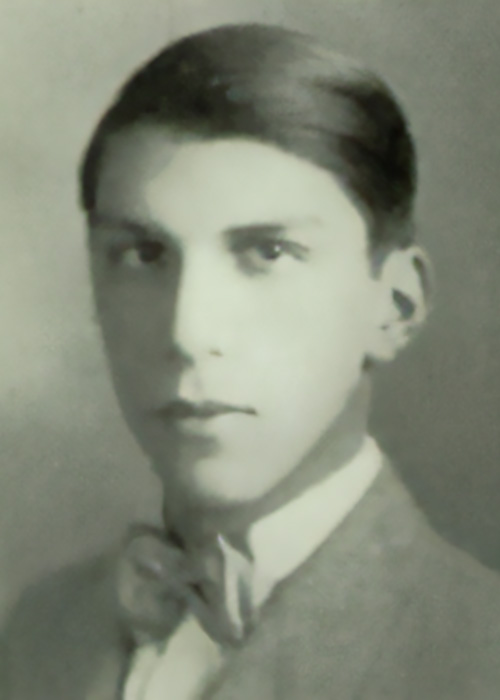
Sidney Bennett Jacques was born January 27, 1911, in Providence, Rhode Island. He graduated from Yale and served in the Army. He married Jean McAllister; they had one daughter, Gail. Jacques joined the Foreign Service and served in Paris, Athens, and the Naval War College. He was assigned to Washington in 1960 as a program inspector with USAID. Jacques died along with his colleague, Oscar Holder, in the crash of a Royal Nepal airlines plane in the Himalayas on August 1, 1962. Nepal’s ambassador to India was also killed in the crash. Jacques is buried in Arlington National Cemetery. He was 51 years old.
[Sources: “Nepal Reports Finding Plane,” Evening Star, Washington, D.C., August 13, 1962, Page 25, online at Newspapers.com; “Jacques, Sidney,” Evening Star, Washington, D.C., August 25, 1962, Page 6, online at Newspapers.com; “Sidney Bennett Jacques” Findagrave.com, Memorial ID: 6631347; Ancestry.com records; Office of the Historian records.]
 §
§
Nicole Boucher
Airplane Crash – Cameroon 1963
Nicole Audrey Marie Boucher was born in Providence, Rhode Island, on March 27, 1935. She worked as a secretary at the Harvard Medical School prior to joining the Foreign Service Staff Corps in 1960 as a secretary. Boucher was returning to the United States after completing her first assignment at U.S. Embassy Yaoundé when the Air Afrique airliner on which she was returning to the United States crashed into Mount Cameroon, near Douala, Cameroon, shortly after takeoff on May 10, 1963. She was 28. Diplomatic Courier Joseph Capozzi was on the same flight and was initially the sole survivor, but died in the hospital six days later. Boucher was survived by her parents and two brothers. There is a cenotaph in her memory at Precious Blood Cemetery in Woonsocket, Rhode Island.
[Source: “Nicole Audrey Boucher,” Findagrave.com, Memorial ID: 63351312; Department of State Newsletter, May 1963, inside front cover; Ancestry.com records]
 §
§
Joseph Capozzi
Airplane Crash – Cameroon 1963
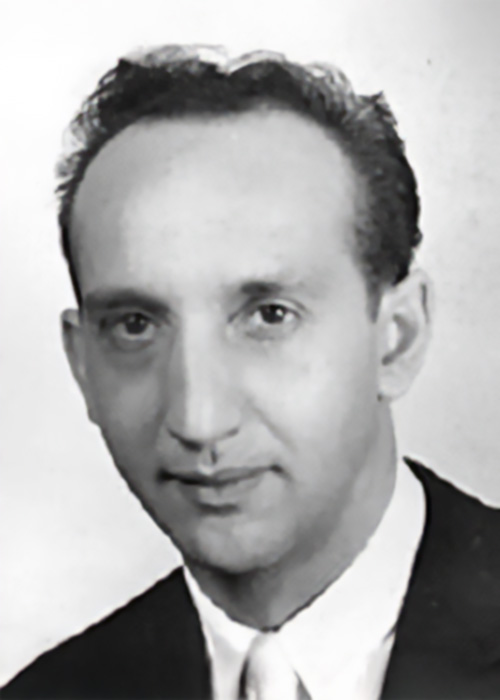
Joseph Patrick Capozzi was born on March 3, 1934, in New York City. Raised in Elmira, New York, Mr. Capozzi joined the U.S. Marine Corps and served in the Korean War. After his discharge in 1954, he worked several jobs and earned a degree from Harpur College in New York. He joined the Foreign Service in June 1962 as a diplomatic courier.
He died on May 10, 1963, from injuries sustained during the crash of the Air Afrique airliner on which he was returning to the United States with a classified pouch shipment. The flight crashed into Mount Cameroon, near Douala, Cameroon, shortly after takeoff. He was initially the only survivor among the 55 passengers on board, but died six days later in the hospital in Douala. U.S. Embassy Yaoundé secretary Nicole Boucher also died in the crash. Capozzi was survived by his parents, a brother, and three sisters. He was 29 years old. Capozzi is buried at Saint Peter and Paul’s Cemetery in Elmira, New York.
[Sources: “U.S. Courier Survived Crash of Airliner in Cameroon, Africa,” Transcript-Telegram, Holyoke, Massachusetts, May 6, 1963, Page 9, online at Newspapers.com; https://www.state.gov/joseph-capozzi/; “Sgt Joseph Patrick Capozzi,” Findagrave.com, Memorial ID: 164849930; Ancestry.com records.]
 §
§
Joseph R. Rupley
Killed by Gunfire — Caracas, Venezuela 1965

Joseph Robert “Bob” Rupley was born in Spokane, Washington on March 4, 1940. He attended the University of California – Riverside and studied in Germany before he earned an economics degree from University of California – Berkley. Rupley served for two years with the U.S. Peace Corps in Peru before becoming associate director of the Peace Corps in Venezuela. On February 19, 1965, while returning from the airport after picking up a Peace Corps volunteer, he was mistaken for a rebel, shot and killed by Caracas Police while driving through an area with ongoing unrest. David Glover, one of three Peace Corps volunteers who was in Rupley’s vehicle at the time, was also shot but survived. Rupley was 24 years old. He was survived by his parents. His remains are interred at the Chapel of the Chimes Columbarium and Mausoleum in Oakland, California.
[Sources: “Peace Corpsman Shot to Death,” The Indianapolis Star, Indianapolis, Indiana, February 21, Feb 1965, Page 2, online at Newspapers.com; “Joseph Robert Rupley,” Findagrave.com, Memorial ID: 232062727 and 85082779; Ancestry.com records.]
 §
§
Henry H. Ford
Automobile Accident – Frankfurt, West Germany 1965
Henry Holcomb Ford was born January 22, 1913, in Johnson City, Tennessee. He married Anna Deitz in 1941, and they had one daughter, Frances. A former U.S. Air Force officer, he served as Consul General in Casablanca and as comptroller of President Truman’s Point Four technical assistance program. In 1950, he was director of the Department of State’s budget division and later served as executive director of the Bureau of Near Eastern, South Asian and African Affairs.
While serving as U.S. Consul General in Frankfurt, West Germany (now Germany), Ford died in an automobile accident on the autobahn near Staffel (located between Frankfurt and Bonn) on March 9, 1965. His government chauffeur and his wife were both seriously injured in the crash, which took place while traveled to participate in a consular meeting in Bad Godesberg. He was survived by his wife, daughter, and mother, all of whom were living with him in Frankfurt at the time of the accident. Ford was 52 years old. He is buried at Arlington National Cemetery.
[Sources: “U.S. Consul General Crash Victim,” The Charlotte Observer, Charlotte, North Carolina, March 10, 1965, Page 4, online at Newspapers.com; “Henry H. Ford,” Findagrave.com, Memorial ID 49183308; Ancestry.com records.]
 §
§
Joseph W. Grainger
Murdered — Vietnam 1965
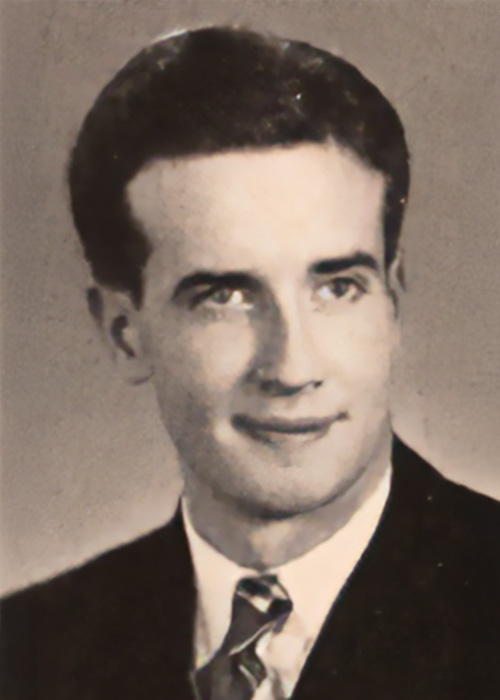
Joseph William Grainger was born on May 1, 1925, in Hartford, Connecticut. An Air Force veteran and graduate of Yale University, he was resident in Sumter, South Carolina and served as a USAID officer in Vietnam. Captured by the Viet Cong on August 8, 1964, along with a Filipino assistant and the Vietnamese manager of a sugar cane experiment station, he attempted escape and spent seven days making his way across a swamp, but was recaptured and killed after he refused to return to the prison camp on January 12, 1965. The two individuals who shot him were executed themselves, as the Viet Cong was no longer able to collect USAID reward money in exchange for Grainger’s safe return. His Filipino assistant was released on December 10, 1964, and the Vietnamese sugar plantation director was also later freed. Grainger’s wife, Elizabeth, and four children were evacuated with other dependents from Vietnam to Thailand in February 1965 before returning to the United States.
Grainger was the first civilian U.S. official captured in South Vietnam. He is buried in Arlington National Cemetery and was posthumously awarded the Department of State’s highest award.
[Sources: “Search for Aide Seized by Reds Pushed,” The Los Angeles Times, August 11, 1964, Page 7, online at Newspapers.com; The Kansas City Star, Kansas City, Missouri, April 13, 1965, Page 1, online at Newspapers.com; “Joseph William Grainger,” Findagrave.com, Memorial ID: 128414448; Ancestry.com records.]
 §
§
Barbara A. Robbins
Killed in Bombing of Embassy — Saigon, Vietnam 1965
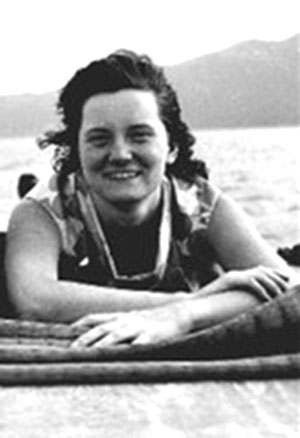
Barbara Annette Robbins was born in South Dakota in 1943. Raised primarily in Colorado, she attended Colorado State University and joined the Central Intelligence Agency soon after graduation.
Robbins served as a CIA officer under diplomatic cover at the U.S. Embassy in Saigon, Vietnam. On March 30, 1965, she was killed when insurgents detonated a car bomb outside of the Embassy.
Robbins was the first American woman to die in the Vietnam conflict, the first female CIA employee to be killed in action and, at age 21, the youngest CIA employee to ever die in action.
Note: When a CIA employee working under Department of State cover dies in qualifying circumstances, AFSA inscribes their name on the plaque. If the CIA later acknowledges their employment, AFSA updates the biographic information on this webpage.
[Source: https://www.cia.gov/legacy/honoring-heroes/heroes/barbara-a-robbins/]
 §
§
Jack J. Wells
Plane Crash — Vietnam 1965
Jack Junior Wells was born in New Boston, Ohio on June 23, 1926, and grew up in Minford, Ohio. Wells married Betty McGraw; they had one daughter and two sons. He enlisted in the U.S. Army soon after graduating high school, served in two World War II campaigns in the South Pacific, worked as a military advisor in South Vietnam, and retired from the Army as a major. He earned the Bronze Star and commendation medal for performance of duty.
Wells joined USAID after retiring from the Army and was assigned to South Vietnam. He died when his plane crashed under small arms fire on September 27, 1965, on approach to land at Bau Trai airstrip. He was 39 years old. He is buried at Marietta National Cemetery in Marietta, Georgia.
[Sources: “Jack Junior Wells,” Findagrave.com, Memorial ID 3958452; Ancestry.com records.]
 §
§
Norman L. Clowers
Viet Cong Ambush — Vietnam 1966
Norman Lee Clowers was born in Tacoma, Washington on September 11, 1915. He married Harriette Monroe, and they had a daughter and a son. Prior to joining USAID as a public safety advisor in South Vietnam, Clowers was a police officer in Tacoma, Washington, and chief of police training in Laramie, Wyoming. He also ran a successful private investigation business.
Clowers was killed by the Viet Cong during an ambush after delivering building materials to a small village near his post on July 25, 1966. He was 50 years old. He is buried at Mountain View Memorial Park in Tacoma, Washington.
[Sources: “AID Volunteers Carry on Humane ‘War’ in Viet Nam,” The Times Leader, Wilkes-Barre, Pennsylvania, August 31, 1966, Page 10, online at Newspapers.com; “Norman L. Clowers,” Findagrave.com, Memorial ID: 114192872; Ancestry.com records.]
 §
§
William W. Smith III
Plane Collision — Vietnam 1966
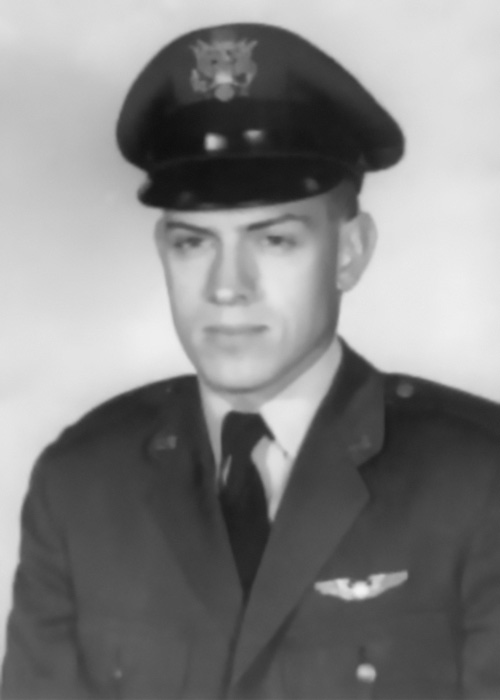
William Ward Smith III was born in Searcy, Arkansas, on January 15, 1934. Joining the Air Force, he rose through the ranks to the grade of captain. On July 23, 1966, he was serving with the 505th Tactical Air Continuity Group as a passenger in a Cessna Bird Dog Observation Aircraft on a forward air control mission controlling a flight of F-4B aircraft when, at the completion of the airstrike, his O-1E collided with a Marine helicopter at 2500 feet. He was 32 years old. His remains were not recovered, and there is a cenotaph in his memory at Honolulu Memorial in Honolulu, Hawaii.
Note: AFSA added him to the Memorial Plaque in 1972 along with 22 other deaths dating back to 1960. The inscribed name is William D. Smith III having died in 1966 in Vietnam. USAID separately inscribed the same name on its Memorial Wall. However, a records search in 2025 found only Air Force Captain William W. Smith III dying in Vietnam in 1966 as described above, with no mention of him being detailed to USAID.
[Sources: https://www.virtualwall.org/ds/SmithWW01a.htm; “Capt. William Ward Smith,” Findagrave.com, Memorial ID: 137016430 and 228385657; Foreign Service Journal, May 1971, page 57; Foreign Service Journal, November 1972, page 38; Ancestry.com records.]
 §
§
Don M. Sjostrom
Communist Troop Attack — Laos 1967
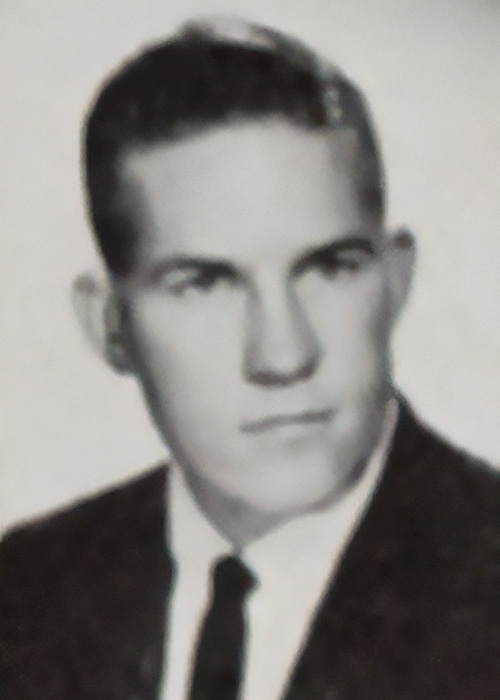
Don Myron Sjostrom was born in Bothell, Washington on April 20, 1940. He earned a degree in philosophy from the University of Washington and served in Thailand with the Peace Corps. Serving in Laos as a U.S. Agency for International Development operations officer, he died of a head injury when a mortar shell exploded on January 8, 1967, during a conflict in the town of Nakhang, where he had gone to help refugees fleeing from Communist forces. Sjostrom was survived by his parents, two sisters, and a brother. He was 26 years old. He is buried at Evergreen Cemetery in Everett, Washington.
[Sources: “Shell Burst Takes Life of Volunteer,” The Daily Herald, Everett, Washington, January 7, 1967, Page 1, online at Newspapers.com; “Don M. Sjostrom,” Findagrave.com, Memorial ID: 16832266; Ancestry.com records.]
 §
§
Francis J. Savage
Wounds Suffered during Viet Cong Bombing — Vietnam 1967
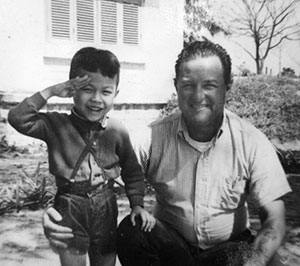
Francis John “Bud” Savage was born in Olean, New York, on June 26, 1925. He served in the U.S. Navy during the tail end of WWII and joined the State Department in 1950, serving in Iceland, Greece, France, Trinidad, and Libya.
In 1960, Savage joined the U.S. Agency for International Development where he worked as a general services officer in Mogadishu, Somalia, and a provincial representative in Vietnam. He died on March 17, 1967, from complications of malaria and liver surgery to repair an abscess that resulted from severe wounds suffered two years earlier during a bombing at the My Cahn Café, a floating restaurant in Saigon. He was 42. Savage was survived by his wife, Doreen, two children, and his mother. Savage was posthumously awarded the Secretary’s Award by President Lyndon B. Johnson. He is buried at Saint Bonaventure Cemetery in Allegany, New York.
[Sources: “Posthumous Award Given to Family of Olean Man,” The Buffalo News, Buffalo, New York, August 16, 1967, Page 47, online at Newspapers.com; “Francis J. ‘Bud’ Savage,” Findagrave.com, Memorial ID: 19505681; Ancestry.com records.]
 §
§
Gustav Crane Hertz
Died of Malaria while Held Captive — Vietnam 1967
Gustav Crane Hertz was born in Queens, New York on May 10, 1918. He married Nellie “Solange” Strong; they had five children. He was a graduate of American University in Washington, D.C.
Hertz served with the U.S. Agency for International Development in Vietnam as the chief of public service administration. On February 2, 1965, he was captured by the Viet Cong northeast of Saigon while driving a motorcycle on a highway. He spent the next two and a half years as a prisoner of war, eventually succumbing to malaria, on or about September 24, 1967. He was 49 years old. Hertz is buried at Saint John the Apostle Catholic Cemetery in Leesburg, Virginia.
[Sources: “Viet Reds Threaten Kidnaped Yankee,” Independent, Long Beach, California, April 8, 1965, Page 5, online at Newspapers.com; “Seek Body of Kidnaped Aide,” The Kansas City Times, Kansas City, Missouri, November 8, 1967, Page 15, online at Newspapers.com; “Gustav Crane Hertz,” Findagrave.com, Memorial ID: 35195613; Ancestry.com records.]
 §
§
John R. McLean
Chartered Airplane Crash — Laos 1967
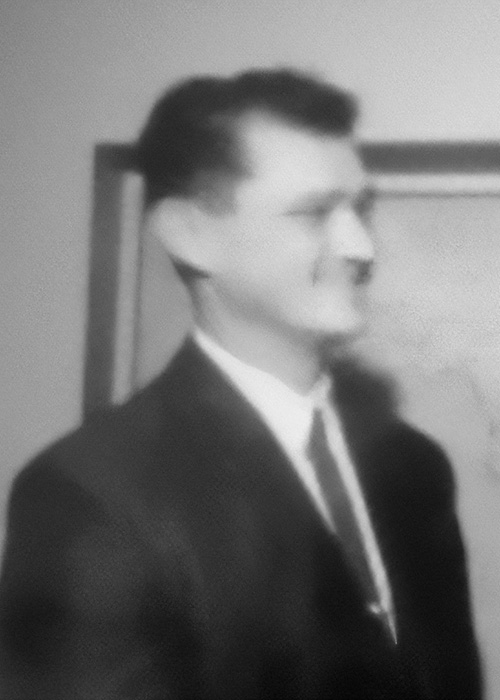
John Roger McLean was born in Tucson, Arizona on September 25, 1934, and raised in Detroit, Michigan. He spoke fluent Lao and served as a public affairs officer with the U.S. Information Service in Laos. He died in the crash of a chartered airplane on April 6, 1967, along with four other Americans. He was 32 years old. McLean was survived by a sister, three nieces, a nephew, and his uncle, who worked for the U.S. Information Agency. McLean is buried at Holy Sepulcher Catholic Cemetery in Southfield, Michigan.
[Sources: “Brutal Laotian War Continued Unabated,” The Spokesman-Review, Spokane, Washington, February 19, 1967, Page 53, online at Newspapers.com; “2 From Texas Among Victims in Laos Crash,” Fort Worth Star-Telegram, Fort Worth, Texas, May 6, 1967, Page 2, online at Newspapers.com; “John Roger McLean,” Findagrave.com, Memorial ID: 139983874; Ancestry.com records.]
 §
§
Robert K. Franzblau
Killed by Communist Forces — Vietnam 1967
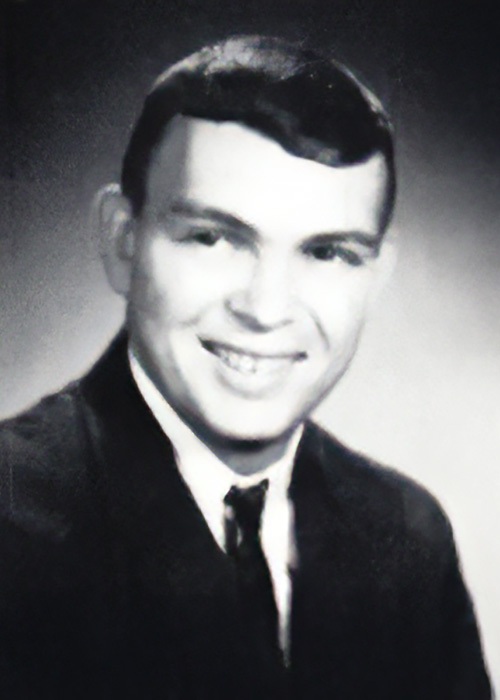
Robert Kenneth Franzblau was born April 8, 1941, in Brooklyn, New York. A graduate of the University of Florida, former high school teacher, and an Army veteran who had served a tour in Vietnam, he joined the U.S. Agency for International Development to return to the country, where he taught and worked with children. He died on June 7, 1967, of a gunshot sustained during a Viet Cong attack on the house in which he was staying in the town of Bien Son, 15 miles east of Saigon. Franzblau was 26 years old. He was survived by his parents and a sister, and is buried at Lakeside Memorial Park in Doral, Florida.
[Sources: “Ex-Miami Teacher Dies,” The Miami News, Miami, Florida, June 8, 1967, Page 23, online at Newspapers.com; “Robert Kenneth Franzblau,” Findagrave.com, Memorial ID: 215780736; Ancestry.com records.]
 §
§
Dwight Hall Owen, Jr.
Killed by Communist Forces — Vietnam 1967
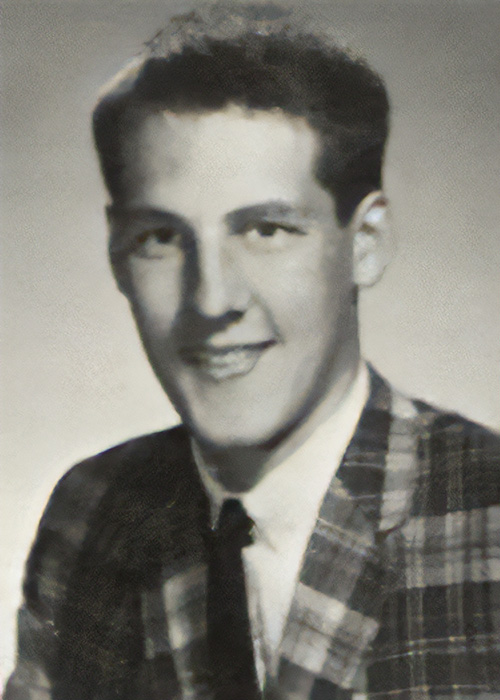
Dwight Hall Owen, Jr., was born in Providence, Rhode Island, on February 9, 1946. He worked as a freelance newspaper correspondent before joining the U.S. Agency for International Development at the age of 19 while a student at Stanford University. Owen had first served with USAID in Vietnam while on sabbatical from his studies in 1965 and returned to Vietnam for a second time in 1967 after turning down an opportunity to enroll at Stanford’s campus in Germany. Owen died of a gunshot wound near Chu Lai, Vietnam on August 30, 1967, while saving other Vietnamese and American officials from an ambush. He was 21 years old. Owen was survived by his parents and two brothers. He is buried at Swan Point Cemetery in Providence, Rhode Island.
[Sources: “Stanford Student Will Never Return,” The Napa Valley Register, Napa, California, October 26, 1967, Page 6, online at Newspapers.com; “Dwight Hall Owen, Jr.,” Findagrave.com, Memorial ID 66149673; Ancestry.com records.]
 §
§
Donald V. Freeman
Shot during Hostile Fire — Vietnam 1967
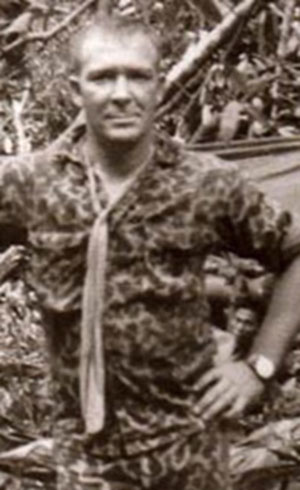
Donald Vern Freeman was born on August 8, 1935, in Oklahoma. He rose to the rank of captain in the U.S. Army and was killed October 3, 1967, in Vietnam while serving the U.S. Agency for International Development. He was 32 years old. He was survived by his wife, Rose Baxter Freeman, four children, and his mother and sister.
[Sources: Great Bend Tribune, Great Bend, Kansas, October 17, 1967, Page 2, online at Newspapers.com; https://www.virtualwall.org/df/FreemanDV01a.htm; “Donald V. Freeman,” Findagrave.com, Memorial ID: 668814; Ancestry.com records.]
 §
§
Carroll H. Pender
Landmine Explosion — Vietnam 1967
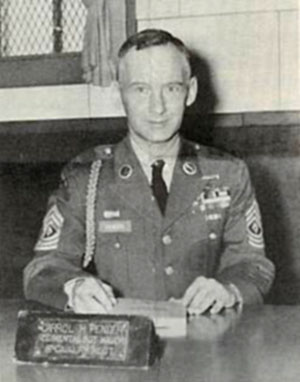
Carroll H. Pender was born in Jefferson County, Indiana, on December 30, 1921. He served with the Canadian Army in Europe during World War II – a result of being too young to join the U.S. Army – and in late 1944, briefly became a POW, imprisoned at Stalag IV-B at Mühlberg, near Dresden, Germany. After returning to the United States, Pender entered the U.S. Army. He fought in the Korean War and served in the Vietnam War as a senior enlisted advisor to the South Vietnamese 25th Infantry Division. Pender retired a command sergeant major in 1966.
Pender joined the U.S. Agency for International Development immediately after retirement as a hospital administration specialist and member of an American-Swiss surgical team. He was killed by a landmine on December 27, 1967, after rushing to the scene of a nearby attack to aid the wounded. He was 45 years old. Pender was survived by his wife, two sons, his mother, and six siblings.
[Sources: “Dearborn Kin, War Casualty, In Last Rites,” The Lawrenceburg Press, Lawrenceburg, Indiana, January 11, 1968, Page 2, online at Newspapers.com; Ancestry.com records.]
 §
§
Thomas W. Ragsdale
Died while a Prisoner of War — Vietnam 1967
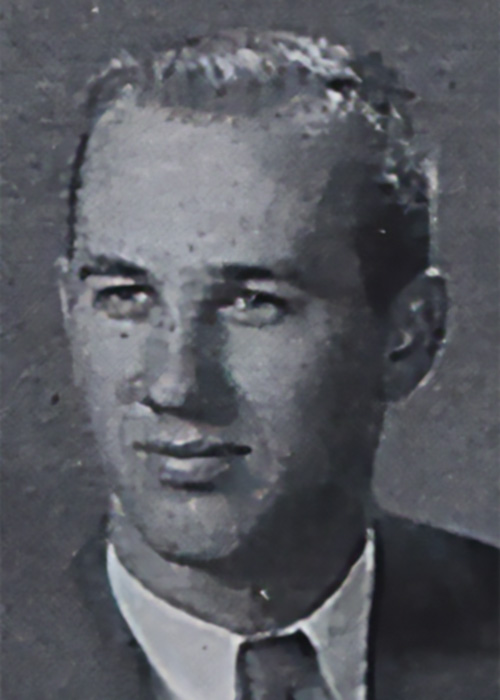
Thomas Weldon Ragsdale was born in Shelina, Missouri, on June 25, 1935. He studied at the University of Missouri at Columbia, graduated from the University of Maryland in 1959, after which he worked as a grain marketing specialist in Hyattsville, Maryland.
Ragsdale worked for the U.S. Department of Agriculture, serving as a civilian agricultural specialist with the U.S. Agency for International Development in Vietnam. He was captured by Communist forces in Hue during the Tet Offensive in February 1968 and died during imprisonment, the exact date unknown. His remains were recovered in July 1969 about 30 miles southwest of Hue.
[Sources: “40 Americans Are Missing in S. Vietnam,” Wilkes-Barre Times Leader, Wilkes-Barre, Pennsylvania, August 6, 1969, Page 43, online at Newspapers.com; Ancestry.com records.]
 §
§
Robert W. Brown, Jr.
Shot during Hostile Fire — Vietnam 1968
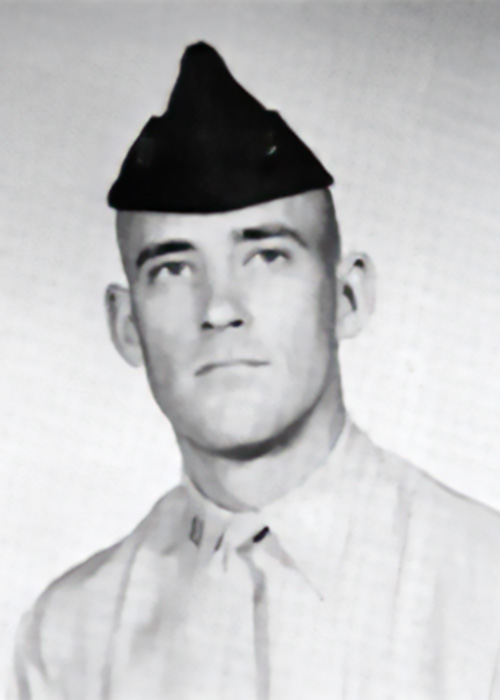
Robert Wilson Brown, Jr., was born in Easton, Maryland, on September 4, 1941. A U.S. Marine Corps captain, he served with the U.S. Agency for International Development and died of a gunshot wound on February 26, 1968, while on a resupply and inspection mission at the Truong Son hamlet in Darla Province. He was 26 years old. Brown was survived by his wife, Mary Brown, three sons, and his parents and a brother. He is buried in Arlington National Cemetery.
[Sources: “Cpt. Robert Wilson Brown Jr.,” Findagrave.com, Memorial ID: 228462973 and 154026418; https://www.virtualwall.org/db/BrownRW02a.htm; Ancestry.com records.]
 §
§
Frederick J. Abramson
Shot during Viet Cong Ambush — Vietnam 1968
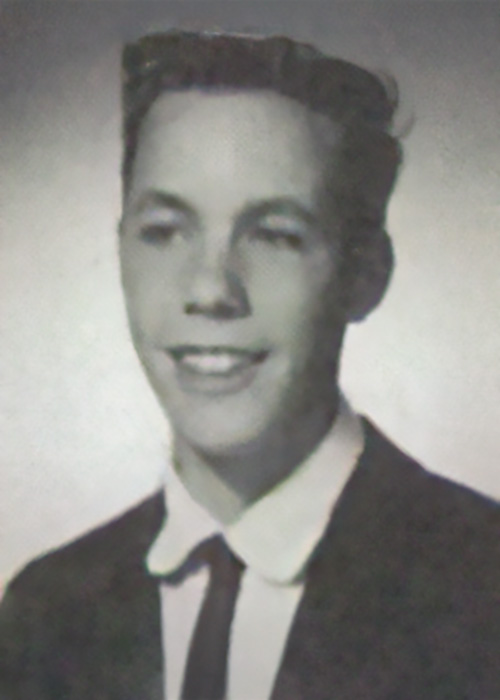
Frederick John Abramson was born in Bellevue, Washington on October 15, 1941. He earned a bachelor’s degree from Stanford University and a master’s degree from the School of Advanced International Studies at Johns Hopkins University. Abramson was the youngest American deputy province advisor with the U.S. Agency for International Development in the Mekong Delta and died along with four American soldiers when the Viet Cong attacked a military convoy in the Vinh Long Province on January 6, 1968. He was survived by his parents and two brothers.
[Sources: “VC Ambush Kills Adviser,” The Oregonian, Portland, Oregon, January 6, 1968, Page 4, online at Newspapers.com; Ancestry.com records.]
 §
§
Kermit J. Krause
Killed in Tet Offensive — Vietnam 1968
Kermit Joseph “Tom” Krause was born in Waterloo, Wisconsin, on September 8, 1919. A World War II Signal Corps veteran who also served in the Korean War, Krause served with the U.S. Agency for International Development as an assistant supply advisor and was killed by the Viet Cong at his residence in Hue, Vietnam, during the Tet Offensive on January 30, 1968. Krause was survived by his wife, Edith, three children, and one grandchild. He is buried at Golden Gate National Cemetery in San Bruno, California.
[Sources: “Army Eases Ruling to Permit Vet’s Burial in SF Cemetery,” The Sacramento Bee, Sacramento, California, February 19, 1968, Page 1, online at Newspapers.com; “Kermit Joseph Krause,” Findagrave.com, Memorial ID: 3597806; Ancestry.com records.]
 §
§
John T. McCarthy
Died from Gunshot Wound — Vietnam 1968
John Thomas McCarthy was born in Philadelphia, Pennsylvania, on July 31, 1909. He retired from the Washington, D.C. Metropolitan Police Department in 1959 after 21 years of service, joining the U.S. Agency for International Development in 1966 as a police liaison officer. On January 30, 1968, McCarthy was killed by sniper fire at his post in Nha Trang during the Tet Offensive. He was 58 years old. McCarthy was survived by his wife, Bernadette, a daughter, a stepson, and two sisters. He is buried at Columbia Gardens Cemetery in Arlington, Virginia.
[Sources: “John T. McCarthy,” Findagrave.com, Memorial ID: 136220907; Ancestry.com records.]
 §
§
Steven A. Haukness
Killed in Tet Offensive — Vietnam 1968
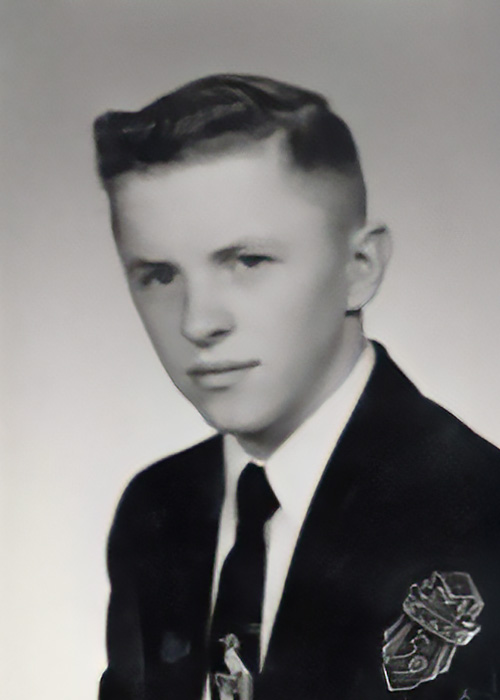
Steven Andrew Haukness was born in Maddock, North Dakota, on July 28, 1941. He graduated from the University of North Dakota with a B.A. and a law degree, and was a member of the North Dakota Bar Association. He became a Foreign Service Staff officer. Serving as a communicator at the U.S. Consulate in Da Nang, Vietnam, he was killed by the Viet Cong in Hue on January 31, 1968. He was 26 years old. His remains, which a local resident had buried in a schoolyard in the aftermath of the violence, were recovered in August 1974 and identified in March 1975. He was survived by his wife Alpha, twin sons Brent and Bradley, and his parents and three siblings. He is buried at North Viking Cemetery in Maddock, North Dakota.
[Sources: “Steven Haukness, Vietnam Casualty,” The Bismarck Tribune, Bismarck, North Dakota, April 2, 1975, Page 20, online at Newspapers.com; “Steven A. Haukness,” Findagrave.com, Memorial ID: 126495217; Ancestry.com records.]
 §
§
James C. Marshall
Killed in Tet Offensive — Vietnam 1968
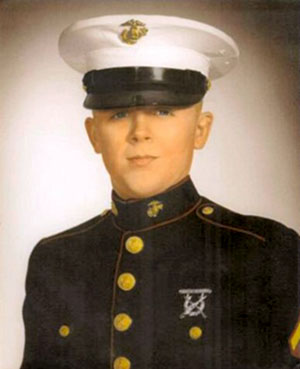
James Conrad Marshall was born in Monroeville, Alabama on July 29, 1946. He joined the U.S. Marine Corps in 1964 and trained at Parris Island before serving in administration and operations. In 1966, he was accepted into the Marine Security Guard Program and posted to the U.S. Embassy in Saigon, Vietnam.
He was shot and killed on January 31, 1968, while guarding the embassy from a Viet Cong attack during the Tet Offensive. He was the sole Marine guarding the separate one-story consulate building during the attack and was killed by a sniper. He was 21 years old.
Corporal Marshall was the first U.S. Marine to be killed while defending an American embassy, and he was posthumously awarded a Bronze Star for his heroism. A building on Marine Corps Base Quantico, the home of the USMC Embassy Training Facility, is named in his honor. He was survived by his parents and a sister. He is buried at Baptist Cemetery in Monroeville, Alabama.
[Sources: “Cpl James Conrad Marshall,” Findagrave.com, Memorial ID 66360226; https://navylog.navymemorial.org/marshall-james-9; https://embassymarine.org/page/The-Fallen; Ancestry.com records, https://www.virtualwall.org/dm/MarshallJC01a.htm.]
 §
§
Robert W. Hubbard
Killed while Trying to Escape Viet Cong — Vietnam 1968
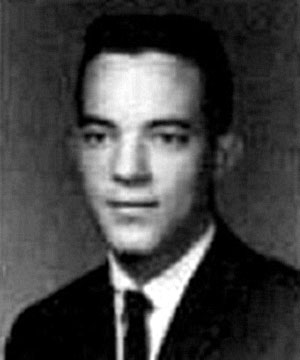
Robert Walker Hubbard was born in Auburn, Alabama on November 26, 1940. He served as a captain in the U.S. Marine Corps and, at the time of his death, an advisor with the U.S. Agency for International Development in Vietnam.
During a Viet Cong attack on the city of Hue during the Tet Offensive, Hubbard aided a small group of American civilians and soldiers by moving from shelter to shelter, foraging for food, tending to the wounded and returning enemy fire. Although he was shot and killed during this operation on February 4, 1968, he made possible the safe escape of his companions. Hubbard was 27 years old. He was survived by his parents. He is buried in Auburn Memorial Park Cemetery in Auburn, Alabama.
[Sources: Lau, Raymond R., “The 1968 Tet Offensive in Vietnam and the Seizure of Hue,” Studies in Intelligence (Vol. 61, No. 4; Extracts, December 2017); https://www.virtualwall.org/dh/HubbardRW01a.htm; “Capt. Robert Walker Hubbard,” Findagrave.com, Memorial ID: 12619319; Ancestry.com records.]
 §
§
Thomas M. Gompertz
Killed in Tet Offensive — Vietnam 1968
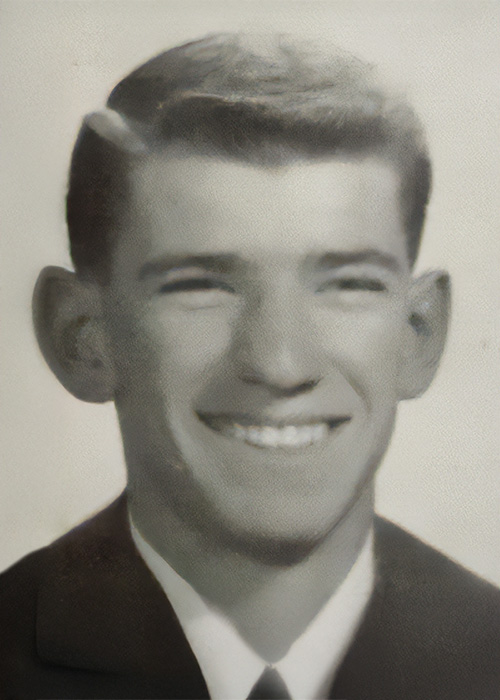
Thomas Malcolm Gompertz was born in Alameda, California, on February 12, 1941. He graduated from Stanford University in 1962 and had served for three years with the U.S. Agency for International Development as assistant representative in Hue, Vietnam, when the Tet Offensive began. Gompertz was killed on February 7, 1968, just one week before the end of his tour and his scheduled return to California to attend graduate school at the University of California at Berkeley. He was 26 years old and was survived by his parents, a sister, and grandparents.
[Sources: Lau, Raymond R., “The 1968 Tet Offensive in Vietnam and the Seizure of Hue,” Studies in Intelligence (Vol. 61, No. 4; Extracts, December 2017); “Red Offensive Claims Cousin of Modestan,” The Modesto Bee, Modesto, California, February 9, 1968, Page 2, online at Newspapers.com; “Thomas Gompertz,” The Oakland Tribune, Oakland, California, February 28, 1968, Page 22, online at Newspapers.com; “Thomas Gomperts,” Contra Costa Times, Contra Costa, California, March 1, 1968, Page 5, online at Newspapers.com; Ancestry.com records.]
 §
§
Robert R. Little
Killed in Tet Offensive — Vietnam 1968
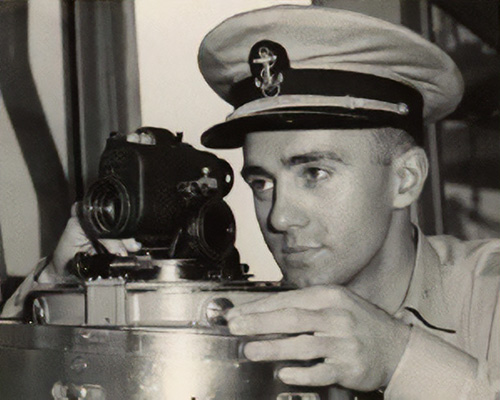
Robert Roy Little was born in New York on June 26, 1938. He served with the U.S. Agency for International Development at the U.S. Embassy in Saigon and was killed on February 7, 1968, in Hue during the Tet Offensive. He was survived by his parents and two brothers. He was 29 years old.
[Sources: “Robert Roy Little,” Findagrave.com, Memorial ID: 234782694; Ancestry.com records.]
 §
§
Jeffrey S. Lundstedt
Killed in Tet Offensive — Vietnam 1968
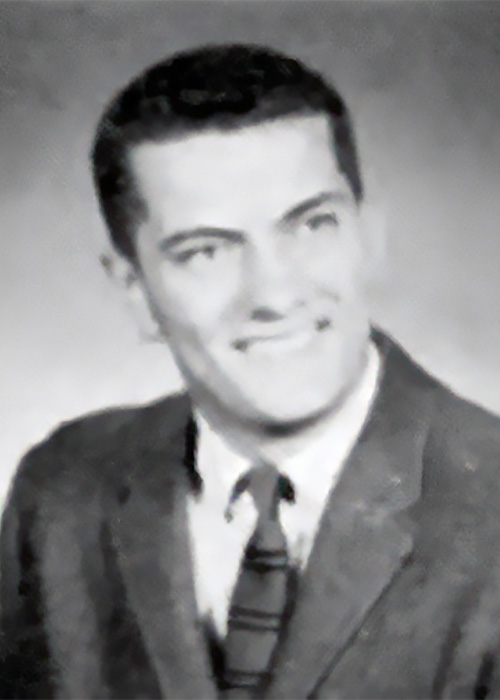
Jeffrey S. Lundstedt was born in Centerport, New York, on May 23, 1942. He served with the Peace Corps in Ecuador and Puerto Rico after his graduation from the Pratt Institute in Brooklyn, New York, where he worked as a creative artist.
Lundstedt worked for the U.S. Agency for International Development in Hue, Vietnam, where he was assigned when the Tet Offensive broke out in January 1968. He was killed on February 7, 1968, in his residence at Hue by the Viet Cong. A posthumous exhibit of his artwork was displayed at the Heckscher Museum in Huntington, New York, after his death and some of his works are still housed there.
[Sources: Lau, Raymond R., “The 1968 Tet Offensive in Vietnam and the Seizure of Hue,” Studies in Intelligence (Vol. 61, No. 4; Extracts, December 2017); Newsday (Suffolk Edition), Melville, New York, February 10, 1968, Page 11, online at Newspapers.com; “Work of Artist Killed in Vietnam on Exhibit,” Newsday (Suffolk Edition), Melville, New York, November 19, 1968, Page 77, online at Newspapers.com; Ancestry.com records.]
 §
§
Stephen H. Miller
Killed in Tet Offensive — Vietnam 1968
Stephen Harwood Miller was born in State College, Pennsylvania, on February 27, 1939. His family moved with some regularity in his childhood, as his father was a history professor who taught at private universities in Pennsylvania, Ohio, and Washington, D.C.
Stephen Miller served with the U.S. Information Service in Vietnam at the Joint U.S. Public Affairs Office. On February 7, 1968, he was bound and shot in a field behind a Catholic seminary by the Viet Cong in Hue during the Tet Offensive. Miller was survived by his wife, three children, as well as his parents and two siblings.
[Sources: “State Department Reports Deaths of Three U.S. Civilian Employees,” The Tribune, Scranton, Pennsylvania, February 20, 1968, Page 10, online at Newspapers.com; “Body of Ohio Man is Found in Hue Cemetery,” Gazette News-Current, Xenia, Ohio, February 19, 1968, Page 1, online at Newspapers.com; Lau, Raymond R., “The 1968 Tet Offensive in Vietnam and the Seizure of Hue,” Studies in Intelligence (Vol. 61, No. 4; Extracts, December 2017); Ancestry.com records.]
 §
§
Hugh C. Lobit
Shot by Sniper — Vietnam 1968
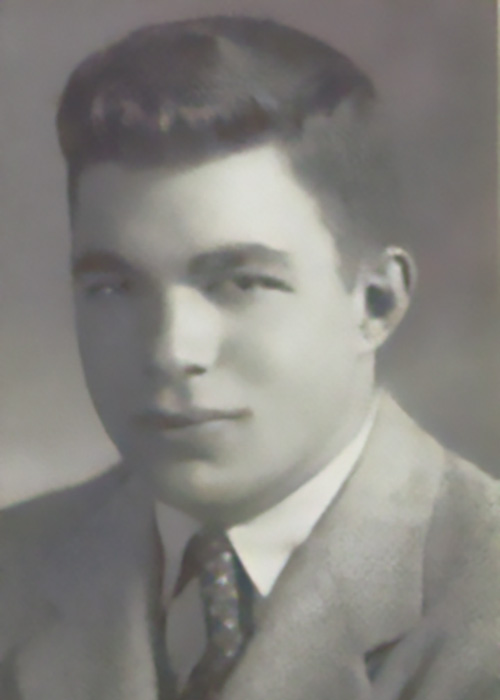
Hugh Ingram Calkins Lobit was born in Houston, Texas, on February 11, 1933, and raised in Lawrenceville, New Jersey. He married June Christensen in 1956; they had one daughter. He served with the U.S. Agency for International Development. On February 9, 1968, he was shot and killed by a sniper while escorting U.S. news correspondent in Vinh Long Province, Vietnam. He was 34 years old.
[Sources: “Death Waited in Pacified Hamlet,” Newsday (Nassau Edition), Hempstead, New York, February 13, 1968, Page 5, online at Newspapers.com; Ancestry.com records.]
 §
§
Albert A. Farkas
Pulmonary Embolism following Sniper Wound — Vietnam 1968
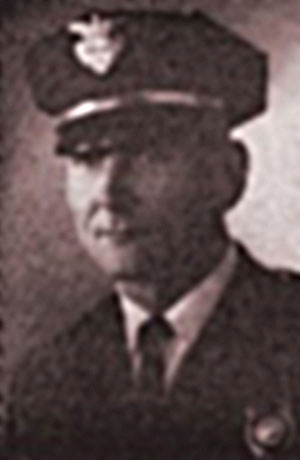
Albert Alexander Farkas was born on March 31, 1913, in Conneaut, Ohio, and attended Franklin and Marshall College. He joined the Lancaster, Pennsylvania police department in 1937 before taking a leave of absence in 1943 to join the Navy. After World War II, Farkas returned to the Lancaster Police Department, where he eventually became Chief of Police.
He retired in 1966 and served as a U.S. Agency for International Development civilian advisor to the police department in Vinh Long Province, Vietnam. He was wounded by sniper fire on February 10, 1968, and died on February 15 from a blood clot at the age of 54. Farkas is buried in Conestoga Memorial Park in Lancaster, Pennsylvania. He was survived by his mother and a brother; however, his mother died of shock just a few days after learning of her son’s death.
[Sources: “Al Farkas Dies in Saigon,” Intelligencer Journal, Lancaster, Pennsylvania, February 16, 1968, Page 1, online at Newspapers.com; “Albert A. Farkas,” Findagrave.com, Memorial ID: 187014945; Ancestry.com records.]
 §
§
Richard A. Schenk
Landmine Explosion — Vietnam 1968
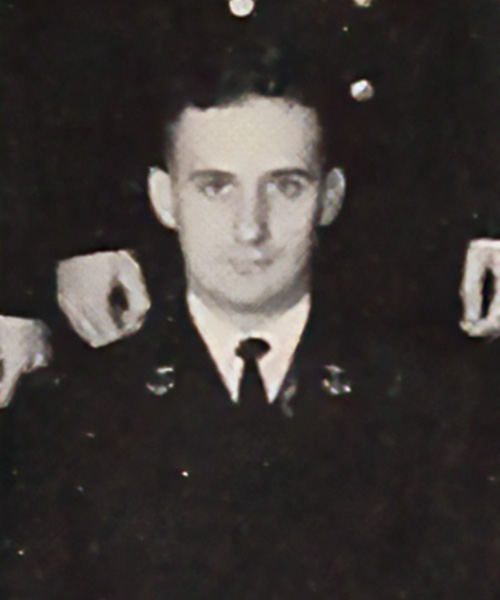
Richard Andrew Schenk was born in St. Louis, Missouri, on December 29, 1939. He served with the U.S. Agency for International Development and died on March 2, 1968, in a landmine explosion in Quang Ngai, Vietnam. He was 28 years old. He was survived by his parents and is buried at Calvary Cemetery and Mausoleum in St. Louis, Missouri.
[Sources: “Richard Andrew Schenk,” Findagrave.com; Memorial ID: 47159695; Ancestry.com records.]
 §
§
Michael Murphy
Viet Cong Ambush — Vietnam 1968
Michael Murphy was born in Cork City, Ireland, on February 9, 1928. He served in World War II with the Royal Air Force Police and worked as a London “Bobby” before becoming a lieutenant in the Malayan Constabulary. Murphy emigrated to the United States in 1954 and later joined the Alaska State Troopers, surviving the 1964 Seward earthquake while on patrol.
He served with the U.S. Agency for International Development as a police advisor with the Office of Public Safety in Vietnam. On May 23, 1968, he was killed by a missile during a Viet Cong patrol ambush in Cu Chi, Phu Cuong Province. Murphy was survived by his wife, Alice, and a sister. He is buried at Holy Cross Catholic Cemetery in Colma, California. The Michael Murphy Memorial Scholarship for Alaskan college students pursuing a career in law or law enforcement was established in his honor.
[Sources: “Viets Kill U.S. Aide,” The Times, San Mateo, California, May 29, 1968, Page 34, online at Newspapers.com; Ancestry.com records.]
 §
§
John Gordon Mein
Shot by Guatemalan rebels — Guatemala 1968
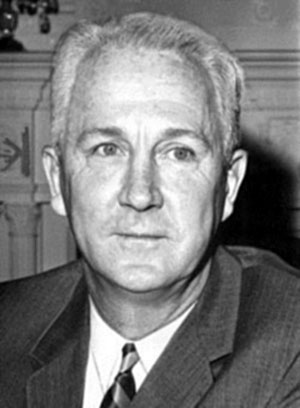
John Gordon Mein was born in Cadiz, Kentucky, on September 10, 1913, and lived in Maryland. He earned degrees from Georgetown College, George Washington University, and American University. He joined the Foreign Service in 1941 and served in Rio de Janeiro, Rome, Oslo, Jakarta, and Washington DC assignments.
He was appointed U.S. ambassador to Guatemala in 1965, during a civil war. On August 28, 1968, members of the Guatemalan Rebel Armed Forces (FAR) forced Mein out of his limousine just three blocks from the U.S. Embassy in Guatemala City while returning there from the Foreign Ministry. U.S. officials believed that FAR planned to kidnap the ambassador and demand the freedom of a recently arrested guerrilla leader in exchange for Mein’s safe release. When Mein tried to escape, however, the rebels shot him with a submachine gun. Mein was 54 years old.
He was the first U.S. ambassador assassinated in office. He was survived by his wife Elizabeth and three children. He is buried in Rock Creek Cemetery in Washington, D.C.
[Sources: “U.S. Envoy Assassinated,” Tampa Bay Times (Tampa, Florida), August 29, 1963, Page 3, online at Newspapers.com; “John Gordon Mein,” Findagrave.com, Memorial ID: 6240652; Ancestry.com records, Department of State Biographic Register, July 1967.]
 §
§
George B. Gaines
Died from Fragment Wounds — Vietnam 1969
George B. Gaines was born in Chicago, Illinois, on August 16, 1922. He served with the U.S. Agency for International Development as a civilian logistics officer in Quang Ngai Province, Vietnam, and died of fragment wounds during an attack on his residence in Quang Ngai City on February 23, 1969. He was survived by a sister.
[Source: “Pacification Officials Killed in Red Attacks,” Morning World, Monroe, Louisiana, February 24, 1969, Page 1, online at Newspapers.com; Ancestry.com records.]
 §
§
Joseph B. Smith
Landmine Explosion — Vietnam 1970
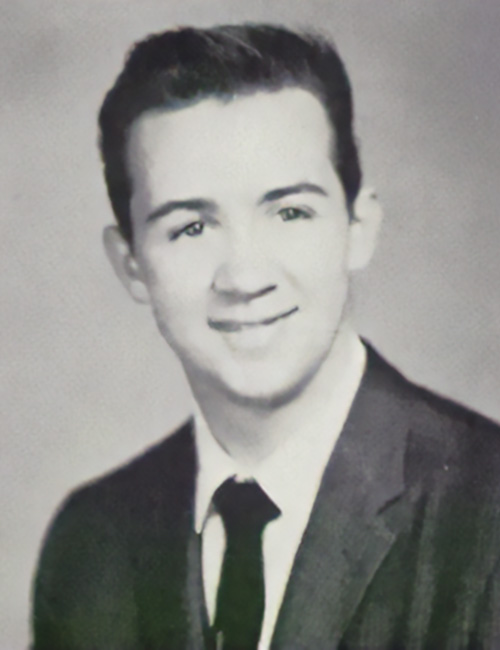
Joseph Brooks Smith was born in New York in 1942 and was raised in White Plains. He graduated from Iona College with a bachelor’s degree in economics and served in the U.S. Marine Corps rising to the rank of Captain. After leaving the military, he served in Vietnam as an assistant area development officer with the U.S. Agency for International Development.
On August 30, 1970, Smith was killed by a landmine explosion while visiting a new refugee resettlement center on Go Noi Island, Quang-Nam Province. He was 27 years old. He was survived by his wife Marilyn, his parents, and a brother and two sisters. He is buried at Gate of Heaven Cemetery in Hawthorne, New York.
[Sources: “Mine in Vietnam Kills Mamaroneck Veteran,” Mount Vernon Argus, White Plains, New York, September 2, 1970, Page 2; online at Newspapers.com; The Daily Item, Port Chester, New York, September 11, 1970, Page 6, online at Newspapers.com; “Joseph B. Smith,” Calvary and Allied Cemeteries, calvaryandalliedcemeteries.com/burial-search; Ancestry.com records.]
 §
§
Robert P. Perry
Murdered by Palestinian Terrorists — Jordan 1970
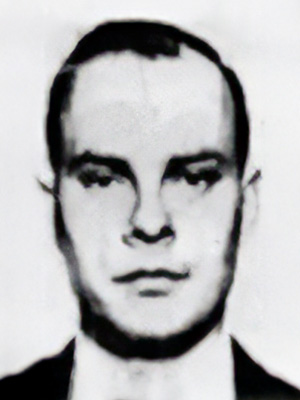
Robert P. Perry was born February 1, 1935, in Chicago and grew up in Shaker Heights, Ohio. He graduated from Yale in 1958 and obtained a master’s degree in Arabic studies from the American University in Beirut. Joining the U.S. Army, he rose to the rank of Major. He served as the assistant Army attaché at the U.S. Embassy in Beirut from 1963 to 1966 and in Amman from March 1967 until his death.
Major Perry was murdered on June 10, 1970, by a Palestinian gunman who shot him through the front door of his house after he refused to open the door. He was 35 years old. Perry was survived by his wife and three children, who were present in the home at the time of the attack, in addition to his mother and two siblings. Perry is buried at Arlington National Cemetery.
[Sources: “U.S. Envoy Slain in Jordan Uprising,” The Atlanta Constitution, Atlanta, Georgia, June 11, 1970, Page 1, online at Newspapers.com; “Maj. Robert P. Perry Rites in Arlington,” The Plain Dealer, Cleveland, Ohio, June 23, 1970, Page 20, online at Newspapers.com; “Maj. Robert P. Perry,” Findagrave.com, Memorial ID: 102362948; Ancestry.com records.]
 §
§
Dan A. Mitrione
Assassinated by Uruguayan Rebels — Uruguay 1970
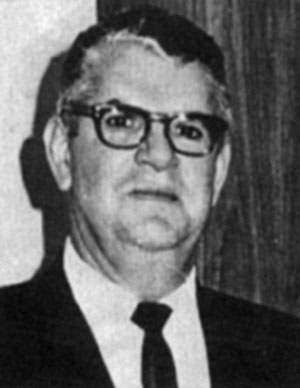
Daniel Anthony Mitrione was born in Italy on August 4, 1920. After his family emigrated to the U.S., he served as a police officer in Richmond, Indiana, rising to the position of Chief of Police. In 1960, he joined the International Cooperation Administration to teach counterinsurgency techniques and provide weapons and training for police officers and military officials in South American nations. After ICA was replaced by the U.S. Agency for International Development, Mitrione served with USAID in Brazil and then, starting in 1969, in Uruguay where he oversaw the Office of Public Safety.
On July 31, 1970, Mitrione was kidnapped by Tupamaros rebels, who shot him in the chest during the kidnapping, interrogated him, and demanded the freedom of 150 political prisoners. After the refusal of the Uruguayan government, Mitrione was shot dead in the early morning of August 10, 1970, and left in an abandoned vehicle in Montevideo. He was 50 years old. The group also kidnapped another American, a Brazilian consul, the British Ambassador, and several prominent local businessmen. Mitrione was survived by his wife Henrietta and nine children.
[Sources: “White House Condemns Uruguay Execution,” The Daily Freeman, Kingston, New York, August 10, 1970, Page 1, online at Newspapers.com; https://en.wikipedia.org/wiki/Dan_Mitrione; “Daniel Anthony ‘Dan’ Mitrione,” Findagrave.com, Memorial ID: 126576551.]
 §
§
Doris Knittle
Murdered by Servant — Afghanistan 1970
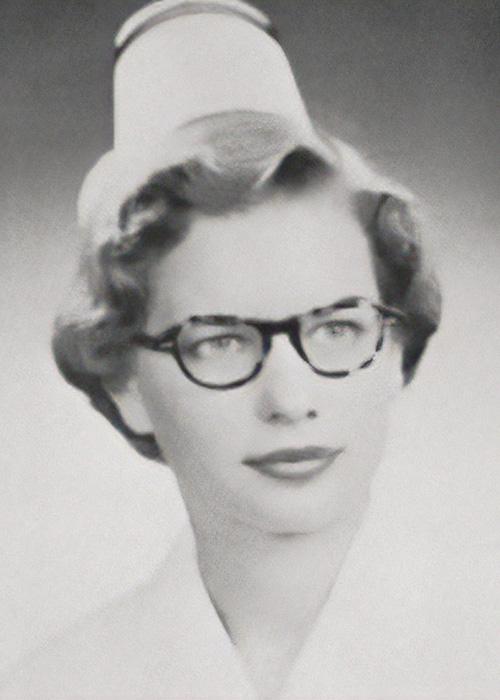
Doris Grace Knittle was born in Lancaster, Pennsylvania, in 1935. A 1956 graduate of Temple University's School of Nursing, she was part of the university hospital staff for eight years and later went overseas to work as a nurse in Algiers for the Medical International Cooperation Organization (MEDICO) under the CARE program in Algeria.
In 1967, Knittle joined the Foreign Service and began working as supervisor of the dispensary at the U.S. Embassy in Kabul. She was murdered on August 25, 1970, at age 35 during a robbery by a night watchman who guarded her house and another individual who suffocated her. She was survived by her mother and a brother. She is buried in Manheim Fairview Cemetery in Manheim, Pennsylvania.
[Sources: “2 Arrested in Nurse’s Slaying,” Lancaster New Era, Lancaster, Pennsylvania, September 7, 1970, Page 28, online at Newspapers.com; “Doris G. Knittle,” Findagrave.com, Memorial ID 154138460; Ancestry.com records.]
 §
§
Howard V. Funk, Jr.
Automobile Accident — Kenya 1971
Howard “Hap” Vern Funk, Jr., was born in Bronxville, New York, on October 2, 1929. He graduated from Allegheny College and received an M.A. from the University of Missouri in 1958. He served in the U.S. Army in Korea between 1951 and 1954. Funk served as a Foreign Service officer starting in 1957 serving in Kampala and Accra and as special assistant to Ambassador W. Averell Harriman during the Vietnam Peace talks in Paris in 1968.
He was serving as first secretary in the political section at the U.S. Embassy in Nairobi, Kenya when he died in a head-on automobile accident on April 9, 1971, at Birongo Keroka, Kenya, while driving to distribute books to schools. He was 41 years old. He was survived by his wife, two sons, and two siblings and is buried in Rock Creek Cemetery in Washington, D.C.
[Sources: “H.V. Funk Jr Dies; Diplomat in Africa,” Mount Vernon Argus, White Plains, New York, April 12, 1971, Page 16, online at Newspapers.com; “Kena Accident Kills U.S. Official,” Miami Herald, Miami, Florida, April 11, 1971, Page 157, online at Newspapers.com; Foreign Service Journal, June 1971, Page 57; Department of State Biographic Register, July 1970; “Howard V. Funk Jr.,” Findagrave.com, Memorial ID: 44383121; Ancestry.com records.]
 §
§
Donald Leahy
Murdered – Equatorial Guinea 1971
Donald Joseph Leahy was born on June 27, 1924. He graduated from high school in Chicago in 1942, and enlisted in the U.S. Army in 1943, becoming a civilian U.S. government employee in 1945. He worked in administration at Spandau Prison in Berlin, Germany. Joining the State Department as a Foreign Service staff officer, he served in Moscow, Quito, La Paz, and Johannesburg prior to his assignment as the administrative assistant at the U.S. Embassy in Santa Isabel (now Malabo), Equatorial Guinea.
The only other American at post was Principal Officer Alfred Erdos. On August 30, 1971, Erdos stabbed Leahy to death in what appears to have been a bout of temporary insanity. Erdos was returned to the United States where a court found him guilty of voluntary manslaughter and sentenced him to 10 years in prison. Leahy was 47 years old. He was survived by his wife, a daughter, and two siblings. He is buried at Center Cemetery in South Windsor, Connecticut.
[Sources: Harford Courant, Hartford, Connecticut, September 10, 1971, Page 2, online at Newspapers.com; “Funeral Rites for Envoy Held in S. Windsor,” Record-Journal, Meriden, Connecticut, September 10, 1971, Page 18, online at Newspapers.com; Foreign Service Journal, October 1971, Page 49; “A Foreign Service Murder,” Len Shurtleff, Foreign Service Journal, October 2007, Pages 51–55; “A Look Back at the Erdos Case,” Lewis Hoffacker and “Murder in an Embassy, Parts I and II” online at adst.org; “Donald J Leahy,” Findagrave.com, Memorial ID: 16280885; Ancestry.com records.]
 §
§
Charles W. Turberville
Killed in Bomb Blast — Cambodia 1971
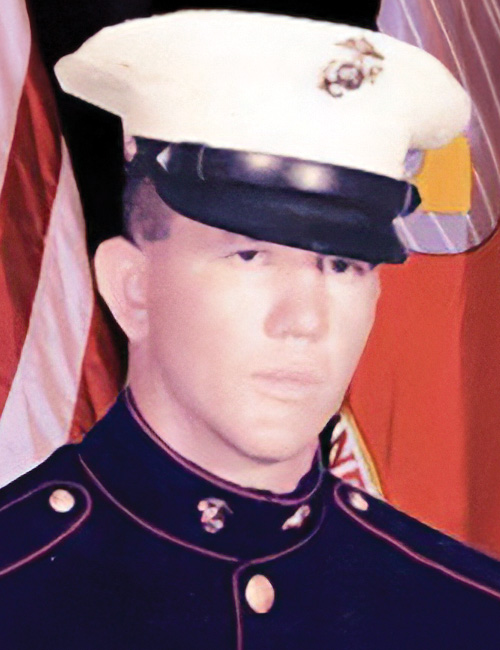
Charles Wayne Turberville was born on July 17, 1950, in Finchburg, Alabama. A Marine Security Guard, Sergeant Turberville was one of two Americans killed on September 26, 1971, when Khmer Rouge terrorists threw two homemade grenades at U.S. Embassy personnel and dependents playing a softball game in Phnom Penh, Cambodia. Survived by his mother and siblings, he was 21 years old. Turberville is buried at Bryant Cemetery in Finchburg, Alabama. The Sgt Charles Wayne Turberville MSG, USMC Memorial Highway in Monroe County, Alabama, is named in his honor.
[Sources: “Sgt Charles Wayne Turberville,” Findagrave.com, Memorial ID: 31462752; https://navylog.navymemorial.org/turberville-charles-0; https://embassymarine.org/page/The-Fallen; Ancestry.com records.]
 §
§
Eugene F. Sullivan
Black Water Fever — Ethiopia 1972
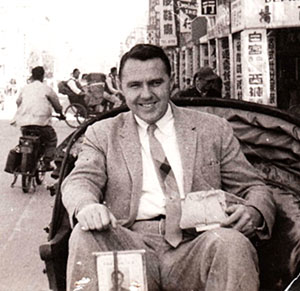
Eugene Francis Sullivan was born in Greenfield, Massachusetts, on July 12, 1924. He served in the U.S. Navy in World War II after attending the Navy College Training Program at Tufts University. The Navy later sent him to the University of Colorado Navy Chinese Language School after recognizing his linguistic talents. Sullivan began work at the Navy Department in Washington, D.C. as a Chinese translator. He graduated from The George Washington University with a degree in chemical engineering in 1949 and later worked for the Central Intelligence Agency and National Security Agency in Seoul.
Sullivan returned to Seoul with U.S. Agency for International Development predecessor agencies OEC and U.S. Operations Mission working as a chemical engineer. He then worked for USAID in Taiwan and Manila as an industry officer, in Thailand as a private development officer and in Ethiopia as a private enterprise officer. He caught a rare form of malaria, black water fever, at the latter post. He died of the disease in a hospital in Asmara, Eritrea, on January 21, 1972, at the age of 47. He was fluent in 13 languages. Sullivan was survived by his wife and three sons. He is buried at the National Cemetery of the Pacific in Honolulu, Hawaii.
[Sources: “Eugene Francis Sullivan,” Findagrave.com, Memorial ID: 3793579; Ancestry.com records.]
 §
§
John Paul Vann
Helicopter Crash — Vietnam 1972
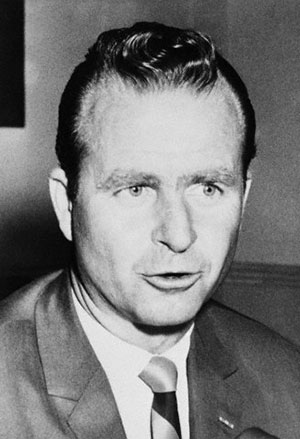
John Paul Vann was born in Norfolk, Virginia, on July 2, 1924. He served in the Army Air Corps during WWII and later as a lieutenant colonel in the U.S. Army, working in Korea and Japan as a logistics officer and later leading the transportation of the 25th Infantry Division to Korea, where he and his unit guarded the Pusan Perimeter. Vann later received an M.B.A. from Syracuse University and returned to the army as a civilian advisor in South Vietnam, earning the Distinguished Flying Cross for his bravery.
He returned to Vietnam with the U.S. Agency for International Development in 1965, becoming a deputy for Civil Operations and Revolutionary Development Support (CORDS). He helped to train and encourage Army of the Republic of Vietnam soldiers and later, as senior American advisor in the II Corps Military Region, became the first U.S. civilian to command U.S. regular troops in combat.
Vann died during a helicopter crash on June 9, 1972. He is buried in Arlington National Cemetery and was posthumously awarded the Presidential Medal of Freedom and the Distinguished Service Cross (the only civilian so honored in the Vietnam War). He was survived by five children. Journalist Neil Sheehan wrote the book “A Bright Shining Lie: John Paul Vann and America in Vietnam in 1988, which received a Pulitzer Prize for Nonfiction. The book was adapted to a 1998 film.
[Sources: https://en.wikipedia.org/wiki/John_Paul_Vann; “John Paul Van: Portrait of an Activist,” Lacy Wright, Foreign Service Journal, March 1973, Pages 15–16, 30–32; Ancestry.com records; “Col John Paul Vann,” Findagrave.com, Memorial ID: 7500964.]
 §
§
Joseph Gregory Fandino
Unknown — Vietnam 1972
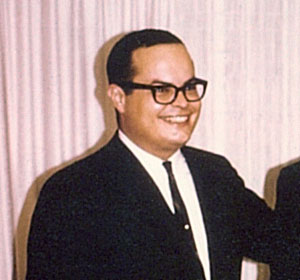
Joseph “Joe” Gregory Fandino was born in New York City on October 2, 1932, to parents from Cuba and Puerto Rico. He briefly attended Iona College and earned a degree from Columbia University before joining the U.S. Air Force during the Korean War.
Fandino later became one of the first Hispanic U.S. Foreign Service officers. Abroad, he served in Santo Domingo, followed by Ciudad Trujillo, also in the Dominican Republic. He later served in Ottawa, Bilbao, and Madrid. Domestically, he worked with Cuban refugees and visiting dignitaries at the Miami Reception Center and served as the Cuba desk officer at the Department of State.
In September 1971, he was assigned to the U.S. Agency for International Development’s Civil Operations and Revolutionary and Development Support (CORDS) program in Vietnam. He was an ethnic affairs officer stationed in Xuan Loc, Long Khanh province, and then at Bien Hoa Air Force Base outside of Saigon. He died there on June 27, 1972, under unknown circumstances. He was survived by his spouse Cindy Coleman and two children. He was 39 years old.
Note: His widow stated that the State Department in 1972 told her the cause of death was “in the line of duty” but did not specify the circumstances. The person who nominated him for the plaque 40 years later gave no information on the cause of death. The AFSA Governing Board approved his inscription in 2013 on the basis of a death in an active war zone.
[Source: Foreign Service Journal, June 2013, Page 48; “Honoring a Hero,” The Mining Journal, Marquette, Michigan, May 16, 2013; “There are Places You Cannot Go,” Brent Crane, The Atavist Magazine, Number 93, July 2019; AFSA Awards and Plaques Committee records; Ancestry.com records.]
 §
§
Rudolph Kaiser
Viet Cong Ambush — Vietnam 1972
Rudolph Kaiser was born on September 17, 1919, in Sheboygan, Wisconsin and lived in Colorado Springs, Colorado. A World War II U.S. Army veteran, he served as a U.S. Agency for International Development senior advisor in Go Cong Province, Vietnam, and died on July 27, 1972, in a Viet Cong ambush while accompanying South Vietnamese militia forces in the Mekong Delta. He was 52 years old. Kaiser was survived by his wife, five children, two grandchildren, and four siblings. He is buried at Arlington National Cemetery.
[Sources: “Kaiser Rites Here Friday,” The Sheboygan Press, Sheboygan, Wisconsin, August 2, 1972, Page 10, online at Newspapers.com; The Reporter, Fond du Lac, Wisconsin, July 29, 1972, Page 16, online at Newspapers.com; “Maj Rudolph Kaiser,” Findagrave.com, Memorial ID 48767113; Ancestry.com records.]
 §
§
Luther A. McLendon, Jr.
Plane Crash — Vietnam 1972
Luther Alexander McLendon, Jr., was born in Sumter, South Carolina, on January 12, 1919. He served in the U.S. Marine Corps, rising to the rank of captain. Later serving with the U.S. Agency for International Development as a relief and rehabilitation advisor in Vietnam, he died on December 1, 1972, while returning from a refugee camp aboard a plane that crashed 500 yards short of the runway at Tuy Hoa Air Base, 235 miles northeast of Saigon. Killed in the same crash was Bruce O. Bailey, with three additional Americans injured. McLendon was 53 years old. He is buried at Arlington National Cemetery.
[Sources: “Crash Kills Viet Brass, Americans,” The Cincinnati Enquirer, Cincinnati, Ohio, December 2, 1972, Page 2, online at Newspapers.com; Ancestry.com records.]
 §
§
Bruce O’Bailey
Plane Crash — Kenya 1972
Bruce Oliver Bailey was born in Seattle, Washington, on March 20, 1929. Bailey served in the U.S. Air Force from 1950 to 1953 and was discharged as a captain. He was a teacher at the American Independent School in Iran from 1956–1957, and worked as an assistant director of the International House at the University of California at Berkeley, serving as a counselor and foreign student advisor. He received his B.A. and M.A. degrees from the same institution in 1959.
After his time in Berkeley, he served as a U.S. Agency for International Development social welfare advisor and died on December 1, 1972, while returning from a refugee camp aboard a plane that crashed 500 yards short of the runway at Tuy Hoa Air Base, 235 miles northeast of Saigon. Killed in the same crash was Luther A. McLendon Jr., with three additional Americans injured. He was 43 years old. He was survived by a sister. Bailey is buried at El Camino Memorial Park in San Diego, California.
[Sources: “Ex-UC Official Killed,” The Berkeley Gazette, Berkeley, California, December 16, 1972, Page 17, online at Newspapers.com; “Crash Kills Viet Brass, Americans,” The Cincinnati Enquirer, Cincinnati, Ohio, December 2, 1972, Page 2, online at Newspapers.com; “Bruce O. Bailey,” Findagrave.com, Memorial ID: 25700256; Ancestry.com records.]
 §
§
Rose Marie Orlich
Killed in an Earthquake — Nicaragua 1972
Rose Marie Orlich was born in Philadelphia, Pennsylvania on April 4, 1937. She joined the Foreign Service in 1959. In 1970 she transferred to Nicaragua, where served as the Ambassador’s secretary at U.S. Embassy Managua. On December 23, 1972, shortly after midnight, a massive earthquake hit Managua killing 4,000 to 11,000, injuring 20,000, and leaving 300,000 homeless. The U.S. embassy and adjacent staff apartments collapsed. Orlich died trapped inside her apartment on the embassy compound. Embassy personnel converged on the scene to dig out several other mission personnel trapped in the rubble. She was survived by her mother and two sisters. She is buried at Holy Redeemer Cemetery in Philadelphia, Pennsylvania.
[Sources: “Quake Victim Brought Home,” The Philadelphia Inquirer, Philadelphia, Pennsylvania, December 26, 1972, Page 2, online at Newspapers.com; The Philadelphia Inquirer, Philadelphia, Pennsylvania, December 27, 1972, Page 18, online at Newspapers.com; “The Managua Earthquake of 1972,” Stuart Lippe, Foreign Service Journal, March 2008, Page 84; “Rosemarie Orlich,” Findagrave.com, Memorial ID 124839251; Ancestry.com records.]
 §
§
Cleo Allen Noel, Jr.
Assassinated by Palestinian Terrorists — Sudan 1973
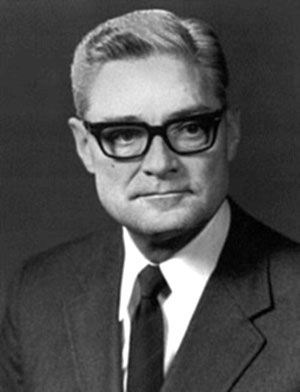
Cleo Allen Noel, Jr., was born in Oklahoma City, Oklahoma, on August 6, 1918, and grew up in Moberly, Missouri. He received a bachelor’s and a master’s degree in history from the University of Missouri. Noel briefly taught American history at the University of Missouri before joining the U.S. Navy in June of 1941. He served as a gunnery officer aboard merchant vessels throughout the Pacific Ocean and the Persian Gulf, retiring after WWII with the rank of Lieutenant Commander. Noel later earned his Ph.D. from Harvard, married a Foreign Service employee and joined the Foreign Service himself.
He served at consulates in Italy, Saudi Arabia, France, and Lebanon and learned Arabic. He was regarded as a talented expert on the Middle East. During an earlier assignment in Khartoum, Noel remained in Khartoum for two years as part of the American section of the Dutch embassy, which served as the protecting power after Sudan broke relations with the United States during the 1967 Arab-Israeli War.
Just days after returning to Khartoum as U.S. ambassador to Sudan, Noel and nine others, including outgoing charge d’affaires George Curtis Moore, were kidnapped by militants from the Black September faction of the Palestinian Liberation Organization, who stormed the U.S. Embassy in Khartoum on March 1, 1973. He was shot by the terrorists one day later. He was 54 years old. Noel was survived by his wife and two children. He is buried at Arlington National Cemetery alongside George Curtis Moore.
In March 1973, AFSA President Thomas D. Boyatt organized a ceremony honoring him and George Curtis Moore in front of the AFSA Memorial Plaque in the C Street Lobby of the Department of State. President Richard M. Nixon spoke at the event which turned out to be the first of annual ceremonies held by AFSA at the Memorial Plaques ever since.
[Sources: “Profiles: The 2 Slain American Diplomats,” The Boston Globe, Boston, Massachusetts, March 3, 1973, Page 2, online at Newspapers.com; Foreign Service Journal, April 1973, front cover (photos) and inside front cover; “Cleo Allen Noel Jr.,” Findagrave.com, Memorial ID: 5994457; Ancestry.com records.]
 §
§
George Curtis Moore
Assassinated by Palestinian Terrorists — Sudan 1973
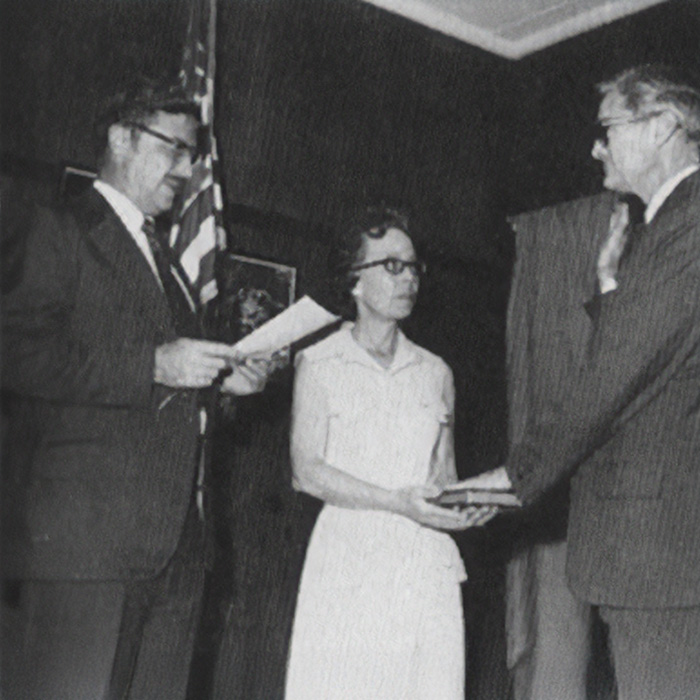
George Curtis Moore was born in California on September 7, 1925. He joined the Department of State in 1950, and served in Frankfurt, Munich, Cairo, Beirut, Benghazi, and Tripoli. He had a master’s degree in international relations and attended the National War College. In 1973, he was the Deputy Chief of Mission and outgoing charge d’affaires ad interim at the U.S. Embassy in Khartoum, Sudan. He was scheduled to depart the country within just a few days after greeting Ambassador Cleo Allen Noel, Jr., who had just arrived in country.
On March 1, 1973, Moore and nine others, including Ambassador Noel, were kidnapped by militants from the Black September faction of the Palestinian Liberation Organization, who stormed the U.S. Embassy in Khartoum. He was shot by the terrorists one day later. He was 47 years old. Moore was survived by his wife and two children. Moore is buried at Arlington National Cemetery alongside Ambassador Noel.
In March 1973, AFSA President Thomas D. Boyatt organized a ceremony honoring Ambassador Noel and George Curtis Moore in front of the AFSA Memorial Plaque in the C Street Lobby of the Department of State. President Richard M. Nixon spoke at the event which turned out to be the first of annual ceremonies held by AFSA at the Memorial Plaques ever since.
[Sources: “Profiles: The 2 Slain American Diplomats,” The Boston Globe, Boston, Massachusetts, March 3, 1973, Page 2, online at Newspapers.com; Foreign Service Journal, April 1973, front cover (photos) and inside front cover; “George Curtis Moore,” Findagrave.com, Memorial ID: 14644639; Ancestry.com records.]
 §
§
John S. Patterson
Kidnapped and Murdered — Mexico 1974
John Svensson Patterson was born on January 2, 1943, in Philadelphia, Pennsylvania. He served as U.S. vice consul in Hermosillo, Mexico. He was kidnapped on March 22, 1974, by criminals who conspired with two Americans who plotted to kidnap a U.S. diplomat for $500,000 ransom. Patterson was found dead in a dry riverbed the desert near Hermosillo in July of that year. He was 31 years old. He was survived by his wife, Andra, a five year-old daughter, and his mother. Patterson is buried in Rock Creek Cemetery in Washington, D.C.
[Sources: Arizona Daily Star, Tucson, Arizona, September 6, 1974, Page 10, online at Newspapers.com; “Former War Hero Pleads Guilty in Kidnaping Case,” The Los Angeles Times, Los Angeles, California, March 8, 1975, Page 22, online at Newspapers.com; ““Apparently I have been kidnapped” -- The Death of a Vice Consul,” www.adst.org; “John Svensson Patterson,” Findagrave.com, Memorial ID: 443830048; Ancestry.com records.]
 §
§
Rodger P. Davies
Shot by Sniper — Cyprus 1974
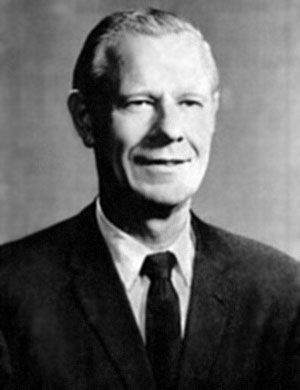
Rodger Paul Davies was born in Berkley, California in 1921. A WWII veteran, he entered the Foreign Service in 1946 and served at Jidda, Damascus, Benghazi and Tripoli, Baghdad and as director of the Bureau of Near Eastern Affairs and deputy assistant secretary of state for Near Eastern and South Asian Affairs.
He was appointed U.S. ambassador to Cyprus in July 1974. He was killed by a sniper during an anti-American demonstration outside the U.S. Embassy in Nicosia on August 19, 1974. The murderer was allegedly a gunman from EOKA-B, a Greek Cypriot paramilitary terrorist organization responsible for a coup d’état that took place one month before. He was survived by daughter Ann Dana Davies, son John Davies, and his mother.
[Source: Foreign Service Journal, October 1974, Page 64.]
 §
§
Richard A. Coulter
Automobile Accident — Iran 1974
Richard Arthur Coulter was born in Ashland, Oregon, on January 19, 1945. He graduated from the University of Oregon and attended Lutheran seminary in Springfield, Illinois, before joining the Foreign Service. He served his first tour in The Hague. Serving as second secretary in the commercial section at the U.S. Embassy in Tehran he died on July 1, 1974, in an automobile accident in Mahmudabad, Iran, when he was ejected from the passenger side of an official car during a crash outside a Caspian Sea resort. He was 29 years old. There is a cenotaph in his memory at Zion Lutheran Church Cemetery in Terra Bella, California. Coulter was survived by his wife, two children, his parents, and two siblings.
[Sources: “Rite held for envoy secretary,” The Bakersfield Californian, Bakersfield, California, July 8, 1974, Page 29, online at Newspapers.com; “Richard Arthur Coulter,” Findagrave.com, Memorial ID: 23712166; Ancestry.com records.]
 §
§
Thomas Olmsted
Pancreatitis — Cambodia 1975
Thomas Franklin Olmsted Jr. was born on April 17, 1929, in New York. He served in the U.S. Army from 1951 to 1954 and then received degrees from Syracuse University and Harvard University. He joined the State Department Foreign Service in 1955, serving in Rangoon, Seoul, and Washington. While serving as the U.S. Agency for International Development deputy director in Phnom Penh, Cambodia, he died in Bangkok, Thailand, on February 8, 1975, of a sudden attack of acute pancreatitis. He was 45. Olmsted is buried in Garfield Cemetery in Stephentown, New York. He was survived by his wife, his parents, and two siblings.
[Sources: “Thomas F. Olmsted, U.S. AID official,” The Berkshire Eagle, Pittsfield, Massachusetts, March 8, 1975, Page 9, online at Newspapers.com; State Department Biographic Register, July 1974; “Thomas Franklin Olmsted Jr,” Findagrave.com, Memorial ID: 54713726; Ancestry.com records, Office of the Historian records.]
 §
§
John Patrick Egan
Kidnapped and Killed by Insurgents — Argentina 1975

John Patrick Egan was born September 7, 1912, in Perma, Montana. Egan was a retired Kaiser Aluminum Co executive to had lived in Latin America since 1955. Appointed as U.S. consular agent in Cordoba, Argentina, in 1973, he was kidnapped by the Montoneros, a leftist terrorist group which demanded the release of four political prisoners in exchange for Egan’s safety. The prisoners were already dead, however, and the militants executed Egan on February 28, 1975. His body was found wrapped in the Montoneros flag. He was 62 years old. Egan was survived by his wife and a daughter.
[Sources: “John Patrick Egan,” Rocky Munt Telegram, Rocky Mount, North Carolina, March 2, 1975, Page 12, online at Newspapers.com; Ancestry.com records.]
 §
§
Charles McMahon
Rocket Attack — Vietnam 1975
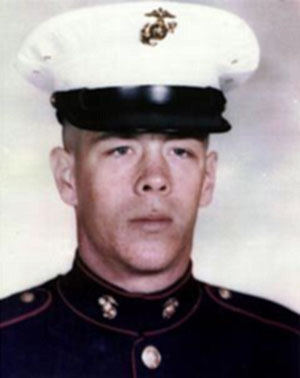
Charles McMahon was born in Woburn, Massachusetts on May 10, 1953. He served as U.S. Marine Security Guard at the U.S. Embassy in Saigon. McMahon was killed by a rocket attack on April 29, 1975 – only two weeks after his arrival in Vietnam -- while defending the defense attaché building on Tan Son Nhut Airbase. He was 21 years old. Corporal McMahon and Lance Corporal Darwin L. Judge who died with him when a rocket hit Post 1 were the last two American servicemembers killed in action in the Vietnam War.
During the fall of Saigon, McMahon’s body and that of Darwin Judge were left at the Seventh Day Adventist Hospital in Saigon. They were repatriated to the U.S. in February 1976 through the efforts of Senator Edward Kennedy. McMahon is buried at Woodbrook Cemetery in Woburn, Massachusetts. He was survived by his parents and two younger brothers.
[Sources: “Last 2 Americans Died Only Hours Before Evacuation,” The Columbia Record, Columbia, South Carolina, April 30, 1975, Page 10, online at Newspapers.com; embassymarine.org; navylog.navymemorial.org; “Corp Charles McMahon Jr,” Findagrave.com, Memorial ID: 10373180; Ancestry.com records.]
 §
§
Darwin L. Judge
Rocket Attack — Vietnam 1975
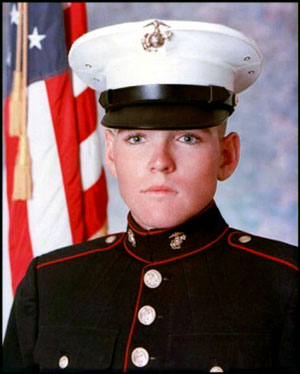
Darwin Lee Judge was born in Garwin, Iowa on February 16, 1956, and grew up in Marshalltown, Iowa. Active in Cub Scouts and Boy Scouts, he achieved the rank of Eagle Scout. He joined the U.S. Marine Corps in 1974 and was assigned as a Marine Security Guard to U.S. Embassy Saigon in March 1974. Lance Corporal Judge was killed by a rocket attack on April 29, 1975, while defending the defense attaché building on Tan Son Nhut Airbase. He was 19 years old. He and Corporal Charles McMahon who died with him when a rocket hit Post 1 were the last two American servicemembers killed in action in the Vietnam War.
During the fall of Saigon, Judge’s body and that of Charles McMahon were left at the Seventh Day Adventist Hospital in Saigon. They were repatriated to the U.S. in February 1976 through the efforts of Senator Edward Kennedy. Judge was the youngest of three children and was survived by his parents. He is buried at Rose Hill Memorial Gardens Cemetery in Marshalltown, Iowa.
[Sources: “Last 2 Americans Died Only Hours Before Evacuation,” The Columbia Record, Columbia, South Carolina, April 30, 1975, Page 10, online at Newspapers.com; embassymarine.org; navylog.navymemorial.org; “LCpl Darwin Lee Judge,” Findagrave.com, Memorial ID: 16871871; Ancestry.com records.]
 §
§
Edward R. Cheney
Plane Crash — Philippines 1976
Edward Rice Cheney was born in Lacrosse, Wisconsin, on July 1, 1927. From 1944 to 1947, Cheney served in the U.S. Army; in 1949 he was commissioned second lieutenant in the U.S. Air Force. He graduated from Harvard University in 1949 and received a master’s degree there in 1951. Cheney joined the Foreign Service in 1952 and served in Panang (Malaysia), The Hague, Washington, Nicaragua, Bombay (now Mumbai), and Lima.
His final assignment was as chief of the Economic Section at the U.S. Embassy in Manila, Philippines. On September 13, 1976, his plane crashed near Manila during a tropical storm enroute to inspect the Bicol River basin project in Naga City. He and seven others were found dead on September 24. Cheney was 49 years old. He was survived by his wife Sally Leavitt, two daughters, two sons, and a brother. He is buried at Winchester National Cemetery in Winchester, Virginia.
[Sources: “Edward Cheney, at 49; in the Foreign Service,” The Boston Globe, Boston, Massachusetts, October 4, 1976, Page 27, online at Newspapers.com; State Department Biographic Register, July 1974; “Edward Rice Cheney,” Findagrave.com, Memorial ID: 143425319; Ancestry.com records.]
 §
§
Garnett A. Zimmerly
Plane Crash — Philippines 1976
Garnett Allan Zimmerly was born in Hope, Arkansas, on December 21, 1928. He served with the U.S. Navy in WWII and attended the University of Missouri. He joined the U.S. Agency for International Development’s precursor agency International Cooperation Administration in 1958. Zimmerly served in USAID missions in East Asia in the early 1970s.
His final assignment was as USAID mission director in the Philippines, where he arrived in August 1975. On September 13, 1976, his plane crashed near Manila during a tropical storm enroute to inspect the Bicol River basin project in Naga City. He and seven others were found dead on September 24. He was 47 years old. He is buried at Winchester National Cemetery in Winchester, Virginia.
[Sources: “Garnett Zimmerly is Believed Lost in Philippine Air Crash,” The Belleville Telescope, Belleville, Kansas, September 16, 1976, Page 1, online at Newspapers.com; State Department Biographic Register, July 1974; “Garnett R. Zimmerly,” Findagrave.com, Memorial ID: 130399409; Ancestry.com records.]
 §
§
Francis E. Meloy, Jr.
Assassinated by Terrorists — Beirut, Lebanon 1976
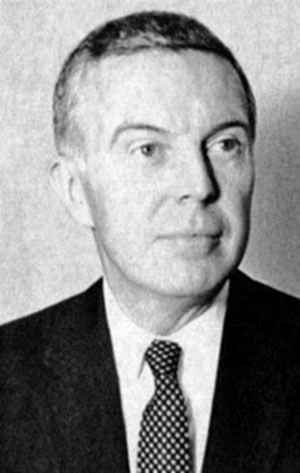
Francis Edward Meloy, Jr., was born in Washington, D.C. on March 28, 1917. He received degrees from American University and Yale University and served with the U.S. Navy in World War II. Joining the State Department Foreign Service in 1946, he served in Paris, Saigon, London, and Rome. He then served as U.S. ambassador to the Dominican Republic, Guatemala, and Lebanon.
Just five weeks after his arrival in Beirut, Ambassador Meloy, economic counselor Robert O. Waring, and their driver Zuhair Mohammed Moghrabi were kidnapped on June 16, 1976, by the Popular Front for the Liberation of Palestine while on their way to meet the new President of Lebanon, Elias Sarkis. Their bodies were found later that day in west Beirut. Ambassador Meloy was 59 years old. He is buried at Rock Creek Cemetery in Washington, D.C.
[Sources: “U.S. envoy, 2 others killed in Lebanon,” Star-Gazette, Elmira, New York, June 17, 1976, Page 1, online at Newspapers.com; State Department Biographic Register, July 1974; “Francis Edward Meloy Jr,” Findagrave.com, Memorial ID: 5995763; Ancestry.com records.]
 §
§
Robert O. Waring
Assassinated by Terrorists — Beirut, Lebanon 1976
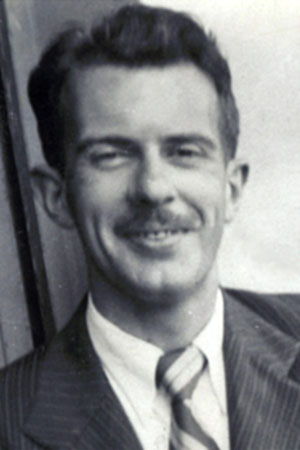
Robert Olaf Waring was born in Long Island City, New York, on November 26, 1919. He attended Fordham University. He served as a civilian with the Department of War during World War II. He joined the State Department Foreign Service in 1944 and served in Rabat, Athens, Berlin, London, and Vienna.
Serving in Beirut as U.S. economic counselor, he accompanied U.S. ambassador to Lebanon Francis E. Meloy, Jr. to meet the new President of Lebanon, Elias Sarkis. While enroute, they were kidnapped along with their driver Zuhair Mohammed Moghrabi on June 16, 1976, by the Popular Front for the Liberation of Palestine. Their bodies were found later that day in west Beirut. He was 56 years old. Waring is buried in Arlington National Cemetery and honored on a plaque at the U.S. Embassy in Beirut. Waring was survived by his wife Irene Pollak and four children.
[Sources: “U.S. envoy, 2 others killed in Lebanon,” Star-Gazette, Elmira, New York, June 17, 1976, Page 1, online at Newspapers.com; State Department Biographic Register, July 1974; “Robert Olaf Waring” Findagrave.com, Memorial ID: 40769697; Ancestry.com records.]
 §
§
Jerry V. Cook
Automobile Accident — Madagascar 1978
Jerry Von Cook was born on November 1, 1943, in Cambridge, Massachusetts, and graduated from Kansas State University. He was an assistant instructor in economics at the University of Texas from 1968 to 1972. He joined the Foreign Service in November 1975. Serving as the Economic/Commercial officer in Antananarivo, Madagascar, he was killed in a car accident about 60 kilometers west of the capital on December 6, 1978, while riding as a passenger in a Land Rover. The defense attaché, who was driving, drove around a corner when a large truck came from the other direction and struck their vehicle head-on. The defense attaché was badly injured and permanently disabled in the accident. Cook was 35 years old and was survived by his parents, two sisters, and a brother. He is buried in Stafford Cemetery in Stafford, Kansas.
[Sources: “Madagascar (Samuel Vick Smith),” Readers (oral histories), adst.org, page 58; Department of State Newsletter, January 1979, Page 76; Findagrave.com, Memorial ID: 89603702.]
 §
§
Adolph Dubs
Kidnapped and Killed by Terrorists — Kabul, Afghanistan 1979
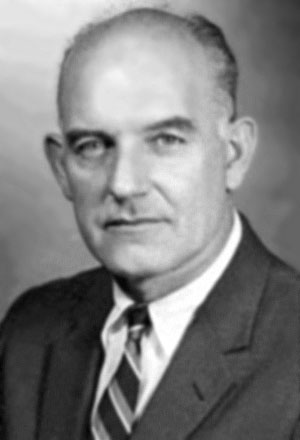
Adolph “Spike” Dubs was born in Chicago, Illinois on August 4, 1920. He graduated from Beloit College and served in the U.S. Navy during World War II before entering the Foreign Service in 1949. He served in Germany, Liberia, Canada, Yugoslavia and, as an expert on the Soviet Union, at the U.S. Embassy in Moscow as charge d’affaires.
Dubs was named U.S. ambassador to Afghanistan in 1978, soon after a coup d’état which gave power to the Soviet-aligned Khalq faction. On February 14, 1979, Dubs was kidnapped by four armed militants posing as police and held captive in Room 117 in the Kabul hotel. The militants allegedly demanded the release of multiple political prisoners in exchange for the ambassador’s safety, although their true intentions were never explained.
Against the wishes of the U.S. government, which proposed peaceful negotiations, the Afghan police stormed the hotel room and began a violent firefight. Only one minute later, Dubs was found dead from a gunshot to the head. He is buried in Arlington National Cemetery. He was 58 years old. Dubs was survived by his wife, two daughters, his father (who died later that year), and two siblings.
[Sources: “Adolph Dubs,” Findagrave.com, Memorial ID: 6034751; Wikipedia.org; State Department Biographic Register, July 1974; Ancestry.com records.]
 §
§
Steven J. Crowley
Shot by Mob — Islamabad, Pakistan 1979
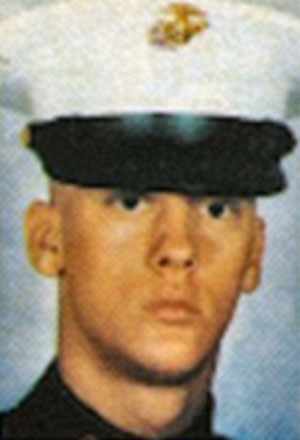
Steven J. Crowley was born in Port Jefferson Station, New York, on March 27,1959. A corporal, he served as a Marine Security Guard at the U.S. Embassy in Islamabad, Pakistan. On November 21, 1979, Pakistani students stormed the embassy after hearing a radio report falsely claiming that the U.S. had bombed and burned Islam’s holy site at Mecca. More than 130 embassy personnel were trapped inside the communications vault for several hours. Crowley was shot by a sniper while posted on the roof of the embassy. He was posthumously awarded the Bronze Star Medal, the Purple Heart, and the State Department Award for Valor and buried at Arlington National Cemetery. He was 20 years old. There is a memorial park named for him in Port Jefferson Station, New York.
[Sources: “Park is Renamed for Slain Marine,” Newsday (Suffolk Edition), Melville, New York, December 5, 1979, Page 5, online at Newspapers.com; “Cpl Steven J. Crowley,” Findagrave.com, Memorial ID: 20097776; “An Embassy in Flames: Islamabad, 1979,” and “The “Other” Embassy Attack of November 1979 -- The Siege of Embassy Islamabad,” www.adst.org; embassymarine.org; navylog.navymemorial.org; Ancestry.com records.]
 §
§
Bryan L. Ellis
Burned Attempting to Save Life — Islamabad, Pakistan 1979
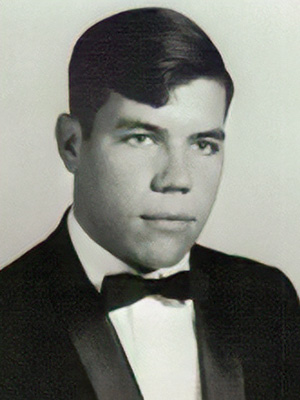
Bryan Lee Ellis was born in Goldsboro, North Carolina, on May 20,1950. A veteran U.S. Army pilot who survived several combat tours in Vietnam, Ellis served as chief warrant officer at the U.S. Embassy in Islamabad, Pakistan. On November 21, 1979, Pakistani students stormed the embassy after hearing a radio report falsely claiming that the U.S. had bombed and burned Islam’s holy site at Mecca. More than 130 embassy personnel were trapped inside the communications vault for several hours. Ellis died in his apartment, which was burned during the riots after the embassy complex was set on fire. He was 29 years old. Ellis was survived by his wife and one son, who were present during the attack and were rescued when Pakistani troops drove the attackers away. Ellis is buried at Piney Grove Baptist Church Cemetery in Swansboro, North Carolina.
[Sources: “Pilot Slain in Pakistan from N.C.; Family Safe,” Winston-Salem Journal, Winston-Salem, North Carolina, November 23, 1979, Page 54, online at Newspapers.com; “Bryan Lee Ellis,” “An Embassy in Flames: Islamabad, 1979,” and “The “Other” Embassy Attack of November 1979 -- The Siege of Embassy Islamabad,” www.adst.org; Findagrave.com, Memorial ID: 15662296, Ancestry.com records.]
 §
§
Richard Aitken
Automobile Accident — Sudan 1981
Richard Lyall Aitken Jr. was born on April 29, 1934, in Denver, Colorado. After graduating from East High School in Wichita, Kansas, in 1952, Aitken spent seven years in the Marine Corps. After his discharge, he earned a degree in business administration from Wichita University in 1965 and a master’s degree in 1966. He then joined the U.S. Agency for International Development and served in Vietnam from 1966 to 1969, returning to Washington for two years and then went back to Vietnam in 1971. He served subsequent tours in Taiwan and Cairo. He served for a total of 15 years with USAID, and was among the last evacuated from Saigon before its fall in 1975.
Serving in Sudan, he was in charge of a commodity import program that brought agricultural products and machinery to Sudan. He died in Khartoum on March 25, 1981, of injuries during a March 18 automobile accident in Rahad, Sudan, that also killed a Sudanese driver and injured another USAID employee. Aitken was 46 years old. Aitken was survived by his wife, a daughter, and his mother. He is buried at White Chapel Memorial Gardens in Wichita, Kansas.
[Sources: “Former Wichitan Killed in Sudan Auto Accident,” The Wichita Eagle, Wichita, Kansas, March 20, 1981, Page 33, online at Newspapers.com; “Richard Lyall Aitken,” Findagrave.com, Memorial ID: 110779832; Ancestry.com records.]
 §
§
Philip Robert Hanson
Plane Crash — Togo 1981
Philip Robert Hanson was born in Ortonville, Minnesota, on April 29, 1946. He graduated from the University of Arizona in 1968 with a major in international relations and received a master’s degree from the International School of Business. Hanson worked with the Peace Corps in Cote d’Ivoire and Rabat, Morocco. He joined the State Department Foreign Service in 1974 and served as general services officer in Ouagadougou, Upper Volta (now Burkina Faso). While flying to Lome, Togo, to begin a temporary assignment at the embassy there, his plane crashed on June 25, 1981, killing all on board. He was 35 years old. Hanson was survived by his wife, a son, his parents, three siblings, and his grandmother. He is buried in Roselawn Cemetery in Ortonville, Minnesota.
[Sources: Globe-Gazette, Mason City, Iowa, June 29, 1981, Page 2; “Philip Robert Hanson,” Findagrave.com, Memorial ID: 78749613; State Department Biographic Register, July 1974; Ancestry.com records.]
 §
§
Charles Robert Ray
Assassinated by Terrorists — Paris, France 1982
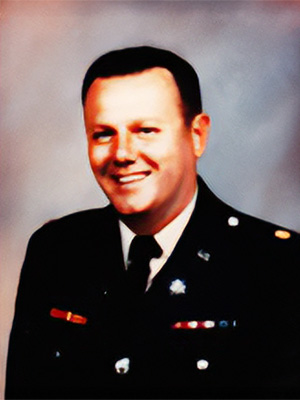
Charles Robert Ray was born in New York City on September 14, 1938, and joined the U.S. Army in 1960. A lieutenant colonel and decorated Vietnam War veteran, he served as an assistant army attaché in Paris. On January 18, 1982, a member of the Lebanese Armed Revolutionary Faction shot and killed Ray outside his apartment building as Ray departed for work. He was posthumously promoted to Colonel and buried in Arlington National Cemetery. Ray was 43 years old. He was survived by his wife and two children.
[Sources: “Attache’s Body Coming Home,” Albuquerque Journal, Albuquerque, New Mexico, January 21, 1982, Page 59, online at Newspapers.com; “Col Charles Robert Ray,” Findagrave.com, Memorial ID: 60236630; dia.mil; Wikipedia.org; Ancestry.com records.]
 §
§
Robert C. Ames
Killed in Bombing of Embassy — Beirut, Lebanon 1983
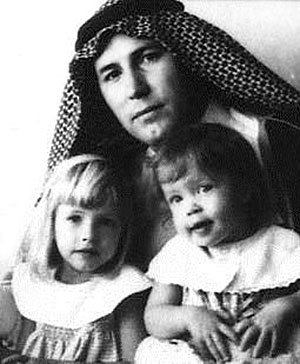
Robert Clayton Ames was born in Philadelphia, Pennsylvania, on March 6, 1934. A talented basketball player and graduate of La Salle University, he served in the U.S. Army. In a 22 year career in the Central Intelligence Agency, he served throughout the Middle East and helped open a path to peace negotiations with the Palestinian Liberation Organization. Ames, who was fluent in Arabic and was CIA's top Middle East analyst and Near East director, was in Beirut for consultations.
On April 18, 1983, he was one of 63 people (17 Americans, 32 Lebanese, and 14 visitors and passers-by) killed at U.S. Embassy Beirut when a van carrying a 2,000 pound bomb broke through an outbuilding, crashed through the lobby door, and exploded there. The Islamic Jihad Organization, which later became part of Hizballah, claimed responsibility. He was 49 years old and is buried in Arlington National Cemetery.
Note: When a CIA employee working under Department of State cover dies in qualifying circumstances, AFSA inscribes their name on the plaque. If the CIA later acknowledges their employment, AFSA updates the biographic information on this webpage.
[Sources: www.cia.gov/stories/story/beirut-embassy-attack-40th-anniversary/; “Robert Clayton Ames,” Findagrave.com, Memorial ID: 5991298; Ancestry.com records.]
 §
§
Thomas R. Blacka
Killed in Bombing of Embassy — Beirut, Lebanon 1983
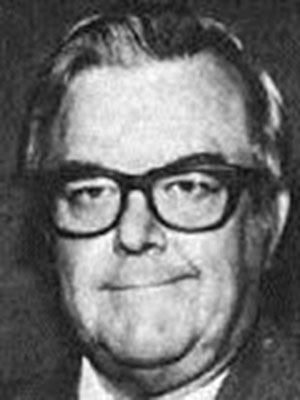
Thomas Raymond Blacka was born in Connellsville, Pennsylvania, on December 10, 1923. He graduated from the Universities of Miami and Denver and served with the U.S. military in England during World War II. He later joined the U.S Agency for International Development and traveled worldwide until his retirement, serving in Ceylon, Iceland, Spain, Pakistan, Laos, Thailand, and Washington. Blacka returned to USAID in 1982 to serve at U.S. Embassy Beirut as the USAID mission controller.
On April 18, 1983, he was one of 63 people (17 Americans, 32 Lebanese, and 14 visitors and passers-by) killed at U.S. Embassy Beirut when a van carrying a 2,000 pound bomb broke through an outbuilding, crashed through the lobby door, and exploded there. The Islamic Jihad Organization, which later became part of Hizballah, claimed responsibility. He was 59 years old. Blacka is buried in Arlington National Cemetery. He was survived by his wife and two children.
[Sources: “Connellsville Native Killed in Beirut Embassy Bombing,” The Pittsburgh Press, Pittsburgh, Pennsylvania, April 20, 1983, Page 8, online at Newspapers.com; Ssgt Thomas R. Blacka, Findagrave.com, Memorial ID 34235953; Ancestry.com records.]
 §
§
Phyliss N. Faraci
Killed in Bombing of Embassy — Beirut, Lebanon 1983
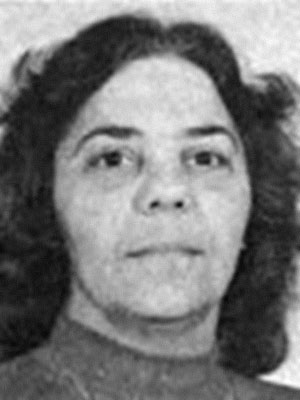
Phyliss Nancy Faraci was born in Monessen, Pennsylvania, on March 10, 1938. She graduated from Douglas Business School. She served with the Central Intelligence Agency in Vietnam (where she was one of the last four Americans to evacuate the Mekong Delta when Saigon fell in April 1975), Kuwait, and other posts in the Middle East. Faraci’s final post was as an administrative assistant at U.S. Embassy Beirut.
On April 18, 1983, she was one of 63 people (17 Americans, 32 Lebanese, and 14 visitors and passers-by) killed at U.S. Embassy Beirut when a van carrying a 2,000 pound bomb broke through an outbuilding, crashed through the lobby door, and exploded there. The Islamic Jihad Organization, which later became part of Hizballah, claimed responsibility. She was 44 years old. Faraci is buried in Grandview Cemetery in Monessen, Pennsylvania. She was survived by her mother and older brother.
Note: When a CIA employee working under Department of State cover dies in qualifying circumstances, AFSA inscribes their name on the plaque. If the CIA later acknowledges their employment, AFSA updates the biographic information on this webpage.
[Sources: “Embassy blast victim like job, overseas,” Pittsburgh Post-Gazette, Pittsburgh, Pennsylvania, April 22, 1983, Page 11, online at Newspapers.com; www.cia.gov/stories/story/beirut-embassy-attack-40th-anniversary/; “Phyliss Nancy Faraci,” Findagrave.com, Memorial ID: 237442919, Ancestry.com records.]
 §
§
Terry L. Gilden
Killed in Bombing of Embassy — Beirut, Lebanon 1983
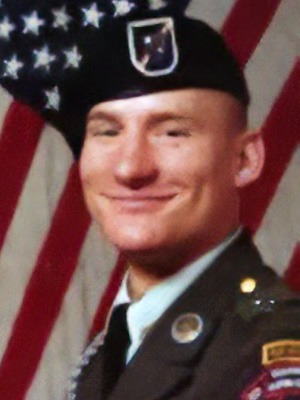
Terry Lee Gilden was born in Chandler, Arizona, on September 15, 1957. A sergeant first class in the U.S. Army, he became a member of the Special Forces and served as a bodyguard to the U.S. ambassador at U.S. Embassy Beirut.
On April 18, 1983, he was one of 63 people (17 Americans, 32 Lebanese, and 14 visitors and passers-by) killed at U.S. Embassy Beirut when a van carrying a 2,000 pound bomb broke through an outbuilding, crashed through the lobby door, and exploded there. The Islamic Jihad Organization, which later became part of Hizballah, claimed responsibility. He was 25 years old. Gilden was survived by his wife, a four month-old daughter, his parents, and three siblings. There are grave markers for Gilden in Arlington National Cemetery and Pateros Cemetery in Pateros, Washington.
[Sources: “Area man bombing victim in Beirut; services planned,” Spokane Chronicle, Spokane, Washington, April 21, 1983, Page 6, online at Newspapers.com; “Terry Lee Gilden,” Findagrave.com. Memorial IDs: 24241864 and 5991130; Ancestry.com records.]
 §
§
Kenneth E. Haas
Killed in Bombing of Embassy — Beirut, Lebanon 1983
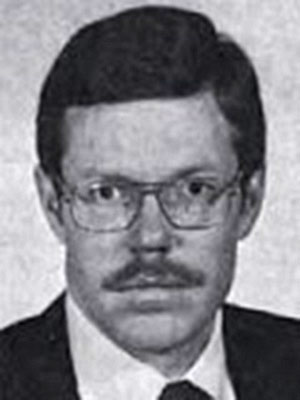
Kenneth Eugene Haas was born in Akron, Ohio, on June 17, 1944. He earned a Ph.D. in philosophy from Syracuse University. He served with the Central Intelligence Agency for nine years in Bangladesh, Iran, and Oman. Hass’ final post was as CIA station chief at U.S. Embassy Beirut.
On April 18, 1983, he was one of 63 people (17 Americans, 32 Lebanese, and 14 visitors and passers-by) killed at U.S. Embassy Beirut when a van carrying a 2,000 pound bomb broke through an outbuilding, crashed through the lobby door, and exploded there. The Islamic Jihad Organization, which later became part of Hizballah, claimed responsibility. He was 38 years old.
He was survived by his wife, a son, and his parents. He is buried in Arlington National Cemetery.
Note: When a CIA employee working under Department of State cover dies in qualifying circumstances, AFSA inscribes their name on the plaque. If the CIA later acknowledges their employment, AFSA updates the biographic information on this webpage.
[Sources: The Plain Dealer, Cleveland, Ohio, April 25, 1983, Page 54, online at Newspapers.com; www.cia.gov/stories/story/beirut-embassy-attack-40th-anniversary/; “Kenneth Eugene Haas,” Findagrave.com, Memorial ID: 74976929; Ancestry.com records.]
 §
§
Deborah M. Hixon
Killed in Bombing of Embassy — Beirut, Lebanon 1983
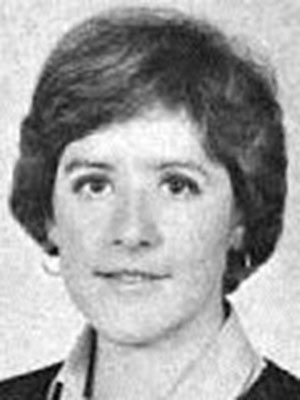
Deborah Marie Hixon was born in Denver, Colorado on September 15, 1952. She graduated from the University of Colorado – Boulder. Joining the Central Intelligence Agency, eight years later she was on temporary duty at U.S. Embassy Beirut.
On April 18, 1983, she was one of 63 people (17 Americans, 32 Lebanese, and 14 visitors and passers-by) killed at U.S. Embassy Beirut when a van carrying a 2,000 pound bomb broke through an outbuilding, crashed through the lobby door, and exploded there. The Islamic Jihad Organization, which later became part of Hizballah, claimed responsibility. She was 30 years old. She is buried in Chapel Hill Memorial Gardens in Littleton, Colorado.
Note: When a CIA employee working under Department of State cover dies in qualifying circumstances, AFSA inscribes their name on the plaque. If the CIA later acknowledges their employment, AFSA updates the biographic information on this webpage.
[Sources: “Deborah Marie Hixon,” Findagrave.com, Memorial ID: 140579627; www.cia.gov/stories/story/beirut-embassy-attack-40th-anniversary/; Ancestry.com records.]
 §
§
Frank J. Johnston
Killed in Bombing of Embassy — Beirut, Lebanon 1983
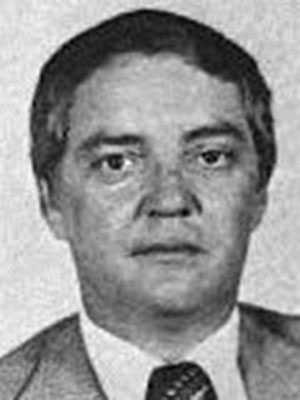
Frank John Johnston was born in New York on February 20, 1936. A U.S. Army veteran of the Korean War, he had served with the Central Intelligence Agency for 26 years when he began his assignment at U.S. Embassy Beirut.
On April 18, 1983, he was one of 63 people (17 Americans, 32 Lebanese, and 14 visitors and passers-by) killed at U.S. Embassy Beirut when a van carrying a 2,000 pound bomb broke through an outbuilding, crashed through the lobby door, and exploded there. The Islamic Jihad Organization, which later became part of Hizballah, claimed responsibility. He was 47 years old. Johnston is buried in Arlington National Cemetery.
Note: When a CIA employee working under Department of State cover dies in qualifying circumstances, AFSA inscribes their name on the plaque. If the CIA later acknowledges their employment, AFSA updates the biographic information on this webpage.
[Sources: “Frank John Johnston,” Findagrave.com, Memorial ID: 74976582; www.cia.gov/stories/story/beirut-embassy-attack-40th-anniversary/; Ancestry.com records.]
 §
§
James F. Lewis
Killed in Bombing of Embassy — Beirut, Lebanon 1983
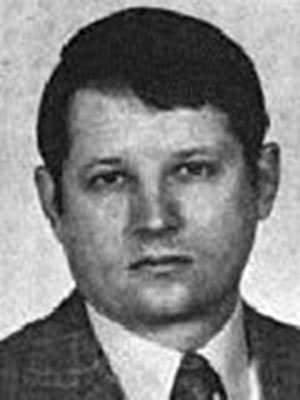
James Foley Lewis was born on February 29, 1944, and was raised in California. After service during the Vietnam War as a U.S. Army Green Beret, he joined the Central Intelligence Agency in 1970. Back in Vietnam in April 1975, he was badly wounded during a North Vietnamese attack and was captured and spent six months in solitary confinement at Son Tay Prison in North Vietnam before being released. In 1983, he was stationed at U.S. Embassy Beirut.
On April 18, 1983, he and his wife Monique were among the 63 people (17 Americans, 32 Lebanese, and 14 visitors and passers-by) killed at U.S. Embassy Beirut when a van carrying a 2,000 pound bomb broke through an outbuilding, crashed through the lobby door, and exploded there. The Islamic Jihad Organization, which later became part of Hizballah, claimed responsibility. He was 39 years old. He and his wife are buried together in Arlington National Cemetery.
Note: When a CIA employee working under Department of State cover dies in qualifying circumstances, AFSA inscribes their name on the plaque. If the CIA later acknowledges their employment, AFSA updates the biographic information on this webpage.
[Sources: “Ex-N.C. Couple Killed in Bombing,” News and Record, Greensboro, North Carolina, April 22, 1983, Page 15, online at Newspapers.com; “James Foley Lewis,” Findagrave.com, Memorial ID: 22508173; www.cia.gov/stories/story/beirut-embassy-attack-40th-anniversary/; Ancestry.com records.]
 §
§
Monique Lewis
Killed in Bombing of Embassy — Beirut, Lebanon 1983
Monique Nguyet LeMinh Lewis was born on October 29, 1946, in Saigon, Vietnam. She was educated in France and at the George Washington University in Washington, D.C. Married to Central Intelligence Agency officer James Lewis who was serving at U.S. Embassy Beirut, she joined the CIA as a secretary in that embassy’s CIA office.
On April 18, 1983, her first day in the CIA office, she and her husband were among the 63 people (17 Americans, 32 Lebanese, and 14 visitors and passers-by) killed at U.S. Embassy Beirut when a van carrying a 2,000 pound bomb broke through an outbuilding, crashed through the lobby door, and exploded there. The Islamic Jihad Organization, which later became part of Hizballah, claimed responsibility. She was 36 years old. She and her husband are buried together in Arlington National Cemetery.
Note: When a CIA employee working under Department of State cover dies in qualifying circumstances, AFSA inscribes their name on the plaque. If the CIA later acknowledges their employment, AFSA updates the biographic information on this webpage.
[Sources: “Ex-N.C. Couple Killed in Bombing,” News and Record, Greensboro, North Carolina, April 22, 1983, Page 15, online at Newspapers.com; “Monique Nguyet LeMinh Lewis,” Findagrave.com, Memorial ID: 22508235; www.cia.gov/stories/story/beirut-embassy-attack-40th-anniversary/; Ancestry.com records.]
 §
§
William R. McIntyre
Killed in Bombing of Embassy — Beirut, Lebanon 1983
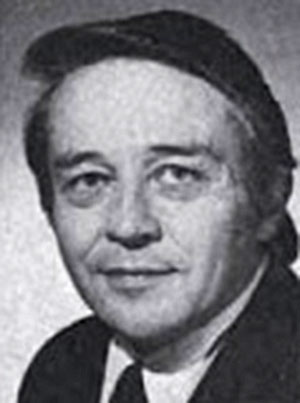
William Reynolds McIntyre was born in Detroit, Michigan, on March 15,1931. He earned bachelor’s and master’s degrees in political science from the University of Michigan and served with the U.S. Agency for International Development in India and Pakistan. McIntyre’s final post was as deputy director of USAID at U.S. Embassy Beirut.
On April 18, 1983, he was one of 63 people (17 Americans, 32 Lebanese, and 14 visitors and passers-by) killed at U.S. Embassy Beirut when a van carrying a 2,000 pound bomb broke through an outbuilding, crashed through the lobby door, and exploded there. The Islamic Jihad Organization, which later became part of Hizballah, claimed responsibility. He was 52 years old. McIntyre’s wife, Mary, was injured in the explosion. He is buried in Westminster Cemetery at Bala Cynwyd, Pennsylvania.
[Sources: The Morning Call, Allentown, Pennsylvania, April 20, 1983, Page 2, online at Newspapers.com; “William R. McIntyre,” Findagrave.com, Memorial ID: 245621240; Ancestry.com records.]
 §
§
Robert V. McMaugh
Killed in Bombing of Embassy — Beirut, Lebanon 1983
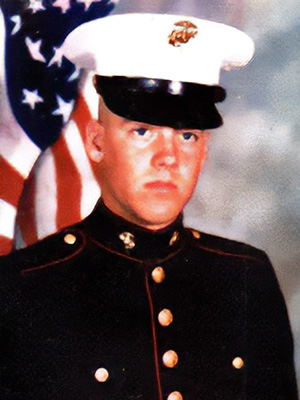
Robert Vincent “Bobby” McMaugh was born February 22, 1962, in Maryland and attended high school in Manassas, Virginia. He joined the U.S. Marines shortly after graduation. In 1983, he was a Marine Security Guard at U.S. Embassy Beirut.
On April 18, 1983, he was one of 63 people (17 Americans, 32 Lebanese, and 14 visitors and passers-by) killed at U.S. Embassy Beirut when a van carrying a 2,000 pound bomb broke through an outbuilding, crashed through the lobby door, and exploded there. The Islamic Jihad Organization, which later became part of Hizballah, claimed responsibility. Corporal McMaugh was 21 years old. He is buried in Arlington National Cemetery.
[Sources: “Corp Robert Vincent McMaugh,” Findagrave.com, Memorial ID: 5991317; https://navylog.navymemorial.org/mcmaugh-robert; https://embassymarine.org/page/The-Fallen; https://2009-2017.state.gov/m/ds/rls/260674.htm; Ancestry.com records.]
 §
§
William R. Sheil
Killed in Bombing of Embassy — Beirut, Lebanon 1983
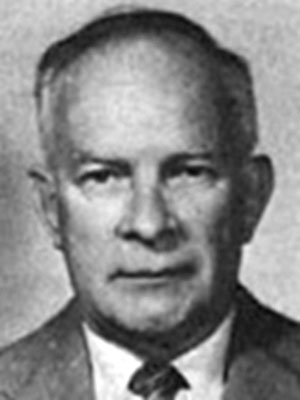
William Richard Sheil was born in Illinois on March 26, 1924. He served in the U.S. Army in World War II, Korea, and Vietnam. After joining the Central Intelligence Agency, he served three tours of duty in Vietnam and one in Laos in a variety of operational roles. In 1983, After 17 years with the CIA, he was working at U.S. Embassy Beirut.
On April 18, 1983, he was one of 63 people (17 Americans, 32 Lebanese, and 14 visitors and passers-by) killed at U.S. Embassy Beirut when a van carrying a 2,000 pound bomb broke through an outbuilding, crashed through the lobby door, and exploded there. The Islamic Jihad Organization, which later became part of Hizballah, claimed responsibility. Sheil was 59 years old. He is buried in Arlington National Cemetery.
Note: When a CIA employee working under Department of State cover dies in qualifying circumstances, AFSA inscribes their name on the plaque. If the CIA later acknowledges their employment, AFSA updates the biographic information on this webpage.
[Sources: “William Richard Sheil,” Findagrave.com, Memorial ID: 22508066; www.cia.gov/stories/story/beirut-embassy-attack-40th-anniversary/; Ancestry.com records.]
 §
§
Albert N. Votaw
Killed in Bombing of Embassy — Beirut, Lebanon 1983
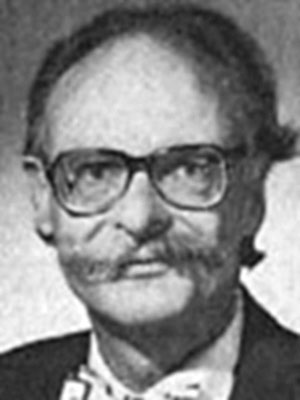
Albert Nicholson Votaw was born in Chester, Pennsylvania, on August 16, 1925. He graduated from Deep Springs College and earned master’s degrees in economics and anthropology from the University of Chicago. Votaw worked briefly as a reporter for the Chicago Sun Times before joining the U.S. Agency for International Development as an expert in urban housing serving in Abidjan, Tunis, Bangkok, and Beirut.
On April 18, 1983, he was one of 63 people (17 Americans, 32 Lebanese, and 14 visitors and passers-by) killed at U.S. Embassy Beirut when a van carrying a 2,000 pound bomb broke through an outbuilding, crashed through the lobby door, and exploded there. The Islamic Jihad Organization, which later became part of Hizballah, claimed responsibility. He was 57 years old. Votaw had only arrived in Lebanon 12 days before the bombing. He is buried in Lebanon.
[Sources: “Albert Votaw Services Set,” Public Opinion, Chambersburg, Pennsylvania, April 25, 1983, Page 1, online at Newspapers.com; “Albert Votaw,” Findagrave.com, Memorial ID 5994152; Ancestry.com records.]
 §
§
George Tsantes
Killed by Gunshot — Athens, Greece 1983
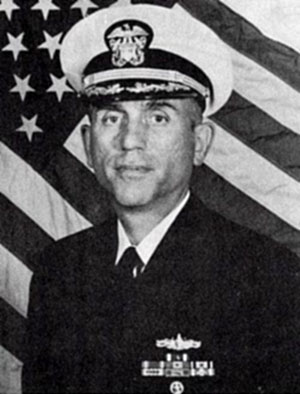
George Tsantes, Jr. was born in New York City on June 23, 1930. A graduate of the U.S. Naval Academy, he served as an engineer officer aboard the destroyer USS McNair, the aircraft carrier USS Enterprise, and several nuclear-power surface vessels. He also commanded the destroyer USS William M. Wood and the destroyer tender USS Piedmont. Tsantes later earned a master’s degree in physics and earned the rank of captain. In Washington, D.C., he served on the staff of the Chief of Naval Operations and in the Navy Atomic Energy Office.
Serving at U.S. Embassy Athens as chief of the naval section of the Joint U.S. Military Advisory Group, Tsantes and his driver were shot in their stopped car on November 15, 1983, by members of a leftist guerilla group opposed to the American presence in Greece. Tsantes died of his wounds. He was 53 years old and was survived by his wife and three children. He is buried in Arlington National Cemetery.
[Sources: “Cdr George Tsantes Jr,” Findagrave.com, Memorial ID: 49328830; https://usnamemorialhall.org/index.php/GEORGE_TSANTES,_JR.,_CAPT,_USN; Ancestry.com.]
 §
§
A. A. Schaufelberger III
Shot by Insurgents — San Salvador, El Salvador 1983
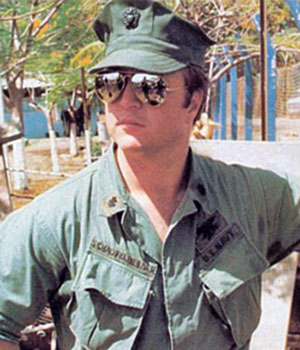
Albert Arthur Schaufelberger III was born on August 8, 1949, in Annapolis, Maryland. A graduate of the U.S. Naval Academy in 1971, he served as a U.S. Navy Seal and earned the rank of lieutenant commander. Schaufelberger later became the deputy commander of U.S. military advisers in El Salvador.
On May 25, 1983, Schaufelberger was shot at Central American University in San Salvador by members of the Central American Revolutionary Worker’s Party seeking revenge for American intervention in the country. He was the first member of the U.S. military killed in El Salvador following arrival of U.S. military advisors in October 1980. Schaufelberger was cremated and his ashes spread at sea off the California coast by a Navy SEAL patrol boat at his own request. He was 33 years old.
[Sources: “Lcdr Albert Arthur Schaufelberger III,” Findagrave.com, Memorial ID: 93505253; Ancestry.com records.]
 §
§
Charles F. Soper
Killed in Traffic Accident — New Delhi, India 1983
Charles Frederick Soper was born on January 29, 1939, in Santa Monica, California. He served as a security engineering officer at U.S. Embassy New Delhi. On June 30, 1983, Soper and R.N. Khanna, a photographer and retired U.S. Information Service employee were returning from Agra, India, where they had supported the visit of Secretary Schultz to the Taj Mahal when their vehicle collided head-on with a truck about 30 miles outside of Agra, killing them both. Injured in the same accident was cultural affairs officer Virginia Warfield, who died of her injuries a few weeks later and another U.S. Information Service employee.
[Sources: “Accident Victims Identified,” The Naples Daily News, Naples, Florida, July 1, 1983, Page 10, online at Newspapers.com; Ancestry.com records.]
 §
§
Virginia Warfield
Automobile Accident — New Delhi, India 1983
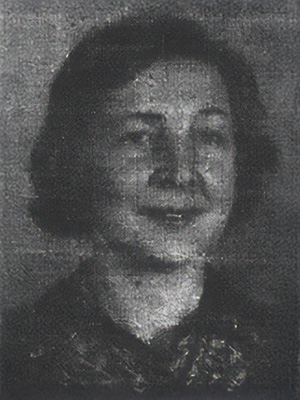
Virginia Louise Warfield was born on October 17, 1932. Growing up in Woodbine, Maryland, she graduated from the University of Maryland, taught at the Ellicott City Junior High School. She also had a master’s degree from Stanford University and did graduate work at the University of California at Berkeley. Joining the U.S. Information Agency in 1965 as a cultural affairs officer, her assignments included Yaoundé, Douala, Tananarive, and Addis Ababa.
On June 30, 1983, serving Bombay (now Mumbai), India, she was severely injured in a car accident near Agra, India, while returning to New Delhi after supporting Secretary of State George Shultz’s visit to the Taj Mahal. Warfield succumbed to her injuries on July 19 after being medevaced to Clark Air Force Base Hospital in the Philippines for treatment. Security engineer Charles Soper and photographer R.N. Khanna died in the accident. Warfield was 50 years old. She was survived by six siblings. She is buried in Jennings Chapel Cemetery in Florence, Maryland.
[Sources: The Evening Sun, Baltimore, Maryland, July 19, 1983, Page 29, online at Newspapers.com; “Virginia Louise Warfield,” Findagrave.com, Memorial ID: 28401308; State Department Biographic Register, July 1974; Ancestry.com records.]
 §
§
Leamon R. Hunt
Murdered by Guerillas — Rome, Italy 1984
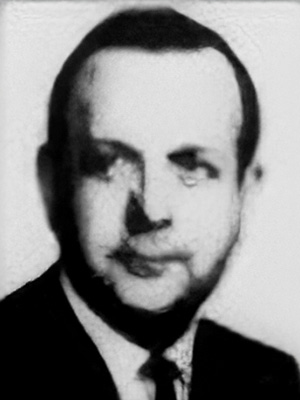
Leamon Ray Hunt was born in Mill Creek, Oklahoma, on October 7, 1927. He attended Murray College in Oklahoma and served in the U.S. Coast Guard from 1945-1956. He joined the State Department Foreign Service in 1948. His early assignments included Jerusalem, Ankara, Colombo, Addis Ababa, San Jose, Damascus, and the U.S. Army War College in Carlisle, Pennsylvania. Later in his 32-year Foreign Service career, Hunt served as the deputy chief of mission at U.S. Embassy Beirut and deputy assistant secretary of state for operations.
In 1981, he became the first director general of Multinational Forces and Observers in Egypt’s Sinai Peninsula, heading the 10-nation coalition monitoring the Egyptian-Israeli peace treaty. His office was in Rome, Italy. On February 15, 1984, Hunt was shot by members of Red Brigades, an Italian guerilla group, while heading home from work. He died of his wounds in the hospital. Hunt was 56 years old. He was survived by his wife and a son. He is buried in Arlington National Cemetery.
[Sources: “Biography: Leamon R. Hunt,” The Akron Beacon Journal, Akron, Ohio, February 16, 1984, Page 2, online at Newspapers.com; “U.S. Diplomat Gunned Down in Rome,” The Roanoke Times, Roanoke, Virginia, February 16, 1984, Page 1, online at Newspapers.com; “Leamon Ray Hunt,” Findagrave.com, Memorial ID: 126298449; State Department Biographic Register, July 1974; Ancestry.com records.]
 §
§
Kenneth G. Crabtree
Killed in Bombing — Namibia 1984
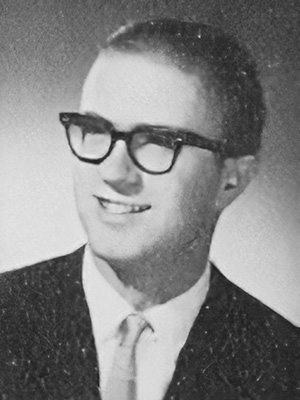
Kenneth Gordon Crabtree was born on May 8, 1938. A Vietnam veteran and graduate of the University of Colorado, he also studied at the University of Edinburgh and at Yale Divinity School. He served as a foreign affairs specialist for the U.S. Army and was the defense attaché in Malawi from 1981 to 1983. Serving in Namibia, Lieutenant Colonel Crabtree died from a bomb explosion at a service station on April 15, 1984, while he stopped for fuel while driving to northern Namibia to assess the withdrawal of South African army units from Angola. He was 45 years old. He was survived by his wife and son. Crabtree is buried at Fort Logan National Cemetery in Denver, Colorado.
[Sources: “Bomb Victims Return to Solemn U.S. Salute,” Press and Sun-Bulletin, Binghamton, New York, April 19, 1984, Page 11, online at Newspapers.com; The Times Argus, Barre, Vermont, November 7, 1964, Page 7, online at Newspapers.com; “Kenneth G. Crabtree,” Findagrave.com, Memorial ID: 532152; Ancestry.com.]
 §
§
Dennis Whyte Keogh
Killed in Bombing — Namibia 1984
Dennis Whyte Keogh was born on October 10, 1939, in Washington, D.C. He graduated from Wheeling College in West Virginia and then served in the U.S. Marine Corps from 1961-1964 rising to the rank of captain. Joining the State Department Foreign Service in 1965, he served in Rabat, Bangui, Mbabane, Bogota, as political counselor in South Africa, and as the director of the U.S. Liaison Office in Windhoek, Namibia.
He died during a bomb explosion on April 15, 1984, while stopped at a service station while driving to northern Namibia to assess the withdrawal of South African army units from Angola. Keogh was in Windhoek on a 30-day temporary assignment. He was 44 years old. Keogh was survived by his wife and three children. He was posthumously awarded the Presidential Citizen’s Medal and the Secretary’s Award, and is buried at Arlington National Cemetery.
[Sources: “Bomb Victims Return to Solemn U.S. Salute,” Press and Sun-Bulletin, Binghamton, New York, April 19, 1984, Page 11, online at Newspapers.com; “Death of an FSO, As Remembered by His Widow,” April 2014, online at adst.org; “Capt Dennis W. Keogh,” Findagrave.com, Memorial ID: 80747857; State Department Biographic Register, July 1974; Ancestry.com records.]
 §
§
Michael Ray Wagner
Killed in Bombing of Embassy — Beirut 1984
Michael Ray Wagner was born in Zebulon, North Carolina, on July 6, 1954. He joined the U.S. Navy in 1977. He was an intelligence specialist and rose to the rank of chief petty officer before reporting for duty at the U.S. Defense Attaché Office in Beirut as the Navy Intelligence Assistant in November 1983.
On September 20, 1984, members of the Islamic Jihad Organization attempted to crash a car carrying a bomb into the gates of the new U.S. Embassy in Beirut – relocated to a relatively sheltered suburb after the 1983 embassy bombing. Although the driver was shot, the vehicle detonated after hitting a parked van, and the resulting explosion killed Wagner and 23 other individuals (including one other American). Wagner was 30 years old. He was survived by his parents and two siblings. He is buried in Arlington National Cemetery.
[Sources: https://www.dia.mil/About/Patriots-Memorial/; The News and Observer, Raleigh, North Carolina, September 22, 1984, Page 39, online at Newspapers.com; “Michael Ray Wagner,” Findagrave.com, Memorial ID: 5991309; Ancestry.com records.]
 §
§
Kenneth V. Welch
Killed in Bombing of Embassy — Beirut 1984
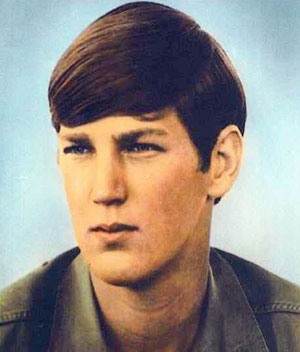
Kenneth V. Welch was born in Grand Rapids, Michigan on May 23, 1951. He joined the U.S. Army at age 21 and served in Saigon, Brussels, Tehran, Dublin, Yaoundé, and Beijing. At the time of his death he was a chief warrant officer in the U.S. Army and a member of the U.S. Defense Attaché Office in Beirut.
On September 20, 1984, members of the Islamic Jihad Organization attempted to crash a car carrying a bomb into the gates of the new U.S. Embassy in Beirut – relocated to a relatively sheltered suburb after the 1983 embassy bombing. Although the driver was shot, the vehicle detonated after hitting a parked van, and the resulting explosion killed Welch and 23 other individuals (including one other American). He was 33 years old. He was survived by his wife, two sons, and his mother. Welch is buried in Arlington National Cemetery.
[Sources: “Kin Count Cost,” Daily News, New York, NY. September 22, 1981, Page 161, online at Newspapers.com; https://www.dia.mil/About/Patriots-Memorial/; “Kenneth Vernon Welch,” Findagrave.com, Memorial ID; 5991307; Ancestry.com records.]
 §
§
Charles F. Hegna
Killed by Gunmen on Plane — Tehran, Iran 1984
Charles Floyd Hegna was born in Wausau, Wisconsin, on August 6, 1934. He graduated from the University of Wisconsin and served in the U.S. Navy 1954 to 1959. He joined the U.S. Agency for International Development in 1967 with postings including Vietnam and Ghana. In 1984, he was an auditor with USAID in Pakistan.
On December 3, 1984, four terrorists hijacked the Kuwait Airways flight on which Hegna was a passenger and forced the pilot to fly to Tehran. The terrorists demanded the release of the “Kuwait 17,” a group of terrorists arrested for simultaneously bombing six foreign and Kuwaiti installations, in exchange for the release of the passengers. Hegna was shot and his body dumped on the tarmac, and the remaining passengers were threatened and tortured for six days until Iranian security forces stormed the plane and successfully released them. Hegna was 50 years old. He was survived by his wife, four children, four siblings, and his parents.
[Sources: Department of State Biographic Register, July 1974; “Hijack Victim’s Funeral Set,” Chippewa Herald-Telegram, Chippewa Falls, Wisconsin, December 13, 1984, Page 7, online at Newspapers.com; “Charles Floyd Hegna,” Findagrave.com, Memorial ID: 34238122; Ancestry.com records.]
 §
§
William L. Stanford
Killed by Gunmen on Plane — Tehran, Iran 1984
William Laurence Stanford was born March 5, 1932, and was from Chicago, Illinois. He graduated from De Paul University and served in the U.S. Marine Corps 1953 to 1955. He joined the U.S. Agency for International Development in 1961 with postings including Pakistan and Turkey. In 1984, he was an auditor with USAID in Pakistan.
On December 3, 1984, four terrorists hijacked the Kuwait Airways flight on which Stanford was a passenger and forced the pilot to fly to Tehran. The terrorists demanded the release of the “Kuwait 17,” a group of terrorists arrested for simultaneously bombing six foreign and Kuwaiti installations, in exchange for the release of the passengers. On December 6, 1984, Stanford was shot and his body dumped on the tarmac, and the remaining passengers were threatened and tortured for six days until Iranian security forces stormed the plane and successfully released them. He was 52 years old. He was survived by his wife and four children. He is buried in Arlington National Cemetery.
[Sources: Department of State Biographic Register, July 1974; The Boston Globe, Boston, Massachusetts, December 9, 1984, Page 15, online at Newspapers.com; “William Stanford,” Findagrave.com, Memorial ID: 49353257; Ancestry.com records.]
 §
§
Enrique Camarena
Killed by Drug Traffickers — Guadalajara, Mexico 1985
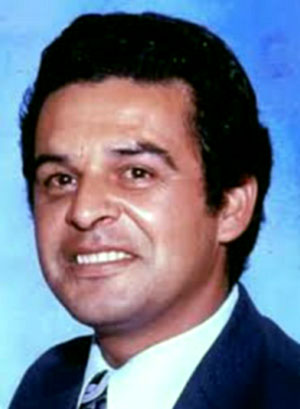
Enrique “KiKi” Camarena y Salazar was born in Mexicali, Mexico, on July 26, 1947. He served in the U.S. Marine Corps for two years and joined the U.S. Drug Enforcement Administration in 1974 as an undercover agent.
In 1984, Camarena gave 450 Mexican soldiers the information they needed to destroy a 1,000-hectare marijuana plantation with a yearly output of roughly $8 billion. The drug lord Miguel Ángel Félix Gallardo ordered a corrupt group of police officers to kidnap Camarena in retaliation. In February 1985, Camarena was abducted, tortured for 30 hours and killed. His body was found on March 5. He was 37 years old. He was cremated and his ashes were released from a plane above Mt. Signal, which is located half in Mexico and half in the United States.
Camarena was posthumously awarded the DEA’s highest award: the Award of Honor. In 2004, his wife and son established the Enrique S. Camarena Foundation in his memory to combat violence and alcohol, tobacco and drug abuse. The annual Red Ribbon Week – a student program with similar goals – was also established in honor of Camarena.
[Sources: https://museum.dea.gov/wall-honor/enrique-s-camarena; https://en.wikipedia.org/wiki/Kiki_Camarena; “Enrique ‘KiKi’ Camerena y Salazar,” Findagrave.com, Memorial ID: 8002680; Ancestry.com records.]
 §
§
Bobby Joe Dickson
Shot by Gunmen — San Salvador, El Salvador 1985

Bobby Joe Dickson was born on August 12, 1957, in Jasper, Alabama, and was raised in Tuscaloosa, Alabama. He joined the U.S. Marine Corps and rose to the rank of staff sergeant.
Assigned to the Marine Security Guard Detachment in San Salvador, on June 19, 1985, he, three other Marine Security Guards, and eight other people were killed during an attack on a restaurant in the Zona Rosa neighborhood of San Salvador when a group of armed men from the leftist Central American Revolutionary Worker’s Party opened fire on the Marines who were off duty in civilian clothing and unarmed. He was 27 years old. He was survived by his parents, three siblings, and a large extended family. Dickson is buried in Sunset Memorial Park in Northport, Alabama.
[Sources: “Ssgt Bobby Joe Dickson,” Findagrave.com, Memorial ID: 58709149, https://embassymarine.org/page/The-Fallen; Ancestry.com records.]
 §
§
Thomas T. Handwork
Shot by Gunmen — San Salvador, El Salvador 1985
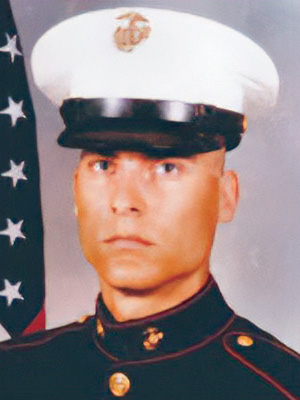
Thomas Taschner Handwork was born in Ludwigsburg, Germany on September 4, 1960, and was from Boardman, Ohio. He joined the U.S. Marine Corps and rose to the rank of staff sergeant.
Assigned to the Marine Security Guard Detachment in San Salvador, on June 19, 1985, he, three other Marine Security Guards, and eight other people were killed during an attack on a restaurant in the Zona Rosa neighborhood of San Salvador when a group of armed men from the leftist Central American Revolutionary Worker’s Party opened fire on the Marines who were off duty in civilian clothing and unarmed. He was 24 years old. Handwork was survived by his parents and four siblings. He is buried at Mount Zion Shoup Cemetery in Beavercreek, Ohio.
[Sources: “Ssgt Thomas Taschner Handwork,” Findagrave.com, Memorial ID: 11574419; https://embassymarine.org/page/The-Fallen; Ancestry.com records.]
 §
§
Patrick R. Kwiatkowski
Shot by Gunmen — San Salvador, El Salvador 1985
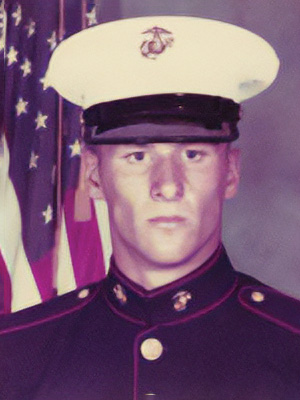
Patrick Robert Kwiatkowski was born in Wisconsin on June 21, 1964. He joined the U.S. Marine Corps and rose to the rank of sergeant.
Assigned to the Marine Security Guard Detachment in San Salvador, on June 19, 1985, he, three other Marine Security Guards, and eight other people were killed during an attack on a restaurant in the Zona Rosa neighborhood of San Salvador when a group of armed men from the leftist Central American Revolutionary Worker’s Party opened fire on the Marines who were off duty in civilian clothing and unarmed. He was 20 years old. He was survived by his parents and four siblings. Kwiatkowski is buried in Restlawn Memorial Park in Wausau, Wisconsin.
[Sources: “Sgt Patrick Robert ‘Pat’ Kwiatkowski,” Findagrave.com, Memorial ID: 180496007; https://embassymarine.org/page/The-Fallen; Ancestry.com records.]
 §
§
Gregory H. Weber
Shot by Gunmen — San Salvador, El Salvador 1985
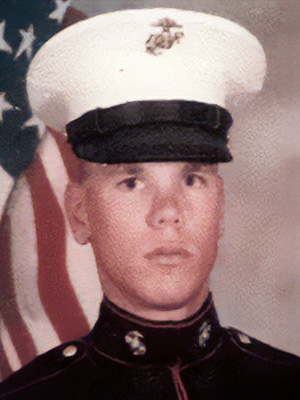
Gregory Howard Weber was born on July 3, 1962, in Cincinnati, Ohio. He joined the U.S. Marine Corps and rose to the rank of sergeant.
Assigned to the Marine Security Guard Detachment in San Salvador, on June 19, 1985, he, three other Marine Security Guards, and eight other people were killed during an attack on a restaurant in the Zona Rosa neighborhood of San Salvador when a group of armed men from the leftist Central American Revolutionary Worker’s Party opened fire on the Marines who were off duty in civilian clothing and unarmed. He was 22 years old. Weber was survived by his parents and six siblings. He is buried at St. Joseph New Cemetery in Cincinnati, Ohio.
[Sources: “Sgt Gregory Howard ‘Greggy’ Weber,” Findagrave.com, Memorial ID: 64946660; https://embassymarine.org/page/The-Fallen; Ancestry.com records.]
 §
§
William F. Buckley
Kidnapped and Killed by Terrorists — Beirut, Lebanon 1985
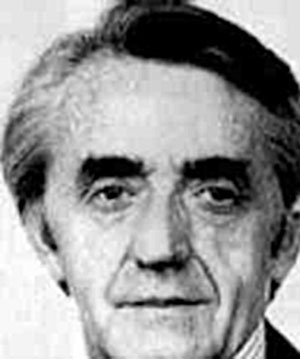
William Frank Buckley, Jr. was born in Medford, Massachusetts, on May 30, 1928. He joined the U.S. Army after graduating high school. After attending Officers Candidate School, he was commissioned as a second lieutenant and served in the Korean War. Following the war, Buckley graduated from Boston University, joined the Central Intelligence Agency briefly, and served in Vietnam as a senior advisor to the South Vietnamese army. Buckley later rejoined the CIA, serving in Vietnam, Zaire, Cambodia, Egypt, and Pakistan.
Buckley volunteered to serve as CIA Station Chief in Lebanon following the 1983 Beirut Embassy bombing that killed eight CIA employees. On March 16, 1984, he was kidnapped by Hezbollah from his apartment building while leaving for work. His captors held him in captivity and tortured him. On October 4, 1985, they announced that he had been executed but he probably died on June 3, 1985, of a heart attack. His remains were recovered and returned to the U.S. in December 1991. Buckley is buried in Arlington National Cemetery.
Note: When a CIA employee working under Department of State cover dies in qualifying circumstances, AFSA inscribes their name on the plaque. If the CIA later acknowledges their employment, AFSA updates the biographic information on this webpage.
[Sources: https://www.cia.gov/legacy/honoring-heroes/heroes/william-f-buckley/; “William Francis Buckley,” Findagrave.com, Memorial ID: 5852472; https://en.wikipedia.org/wiki/William_Francis_Buckley; Ancestry.com records.]
 §
§
James David Marill
Automobile Accident — Cameroon 1986

James David Marill was born in Boston, Massachusetts in 1960. He graduated from Brandeis University and earned a master’s degree from William Patterson College. He joined the Foreign Service in 1985 with his first assignment was as general services officer at U.S. Embassy N'Djamena, Chad, starting in October 1985. On April 12, 1986, he died in a car accident while traveling in Cameroon and returning to his post from a regional crisis management exercise. He was 26 years old. He was survived by his parents, a brother, and grandparents. Marill is buried in Cedar Park Cemetery in Emerson, New Jersey.
[Sources: “James Marill, 26, Dead in Chad,” The Sunday News, Ridgewood, New Jersey, May 4, 1986, Page 22, online at Newspapers.com; The Records, Hackensack, New Jersey, May 2, 1986, Page 38, online at Newspapers.com; Ancestry.com records.]
 §
§
Rebecca Roberts
Carbon Monoxide Poisoning — Jerusalem, Israel 1987
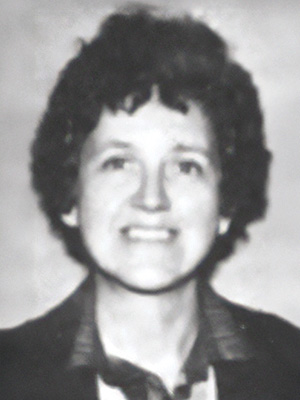
Rebecca Lambert Roberts was born on May 18, 1948. She graduated from the University of Georgia in 1970, and prior to joining the Foreign Service, worked for the Music Department at Georgia State University, the Robert Woodruff Museum of Art, and the Coca-Cola Company. She joined the State Department and was assigned to Jerusalem as assistant communication officer. She died there on December 6, 1987, from carbon monoxide poisoning from a faulty appliance in her government-leased apartment. She was 39 years old. Roberts was survived by her mother and extended family. She is buried in Westview Cemetery in Atlanta, Georgia.
[Sources: The Atlanta Constitution, Atlanta, Georgia, December 8, 1987, Page 60, online at Newspapers.com; State Magazine, No. 62, January 1988; “Rebecca Roberts,” Findagrave.com, Memorial ID: 77173552; Ancestry.com records.]
 §
§
William E. Nordeen
Car Bombing — Athens, Greece 1988
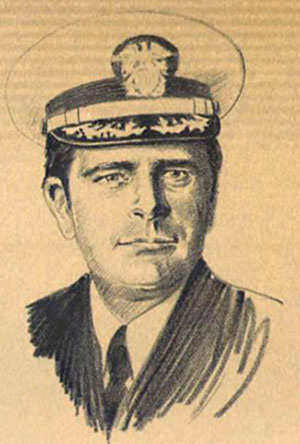
William Edward Nordeen was born in Amery, Wisconsin on October 9, 1936, and graduated from Wisconsin State College in River Falls. He joined the U.S. Navy and rose to the rank of captain. He was posted as a member of the U.S. Defense and Naval Attaché office at U.S. Embassy Athens, Greece, starting in 1985. On June 28, 1988, he was killed by a car bomb detonated by the terrorist group “17 November” as he left his residence to go to work. He was due to retire from a 30-year career in the U.S. Navy less than two months later. Nordeen was 51 years old. He was survived by his wife, and two children. Nordeen is buried in Arlington National Cemetery.
[Sources: “Car bomb Kills U.S. Diplomat in Greece,” The Springfield News-Leader, Springfield, Missouri, June 29, 1988, Page 3, online at Newspapers.com; https://www.dia.mil/About/Patriots-Memorial/; “Capt William Edward Nordeen,” Findagrave.com, Memorial ID: 63501215; Ancestry.com records.]
 §
§
Arnold L. Raphel
Airplane Explosion — Pakistan 1988
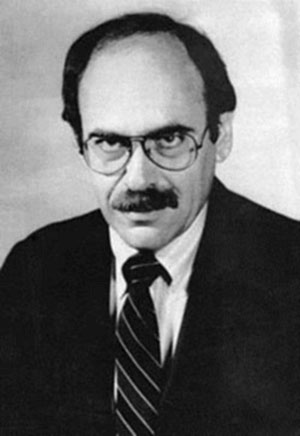
Arnold Lewis Raphel was born in Troy, New York, on March 16, 1943. He earned a bachelor’s degree from Hamilton College and a master’s degree from the Maxwell School at Syracuse University. Raphel joined the Foreign Service in 1966. His assignments included Tehran, Iran, and the State Department's Special Operations Group set up to free the Americans seized by Iranian militants at the U.S. Embassy in Teheran, the special and later deputy assistant to the Secretary of State and, finally, U.S. ambassador to Pakistan.
On August 17, 1988, Raphel, Pakistani President Muhammad Zia-ul-Haq, U.S. Brigadier General Hervert Wassom, and 28 others died in a plane crash after their plane exploded in the air. U.S. investigators attributed the crash to a mechanical failure. He was 45 years old. He was survived by his wife, Nancy, and a daughter. Raphel is buried in Arlington National Cemetery.
[Sources: “Envoy Raphel Buried At Arlington,” Citizens’ Voice, Wilkes-Barre, Pennsylvania, August 23, 1988, Page 11, online at Newspapers.com; “Arnold Lewis Raphel,” Findagrave.com, Memorial ID: 4786; https://adst.org/2015/07/the-death-of-ambassador-arne-raphel/; Ancestry.com records.]
 §
§
Herbert M. Wassom
Airplane Explosion — Pakistan 1988
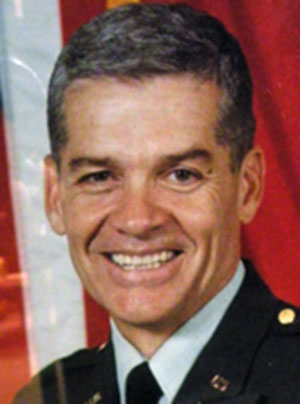
Herbert Marion Wassom was born on December 20, 1938, in Spring City, Tennessee. He graduated from Western Kentucky University and earned a master's degree from The George Washington University. Joining the U.S. Army, he served in the Vietnam War and other assignments including chief of the U.S. Defense Representative to Pakistan, chief of staff of the 101st Airborne Division, deputy director of the Army Staff, and Commander of the 528th Field Artillery Group.
In 1988, Wassom was a brigadier general and the head of the U.S. military aid mission to Pakistan. On August 17, 1988, he, Pakistani President Muhammad Zia-ul-Haq, U.S. Ambassador Arnold Raphel, and 28 others died in a plane crash after their plane exploded in the air. U.S. investigators attributed the crash to a mechanical failure. He was 49 years old. He was survived by his wife, two children, and a brother. Wassom is buried in Arlington National Cemetery.
[Sources: “General Killed in Crash Grew Up in Spring City,” The Knoxville News-Sentinel, Knoxville, Tennessee, August 18, 1988, Page 19, online at Newspapers.com; “Herbert Marion Wassom,” Findagrave.com, Memorial ID: 4787; Ancestry.com records.]
 §
§
Matthew K. Gannon
Airplane Bombing — Scotland 1988
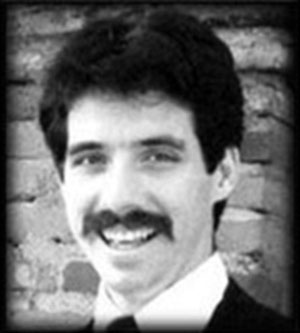
Matthew Kevin Gannon was born on August 11, 1954, and grew up in San Juan Capistrano, California. He graduated from the University of Southern California. He joined the Central Intelligence Agency in 1977. He spent much of his career in the Middle East, quickly gaining proficiency in Arabic, with a short posting as deputy branch chief of the Counterterrorism Center in Washington, D.C.
In late fall 1988, he took a temporary assignment at a CIA station in the Middle East. While returning to the United States to spend Christmas with his wife and two young children, he was one of 189 Americans killed during the bombing of Pan Am Flight 103 by a Libyan government operative over Lockerbie, Scotland, on December 21, 1988. Gannon is buried in Arlington National Cemetery.
Note: When a CIA employee working under Department of State cover dies in qualifying circumstances, AFSA inscribes their name on the plaque. If the CIA later acknowledges their employment, AFSA updates the biographic information on this webpage.
[Sources: https://www.cia.gov/legacy/honoring-heroes/heroes/matthew-kevin-gannon/; “Matthew Kevin Gannon,” Findagrave.com, Memorial IDs: 239606751 and 6006073; Ancestry.com records.]
 §
§
Ronald A. Lariviere
Airplane Bombing — Scotland 1988
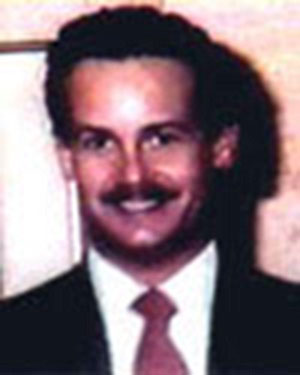
Ronald Albert Lariviere was born in Holyoke, Massachusetts, on November 19, 1955, and later lived in Alexandria, Virginia. After graduating high school, he enlisted in the U.S. Army, performed intelligence work in West Germany and earned the Soldier of the Month Award at Fort Hood, Texas. Lariviere later attended Holyoke Community College and Nichols College.
He joined the Foreign Service as a Diplomatic Security Special Agent. His final post was in the Regional Security Office at U.S. Embassy Beirut, Lebanon. While returning to spend Christmas with his wife and young daughter, Lariviere was one of 189 Americans killed during the bombing of Pan Am Flight 103 by a Libyan government operative over Lockerbie, Scotland on December 21, 1988. He was 33 years old. He was survived by his wife, a two year-old daughter, his parents, and two sisters. Lariviere is buried in Notre Dame Cemetery in South Hadley, Massachusetts.
[Sources: https://www.state.gov/biographies/ronald-albert-lariviere/; “Ronald Albert Lariviere,” Findagrave.com, Memorial IDs: 46223312 and 156620410.]
 §
§
Daniel E. O’Connor
Airplane Bombing — Scotland 1988
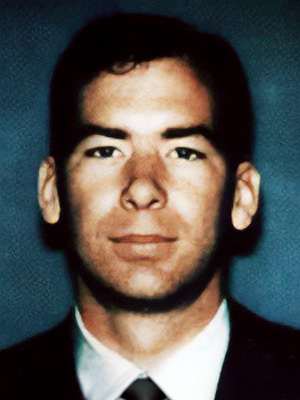
Daniel Emmett O’Connor, Jr., was born on September 22, 1957, in Dorchester, Massachusetts. He joined the Foreign Service as a Diplomatic Security Special Agent. His final post was in the Regional Security Office at U.S. Embassy Nicosia, Cyprus. On December 21, 1988, he was one of 189 Americans killed during the bombing of Pan Am Flight 103 by a Libyan government operative over Lockerbie, Scotland. He was 31 years old. He was survived by his parents, three sisters, and a large extended family. O’Connor is buried in Blue Hill Cemetery in Braintree, Massachusetts.
[Sources: https://www.state.gov/biographies/daniel-emmett-oconnor/; The Bangor Daily News, Bangor, Maine, December 26, 1988, Page 27, online at Newspapers.com; “Daniel Emmett O’Connor,” Findagrave.com, Memorial ID: 156620446; Ancestry.com records.]
 §
§
James N. Rowe
Shot by Communists — Philippines 1989
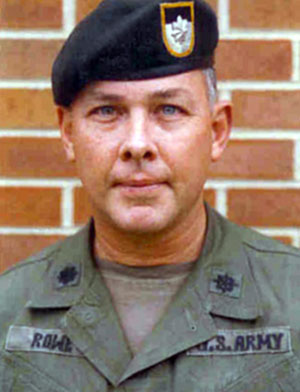
James Nicholas Rowe was born in McAllen, Texas on February 8, 1938. After graduating high school, he attended the U.S. Military Academy at West Point and served in the Vietnam War. Rowe was captured by the Viet Cong and spent the next five years in captivity – much of it in a tiny bamboo cage. Rowe eventually escaped from his captors. He wrote the book Five Years to Freedom: The True Story of a Vietnam POW about his experiences.
Promoted to colonel, Rowe was assigned in 1987 as chief of the U.S. Army section of the Joint U.S. Military Advisory Group providing counter-insurgency training for the Armed Forces of the Philippines. On April 21, 1989, Rowe was killed when his armored limousine was hit by gunfire from the New People’s Army. Rowe was survived by his wife and four children. He is buried in Arlington National Cemetery.
[Sources: https://en.wikipedia.org/wiki/James_N._Rowe; “Col James Nicholas ‘Nick’ Rowe,” Findagrave.com, Memorial ID: 20727; Ancestry.com records.]
 §
§
Marie D. Burke
Murdered in Home — United Kingdom 1989
Marie Agnes Delaney Hollister Burke was born on August 12, 1925, in Bayonne, New Jersey. She was widowed in 1952 when her first husband died in the Korean War. She joined the Foreign Service in 1971 – a year before her second husband, Robert T. Burke, died while serving as deputy chief of mission at the U.S. Embassy in Bathurst (Banjul), Gambia. She served in Gambia, Kenya, Barbados, Florence, and in the Bureau of Consular Affairs in the Department of State.
Burke’s final post was as second secretary in the consular section at U.S. Embassy London. On May 25, 1989, she was stabbed to death in her apartment in Paddington, London, during an apparent robbery. Burke was 63 years old. She was survived by two daughters, a son, a brother, and four sisters. She is buried with her second husband, Robert Thomas Burke, in Rock Creek Cemetery in Washington, D.C.
[Sources: “U.S. Diplomat Killed in London Apartment,” The Daily Progress, Charlottesville, Virginia, May 27, 1989, Page 8, online at Newspapers.com; “Marie D Delaney Hollister Burke,” Findagrave.com, Memorial ID: 44383123; Foreign Service Journal, September 1989, Page 51; Ancestry.com records.]
 §
§
John A. Butler
Shot in Crossfire — Grenada 1989
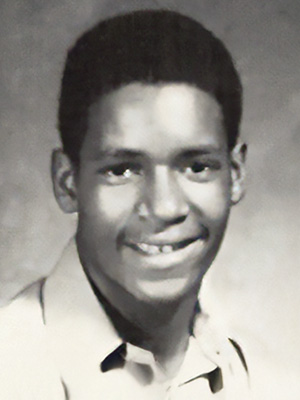
John Angelo Butler was born in San Diego, California on April 6, 1956. He earned a B.A. in political science from the University of San Diego and an M.P.A. from San Diego State University. He served as a Palm Springs police officer from 1971 to 1983, and served in the U.S. Marine Corps. He joined the Foreign Service in 1980 serving in Nassau, San Jose, and Santo Domingo. In 1988, he began work as a political officer at U.S. Embassy St. George's, Grenada.
On June 29, 1989, Butler was attending a meeting at the St. George police headquarters a when police officer entered the room and began shooting, killing the police commissioner and injuring two high-ranking officers. Butler died attempting to subdue the shooter. He was 33 years old. Butler was survived by his wife, his parents, and a large extended family. He was posthumously awarded the Department of State’s Secretary’s Award. He is buried at Twentynine Palms Cemetery in Twentynine Palms, California.
[Sources: “Slain U.S. Diplomat Buried in Twentynine Palms,” The Desert Sun, Palm Springs, California, July 4, 1989, Page 4, online at Newspapers.com; “John Angelo Butler,” Findagrave.com, Memorial ID: 103479791; Foreign Service Journal, September 1989, Page 50; Ancestry.com records.]
 §
§
Gladys D. Gilbert
Plane Crash — Ethiopia 1989
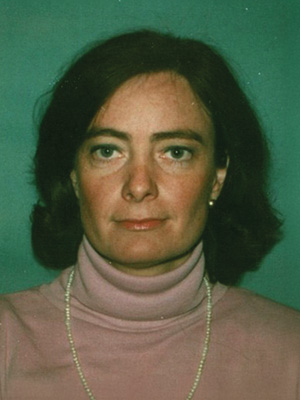
Gladys D. Gilbert was born in 1948. Originally from Los Angeles, she was a 1968 graduate of the University of Maryland, spent two years in India with the Peace Corps, and earned a master’s degree in public health from the University of Pittsburgh. She then worked as a research assistant at the World Bank from 1976 to 1977 before joining the U.S. Agency for International Development in 1977. She returned to India with USAID and also served in Afghanistan. At the time of her death, she was helping USAID distribute food aid to famine victims in Ethiopia.
On August 7, 1989, Gilbert was one of 16 people killed in a plane crash in Ethiopia while traveling with the Congressional delegation of U.S. Representative Mickey Leland (Democrat from Texas). While enroute to a refugee camp, their plane crashed into a mountain and fell into a ravine. There were no survivors. Gilbert was 43 years old. She was survived by her husband, Michael Cairney, and her mother.
[Sources: “Plane Hit Hillside in Africa,” Fort Worth Star-Telegram, Fort Worth, Texas, August 14, 1989, Page 1, online at Newspapers.com; “Former Marylander Killed With Leland,” The Baltimore Sun, Baltimore, Maryland, August 15, 1989, Page 8, online at Newspapers.com; “No Survivors Found in Plane Wreck,” Tallahassee Democrat, Tallahassee, Florida, August 14, 1989, Page 1, online at Newspapers.com; Foreign Service Journal, October 1989, Page 47; Ancestry.com records.]
 §
§
Robert W. Woods
Plane Crash — Ethiopia 1989
Robert W. Woods was a Central Intelligence Agency officer who volunteered to accompany the Congressional delegation of U.S. Representative Mickey Leland (Democrat from Texas) on a humanitarian mission in Ethiopia. On August 7, 1989, Woods was one of 16 people killed in a plane crash enroute to a refugee camp in Ethiopia when their plane crashed into a mountain and fell into a ravine. There were no survivors. Woods was survived by his parents and a sister. He is buried in Forest Hill Cemetery in Boston, Massachusetts.
Note: When a CIA employee working under Department of State cover dies in qualifying circumstances, AFSA inscribes their name on the plaque. If the CIA later acknowledges their employment, AFSA updates the biographic information on this webpage.
[Sources: “Plane Hit Hillside in Africa,” Fort Worth Star-Telegram, Fort Worth, Texas, August 14, 1989, Page 1, online at Newspapers.com; “Crash Victims in Ethiopia Bound by Love For Humanity,” The Washington Post, August 15, 1989, online at washingtonpost.com; The Boston Globe, Boston, Massachusetts, August 23, 1989, Page 34, online at Newspapers.com; https://web.archive.org/web/20121010063231/https://www.cia.gov/news-information/press-releases-statements/2012-press-releasese-statements/2012-memorial-ceremony.html; Ancestry.com records.]
 §
§
Thomas J. Worrick
Plane Crash — Ethiopia 1989
Thomas Jeffery Worrick was born October 3, 1940, in Weymouth, Massachusetts. Together with his wife, Roberta, he joined the Peace Corps in Ethiopia in 1971. Joining the U.S. Agency for International Development in 1974, he served in Tanzania, Nigeria, Pakistan, Kenya, and Liberia. His final assignment was as deputy USAID director in Ethiopia.
On August 7, 1989, Worrick, his wife Roberta, who worked as a translator, and 14 others were killed in a plane crash in Ethiopia while traveling with the Congressional delegation of U.S. Representative Mickey Leland (Democrat from Texas). While enroute to a refugee camp, their plane crashed into a mountain and fell into a ravine. There were no survivors. Worrick was 48 years old. The Worricks were survived by a son. They are buried in Vermont.
[Sources: “Plane Hit Hillside in Africa,” Fort Worth Star-Telegram, Fort Worth, Texas, August 14, 1989, Page 1, online at Newspapers.com; “Novelist Roberta Worrick Killed in Crash With Lawmaker,” Muncie Evening Press, Muncie, Indiana, August 14, 1989, Page 21, online at Newspapers.com; Foreign Service Journal, October 1989, Page 47; Ancestry.com records.]
 §
§
Robert B. Hebb
Plane Crash — Honduras 1989
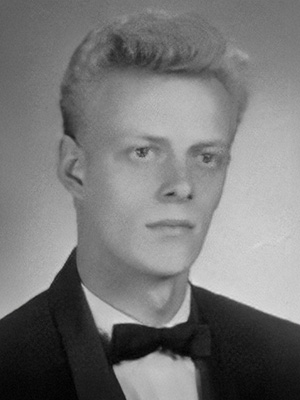
Robert Benjamin Hebb was born on May 13, 1946, in Annapolis, Maryland. After working in the U.S. Department of Health and Human Services and the Interstate Commerce Commission, he joined the U.S. Agency for International Development in 1985. In 1989 he was in his third year as an auditor in USAID’s regional office in Tegucigalpa, Honduras. On October 21, 1989, he was flying back from an official trip to Costa Rica and was one of 131 people killed in the crash of a TAN-SAHSA airliner in Honduras, which killed 131 of the 146 people on board. Another USAID employee was seriously injured in the crash. He was 43 years old. Hebb was survived by his father and two siblings. He is buried in Hillcrest Memorial Gardens in Annapolis, Maryland.
[Sources: “Lawyer killed in crash worked on Managua Vote – Second area man is presumed dead,” The Washington Post, October 25, 1989; “Robert Franklin (sic) Hebb,” Findagrave.com, Memorial ID: 230352867; Ancestry.com records.]
 §
§
Pasqual Martinez
Hotel Fire — Russia 1991
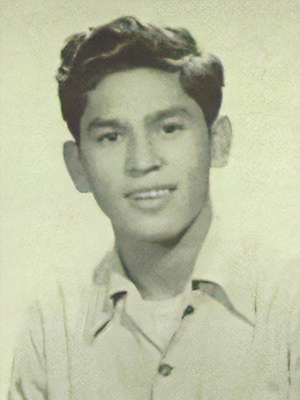
Pasqual “Marty” Martinez was born in Brawley, California, on April 11, 1936. Joining the Foreign Service, he was in Russia in 1991 on a temporary assignment as a communicator from his post at U.S. Embassy Helsinki, Finland. On February 23, 1991, he was killed in a fire at the Leningrad Hotel in Leningrad, Russia. Local officials stated that the fire started when the television exploded in another guest’s room. Martinez was survived by his wife, a stepson, four sisters, a brother, and a large extended family. He is buried in Mountain View Cemetery in Calexico, California.
[Sources: “U.S. Embassy Employee Killed in Leningrad Fire,” The Naples Daily News, Naples. Florida, March 1, 1991, Page 15, online at Newspapers.com; “Pasqual Martinez,” Findagrave.com, Memorial ID: 229968953; https://afsa.org/communications-behind-iron-curtain; Ancestry.com records.]
 §
§
Barry S. Castiglione
Ocean Rescue — El Salvador 1992
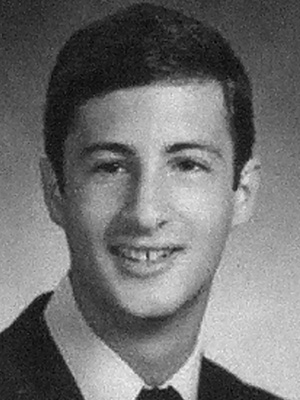
Barry S. Castiglione was born in Boston, Massachusetts on February 8, 1955. After a three-year enlistment in the Marine Corps, he joined the Central Intelligence Agency in 1982 as a supply officer. On July 19, 1992, while serving on temporary duty in El Salvador, he and colleagues were at an ocean beach when one was pulled out to sea by a rip current. He swam out and held his colleague’s head above water. Another colleague arrived and assisted her back to shore. However, Castiglione had exhausted his energies and could not fight his way through the currents to shore. He drowned before help could reach him. He was 37 years old. He was survived by his wife, infant son, sister, and parents. He is buried in the Judean Memorial Gardens in Olney, Maryland.
Note: When a CIA employee working under Department of State cover dies in qualifying circumstances, AFSA inscribes their name on the plaque. If the CIA later acknowledges their employment, AFSA updates the biographic information on this webpage.
[Source: https://www.cia.gov/legacy/honoring-heroes/heroes/barry-s-castiglione/]
 §
§
Thomas P. Doubleday, Jr.
Heart Attack — Liberia 1993
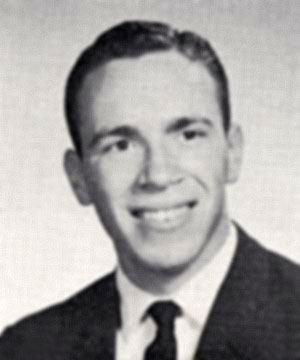
Thomas P. Doubleday, Jr., was born in New York City on October 22, 1942. He earned a bachelor’s degree from Yale University and a master’s degree from the Fletcher School of Law and Diplomacy. Doubleday joined the Foreign Service in 1965. He served in Bangkok, Saigon, Luanda, Lagos, Mogadishu, the Bureau of Intelligence and Research, the Bureau of International Organizational Affairs, the Bureau of African Affairs, the Bureau of Personnel, and the Bureau of Refugee Programs.
Doubleday’s final post was as a political counselor at U.S. Embassy Monrovia, Liberia. He died of a heart attack on February 8, 1993. Has was 49 years old. He was survived by his brother.
[Sources: “In Memoriam,” Yale University Class of 1964, online at https://www.yale64.org/remembrances/doubleday.htm; Ancestry.com records.]
 §
§
Freddie R. Woodruff
Drive-by Shooting — Georgia 1993
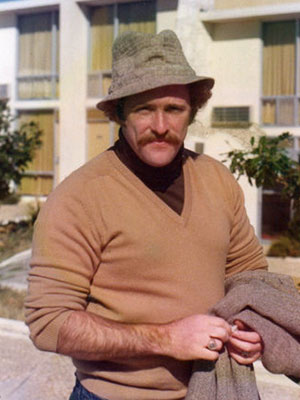
Freddie Russell Woodruff was born in Oklahoma on September 14, 1947. He joined the Central Intelligence Agency and served in Leningrad, Turkey, Sudan, and Ethiopia. Woodruff’s final post was at U.S. Embassy Tbilisi, Georgia. On August 8, 1993, he was shot and killed in Tbilisi in uncertain circumstances. He was 45 years old. Woodruff is buried in Arlington National Cemetery.
Note: When a CIA employee working under Department of State cover dies in qualifying circumstances, AFSA inscribes their name on the plaque. If the CIA later acknowledges their employment, AFSA updates the biographic information on this webpage.
[Sources: https://www.cia.gov/readingroom/document/06767318/; https://www.geni.com/people/Freddie-Woodruff/6000000002480628045; https://en.wikipedia.org/wiki/Freddie_Woodruff.]
 §
§
Nancy Ferebee Lewis
Pesticide Poisoning — Egypt 1993
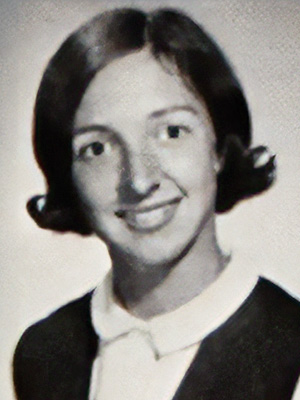
Nancy Ferebee Lewis was born on May 12, 1954, in Beirut, Lebanon, where her father ran a school. Her family relocated to Alexandria, Virginia, when she was six years old. She earned bachelor’s degrees in anthropology and art history and had master’s degrees in museum studies and business administration. Lewis joined the U.S. Agency for International Development in 1986, worked for USAID on Capitol Hill, and was assigned to Tunisia in 1990, moving to U.S. Embassy Cairo, Egypt, in June 1991.
On December 21, 1993, an embassy contractor fumigated her embassy-leased apartment. She became very sick and died of pesticide poisoning in the embassy health clinic on Christmas Day 1993. She was 39 years old. She was survived by her husband, her parents, and two siblings.
An investigation determined that her apartment had been treated with a toxic pesticide that was illegal for residential use in the United States. Several weeks later, the State Department sent a cable to all posts worldwide ordering that the pesticide no longer be used inside residences and office buildings. Several months later, the State Department agreed to an AFSA request that occupants of overseas housing be given a detailed fact sheet prior to fumigations.
[Sources: “Pesticide-Linked Death of U.S. Worker in Cairo Raises Issue of Who’s Accountable,” The Washington Post, Washington, D.C., May 21, 1994, online at washingtonpost.com; Foreign Service Journal, October 1994, Page 2 of AFSA News section; Ancestry.com records.]
 §
§
James T. Lederman
Automobile Accident — Egypt 1994
James Tell Lederman was born in Pennsylvania on December 31, 1929. He was killed in an automobile accident in Cairo, Egypt, on March 1, 1994. He was survived by his wife and a son.
[Sources: Ancestry.com records.]
 §
§
Barbara L. Schell
Helicopter Crash — Iraq 1994
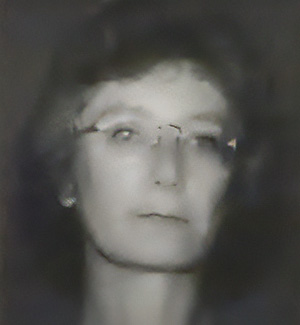
Barbara Lynn Schell was born December 6, 1943, in Connecticut. She attended the Sorbonne in France and was a graduate of the University of Michigan, with graduate work at the George Washington University. She joined the Foreign Service in 1966 and served in Morocco, the Philippines, Egypt, Chad, Syria, Algeria, and Iran. She received three State Department awards for her work in Iran, including an award for heroism during the 1979 occupation of the U.S. Embassy and her role in evacuating U.S. citizens from the country earlier that year. She was scheduled to become the deputy chief of mission in Madagascar after her tour in Iraq.
Her final post was as political advisor to the commander of the U.S. Army humanitarian mission “Operation Provide Comfort” in northern Iraq. He and she were killed on April 14, 1994, along with 24 other people when friendly fire by U.S. Air Force airplanes shot down the two Black Hawk helicopters on which they were flying. She was 50 years old. She was survived by her husband, her father, and a brother. She is interred at Arlington National Cemetery.
[Sources: “Crash Killed Top Officials in North Iraq,” The New York Times, April 16, 1994, online at nytimes.com; “Barbara L. Schell Dies at 50,” The Washington Post, April 28, 1994, online at washingtonpost.com; “Barbara Lynn Schell,” Findagrave.com, Memorial ID: 105524001; Ancestry.com records.]
 §
§
Gary C. Durell
Ambushed by Terrorists — Pakistan 1995
Gary Charles Durell was born in Alliance, Ohio, on January 8, 1950. He served in the U.S. Air Force before joining the National Security Agency. In 1995, he was posted at U.S. Consulate Karachi, Pakistan, reportedly working for the U.S. government multi-agency Special Collection Service. On March 8, 1995, he and consulate colleague Jacqueline K. Van Landingham were killed when gunmen fired at their consulate shuttle bus. He was 45 years old. Durell is buried in Highland Memorial Park in Knox Township, Ohio.
[Source: “Gary Charles Durell,” Findagrave.com, Memorial ID: 155733718; “U.S. Spies Pose as diplomats when abroad,” The Baltimore Sun, Baltimore, Maryland, reprinted in The Courier, Waterloo-Cedar Falls, Iowa, January 8, 1996, Page 1, online at Newspapers.com; Ancestry.com records.]
 §
§
Jacqueline K. Van Landingham
Ambushed by Terrorists — Pakistan 1995
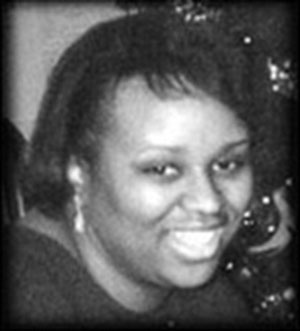
Jacqueline Elaine Keys Van Landingham was born in Camden, South Carolina. She graduated from Virginia State University in Petersburg with a degree in food marketing and management. She joined the Central Intelligence Agency in 1985, serving overseas as an operations support assistant handling administration, logistics, security, and finance. In 1994, she was posted at U.S. Consulate Karachi, Pakistan. On March 8, 1995, she and consulate colleague Gary C. Durell were killed when gunmen fired at their consulate shuttle bus. She was 33 years old. She was survived by her husband and two young daughters.
Note: When a CIA employee working under Department of State cover dies in qualifying circumstances, AFSA inscribes their name on the plaque. If the CIA later acknowledges their employment, AFSA updates the biographic information on this webpage.
[Source: https://www.cia.gov/legacy/honoring-heroes/heroes/jacqueline-k-van-landingham/]
 §
§
J. Kirby Simon
Carbon Monoxide Poisoning — Taiwan 1995
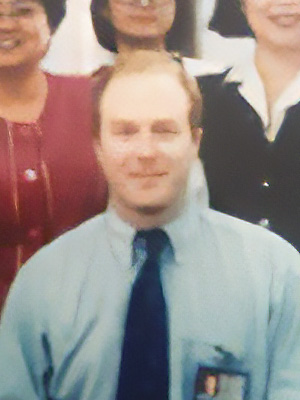
John Kirby Simon was born on July 18, 1961. He graduated from Yale University and earned a master’s degree from Columbia University. He joined the Foreign Service in 1992 and a year later was assigned to the American Institute in Taipei. On April 14, 1995, he died from accidental carbon monoxide poisoning from a malfunctioning and unvented hot water heater in his post-leased apartment. Simon is buried at the Grove Street Cemetery in New Haven, Connecticut.
In 1995, his parents, John and Claire Simon, established the J. Kirby Simon Foreign Service Trust in his memory. The trust devotes itself to funding community service among Foreign Service personnel. As of 2024, it had supported more than 925 projects around the world, giving out grants totaling around $2 million.
[Sources: Foreign Service Journal, July 1995, Page 54; Foreign Service Journal, December 1995, Page 11; J. Kirby Simon Trust, https://kirbysimon.org; https://afsa.org/two-decades-volunteer-support-kirby-simons-legacy; “John Kirby Simon,” Findagrave.com, Memorial ID: 228032936; Ancestry.com records.]
 §
§
Samuel Nelson Drew
Vehicle Accident — Bosnia 1995
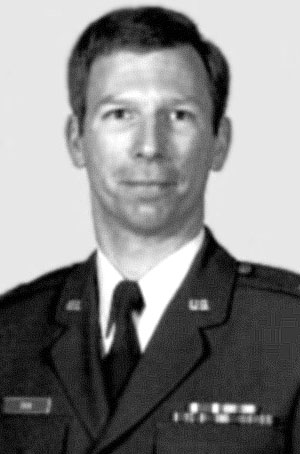
Samuel Nelson Drew was born in Wurzburg, Germany in 1948. He earned bachelor’s and master’s degrees from University of North Carolina at Chapel Hill and a Ph.D. in government and foreign affairs from the University of Virginia. Joining the U.S. Air Force, he taught at the Air Force Academy and the National War College and served as U.S. Assistant for Defense Operations and Policy for NATO in Brussels and a NATO Branch Chief in the Directorate for Strategic Plans and Policy of the Joint Chiefs of Staff.
Having risen to the rank of colonel, his final position was as director of European Affairs for the National Security Council. On August 19, 1995, he was one of three American diplomats and a French soldier killed while traveling to Sarajevo on a mission to negotiate a U.S. proposal to end the conflict in Bosnia. Driving down Mt. Igman road, “the most dangerous road in Europe,” to reach Sarajevo after the Serbs refused to guarantee safe landing to the Sarajevo airport, the rain-soaked dirt road collapsed beneath the French armored personnel carrier in which he was a passenger, sending the vehicle down a 500-meter slope into a ravine. Ambassador Richard Holbrook and General Wesley Clarke, traveling in the same convoy in a U.S. Army Humvee, made it through. Drew is buried in Arlington National Cemetery.
[Sources: https://adst.org/dayton-accords/; https://en.wikipedia.org/wiki/Robert_C._Frasure; https://www.uswarmemorials.org/html/people_details.php?PeopleID=24629.]
 §
§
Robert C. Frasure
Vehicle Accident — Bosnia 1995
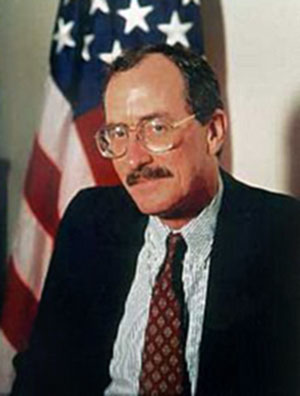
Robert Conway Frasure was born in Morgantown, West Virginia, on April 20, 1942. He earned a bachelor’s degree from West Virginia University, a master’s degree from London School of Economics, and a Ph.D. from Duke University. Frasure taught at Duke and the University of the South before joining the Foreign Service in 1974. Frasure served in Geneva, Bonn, Lagos, London, Pretoria, Addis Ababa, Estonia as the first post-Soviet ambassador, and the National Security Council as the Africa director. He earned two Department of State Superior Honor Awards for his work.
Frasure’s final position was as deputy assistant secretary of state for the Bureau of European and Canadian Affairs. On August 19, 1995, he was one of three American diplomats and a French soldier killed while traveling to Sarajevo on a mission to negotiate a U.S. proposal to end the conflict in Bosnia. Driving down Mt. Igman road, “the most dangerous road in Europe,” to reach Sarajevo after the Serbs refused to guarantee safe landing to the Sarajevo airport, the rain-soaked dirt road collapsed beneath the French armored personnel carrier in which he was a passenger, sending the vehicle down a 500-meter slope into a ravine. Ambassador Richard Holbrook and General Wesley Clarke, traveling in the same convoy in a U.S. Army Humvee, made it through. Frasure was age 53. He is buried in Arlington National Cemetery.
Frasure was posthumously awarded the Presidential Citizens Medal for his role in Operation Solomon, the transportation of nearly 15,000 Ethiopian Jews to Israel. The Department of State’s Robert C. Frasure Memorial Award for commitment to peace and the alleviation of human suffering is named in his honor.
[Sources: https://www.findagrave.com/memorial/7986692/robert-conway-frasure; https://en.wikipedia.org/wiki/Robert_C._Frasure.]
 §
§
Joseph J. Kruzel
Vehicle Accident — Bosnia 1995
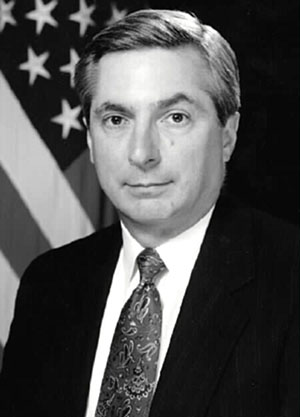
Joseph John Kruzel was born in Goldsboro, North Carolina, on May 6, 1945. He graduated from the Air Force Academy in 1967 and spent seven years on active duty working as an intelligence officer in Vietnam, a briefing officer for the Joint Chiefs of Staff and a member of the U.S. delegation to the Strategic Arms Limitation Talks in Finland. After earning a Ph.D. from Harvard University, Kruzel was a civilian Department of Defense employee working as a special assistant to the Secretary of Defense and as legislative assistant for Senator Edward Kennedy. In 1993, he was appointed deputy assistant secretary of defense for European and NATO Policy. He created the Partnership for Peace to foster positive relations between NATO and the former Warsaw Pact countries.
On August 19, 1995, he was one of three American diplomats and a French soldier killed while traveling to Sarajevo on a mission to negotiate a U.S. proposal to end the conflict in Bosnia. Driving down Mt. Igman road, “the most dangerous road in Europe,” to reach Sarajevo after the Serbs refused to guarantee safe landing to the Sarajevo airport, the rain-soaked dirt road collapsed beneath the French armored personnel carrier in which he was a passenger, sending the vehicle down a 500-meter slope into a ravine. Ambassador Richard Holbrook and General Wesley Clarke, traveling in the same convoy in a U.S. Army Humvee, made it through. Kruzel was age 50. He is buried in Arlington National Cemetery.
[Sources: https://www.findagrave.com/memorial/7986746/joseph-john-kruzel.]
 §
§
Ronald H. Brown
Plane Crash — Croatia 1996
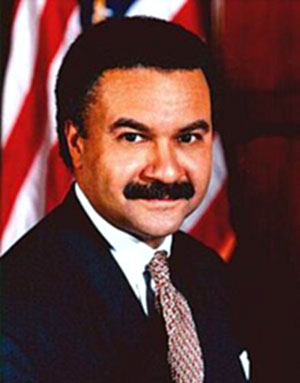
Ronald Harmon Brown was born in Washington, D.C. on August 1, 1941, and grew up in Harlem, New York. He graduated from Middlebury College and joined the U.S. Army in 1962, serving in South Korea and Europe before earning a law degree from St. John’s University. Brown served Deputy Executive Director for Programs and Governmental Affairs of the National Urban League before becoming the manager of Senator Edward Kennedy’s presidential campaign. He later headed Jesse L. Jackson’s 1988 convention team at the Democratic National Convention and served as chairman of the Democratic National Committee, playing a key role in Bill Clinton’s successful 1992 presidential campaign.
In 1993, President Clinton appointed Brown Secretary of Commerce. On April 3, 1996, while on an official trade mission, Brown was one of 35 people killed when the U.S. Air Force aircraft crashed into a mountainside on approach to Croatia’s Dubrovnik Airport. Investigators attributed the accident to pilot error and a poorly designed landing approach. He was 54 years old. He is buried in Arlington National Cemetery.
In May 1996, the State Department placed a large bronze plaque in the Department’s C Street Lobby listing the names of all who perished, including Department of Commerce employees, private businesspeople, and the Air Force flight crew.
[Sources: https://en.wikipedia.org/wiki/Ron_Brown; Foreign Service Journal, June 1996, Pages 1–3 of AFSA News section.]
 §
§
Lee F. Jackson
Plane Crash — Croatia 1996
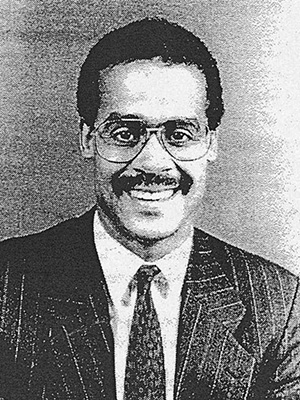
Lee Frazer Jackson was born in Glen Ridge, New York, on May 12, 1958. He earned a bachelor’s degree from Williams College and an M.B.A. from Stanford University’s Graduate School of Business in 1983. Jackson then began work as an investment banker and from 1988 to 1993 was the treasurer of the city of Boston.
Jackson later became the U.S. Executive Director representing the U.S. in the European Bank for Reconstruction and Development – a U.S. Government position overseen by the Department of the Treasury. On April 3, 1996, while on an official trade mission, Jackson was one of 35 people killed when the U.S. Air Force aircraft crashed into a mountainside on approach to Croatia’s Dubrovnik Airport. Investigators attributed the accident to pilot error and a poorly designed landing approach. He was 37 years old. He is buried in Blandford Cemetery in Petersburg, Virginia.
In May 1996, the State Department placed a large bronze plaque in the Department’s C Street Lobby listing the names of all who perished, including Department of Commerce employees, private businesspeople, and the Air Force flight crew.
[Sources: “Virginian Killed on Croatian Trip Buried,” Richmond Times-Dispatch, Richmond, Virginia, April 17, 1996, Page 115, online at Newspapers.com; “Lee Frazer Jackson,” Findagrave.com, Memorial ID: 145531432; Foreign Service Journal, June 1996, Pages 1–3 of AFSA News section; Ancestry.com records.]
 §
§
Stephen C. Kaminski
Plane Crash — Croatia 1996
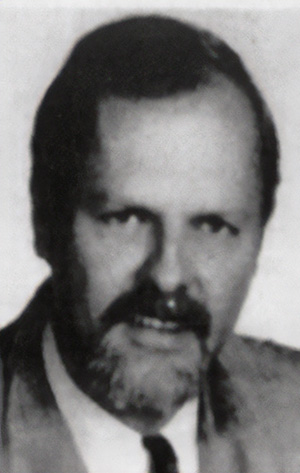
Stephen Constantine Kaminski was born in Baltimore, Maryland, on October 10, 1954. A graduate of Georgetown University’s School of Foreign Service, he joined the Foreign Service with the Department of Commerce and served for 21 years in postings including Dusseldorf, Hamburg, and Tokyo. In 1994, Kaminski received the Commerce Department’s Gold Medal Award for his role in a settlement that opened the Japanese public works market to American businesses. In his free time while serving domestically, he volunteered at Loyola High School and Johns Hopkins University and housed foreign exchange students.
Kaminski’s final post was as counselor for Commercial Affairs at U.S. Embassy Vienna, Austria. On April 3, 1996, while on an official trade mission, Kaminski was one of 35 people killed when the U.S. Air Force aircraft crashed into a mountainside on approach to Croatia’s Dubrovnik Airport. Investigators attributed the accident to pilot error and a poorly designed landing approach. He was 41 years old. He was survived by his wife and a 12-year-old daughter for whom AFSA created a memorial fund to help pay for her education. He is buried in Loudon Park Cemetery in Baltimore, Maryland.
In May 1996, the State Department placed a large bronze plaque in the Department’s C Street Lobby listing the names of all who perished, including Department of Commerce employees, private businesspeople, and the Air Force flight crew.
[Sources: “Stephen Constantine Kaminski,” Findagrave.com, Memorial ID: 115366477; Foreign Service Journal, June 1996, Pages 1–3 of AFSA News section; Foreign Service Journal, July 1996, Page 1 of AFSA News Section; Ancestry.com records.]
 §
§
Leslianne Shedd
Plane Crash — Comoros 1996
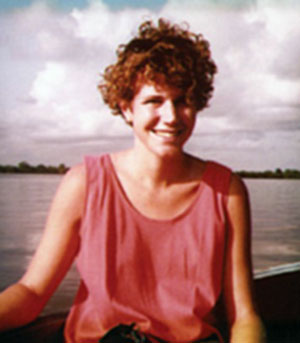
Leslianne Shedd was born in Binghamton, New York, in 1968 and grew up in Washington state. She graduated from the Jackson School of International Studies at the University of Washington. She joined the Central Intelligence Agency in 1991, serving in U.S. embassies in west and east Africa.
On November 24, 1996, Shedd was among 125 people out of 175 passengers and crew who died when a drunken group hijacked the plane on which they were passengers and flew it until it ran out of fuel, crashing into the Indian Ocean near the Comoro Islands. According to survivors, she comforted passengers as the plane was crashing. She was 28 years old.
Note: When a CIA employee working under Department of State cover dies in qualifying circumstances, AFSA inscribes their name on the plaque. If the CIA later acknowledges their employment, AFSA updates the biographic information on this webpage.
[Source: https://www.cia.gov/legacy/honoring-heroes/heroes/leslianne-shedd/]
 §
§
Philip Thomas Lincoln, Jr.
Automobile Accident — China 1996
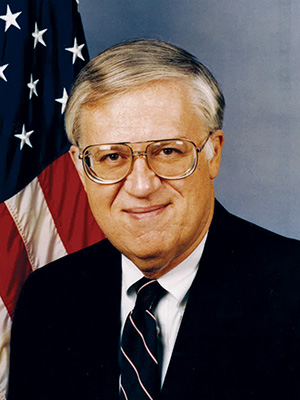
Philip Thomas Lincoln, Jr., was born in Jackson, Michigan, on April 2, 1942. He graduated from the University of Michigan, earned two graduate degrees from the Fletcher School of Law and Diplomacy at Tufts University, and did graduate work in economics and Chinese studies at the University of Michigan.
Lincoln joined the Foreign Service in 1966. His assignments included Beijing, Taipei, Seoul, Sidney, and Washington. His final post was as U.S. Consul General in Guangzhou, China. On December 2, 1996, Lincoln died in a car accident while on official business in the Guangxi Zhuang Autonomous Region. He was 54 years old. He was survived by his wife, three children, and his extended family. He is buried in Mount Evergreen Cemetery in Jackson, Michigan.
[Sources: Jackson Citizen Patriot, Jackson, Michigan, December 6, 1996, Page 22, online at Newspapers.com; “Philip Thomas Lincoln Jr.,” Findagrave.com, Memorial ID: 128087248; Foreign Service Journal, April 1997, Page 53; Ancestry.com records.]
 §
§
Jesse Nathanael Aliganga
Nairobi Embassy Bombing — Kenya 1998
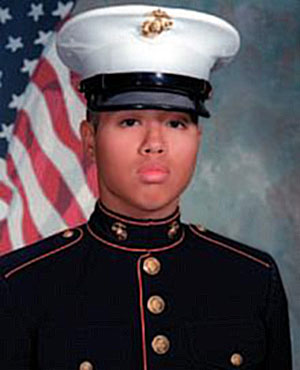
Jesse Nathanael “Nathan” Aliganga was born in Alameda, California, on October 17, 1976. He grew up in Pensacola, Florida, and enlisted in the U.S. Marine Corps after graduating from high school. His postings included in Okinawa with the 3rd Marine Division and Camp Pendleton with the Foreign Service Support Group. In January 1998, Sergeant Aliganga began training at the Marine Security Guard School. His first assignment was at U.S. Embassy Nairobi, Kenya.
On August 7, 1998, he and 11 other Americans were killed in the terrorist truck bombing attack on U.S. Embassy Nairobi. The bombing was simultaneous with a suicide bomb attack on U.S. Embassy Dar es Salaam, Tanzania. The twin attacks killed 224 people -- including 32 Foreign Service Nationals in Nairobi and 10 in Dar es Salaam -- and wounded over 4,000. The attacks were conducted by the al-Qaeda network and ordered by Osama bin Laden. He was 21 years old.
[Sources: https://embassymarine.org/page/The-Fallen; https://navylog.navymemorial.org/aliganga-jesse; https://2017-2021.state.gov/sgt-jesse-nathanael-aliganga-a-marine-a-life-cut-short-by-terrorists/; https://ke.usembassy.gov/history/; https://afsa.org/reflections-us-embassy-bombings-kenya-and-tanzania; Ancestry.com records.]
 §
§
Julian Leotis Bartley, Sr.
Nairobi Embassy Bombing — Kenya 1998
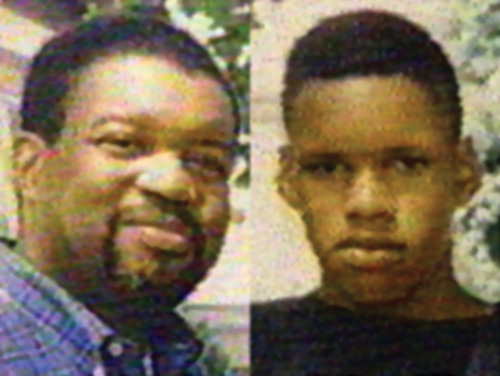
Julian Leotis Bartley, Sr. was born in Florida on May 28, 1944, and raised in Queens, New York. After graduating college, he joined the Peace Corps and later became a high school teacher before joining the Foreign Service. During 27 years of service, he was posted to Santo Domingo, Bogotá, Madrid, Tel Aviv, and Seoul. Bartley’s final post was as U.S. Consul General at U.S. Embassy Nairobi, Kenya.
On August 7, 1998, he, his son Julian Jr. “Jay” Bartley (an intern at the embassy), and 10 other Americans were killed in the terrorist truck bombing attack on U.S. Embassy Nairobi. The bombing was simultaneous with a suicide bomb attack on U.S. Embassy Dar es Salaam, Tanzania. The twin attacks killed 224 people -- including 32 Foreign Service Nationals in Nairobi and 10 in Dar es Salaam -- and wounded over 4,000. The attacks were conducted by the al-Qaeda network and ordered by Osama bin Laden. He was 54 years old and his son Jay was 21 and was about to start his sophomore year in college. They were both laid to rest in Arlington National Cemetery.
Memorials to the bombing victims are located in Arlington National Cemetery (Section 51), the Harry S Truman Building (South Courtyard outside of C Street Lobby – includes names of American and FSN employees), the site of the former U.S. embassy in Nairobi, and the National Museum of Tanzania.
[Sources: “Julian Leotis Bartley Sr.,” Findagrave.com, Memorial ID: 4488; “Julian ‘Jay” Bartley Jr.,” Findagrave.com, Memorial ID: 49119964; https://ke.usembassy.gov/history/; https://afsa.org/reflections-us-embassy-bombings-kenya-and-tanzania; Ancestry.com records.]
 §
§
Molly Huckaby Hardy
Nairobi Embassy Bombing — Kenya 1998
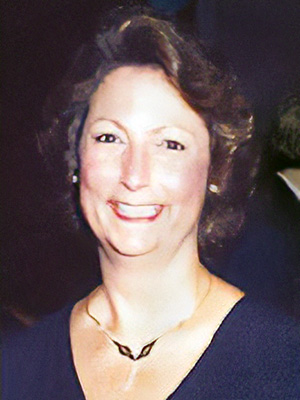
Molly Huckaby Hardy was born in Atlanta on December 15, 1946, and resided in Valdosta, Georgia. She moved to Washington, D.C. when her husband joined the Central Intelligence Agency. After accompanying him on an overseas assignment, she joined the CIA in 1975 as a payroll clerk and finance assistant. In 23 years of service, she worked domestically and overseas In 1998, she was CIA regional finance officer at U.S. Embassy Nairobi, Kenya.
On August 7, 1998, she and 11 other Americans were killed in the terrorist truck bombing attack on U.S. Embassy Nairobi. The bombing was simultaneous with a suicide bomb attack on U.S. Embassy Dar es Salaam, Tanzania. The twin attacks killed 224 people -- including 32 Foreign Service Nationals in Nairobi and 10 in Dar es Salaam -- and wounded over 4,000. The attacks were conducted by the al-Qaeda network and ordered by Osama bin Laden. She was 51 years old. She is buried in Riverview Memorial Gardens in Valdosta, Georgia.
Note: When a CIA employee working under Department of State cover dies in qualifying circumstances, AFSA inscribes their name on the plaque. If the CIA later acknowledges their employment, AFSA updates the biographic information on this webpage.
[Sources: https://www.cia.gov/stories/story/us-embassy-bombings-in-east-africa/; “Molly Huckaby Hardy,” Findagrave.com, Memorial ID: 50729795; https://ke.usembassy.gov/history/; https://afsa.org/reflections-us-embassy-bombings-kenya-and-tanzania; Ancestry.com records.]
 §
§
Kenneth R. Hobson II
Nairobi Embassy Bombing — Kenya 1998
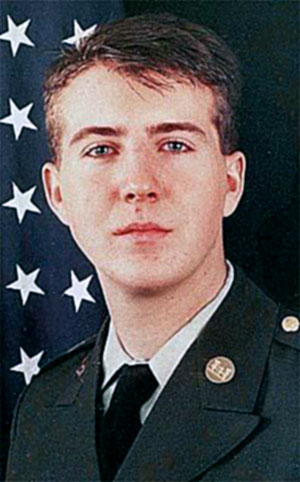
Kenneth R. Hobson II was born on May 1, 1971, in Placerville, California, and was raised in western Missouri. He enlisted in the U.S. Army in 1989, serving in the Persian Gulf War and Germany. Rising to the rank of staff sergeant, Hobson joined the office of the Defense Attaché at U.S. Embassy Nairobi, Kenya, in December 1997.
On August 7, 1998, he and 11 other Americans were killed in the terrorist truck bombing attack on U.S. Embassy Nairobi. The bombing was simultaneous with a suicide bomb attack on U.S. Embassy Dar es Salaam, Tanzania. The twin attacks killed 224 people -- including 32 Foreign Service Nationals in Nairobi and 10 in Dar es Salaam -- and wounded over 4,000. The attacks were conducted by the al-Qaeda network and ordered by Osama bin Laden. Hobson was 27 years old. He was survived by his wife and a daughter, with a second daughter born eight months after his death. He is buried in Memory Gardens Cemetery in Lamar, Missouri.
[Sources: https://www.dia.mil/About/Patriots-Memorial/; “Ssgt Kenneth Ray Hobson II, Findagrave.com, Memorial ID: 169246722; https://ke.usembassy.gov/history/; https://afsa.org/reflections-us-embassy-bombings-kenya-and-tanzania; Ancestry.com records.]
 §
§
Prabhi G. Kavaler
Nairobi Embassy Bombing — Kenya 1998
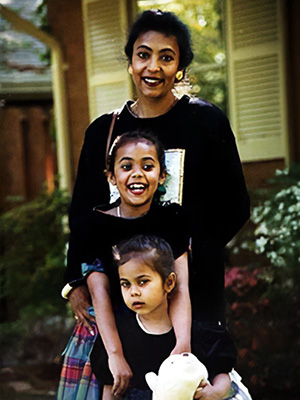
Prabhi Guptara Kavaler was born in Amritsar, India on December 3, 1952. She became a U.S. citizen after marrying Foreign Service officer Howard C. Kavaler. She joined the Foreign Service in 1987 and served in Manila, Paris, and Washington, D.C. In 1998, she was a consular officer at U.S. Embassy Nairobi, Kenya.
On August 7, 1998, she and 11 other Americans were killed in the terrorist truck bombing attack on U.S. Embassy Nairobi. Her husband had left the embassy only a few minutes earlier. The bombing was simultaneous with a suicide bomb attack on U.S. Embassy Dar es Salaam, Tanzania. The twin attacks killed 224 people -- including 32 Foreign Service Nationals in Nairobi and 10 in Dar es Salaam -- and wounded over 4,000. The attacks were conducted by the al-Qaeda network and ordered by Osama bin Laden. She was 45 years old. She was survived her husband and two daughters. Kavaler is buried in Arlington National Cemetery.
Memorials to the bombing victims are located in Arlington National Cemetery (Section 51), the Harry S Truman Building (South Courtyard outside of C Street Lobby – includes names of American and FSN employees), the site of the former U.S. embassy in Nairobi, and the National Museum of Tanzania.
[Sources: Miles, Donna, “Healing the Wounds of Nairobi,” State Magazine, July/August 1999, online at https://1997-2001.state.gov/publications/statemag/statemag_jul99/feature3.html; “Prabhi Guptara Kavaler,” Findagrave.com, Memorial ID: 4486; https://1997-2001.state.gov/publications/statemag/statemag_dec98/obituary.html; Ancestry.com records.]
 §
§
Michelle O’Connor
Nairobi Embassy Bombing — Kenya 1998
Ann Michelle Deney O’Connor was born in Baton Rouge, Louisiana, on October 7, 1961. She graduated from Louisiana State University and joined the Foreign Service in 1987. She served as a consular officer in Bridgetown, an administrative officer in Guayaquil, a general services officer in Montevideo, and was posted to Nairobi in 1996 as a general services officer.
On August 7, 1998, she and 11 other Americans were killed in the terrorist truck bombing attack on U.S. Embassy Nairobi. Her husband had left the embassy only a few minutes earlier. The bombing was simultaneous with a suicide bomb attack on U.S. Embassy Dar es Salaam, Tanzania. The twin attacks killed 224 people -- including 32 Foreign Service Nationals in Nairobi and 10 in Dar es Salaam -- and wounded over 4,000. The attacks were conducted by the al-Qaeda network and ordered by Osama bin Laden. She was 36 years old. She was survived by her husband and three daughters. She is buried in Fairmount Cemetery in Polo, Illinois.
Memorials to the bombing victims are located in Arlington National Cemetery (Section 51), the Harry S Truman Building (South Courtyard outside of C Street Lobby – includes names of American and FSN employees), the site of the former U.S. embassy in Nairobi, and the National Museum of Tanzania.
[Sources: “Embassy Victim is Buried in Husband’s Illinois Town,” The Belleville News-Democrat, Belleville, Illinois, August 19, 1998, Page 5, online at Newspapers.com; Miles, Donna, “The Bombings One Year Later: Washington Remembers, State Magazine, October 1999, Page 18; “Ann Michelle Deney O’Connor,” Findagrave.com; Memorial ID: 5966957; https://1997-2001.state.gov/publications/statemag/statemag_dec98/obituary.html; Ancestry.com records.]
 §
§
Sherry Lynn Olds
Nairobi Embassy Bombing — Kenya 1998
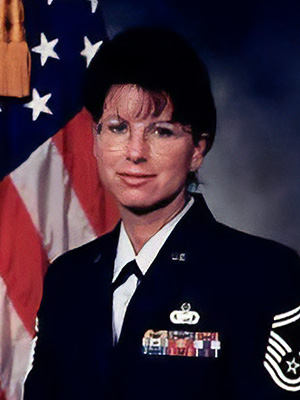
Sherry Lynn Olds was born in Panama City, Florida, on July 16, 1958. She graduated from the University of South Carolina and joined the U.S. Air Force, serving for 20 years including in Korea, Saudi Arabia, and Tyndall Air Force Base. Olds rose to the rank of senior master sergeant. Her final post was at U.S. Embassy Nairobi, Kenya, working in the Military Assistance Office.
On August 7, 1998, she and 11 other Americans were killed in the terrorist truck bombing attack on U.S. Embassy Nairobi. The bombing was simultaneous with a suicide bomb attack on U.S. Embassy Dar es Salaam, Tanzania. The twin attacks killed 224 people -- including 32 Foreign Service Nationals in Nairobi and 10 in Dar es Salaam -- and wounded over 4,000. The attacks were conducted by the al-Qaeda network and ordered by Osama bin Laden. Olds was 40 years old. She is buried in Evergreen Memorial Gardens in Panama City, Florida.
[Sources: “Friends Remember Victim’s Dedication,” Pensacola News-Journal, Pensacola, Florida, August 16, 1998, Page 4, online at Newspapers.com; “Smsgt Sherry Lynn Olds,” Findagrave.com, Memorial ID: 5966775; Ancestry.com.]
 §
§
Uttamlal Thomas “Tom” Shah
Nairobi Embassy Bombing — Kenya 1998
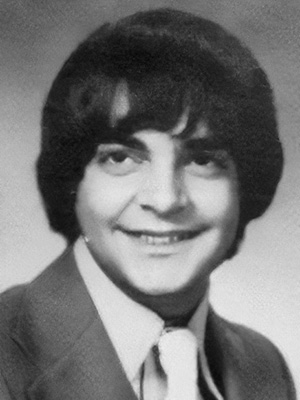
Uttamlal Thomas “Tom” Shah was born in Chicago, Illinois on July 14, 1961. He earned music degrees at the Berklee College of Music and Ball State University School of Music. Shah joined the Foreign Service in 1987, serving in Cairo, Damascus, and Washington. His last assignment was on temporary duty as a political officer at U.S. Embassy Nairobi, Kenya.
On August 7, 1998, he and 11 other Americans were killed in the terrorist truck bombing attack on U.S. Embassy Nairobi. The bombing was simultaneous with a suicide bomb attack on U.S. Embassy Dar es Salaam, Tanzania. The twin attacks killed 224 people -- including 32 Foreign Service Nationals in Nairobi and 10 in Dar es Salaam -- and wounded over 4,000. The attacks were conducted by the al-Qaeda network and ordered by Osama bin Laden. He was 37 years old. Shah is buried in Bremen Municipal Cemetery in Bremen, Indiana.
[Sources: “St. X grad buried in Indiana,” The Cincinnati Enquirer, Cincinnati, Ohio, August 22, 1998, Page 5, online at Newspapers.com; “Uttamlal Thomas ‘Tom’ Shah,” Findagrave.com, Memorial ID: 5966859; Ancestry.com records.]
 §
§
Seth John Foti
Plane Crash — Bahrain 2000
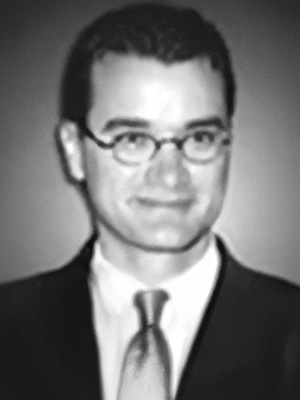
Seth John Foti was born on May 21, 1969, and lived in Browntown, Virginia. Graduating from George Mason University, he worked as a contractor at U.S. Embassy Moscow in the early 1990s. He joined the Foreign Service as a diplomatic courier in 1999 and was based in Bahrain. Just 14 months after becoming a diplomatic courier and two months after marrying his wife, he and 142 others died on August 23, 2000, in the crash of a Gulf Air Flight in shallow waters north of Bahrain International Airport. U.S. Navy divers later recovered the diplomatic pouches. He was 31 years old. He was survived by his wife and mother.
[Sources: https://www.state.gov/biographies/seth-foti/; “Virginian was the only American aboard downed plane,” The Free Lance-Star, Fredericksburg, Virginia, August 26, 2000, Page 25, online at Newspapers.com; Foreign Service Journal, December 2000, Page 84; Ancestry.com records.]
 §
§
Barbara J. Green
Terrorist Attack — Pakistan 2002
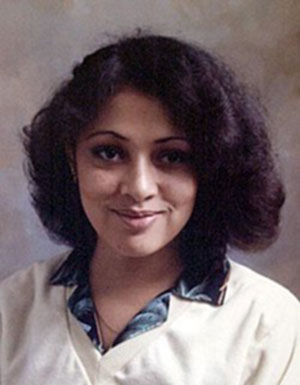
Barbara Jean McGuine Green was born in Richmond, California on September 4, 1962, and lived in Maryland. She served in the U.S. Air Force before marrying Foreign Service specialist Milton Green and accompanying him on postings in Bonn, Abidjan, and Beijing, working in the administrative section at each embassy.
In 2002, she was working in the Human Resources Center at U.S. Embassy Islamabad, Pakistan. On March 17, 2002, she and her teenage daughter Kristen Wormsley Green were killed when terrorists threw grenades inside the city’s Protestant International Church. Barbara was 39 years old and Kristen was 17. She was survived by her husband and 11 year old son. She and her daughter are buried in Columbia Memorial Park in Columbia, Maryland. AFSA helped establish a fund to help pay for her son’s education.
[Sources: “Barbara Jean McGuine Green,” Findagrave.com, Memorial ID: 97334214; Kristen M. Wormsley Green, Findagrave.com, Memorial ID: 97334015; Foreign Service Journal, July-August 2002, Page 54; Foreign Service Journal, November 2002, Pages 34-35; Ancestry.com records.]
 §
§
Laurence M. Foley
Terrorist Attack — Jordan 2002
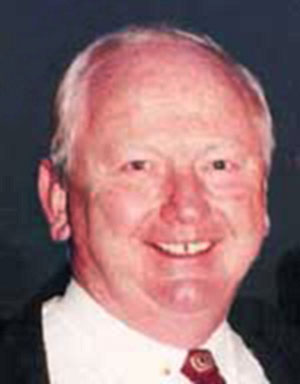
Laurence Michael Foley, Sr. was born in Boston, Massachusetts, on October 5, 1942. He graduated from the University of Massachusetts and San Francisco State University and served with the Peace Corps as both a volunteer in India and an associate director in the Philippines. He worked for several years as a supervising probation officer for Contra Costa County, California
He joined the U.S. Agency for International Development in 1988 and served in Bolivia, Peru, and Zimbabwe. His final posting was at U.S. Embassy Amann, Jordan, as USAID supervisory executive officer. On October 28, 2002, Foley was killed outside his home in Amman by gunmen with terror connections as he walked to his car to go to the embassy. He was 60 years old. He was survived by his wife, two daughters, and a son.
[Sources: Foreign Service Journal, January 2003; Pages 61-62; Ancestry.com records.]
 §
§
Edward J. Seitz
Rocket Attack — Iraq 2004
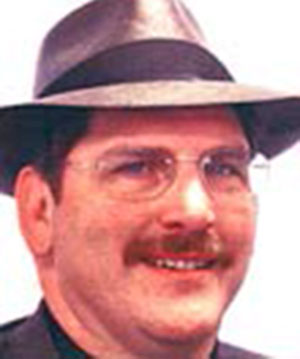
Edward Joseph “Eddie” Seitz was born in Parma, Ohio, on February 17, 1963. He graduated from Baldwin-Wallace College and served as a police officer in Cleveland Heights, Ohio, before joining the Foreign Service as a Diplomatic Security Special Agent. During 16 years of service, he worked on the Joint Terrorism Task Force and in Washington, Chicago, Detroit, Denver, Shenyang, and Sanaa.
During his lifetime, Seitz received a group superior honor award for his role in the response to the terrorist bombing of the U.S. Embassy in Nairobi, a group meritorious honor award for his service on the protective detail for Secretary of State Madeleine Albright and a meritorious service increase for exemplary performance as a diplomatic courier.
Seitz’s last post was as an Assistant Regional Security Officer at U.S. Embassy Baghdad, Iraq. Seitz was killed on October 24, 2004, in a mortar attack on Camp Victory near Baghdad International Airport. He was 41 years old.
[Sources: “Edward Joseph Seitz,” Findagrave.com, Memorial ID: 193896840; Shawn Zeller, “Extreme Diplomacy: Evaluating Embassy Baghdad,” Foreign Service Journal, March 2005, Pages 17-18; https://www.state.gov/biographies/edward-joseph-seitz/; Ancestry.com records.]
 §
§
James Mollen
Terrorist Attack — Iraq 2004
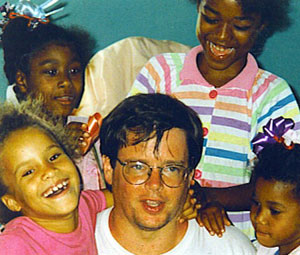
James Charles Mollen was born in Norwich, New York, on November 2, 1956, and lived in Binghamton, New York. He worked in the 2000 presidential election campaign of George W. Bush before joining the Department of State in 2002 as a political appointee to head the Global Technology Corps in the Bureau of International Information Programs. He went to Iraq in 2003 to work in the Coalition Provisional Authority. His final assignment was as U.S. special advisor to Iraq’s Ministry of Higher Education and Scientific Research. On November 24, 2004, Mollen was killed by a gunman near the fortified sector of central Baghdad. He was 48 years old. He was survived by his parents and four brothers. Mollen is buried in Calvary Cemetery in Johnson City, New York.
[Sources: Foreign Service Journal, February 2005, Page 68; “James Charles Mollen,” Findagrave.com, Memorial ID: 101651211; Ancestry.com records.]
 §
§
Barbara C. Heald
Rocket Attack on U.S. Embassy — Iraq 2005
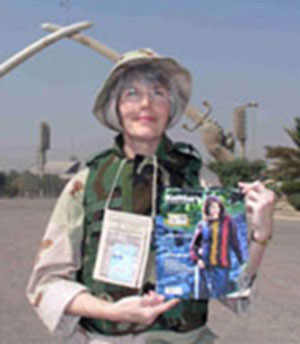
Barbara Carol (Geis) Heald was born on May 17, 1944, in Stamford, Connecticut, and lived in Falls Church, Virginia. She served as a U.S. Air Force captain and later retired from the U.S. Department of Agriculture. In Iraq in 2005 as a civilian employee of the U.S. Army's Project and Contracting Office, Heald died on January 29, 2005, while working at her desk when a rocket hit the U.S. Embassy Baghdad complex. She was 60 years old. She was buried in Arlington National Cemetery, The Barbara C. Heald Deployed Civilian Award was named in her honor.
[Sources: Foreign Service Journal, July-August 2006, Page 75; “Barbara Carol Geis Heald,” Findagrave.com, Memorial ID: 15207825; Ancestry.com records.]
 §
§
Keith E. Taylor
Rocket Attack on U.S. Embassy — Iraq 2005
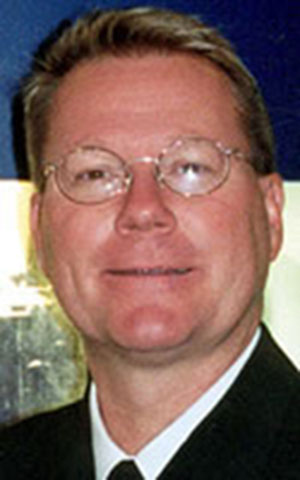
Keith Edward Taylor was born in Tucson, Arizona, on December 21, 1957, and lived in Irvine, California. He enlisted in the U.S. Navy after graduating high school and reached the rank of lieutenant commander with tours in Haiti, Bosnia, and Kosovo. In Iraq in 2005 as a contracting officer for U.S. Army's Project and Contracting Office, he died on January 29, 2005, when a rocket hit the U.S. Embassy Baghdad complex. He was 47 years old. He was survived by his wife, three children, and an extended family. He is buried in Arlington Park Cemetery in Jacksonville, Florida.
[Sources: Foreign Service Journal, July-August 2006, Page 75; “Lcdr Keith Edward Taylor,” Findagrave.com, Memorial ID: 10422127; Ancestry.com records.]
 §
§
Stephen E. Sullivan
Terrorist Attack — Iraq 2005
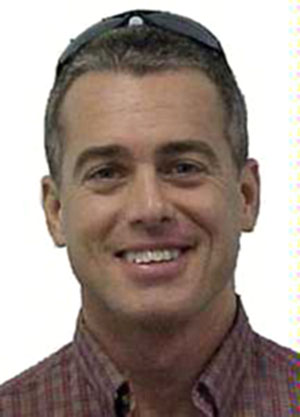
Stephen Eric Sullivan was born on May 17, 1965, and raised in Westborough, Massachusetts. After graduating from high school in 1983, he joined the U.S. Marine Corps, where he served as a field radio operator. In 1992 he earned a bachelor’s degree in criminal justice, and the following year joined the Navy, where he served as a hospital corpsman. Sullivan also worked with at-risk youth and children with special needs.
He joined the Foreign Service as a Diplomatic Security Special Agent in 2002. Serving as acting Regional Security Officer for the Regional Embassy Office in Mosul, Iraq, he was killed on September 19, 2005, when a suicide car bomber crashed into his vehicle in a chief-of-mission motorcade near Mosul. He was survived by his son, his parents, and two sisters. Sullivan is buried at Saint Luke’s Cemetery in Worcester County, Maryland.
[Sources: Foreign Service Journal, July-August 2006, Page 75; “Stephen Eric Sullivan,” Findagrave.com, Memorial ID: 12803983; Ancestry.com records.]
 §
§
David E. Foy
Terrorist Attack — Pakistan 2006
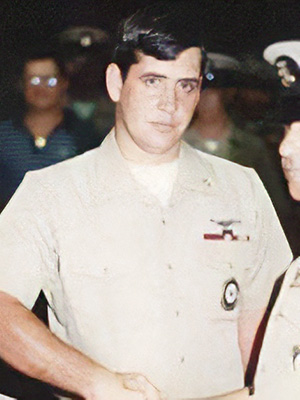
David Elmo Foy was born on March 29, 1954, in Fort Smith, Arkansas and resided in Goldsboro, North Carolina. After a 23-year career in the U.S. Navy and two years as a civilian employee at Fort Bragg, North Carolina, he joined the Foreign Service as a facilities manager in 2003 and was first posted to Bishkek.
Working as facilities manager at U.S. Consulate Karachi, Pakistan, on March 2, 2006, he and his driver were killed by a suicide bomber as he was about to enter the consulate. He was 51 years old and was survived by his wife, and four daughters. Foy is buried in Arlington National Cemetery. The State Department’s David E. Foy Memorial Award for excellence in facility management is named in his honor.
[Sources: Foreign Service Journal, May 2006, Pages 62-63; Foreign Service Journal, July-August 2006, Page 75; “Bomb Kills Diplomat From N.C.,” The News and Observer, Fayetteville, North Carolina, March 3, 2006, Page A1, online at Newspapers.com; “David Elmo Foy,” Findagrave.com; Memorial ID: 49184100; Ancestry.com records.]
 §
§
Margaret Alexander
Helicopter Crash — Nepal 2006
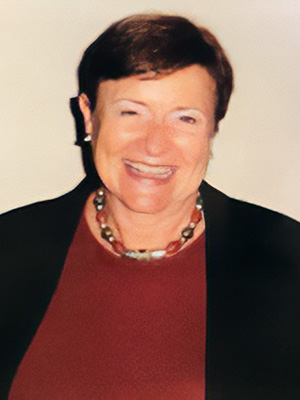
Margaret Ruth Alexander was born in New York City on December 10, 1949, and grew up in Iowa. She graduated from Bryn Mawr College Pennsylvania in 1971 with a degree in Classical and Near Eastern Archaeology, performed graduate work at Columbia University’s Department of Art History and Archaeology, and earned a J.D. from the University of Pennsylvania Law School in 1980. She then worked as a law clerk for the U.S. District Court for the District of Delaware and practiced law with a law firm in Washington, D.C.
Alexander joined the U.S. Agency for International Development as a Foreign Service officer in 1987 working as a legal officer in the Office of the General Counsel. She later served as senior regional legal advisor in East and Central Africa, the Caribbean and Western and Central Africa; assistant general counsel for the Europe and Eurasia Bureau; and chief of the regional legal office in Southern Africa.
Alexander’s final post was as deputy USAID mission director in Kathmandu, Nepal. She, a USAID Foreign Service National employee, and others died in a helicopter crash there on September 23, 2006, while returning from visiting a project site. She was 56 years old and was survived by her sister.
[Sources: Foreign Service Journal, December 2006, Page 80; Ancestry.com records.]
 §
§
Steven Thomas Stefani, IV
Killed by Bomb — Afghanistan 2007
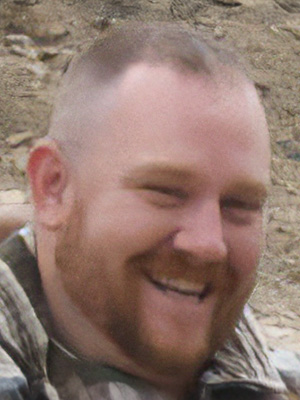
Steven Thomas Stefani IV was born in Lakewood, California, on December 3, 1978. He earned bachelor’s and master’s degrees from the University of Nevada – Reno. He worked with the U.S. Forest Service as a rangeland management specialist in northeast Nevada on the Humboldt-Toiyabe National Forest.
In 2006, he volunteered to serve in Afghanistan on a Provincial Reconstruction Team as a U.S. Department of Agriculture advisor in Ghazni province. There, he worked to create plans for a poultry rearing facility, taught local farmers how to renew soil and replant bare hillsides with trees, and helped with the construction of poultry rearing and cold storage facilities to help farmers preserve their produce. On October 4, 2007, Stefani was killed by a roadside bomb that detonated near his convoy. His goal of building a playground for Ghazni children was completed after his death. He was 28 years old and was survived by his parents, two brothers, and girlfriend of five years.
[Sources: Foreign Service Journal, December 2007, Pages 10-11; Foreign Service Journal, June 2008, Page 60; “Bomb Kills Auburn Man Working in Afghanistan,” The Sacramento Bee, Sacramento, California, October 8, 2007, Page 15, online at Newspapers.com; “Steven Thomas ‘Steve’ Stefani,” Findagrave.com, Memorial ID: 21983151; Ancestry.com records.]
 §
§
John Michael Granville
Vehicle Ambush — Sudan 2008
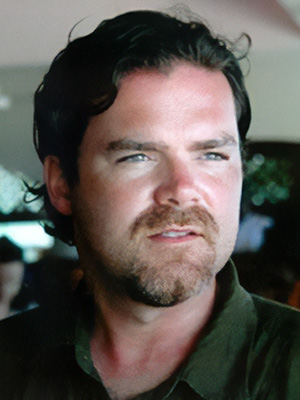
John Michael Granville was born in Buffalo, New York, on September 25, 1974. He earned a bachelor’s degree from Fordham University and joined the Peace Corps in 1997 serving in Cameroon for two years. In 2003, he earned a master’s degree in international development from Clark University before studying in Africa as a Fulbright Fellow.
Granville became a democracy and governance Foreign Service officer with the U.S. Agency for International Development in 2004 working first in Kenya and then in Sudan. During the latter assignment, he headed a program to give 75,000 solar-power radios to South Sudanese citizens. On January 1, 2008, Granville and his Foreign Service National driver were killed by a gunman from the terrorist group Ansar al-Tawhid on the way home after a new year’s party at the British Embassy in Khartoum, Sudan. He was 33 years old and was survived by his mother and sister.
[Sources: Foreign Service Journal, March 2008, Page 73; Foreign Service Journal, June 2008, Page 60; Valley News, West Lebanon, New Hampshire, January 2, 2008, Page 9, online at Newspapers.com; “John Michael Granville,” Findagrave.com. Memorial ID: 23703746; Ancestry.com records.]
 §
§
Steven L. Farley
Terrorist Attack — Iraq 2008
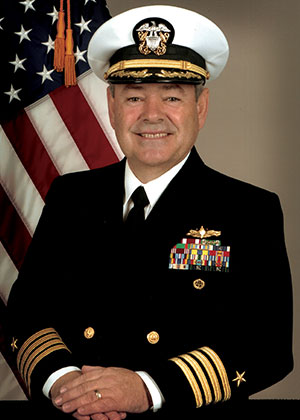
Steven Farley was born in Oklahoma and joined the U.S. Army in 1970. After serving in Korea, he resigned to complete college. He re-entered military life upon being commissioned as an officer in the U.S Navy in 1980. After leaving active duty in 1984, he remained in the Naval Reserve. In March 2007 as U.S. Navy Captain, he returned to active duty, serving for nearly a year in Iraq on a Provincial Reconstruction Team.
He returned to Iraq in April 2008 as a Department of State civilian employee working as the Senior Advisor in the Governance Directorate in the communities of Sadr City and Adhamiyah. On June 24, 2008, just before a meeting with Sadr City District Council members, an Improvised Explosive Device was detonated, killing him, two U.S. Army soldiers, and a civilian Department of Defense employee. He was 57 years old. He was survived by his wife and three sons. He is buried at Fort Sill National Cemetery in Elgin, Oklahoma.
[Sources: “Guthrie man slain in blast called ‘patriot’”, The Oklahoman, Oklahoma City, Oklahoma, June 25, 2008, Page 1, online at Newspapers.com; Foreign Service Journal, June 2016, Pages 51 and 56.]
 §
§
Brian Daniel Adkins
Murdered in Home — Ethiopia 2009
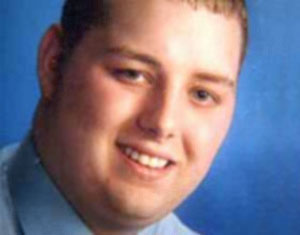
Brian Daniel Adkins was born in Columbus, Ohio, on February 2, 1983. After earning bachelor’s and master’s degrees from The George Washington University, he worked for the Department of Commerce as an international trade specialist before joining the Department of State as a Foreign Service consular officer in 2007. A talented linguist, he spoke seven languages and had previously served as a Pickering Fellow with the State Department in Tunisia. He was in his first assignment at U.S. Embassy Addis Ababa, Ethiopia, when he was stabbed to death and robbed in his Ethiopia home on January 31, 2009. He was 25 years old. Adkins is buried in Obetz Cemetery in Obetz, Ohio.
[Sources: Foreign Service Journal, May 2009, Pages 41-43; “Man confesses to murder of alumnus,” The GW Hatchet, Washington, D.C., April 13, 2009; “Brian Daniel Adkins,” Findagrave.com, Memorial IS: 33791641; Ancestry.com records.]
 §
§
Terrence L. Barnich
Roadside Bomb — Iraq 2009
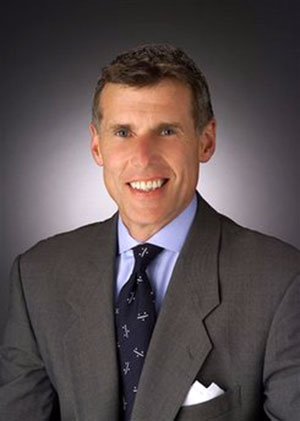
Terrence L. Barnich was born on March 6, 1953, and grew up in Chicago, Illinois. He earned a bachelor’s degree from Georgetown University and a law degree from Fordham University. He worked as general counsel to former Governor James of Illinois, chair of the Illinois Commerce Commission and co-founder of the consulting firm New Paradigm Resources Group, Inc.
Joining the Department of State on a limited non-career Civil Service appointment in 2008, he served as deputy director of the Iraq Transition Assistance Office at U.S. Embassy Baghdad, Iraq. During his time in Baghdad, he played a key role in advising the Iraqi Electricity Ministry and working out an electricity deal with GE to provide power to millions of homes. He was killed by a roadside bomb in Fallujah, Iraq, on May 25, 2009. He was 56 years old. He is buried in Queen of Heaven Catholic Cemetery in Hillside, Illinois.
[Sources: Foreign Service Journal, July-August 2010, Pages 59 and 73; “Ex-state official led efforts to mend Iraq,” Chicago Tribune, Chicago, Illinois, May 27, 2009, Page 21, online at Newspapers.com; “Terrence L. ‘Terry’ Barnich,” Findagrave.com, Memorial ID: 37861711; Ancestry.com records.]
 §
§
Victoria J. DeLong
Earthquake — Haiti 2010
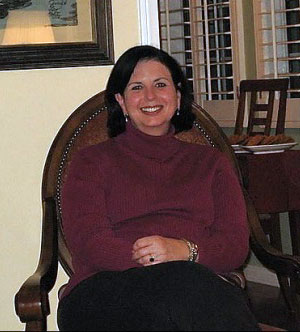
Victoria Jean DeLong was born in Temple City, California, on February 8, 1952. She enlisted in the U.S. Navy in 1973 before earning a bachelor’s degree from National University. DeLong joined the Foreign Service in 1983 and served for 27 years, including in El Salvador, Costa Rica, Papua New Guinea, Germany, Australia, Kuala Lumpur, the Philippines, the Democratic Republic of the Congo, and Mauritius.
DeLong’s final post was at U.S. Embassy Port-au-Prince, Haiti, as a cultural affairs officer. She died in an earthquake that collapsed her home on January 12, 2010. Over 100,000 Haitians died in the earthquake, including numerous embassy Foreign Service National employees. DeLong was 57 years old. She is buried in Rose Hills Memorial Park in Whittier, California.
[Sources: “A Night to Remember,” by David Lindwall, Foreign Service Journal, January-February 2020, Pages 48-53; Foreign Service Journal, April 2010, Pages 45-47; Foreign Service Journal, July-August 2010, Page 73; “Victoria Jean Reynoso DeLong,” Findagrave.com, Memorial ID:124565005; Ancestry.com records.]
 §
§
Dale J. Gredler
Inadequate Medical Facilities — Kazakhstan 2010
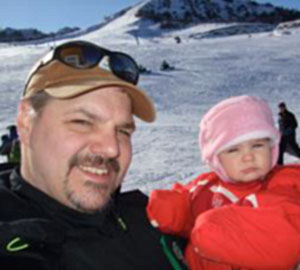
Dale Joseph Gredler was born in Bellevue, Washington, on August 9, 1967, and grew up in Wenatchee, Washington. He earned a bachelor’s degree from Eastern Washington University and a master’s degree in political science and public administration from Illinois State University before volunteering with the Peace Corps in the Philippines. A graduate of the Presidential Management Program, he served as an emergency management program specialist with the Federal Emergency Management Agency before joining the U.S. Agency for International Development as a financial management specialist in 2001.
Gredler served as a contracting officer at U.S. Embassy Jakarta, Indonesia, where he helped with reconstruction efforts after a devastating tsunami, and as supervisory contracting officer for USAID’s regional mission for Central Asia in Almaty, Kazakhstan. He died on January 27, 2010, of a heart attack while being medically evacuated from Almaty to London for treatment. He was 42 years old. He was survived by his wife, two daughters, his parents, a stepfather, and two siblings.
[Sources: Foreign Service Journal, June 2013, Pages 50 and 57; Foreign Service Journal, June 2017, Page 53; “Dale Joseph Gredler, “Findagrave.com, Memorial ID: 135607146; Ancestry.com records.]
 §
§
Sharon S. Clark
Cerebral Malaria — Nigeria 2010
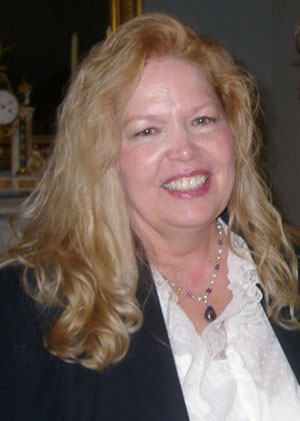
Sharon Sue Weiand Clark was born in Royal Center, Indiana, on May 17, 1953. She was valedictorian of Pioneer High School and briefly attended Purdue University before focusing on raising a family of three children. She later worked in the Johnson County Public Library and earned an associate’s degree in business from the Johnson County Community College.
In 2008 after her children were raised, she joined the Foreign Service as Office Management Specialist. Her first assignment was two years in the Regional Security Officer at U.S. Embassy Abuja, Nigeria. She died at post of cerebral malaria on December 26, 2010. She was 57 years old. Clark is buried in Bell Center Cemetery in Bell Center, Indiana.
[Sources: Foreign Service Journal, June 2012, Pages 45 and 49; “Sharon Sue Weiand Clark,” Findagrave.com, Memorial ID: 78076828; Ancestry.com records.]
 §
§
Ragaei Said Abdelfattah
Bomb Explosion — Afghanistan 2012
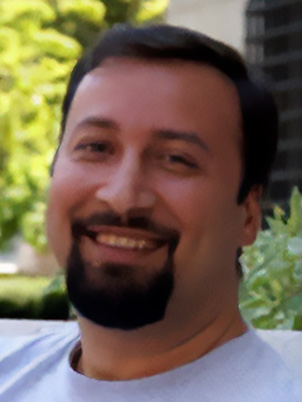
Ragaei Said Abdelfattah was born in Giza, Egypt, on July 8, 1969. After emigrating to the United States, he became a naturalized citizen and worked with the U.N. Development Program in Egypt and the Maryland-National Capital Parks and Planning Commission. At the time of his death, he was pursuing a Ph.D. in planning, governance, and globalization at Virginia Technical University.
Abdelfattah joined the U.S. Agency for International Development as a Foreign Service officer in 2011 and served two tours in Afghanistan on Provincial Reconstruction Teams as a field program officer in economic growth. There, he helped the Afghan government to develop an industrial park in Nangarhar province. Abdelfattah died on August 8, 2012, during a suicide bombing in Kunar Province, Afghanistan. He was 43 years old. He was survived by his wife and two teenage sons.
[Sources: Foreign Service Journal, October 2012, Page 66; “Ragaei Said Abdelfattah,” Findagrave.com, Memorial ID: 204458315; Ancestry.com records.]
 §
§
J. Christopher Stevens
Terrorist Attack — Benghazi, Libya 2012
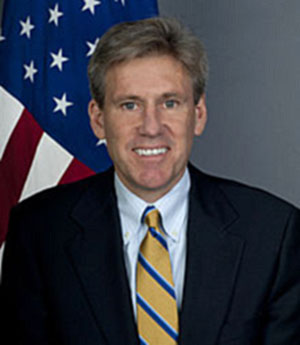
John Christopher “Chris” Stevens was born in Grass Valley, California, on April 18, 1960. He earned a bachelor’s degree from the University of California – Berkley, a J.D. from the University of California’s Hastings College of the Law, and a master’s degree from the National War College. He spent two years teaching English in Morocco with the Peace Corps and briefly practiced law before entering the Foreign Service in 1991.
Stevens served abroad in Jerusalem, Damascus, Cairo, and Riyadh and domestically as director of the Office of Multilateral Nuclear and Security Affairs, Pearson Fellow with the Senate Foreign Relations Committee, special assistant to the Under Secretary for Political Affairs, Iran desk officer, and staff assistant in the Bureau of Near Eastern Affairs.
In May 2012, he became the U.S. ambassador to Libya, where he had previously served twice as deputy chief of mission and special representative to the National Transitional Council. He and three other Americans were killed on September 11, 2012, when members of the Islamic militant group Ansar al-Sharia carried out a coordinated attack against two U.S. government facilities in Benghazi, Libya. Two Diplomatic Security special agents and several other U.S. government employees were seriously injured in the attack. Stevens was 52 years old. He was survived by his father, mother, stepfather, brother, and sister. He is buried in New Elm Ridge Cemetery in Grass Valley, California.
[Sources: Foreign Service Journal, November 2012, Pages 79-80; “John Christopher Stevens,” Findagrave.com, Memorial ID: 261396938; https://en.wikipedia.org/wiki/2012_Benghazi_attack; Ancestry.com records.]
 §
§
Sean Patrick Smith
Terrorist Attack — Benghazi, Libya 2012
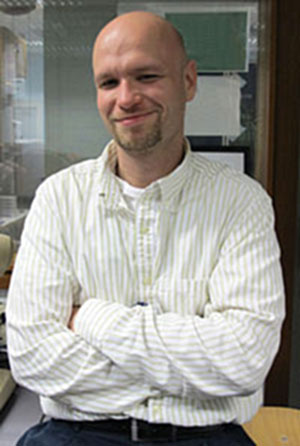
Sean Patrick Smith was born in San Diego, California, on January 30, 1978. After graduating from high school, he enlisted in the Air Force as a ground radio maintenance specialist, rising to the rank of staff sergeant. In 2002, Smith joined the Foreign Service as an information management officer. He served in Baghdad, Pretoria, Montreal, and The Hague.
On September 11, 2012, he was on a temporary visit to the U.S. diplomatic annex in Benghazi, Libya, to set up information technology systems. He and three other Americans were killed when members of the Islamic militant group Ansar al-Sharia carried out a coordinated attack against two U.S. government facilities in Benghazi. Two Diplomatic Security special agents and several other U.S. government employees were seriously injured in the attack. He was posthumously awarded the Thomas Jefferson Star for Foreign Service. Smith was 34 years old. He was survived by his wife, two children, and his parents.
[Sources: Foreign Service Journal, November 2012, Pages 80-81; “Sean Patrick Smith,” Findagrave.com, Memorial ID: 96913497; Ancestry.com records.]
 §
§
Glen A. Doherty
Terrorist Attack — Benghazi, Libya 2012
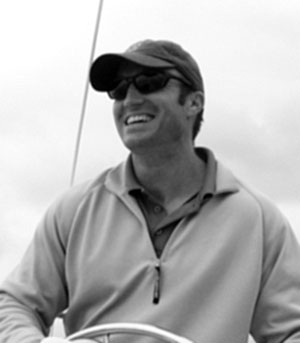
Glen Anthony Doherty was born in Boston on July 10, 1970, and grew up in Winchester, Massachusetts. He trained as a pilot at Embry–Riddle Aeronautical University and later enlisted in the U.S. Navy. As a Navy SEAL combat specialist and medical corpsman, he served for nine years with combat experience in Iraq and Afghanistan. He retired as a petty officer first class. He joined the Central Intelligence Agency as contract protective officer in 2005 and deployed overseas 14 times.
He and three other Americans were killed on September 11, 2012, when members of the Islamic militant group Ansar al-Sharia carried out a coordinated attack against two U.S. government facilities in Benghazi, Libya. Two Diplomatic Security special agents and several other U.S. government employees were seriously injured in the attack. He was 42 years old.
Note: When a CIA employee working under Department of State cover dies in qualifying circumstances, AFSA inscribes their name on the plaque. If the CIA later acknowledges their employment, AFSA updates the biographic information on this webpage.
[Sources: https://www.cia.gov/legacy/honoring-heroes/heroes/glen-a-doherty/; “PO Glen Anthony ‘Bub’ Doherty,” Findagrave.com, Memorial ID: 97014892; Ancestry.com records.]
 §
§
Ty Woods
Terrorist Attack — Benghazi, Libya 2012
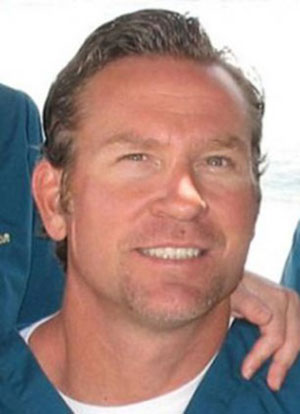
Tyrone Snowden Woods was born in Portland, Oregon, on January 15, 1971. He joined the U.S. Navy after graduating high school and became a Navy SEAL. He served multiple combat tours in Iraq and Afghanistan. He received the Bronze Star Medal and retired as a senior chief petty officer in 2010. He then joined the Central Intelligence Agency as contract protective officer, serving multiple overseas deployments.
He and three other Americans were killed on September 11, 2012, when members of the Islamic militant group Ansar al-Sharia carried out a coordinated attack against two U.S. government facilities in Benghazi, Libya. Two Diplomatic Security special agents and several other U.S. government employees were seriously injured in the attack. He was 41 years old. Woods was survived by his wife and four children. He is buried in Fort Rosecrans National Cemetery in San Diego, California.
Note: When a CIA employee working under Department of State cover dies in qualifying circumstances, AFSA inscribes their name on the plaque. If the CIA later acknowledges their employment, AFSA updates the biographic information on this webpage.
[Sources: https://www.cia.gov/legacy/honoring-heroes/heroes/tyrone-s-woods/; “Scpo Tyrone Snowden Woods Sr.,” Findagrave.com, Memorial ID: 97027677; Ancestry.com.]
 §
§
Anne T. Smedinghoff
Car Explosion — Qalat, Afghanistan 2013
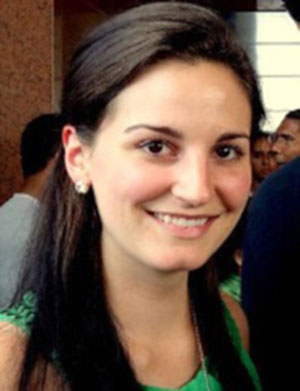
Anne Smedinghoff was born in River Forest, Illinois, on September 18, 1988. She graduated from Johns Hopkins University in 2008 with degrees in international studies and Spanish. Smedinghoff joined the Foreign Service in 2010 as a public diplomacy officer. After serving in Venezuela, she worked as an assistant information officer in the Public Affairs Section of U.S. Embassy Kabul, Afghanistan, where she helped to support Afghan women and children through sports, music, and education and to build positive relationships between Afghans and Americans.
On April 6, 2013, Smedinghoff, three U.S. Army soldiers, and another American were killed in a suicide bomb attack in Qalat, Zabul Province. They were on a mission to deliver books to a school. She was 24 years old. She is buried in Queen of Heaven Catholic Cemetery in Hillside, Illinois.
[Sources: “Diplomat killed in Afghan blast called ‘selfless’” Chicago Tribune, Chicago, Illinois, April 8, 2013, Pages 1 and 7, online at Newspapers.com; “Anne Smedinghoff,” Findagrave.com, Memorial IDs: 107965227 and 129004154; Jonathan S. Addelton, “The Dust of Kandahar,” Foreign Service Journal, October 2015, Pages 29-30; Ancestry.com records.]
 §
§
Antoinette Beaumont Tomasek
Car Accident — Port-au-Prince, Haiti 2013
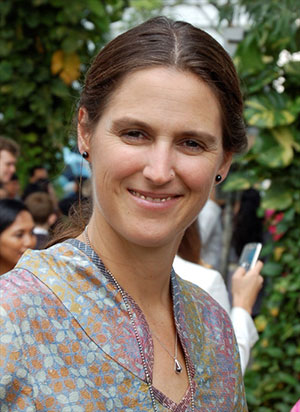
Antoinette “Toni” Beaumont Tomasek was born in Manhattan Beach, California, on February 13, 1972. She earned a bachelor’s degree in environmental engineering from California Polytechnic State University at San Luis Obispo and a master’s degree in sociology from American University and volunteered with the Peace Corps in Paraguay.
Tomasek joined the U.S. Agency for International Development in 2009 as a community health specialist focusing on water, sanitation, and education. She served as a development leadership officer in Indonesia, where she established a program to work with local organizations to prevent and treat tuberculosis, before becoming a health services team leader with USAID in Port-au-Prince, Haiti.
On June 29, 2013, Tomasek was seriously injured in a car accident in Haiti while returning from a trip to deliver medication to a community health clinic two hours outside Port-au-Prince. While Tomasek’s condition initially seemed to improve, she died suddenly three days later. She was 41 years old. She was survived by her husband, two young children, and her mother.
[Sources: Foreign Service Journal, June 2014, Pages 43 and 49; Unger, Mike, “Life, Interrupted,” American University Magazine, November 2014; Ancestry.com records.]
 §
§
David E. Collins
Drowned Saving Life — Nigeria 2013
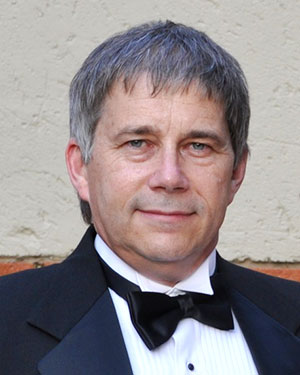
David Eugene Collins was born on October 20, 1958, in Des Moines, Iowa. He earned degrees from Central Bible College and Southwestern Assemblies of God University. As an ordained minister, he served in the Assemblies of God and Compassion Ministries Convoy of Hope in Brussels, Belgium. He joined the Foreign Service in 2009 as a financial management officer, serving in Pretoria, South Africa, from 2009 to 2012 and Lagos, Nigeria, from 2012 to 2013.
On April 28, 2013, Collins and his wife were swimming at the beach on the coast of Nigeria during an embassy outing when they were both caught in an undertow. Collins rescued his wife and escaped the water himself, but died during a 90-minute wait for emergency care. He was 54 years old. He was survived by his wife and four children. He is buried in Laurel Hill Cemetery in Des Moines, Iowa.
[Sources: Foreign Service Journal, May 2015, Page 55; “David E. Collins,” Findagrave.com, Memorial ID: 164683924; Ancestry.com records.]
 §
§
Rayda Nadal
Gas Explosion — Moscow, Russia 2014
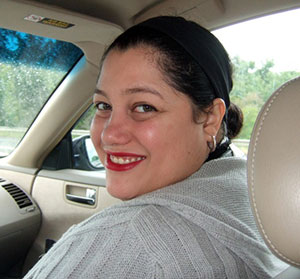
Rayda Nadal was born on October 18, 1976. She joined the Foreign Service in 2008 and served as an Office Management Specialist in Kuwait City, Kabul, Nassau, and New Delhi. Domestically, she worked as OMS for Ambassador Capricia Marshall in the Office of Protocol. Her final post was at U.S. Embassy Moscow as OMS in the Office of Engineering Services.
On May 22, 2014, Nadal was injured in a gas explosion in her embassy-leased apartment in Moscow. She died of her injuries four days later in a hospital in Linköping, Sweden. She was 37 years old. She was survived by her parents and sister.
[Sources: Foreign Service Journal, May 2015, Page 55; Ancestry.com records.]
 §
§
Michael Andrew Cameron “Andy” Jordan
Inadequate Medical Facilities — South Sudan 2016
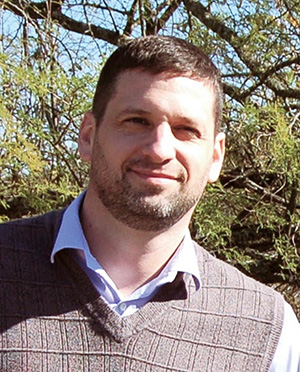
Michael Andrew Cameron “Andy” Jordan joined the Foreign Service in 2003 as an Information Resource Manager. He served at embassies in Baghdad, Brussels, Karachi, Tel Aviv, Lusaka, Tbilisi, and Nairobi. In 2016, he was working at the Department of State mission in Juba, South Sudan. He suffered a heart attack and died due to inadequate local medical facilities on December 18, 2016. He was 43. He was survived by his wife and two daughters.
[Sources: State Magazine, February 2017; Foreign Service Journal, June 2018, Page 48.]
 §
§
Selena Nelson-Salcedo
Inadequate Medical Facilities — Slovakia 2017
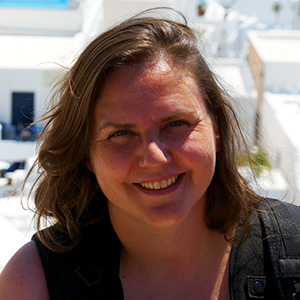
Selena Nelson-Salcedo was born on August 6, 1978. She earned an undergraduate degree from the University of Wisconsin and a master’s degree from the Humphrey School of Public Affairs at the University of Minnesota. She joined the Foreign Service as a consular officer in 2008, serving in Dominican Republic, Malaysia, and Slovakia. She spoke five languages fluently.
Serving as the consular chief at U.S. Embassy Bratislava, Slovakia, she died suddenly on June 4, 2017. Slovakian doctors misdiagnosed her medical condition, preventing her from receiving treatment that likely would have saved her life. It is unlikely that a similar misdiagnosis would have been made in a U.S. medical facility. She was 38 years old and was survived by her husband, two daughters, parents, and four siblings.
[Sources: Foreign Service Journal, April 2018, Page 76; Foreign Service Journal, September 2017, Page 92.]
 §
§
Mark Mitchell
Vehicle Accident – Georgia 2018
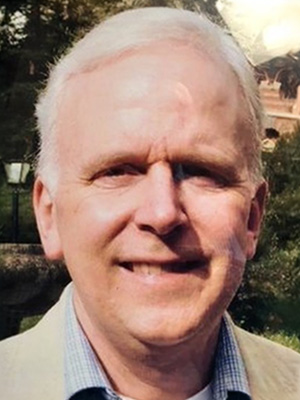
Mark Andrew Mitchell was born on December 7, 1959, in Fresno, California. He earned a degree in business administration at California State University-Fresno. He joined the U.S. Army, rising to the rank of captain before returning to school to complete a master’s degree and a law degree at the University of South Carolina. He then worked for the Federal Bureau of Prisons and the Defense Intelligence Agency before joining the U.S. Agency for International Development. With USAID, he was posted to Djibouti, Afghanistan, Brazil, and the Republic of Georgia.
Posted to Georgia in 2015, he died on May 6, 2018, in a vehicle crash in Tbilisi. A local citizen was charged with a vehicular crime for his role in the crash that caused Mitchell’s death. Mitchell was 58 years old. He was survived by his husband, parents, and sister.
[Sources: Foreign Service Journal, October 2018, Page 65; “Mark Andrew Mitchell,” Findagrave.com, Memorial ID: 190833327; Ancestry.com records.]
 §
§
Nathan Lane
Auto Accident – Poland 2019

Nathaniel Philip Lane was born on January 26, 1971, in Madison, Wisconsin, and raised in Lincoln, Nebraska. He received a BA in political science from the University of Nebraska and a master’s degree in political science from the University of Illinois.
After becoming a Foreign Service officer with the Department of State in 2000, he served in Vietnam, Russia, Mexico, Belarus, and Kenya. While on temporary duty in Poland, he was traveling from the embassy to his residence when he was struck by a pole that toppled from a collision with a vehicle. After being medically evacuated to the U.S., he died of his injuries on November 2, 2019, at the age of 45. Lane was survived by his wife of 23 years, their son, and his parents, stepmother, and brother.
[Sources: Foreign Service Journal, March 2000; Page 75; “Nathaniel Philip Lane,” Findagrave.com, Memorial ID: 277817796; www.legacy.com/us/obituaries/washingtonpost/name/nathaniel-lane-obituary?id=1866747; Ancestry.com records.]
As of May 2025 there are 321 names listed.
